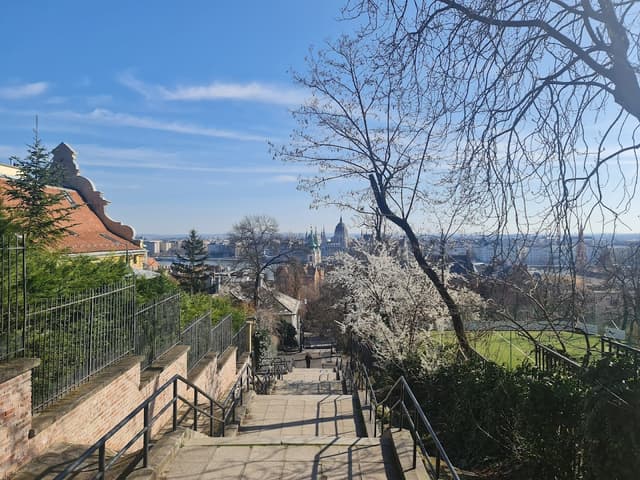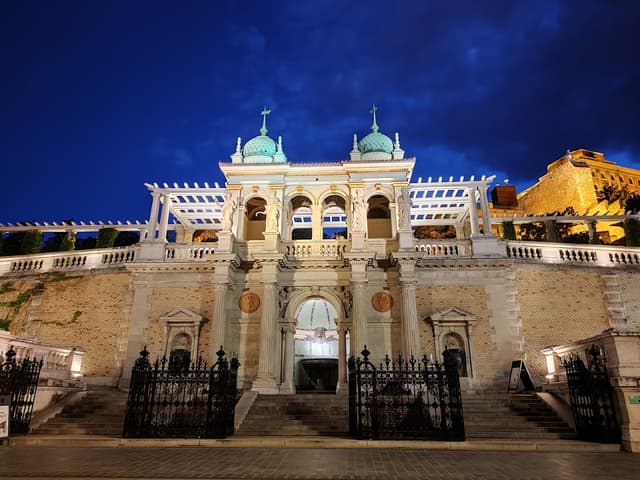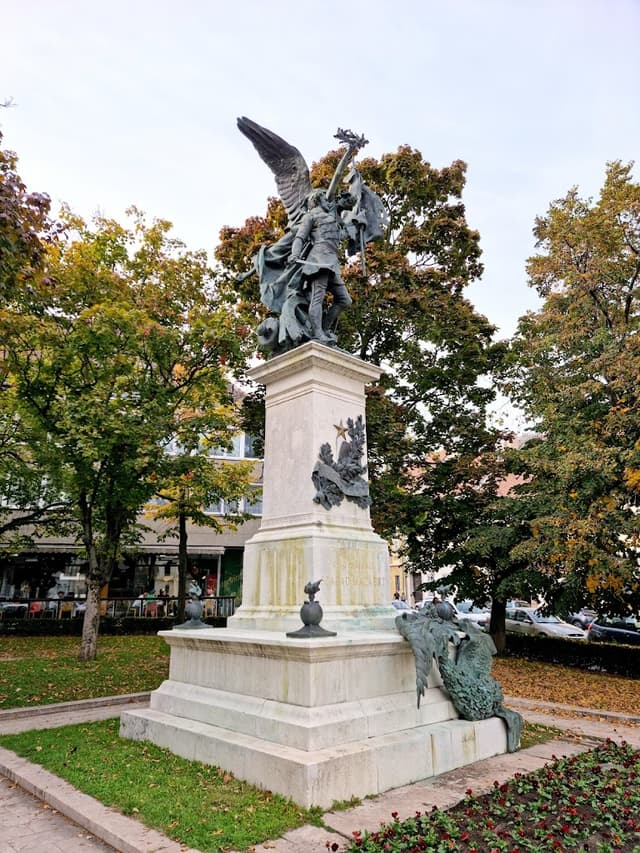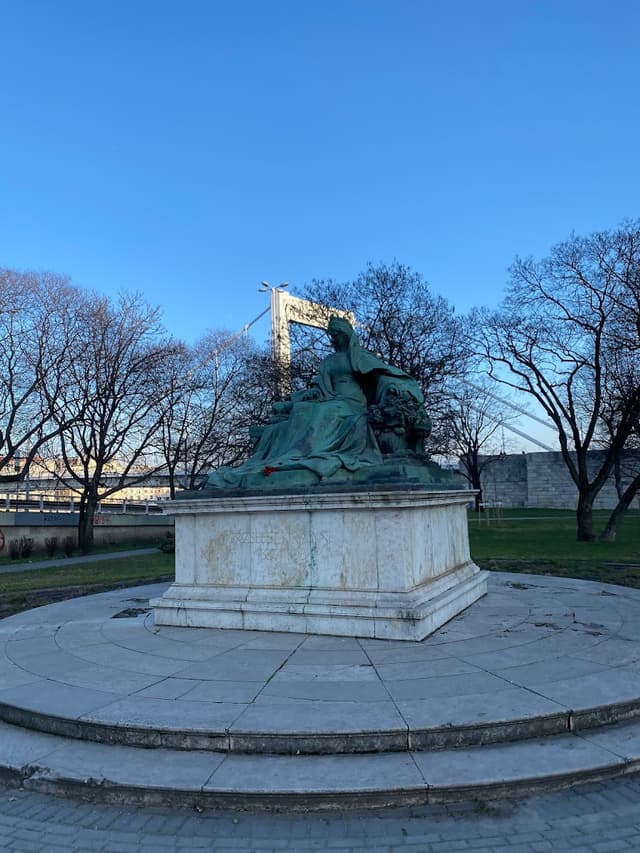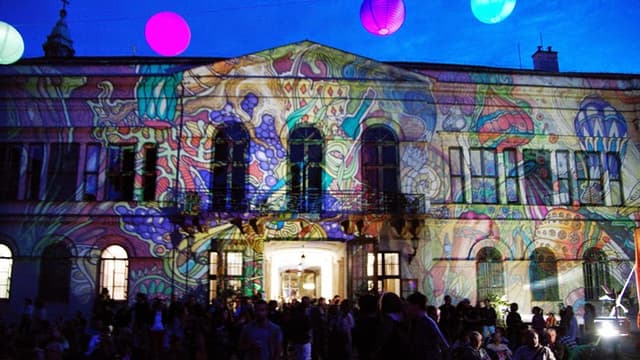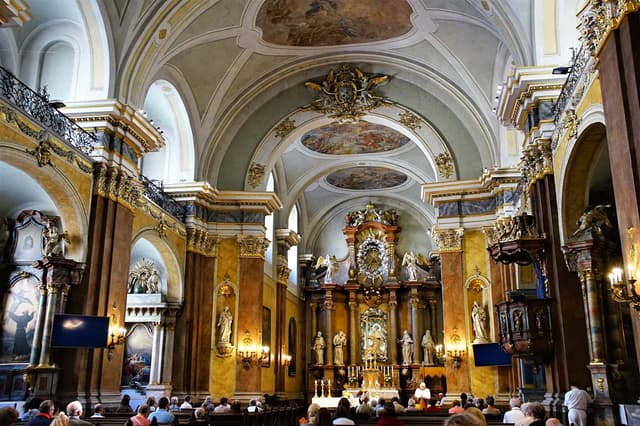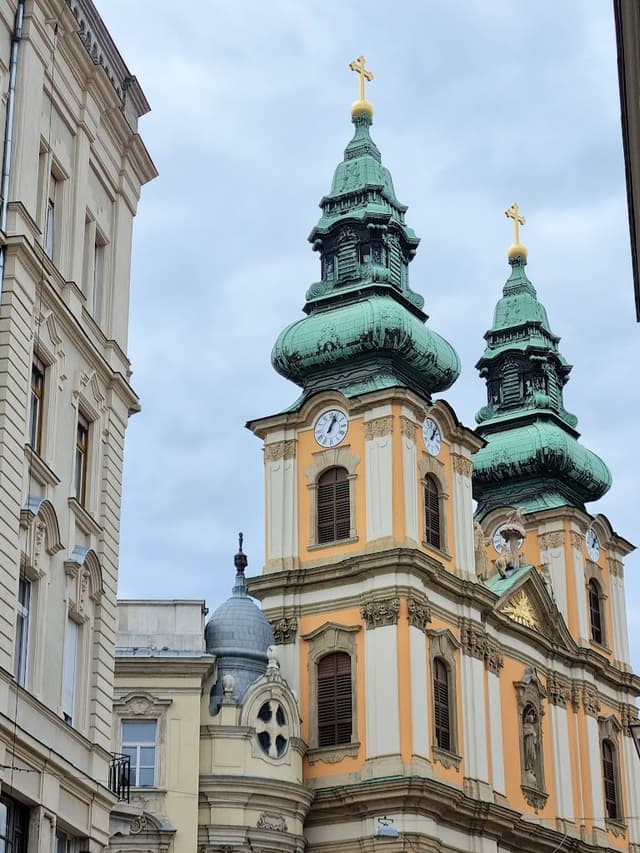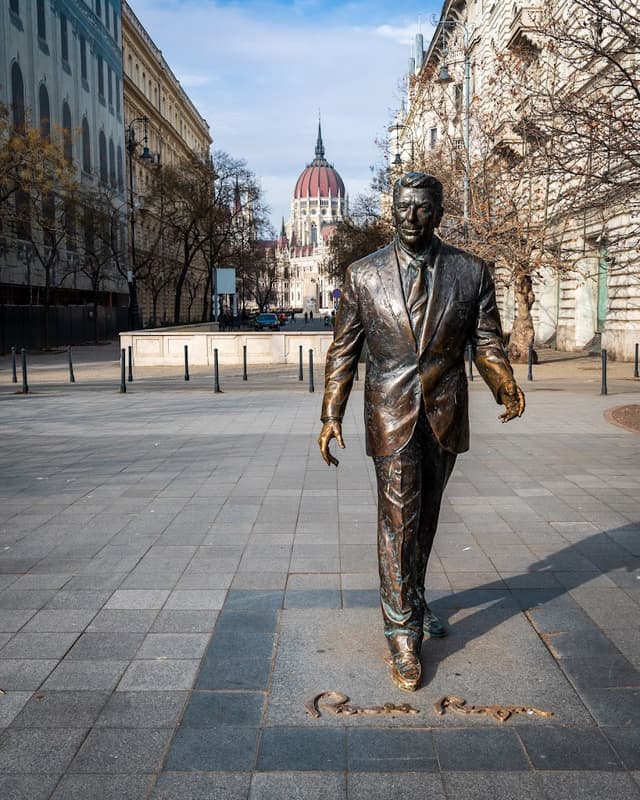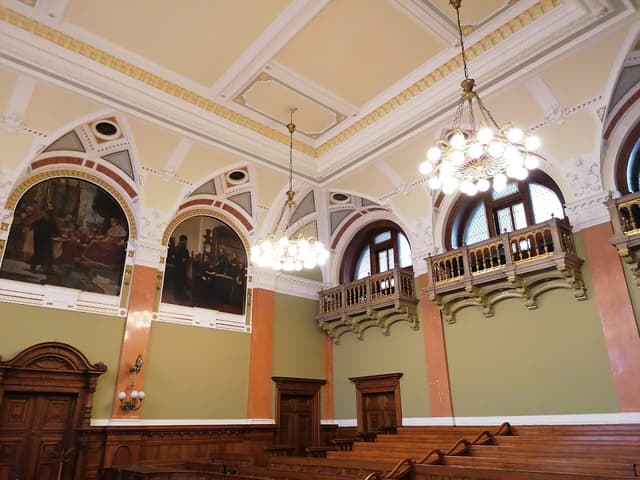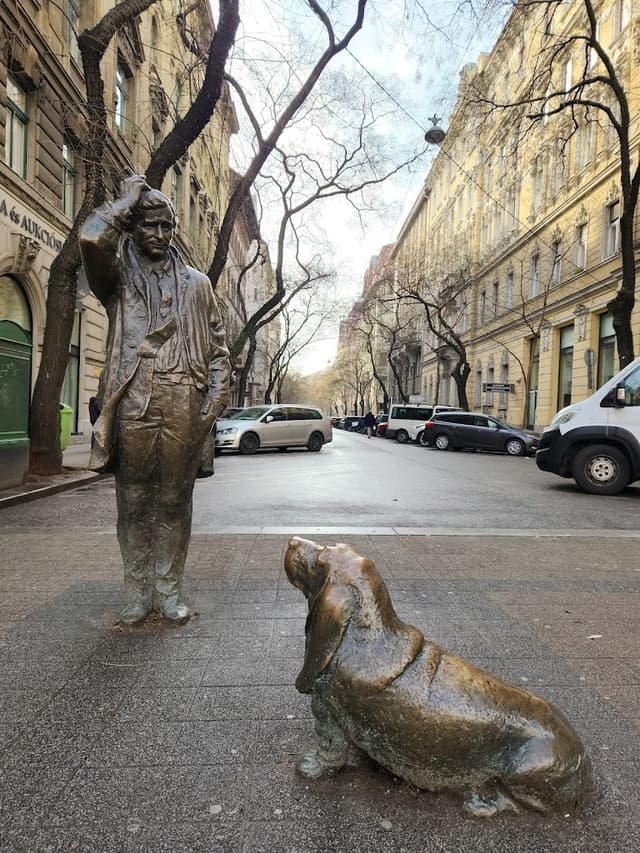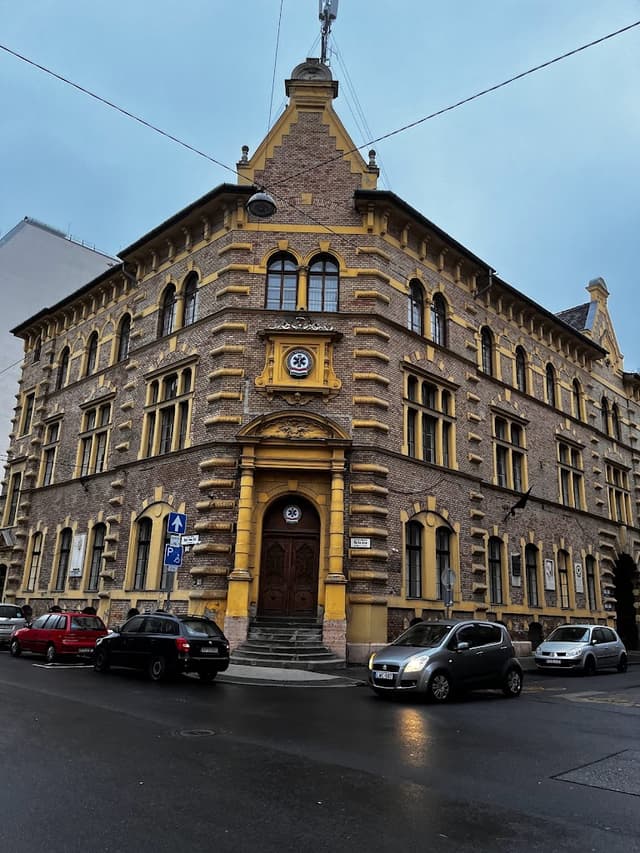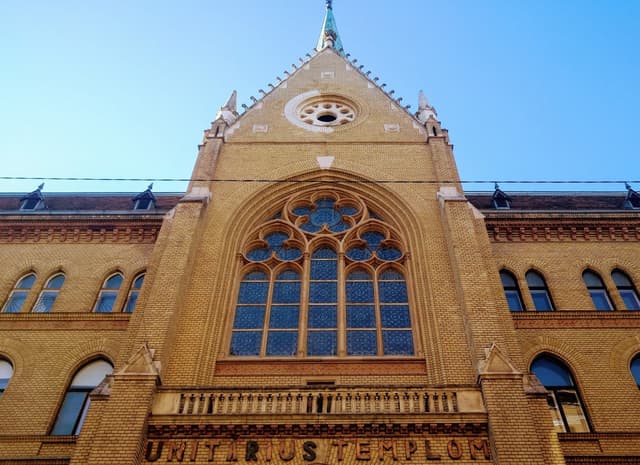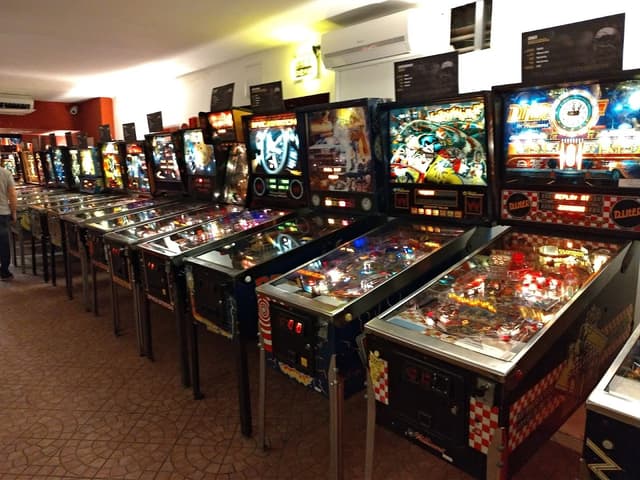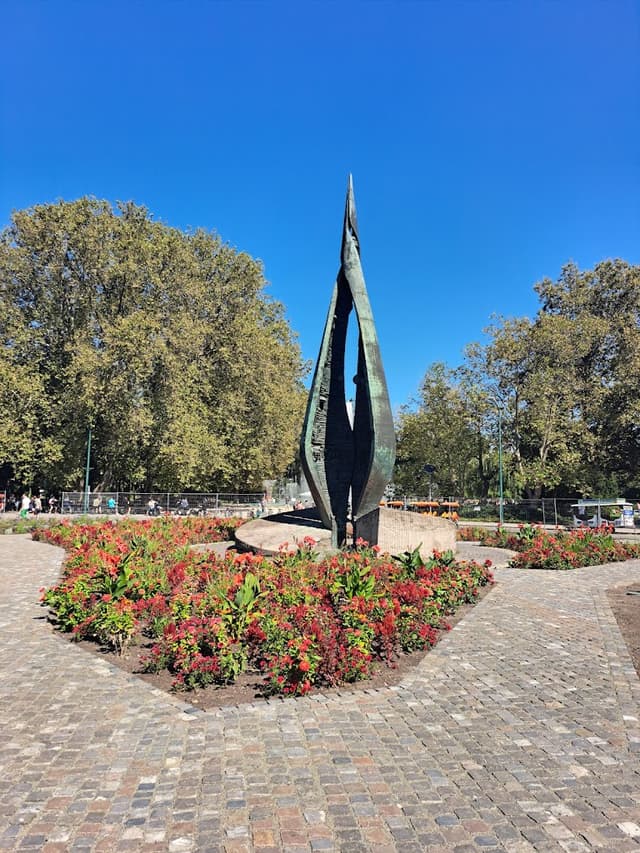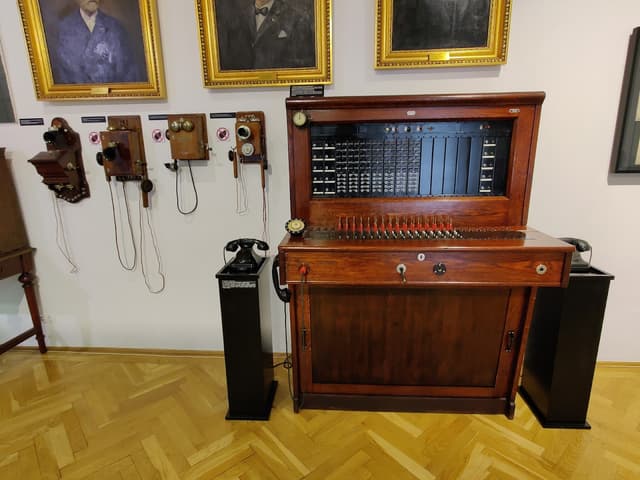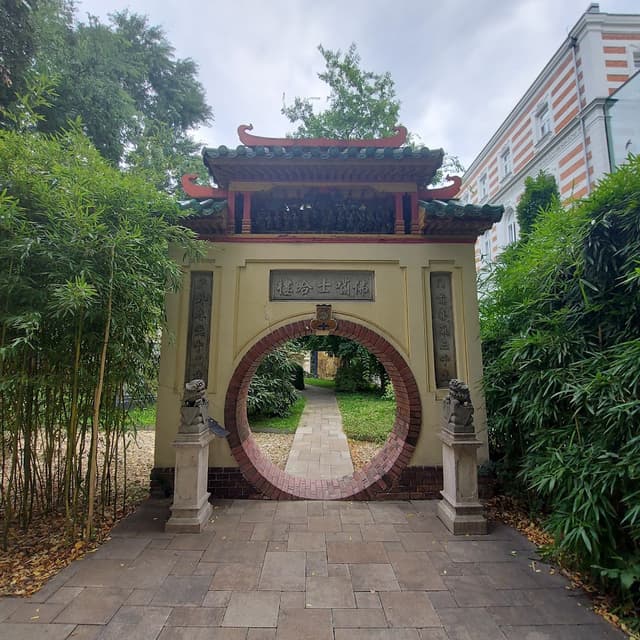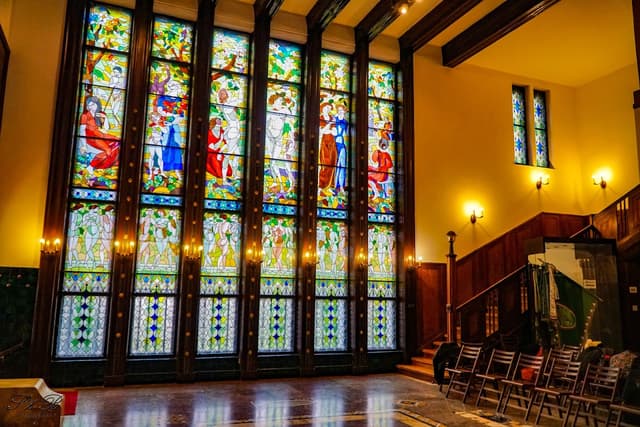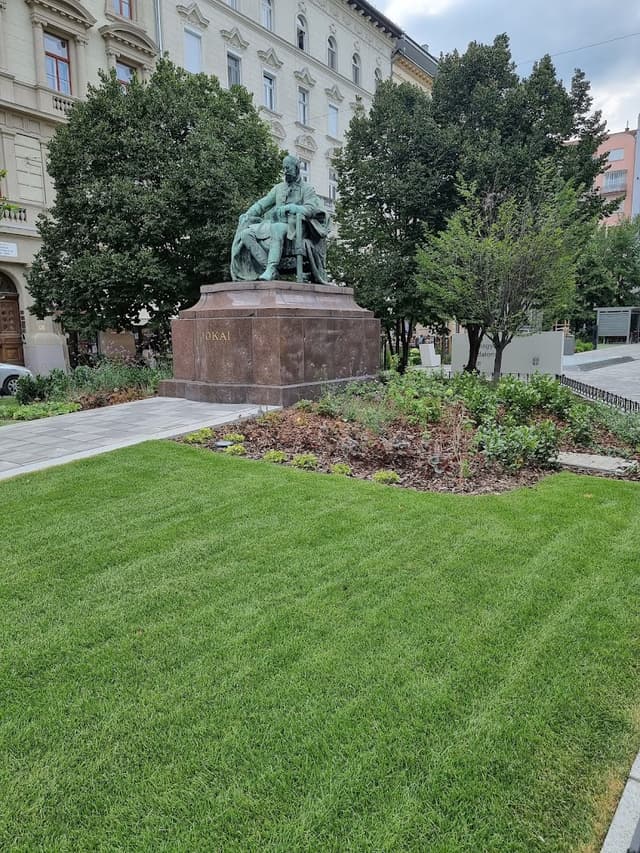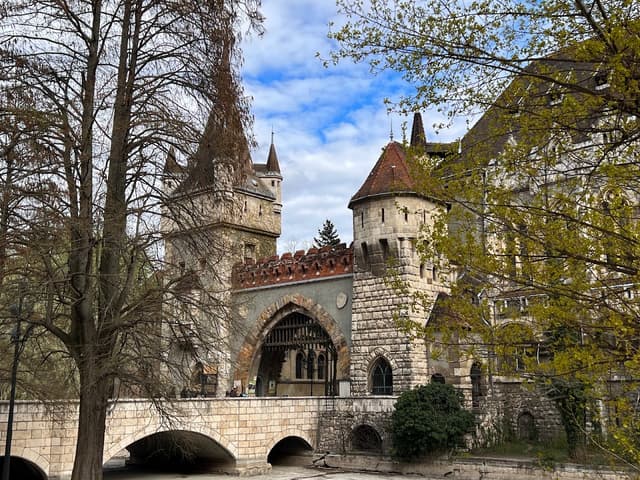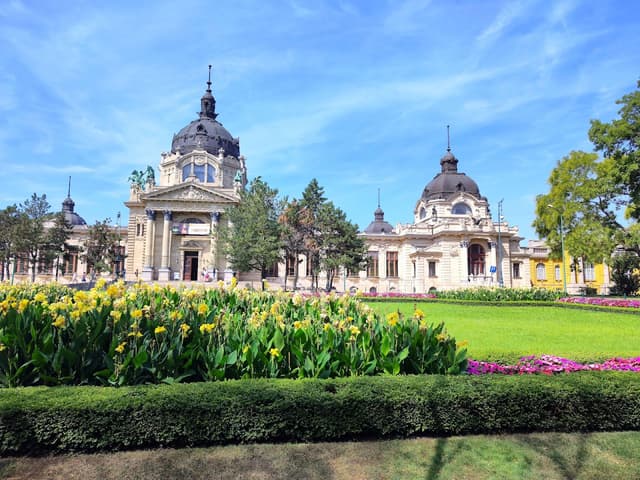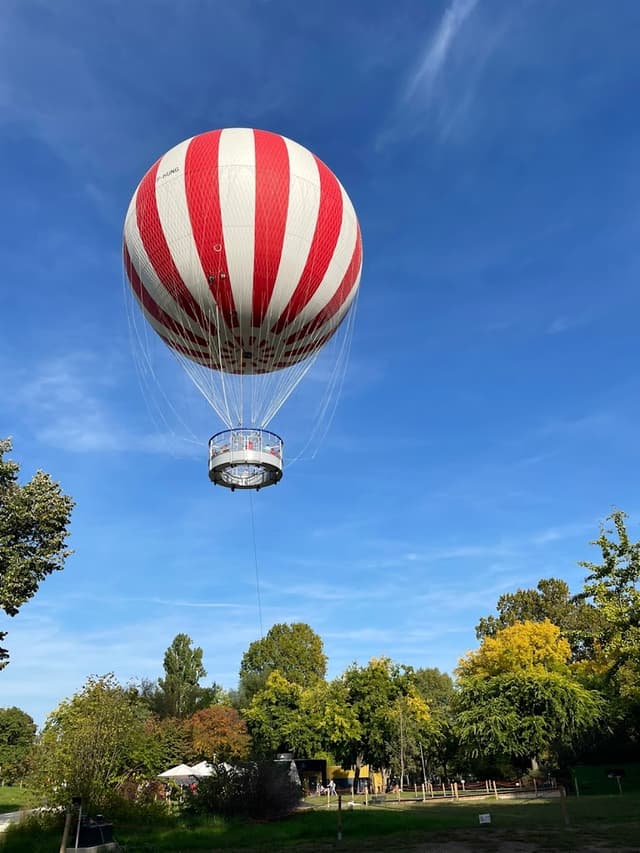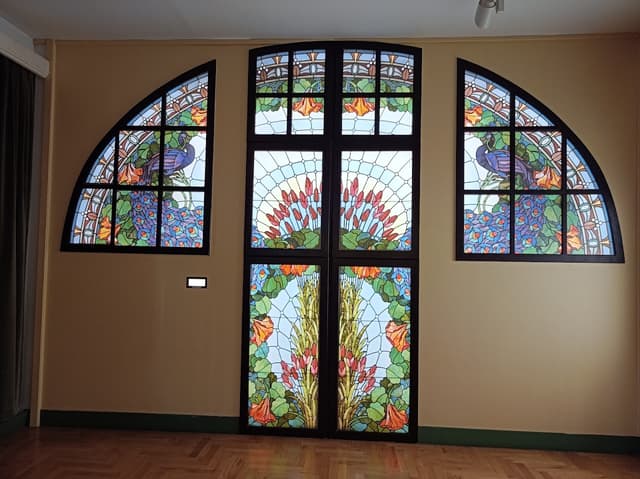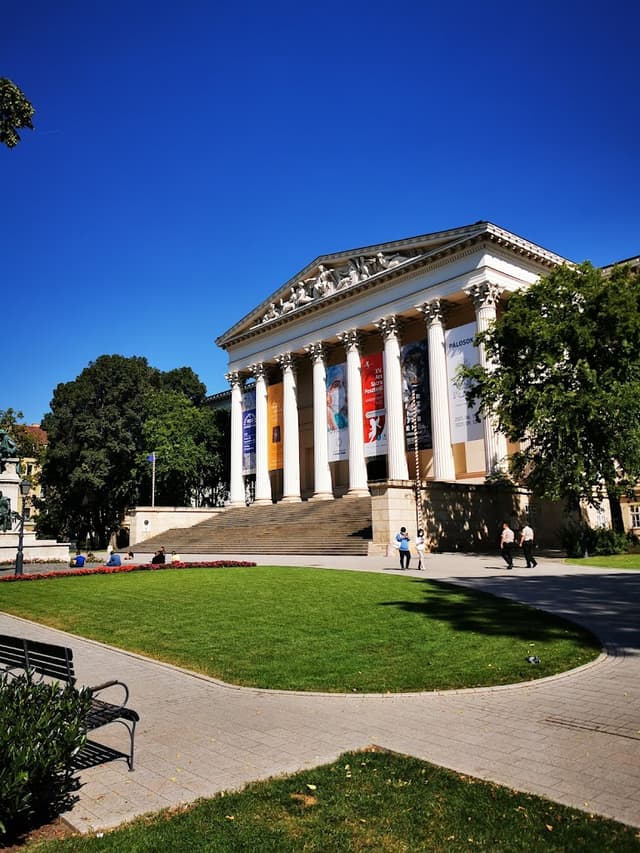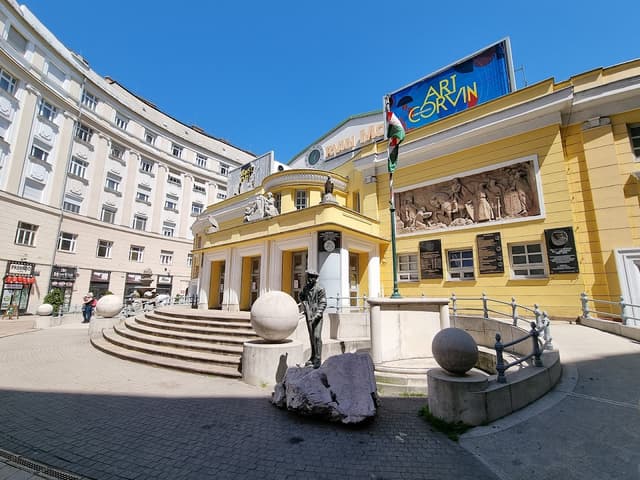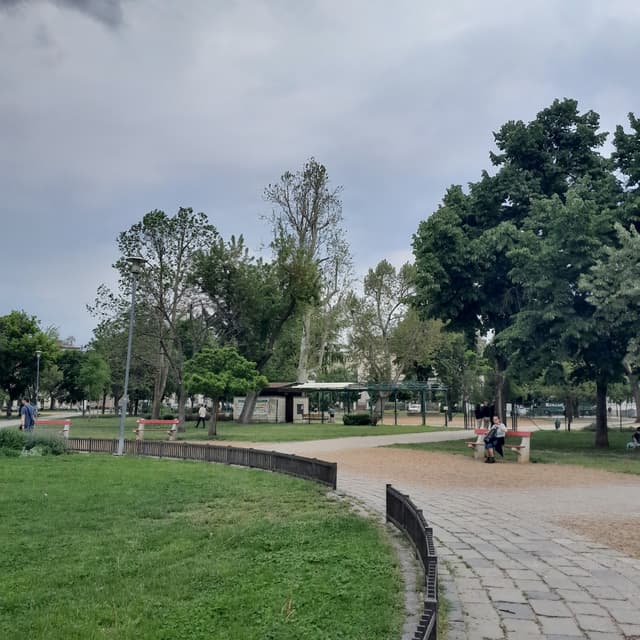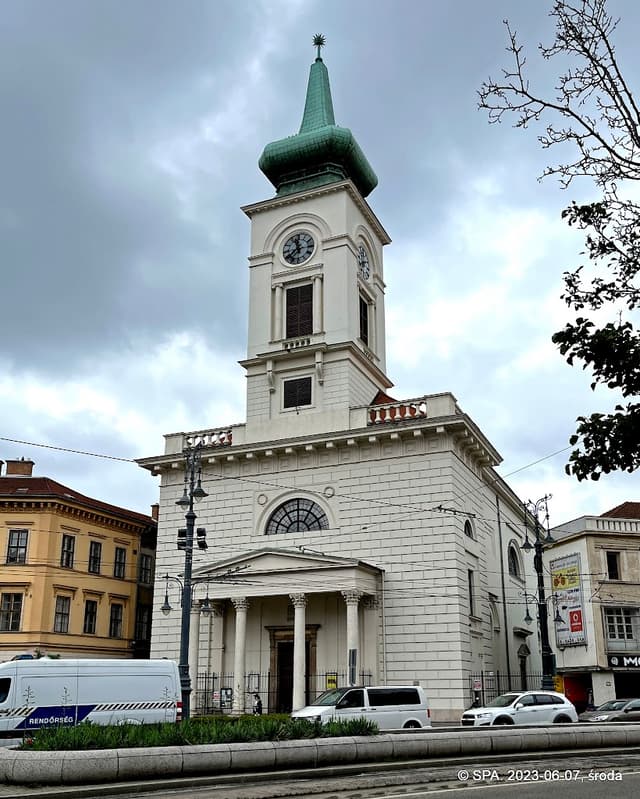A bit of context
Budapest, Hungary’s lively capital, is a city where rich history and contemporary growth blend seamlessly. Situated along the Danube River, Budapest has long been a central hub for commerce, culture, and politics. The Danube, often referred to as the "Blue Danube," flows through the heart of the city, offering picturesque views and serving as a vital transportation route. With its continental climate, Budapest experiences warm summers and cold winters, making it an inviting destination throughout the year, especially for exploring its historical landmarks and cultural offerings.
The area’s earliest settlements date back to Roman times, when the region was known as Aquincum, a military and trading outpost in the Roman Empire. In the 9th century, the Magyars established a settlement that would eventually become the foundation of the Kingdom of Hungary. In the 19th century, the unification of Buda, Pest, and Óbuda marked the creation of modern Budapest. Over the centuries, the city grew into a cultural and intellectual center, with grand buildings like the Hungarian Parliament and the Buda Castle standing as testaments to its royal past.
Budapest’s position along vital trade routes facilitated its growth as an important city in Europe. During the Austro-Hungarian Empire, the city became a cosmopolitan metropolis, attracting artists, architects, and diplomats from across the continent. The city’s name, meaning “Buda” (the hilly part of the city) and “Pest” (the flat, bustling side), reflects its historical and geographical significance. Landmark buildings such as the Fisherman’s Bastion, the Hungarian State Opera House, and St. Stephen's Basilica offer glimpses into the city’s architectural beauty and artistic heritage.
The 20th century brought substantial changes to Budapest. After both World Wars and the communist era, the city underwent significant redevelopment. Today, Budapest thrives as a modern European capital, known for its vibrant arts scene, rich cultural life, and an evolving skyline that juxtaposes sleek, modern structures with centuries-old buildings. The city remains an economic and cultural powerhouse in Central Europe, often referred to as the "Paris of the East" for its elegant architecture, cafes, and arts scene.
Budapest is a city where the old and new coexist harmoniously. It boasts a rich cultural landscape, with a growing number of museums, galleries, performance spaces, and historic sites. Despite its rapid modernization, Budapest stays true to its traditions, offering visitors an immersive experience of both Hungary's proud history and its contemporary cultural vibrancy.
How to get there
Getting to Budapest, Hungary's captivating capital, is straightforward, thanks to its strategic location as a key transport hub in Central Europe, with ample options for air, rail, and bus travel.
By air
Budapest Ferenc Liszt International Airport (BUD), located about 16 kilometers southeast of the city center, is the main international gateway to Hungary. Opened in 1988, it serves as a hub for both low-cost and full-service airlines, connecting Budapest to major cities across Europe, Asia, and beyond. The airport offers a variety of services, including shops, restaurants, and lounges, making it a comfortable entry point for international travelers.
In addition, several low-cost carriers operate from the airport, making it an affordable option for budget-conscious travelers. The city is well-connected to the airport via the 100E Airport Shuttle Bus, which provides direct services to the city center in about 30 minutes for around 900 HUF (approx. €2.50). Taxis and rideshare services like Bolt are also available, with fares ranging from 6,000 to 8,000 HUF (approximately €15 to €22), depending on traffic.
By train
Budapest’s main train stations—Keleti, Nyugati, and Déli—connect the city to major destinations within Hungary and throughout Europe. The city is linked by rail to cities like Vienna, Prague, and Zagreb, as well as destinations in Hungary such as Lake Balaton. Hungarian Railways (MÁV) operates both domestic and international train services, and tickets can be purchased at the station, online, or via the MÁV mobile app.
By bus
For long-distance travel, Budapest’s major bus terminals—Népliget, Árpád híd, and Stadionok—serve as hubs for domestic and international buses. Popular operators like FlixBus, Volánbusz, and Eurolines run services connecting Budapest to cities across Europe, including Prague, Belgrade, and Bratislava. Tickets can be booked online or at the bus stations.
By car
Driving to and around Budapest can offer flexibility, especially if you plan to explore surrounding areas like the Danube Bend or the wine regions of Tokaj. However, driving in Budapest can be challenging due to traffic congestion and limited parking in the city center. Rental cars are available at the airport and various city locations, but public transportation is often more practical for getting around the city.
How to move around
Budapest boasts an efficient and affordable public transportation system, making it easy to explore the city once you arrive.
Getting from the airport
Upon arrival at Budapest Ferenc Liszt International Airport (BUD), travelers can easily reach the city center using the 100E Airport Shuttle Bus, which operates directly from the airport to Deák Ferenc Square, a major transport hub in the city. The journey takes approximately 30 minutes, and tickets can be purchased at the bus stop or on the bus itself.
Alternatively, taxis and rideshare services like Bolt are available at the airport, with fares to the city center typically ranging from 6,000 to 8,000 HUF (approx. €15 to €22), depending on traffic conditions.
Moving around downtown
Budapest has an extensive and well-connected public transportation network, including buses, trams, metro lines, and even funiculars. The Budapest Metro, which consists of four lines, is the quickest way to get around the city. A single ticket costs 350 HUF (around €1), and a travel pass for unlimited rides is available for 1,650 HUF (around €4.40) for a 24-hour pass.
Trams and buses also provide convenient access to the city’s key attractions, with the iconic Line 2 metro offering scenic views of the Danube, Parliament, and Buda Castle. A popular tourist option is the hop-on, hop-off bus, which provides easy access to major sights and often includes a guided tour.
For a scenic way to explore, you can also take the historic Buda Castle Funicular, which connects the city’s Chain Bridge with the Buda Castle district.
Tourist Card
For visitors planning to use public transport extensively, the Budapest Card offers unlimited travel on public transportation, plus free or discounted entry to various museums and attractions. A 24-hour Budapest Card costs 4,990 HUF (around €13), with longer-duration cards available for multiple days.
Practical information
Language
Hungarian is the official language in Budapest. English is commonly spoken, especially in tourist areas, hotels, and restaurants, although knowledge of some basic Hungarian phrases is helpful and appreciated by locals.
Climate
Budapest experiences a continental climate with four distinct seasons: hot summers, cold winters, and mild spring and autumn months.
- Summer (June to August): Average temperatures range from 25°C to 30°C (77°F to 86°F), with occasional heatwaves reaching over 35°C (95°F). This is the high season for tourism, with plenty of outdoor festivals and events
- Autumn (September to November): Temperatures in autumn range from 10°C to 18°C (50°F to 64°F), with cooler evenings. This is a great time to visit as the city is less crowded, and the autumn foliage around the city is stunning
- Winter (December to February): Winters can be cold, with average temperatures ranging from -2°C to 4°C (28°F to 39°F). Snow is possible, especially in January. The city is quieter, and festive markets are popular during the holiday season
- Spring (March to May): Spring sees mild temperatures ranging from 10°C to 20°C (50°F to 68°F), and it's a lovely time to explore the city with fewer tourists
Currency and payment methods
Hungary uses the Hungarian Forint (HUF). Credit cards are widely accepted in most establishments, but it’s recommended to carry some cash, especially for smaller shops, markets, and taxis. ATMs are widely available, and mobile payments such as Apple Pay and Google Pay are becoming increasingly popular.
Visa policy
Citizens from many countries, including the US, UK, and EU member states, can enter Hungary without a visa for short stays of up to 90 days. Longer stays or stays for purposes like business or study require a visa. Check the visa requirements based on your nationality before traveling.
Driving requirements
Renting a car in Budapest is possible, but driving in the city can be challenging due to heavy traffic and limited parking. Visitors planning to drive should ensure they have an international driving permit (IDP) unless their national license is in English or Hungarian. Car rental prices range from 5,000 to 10,000 HUF per day (around €13 to €27), depending on the vehicle type.
SIM card and data connection
Upon arrival in Budapest, you can easily purchase a local SIM card from mobile providers like T-Mobile, Vodafone, or Magyar Telekom at the airport or in various stores around the city. A tourist SIM card with data can cost around 3,000 to 5,000 HUF (approximately €8 to €14) for a week of unlimited data.
Healthcare
Budapest is home to several high-quality healthcare facilities, with hospitals such as Semmelweis University, St. Margaret's Hospital, and Szent Imre Hospital offering services to both locals and international visitors. Pharmacies are abundant, and many pharmacists speak English.
Safety
Budapest is generally considered a safe city for travelers, with a low crime rate compared to many other European capitals. However, as in any major city, tourists should remain aware of their surroundings, especially in crowded areas such as markets (like the Great Market Hall), public transportation, and tourist hotspots like the Buda Castle. Petty crime, such as pickpocketing, can occur, so it's wise to keep an eye on your belongings, particularly in busy places. Public transportation, including the metro, trams, and buses, is safe, but always be cautious in more tourist-heavy spots.
Womens´ Rights
Women in Budapest enjoy full legal rights and are well represented in both business and public life. The city is considered very safe for women, with many solo travelers exploring Budapest without issues. However, as with any destination, modest dress is recommended when visiting places of worship or government buildings. In more traditional settings, dressing conservatively helps to avoid unwanted attention. Budapest is known for its modern, progressive approach to gender equality, though it’s always good to be aware of cultural differences when traveling to more rural parts of Hungary.
LBGTQIA+ Rights
Budapest is one of the most LGBTQIA+-friendly cities in Central Europe. The city boasts a vibrant LGBTQIA+ scene, particularly in districts like the 7th and 9th, with bars, clubs, and cafes that cater to the community. Budapest hosts the annual Budapest Pride, a significant event in the region, celebrating diversity and equality. The city has a progressive attitude towards LGBTQIA+ rights, but like many Eastern European cities, the pace of change can be slower in smaller towns or rural areas. Public displays of affection, while generally tolerated, should be more subdued in these areas.
Other essentials
- Emergency Contacts: In case of emergency, dial 112 for police, medical services, and fire emergencies. This is the general emergency number for all EU countries, including Hungary
- Electrical Outlets: Hungary uses Type C and Type F sockets, with a standard voltage of 230V. Visitors may need a travel adapter depending on the device plug type.
Let´s explore!
Víziváros
Víziváros (translated as "Water Town") is a historic district located on the Buda side of Budapest, nestled along the Danube River. This charming area was once home to fishermen and watermen, with its name reflecting its proximity to the river and its water-based economy in the past. The district’s history dates back to medieval times, and it retains a distinctly village-like atmosphere despite being part of the modern city. Víziváros is marked by cobbled streets, cozy squares, and picturesque houses, many of which have preserved their 19th-century charm.
Culturally, Víziváros is known for its beautiful churches, including the St. Anne’s Church (Szent Anna-templom), a Baroque masterpiece that serves as a spiritual hub for locals. The district is also home to the Kopaszi-gát, a scenic park that offers stunning views of the Danube and the Pest side of the city. Historically, Víziváros was an important residential area for the Hungarian aristocracy, which influenced its elegant architecture and the development of nearby institutions like the Óbuda University. Today, the area retains a quieter, more residential vibe compared to the bustling heart of Budapest, but it is still rich in culture and history, attracting both locals and visitors who seek a more relaxed atmosphere with a view of the river.
See&Do
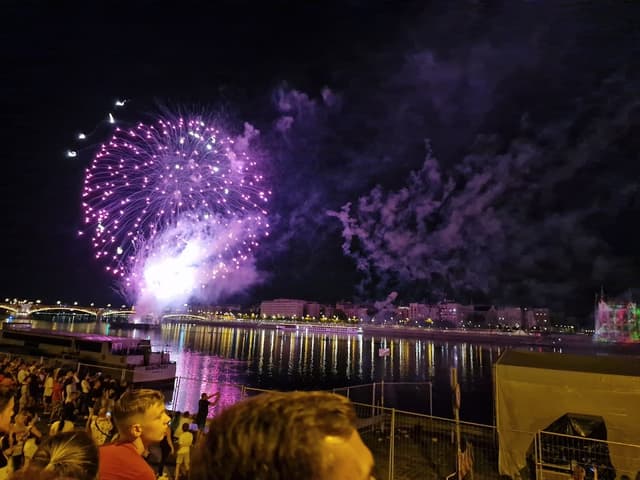
Parliament Viewpoint
@pedralexpereira
The Parliament Viewpoint in Víziváros is a hidden gem on the Buda side of Budapest, offering a stunning perspective of the iconic Hungarian Parliament Building. Located along the Danube promenade, this spot provides visitors with one of the most picturesque views in the city, especially during sunset or at night when the Parliament is beautifully illuminated.
Víziváros, meaning "Watertown," is a historic district with a blend of residential charm and cultural landmarks. From the Parliament Viewpoint, visitors can also take in sweeping views of the Danube River, the Chain Bridge, and the surrounding architectural splendor of Pest.
The area is relatively quiet compared to more tourist-heavy spots, making it a perfect choice for those seeking a tranquil moment to admire Budapest's beauty. Benches and walking paths along the riverbank invite visitors to linger, and it's a popular spot for photographers looking to capture the Parliament's grandeur.

Details
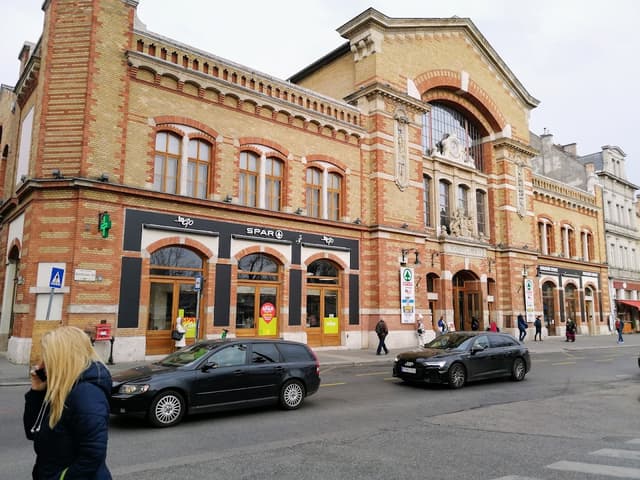
Batthyány Square
@pedralexpereira
Batthyány Square, located on the Buda side of the Danube River, is a notable urban space in Budapest with a rich historical and cultural backdrop. Situated directly opposite the iconic Hungarian Parliament Building, the square offers visitors striking views of this architectural masterpiece across the water. Its name honors Lajos Batthyány, Hungary's first Prime Minister, commemorated by a statue unveiled in 2008.
A key feature of Batthyány Square is the Szent Anna-templom, or Church of Saint Anne, a baroque gem constructed by the Jesuits between 1740 and 1761. Renowned for its elegant design and intricate details, the church is considered one of the most beautiful baroque structures in the city. The square is also home to a bustling market hall, offering a glimpse into local life and a chance to sample regional produce.
The square's strategic location makes it a central point of connection. The historic Fő utca, or Main Street, intersects here, linking the lower station of the Budapest Castle Hill Funicular to the Buda end of the Széchenyi Chain Bridge. Nearby, the French Institute of Budapest adds a cultural dimension to the area, hosting events and promoting French-Hungarian relations.

Details
Ilona Steps
@pedralexpereira
The Ilona Steps, a lesser-known but charming attraction in Budapest, are a narrow set of stairs tucked into the historic Buda side of the city. These steps serve as a passageway connecting different levels of the hilly terrain, offering a more intimate and peaceful route compared to the bustling streets.
The steps are named after Ilona, a figure whose historical or cultural significance varies by interpretation, adding a layer of mystery and charm to the site. Lined with quaint, old-fashioned lampposts and shaded by lush greenery, the Ilona Steps provide a serene escape from the urban noise, making them a favorite for both locals and visitors seeking a quiet moment or a scenic shortcut.

Details
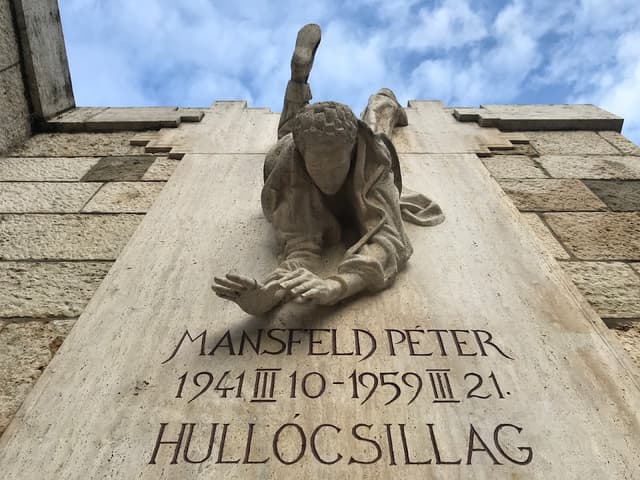
Mansfeld Peter Memorial
@pedralexpereira
On Szabó Ilonka Street stands a striking piece of public art that at first glance resembles an expressionist sculpture of a man plunging headfirst toward the pavement. In reality, this haunting monument is a tribute to Péter Mansfeld, a teenage revolutionary martyred for his role in the 1956 Hungarian Revolution. Mansfeld’s story and his tragic end embody the sacrifices of countless young Hungarians who fought for their nation’s independence.
The Hungarian Revolution began on October 23, 1956, when students initiated a peaceful demonstration against Soviet oppression in Budapest. What began as a call for reform quickly escalated as crowds of over 200,000 people dismantled symbols of the communist regime and demanded a free Hungary. The uprising turned violent after the Soviet Secret Police opened fire on protesters near Radio Budapest. For weeks, the city became a battleground, with burning vehicles and armed clashes filling the streets.
Among the many young participants was Péter Mansfeld, just 16 at the time. As the revolution waned, Mansfeld and a small group of teenage fighters continued stockpiling weapons in preparation for further resistance. Their actions, including stealing arms and a car, and even kidnapping a police officer, eventually led to their capture in 1958. Betrayed by a frightened companion’s family, Mansfeld was apprehended after a failed escape attempt.
Despite his age, Mansfeld was sentenced to death by a Soviet court, which sought to set an example. Held in prison and subjected to torture until he turned 18, he was executed in 1959 in a harrowing ordeal that lasted 13 minutes. His death cemented his legacy as a symbol of youthful courage and defiance.
This sculpture, often referred to as “Man Falling Into Death,” captures the moment of Mansfeld’s attempted escape, his body twisting mid-air. It serves as both a visceral reminder of his sacrifice and a broader commemoration of the youthful idealism that fueled the Hungarian Revolution. A second statue in Veronika Park also honors this national hero, whose story continues to resonate as a testament to the cost of freedom.

Details
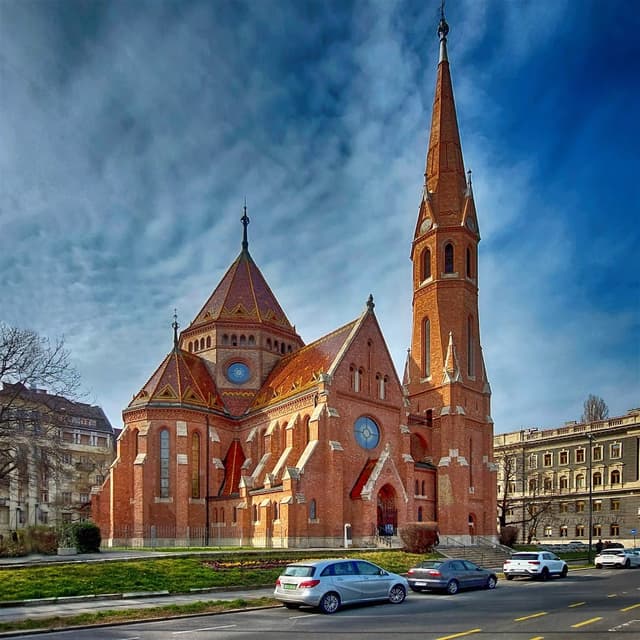
Szilágyi Dezső Square Reformed Church
@pedralexpereira
Near Batthyány Square on the Buda side of the Danube, an intriguing church catches the eye with its distinct architecture. Though it appears Gothic at first glance, the structure departs from traditional medieval designs with its brick walls and rib vaults, lacking the characteristic side flying buttresses. This is no ancient relic but a neo-Gothic masterpiece by Samu Pecz, the same architect behind Budapest’s iconic Great Market Hall.
The church’s design evokes the brick Gothic style of northern Europe. Its compact red-brick body is crowned by a slender 62-meter-high belfry, its pointed roof adorned with Zsolnay glazed tiles in rich hues of brown, yellow, and green. The architectural layout is equally striking, featuring a ground plan centered around a pentagonal shape, with the Lord’s table placed at the very heart. This central arrangement is both unusual and effective, offering a unique spatial experience rarely seen in Protestant churches.
Inside, sunlight filters through Gothic arched windows and rose windows, bathing the light-colored walls in a warm glow. The interior is a harmonious extension of the exterior, with furnishings and pews crafted to the architect's exact specifications. The seamless blend of style and function makes this church a remarkable example of neo-Gothic ingenuity and a quiet gem among Budapest's architectural treasures.

Details
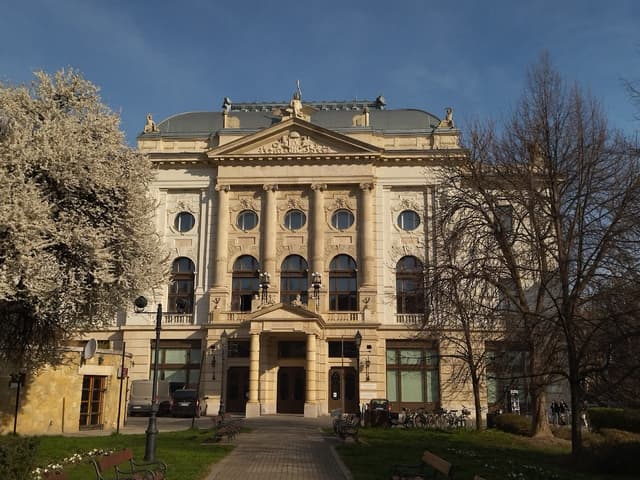
Hungarian Heritage House
@pedralexpereira
The Museum of the American Hungarian Foundation offers an insightful exploration of Hungarian immigrant life through its diverse collections of fine art, folk art, and historical artifacts. With both short- and long-term exhibits, the museum showcases Hungarian native art, solo exhibitions by American and Hungarian artists and photographers, and highlights of Hungarian-American history, culture, and traditions.
Its permanent and temporary exhibitions feature a wide range of objects that reflect Hungary’s rich cultural heritage and the impact of Hungarians on American life. A key focus is the work of Hungarian-born artists who made significant contributions to American art. Since opening in 1989, the museum has hosted over 40 different exhibitions, such as "Budapest 1900 – in Photographs," "A Trilogy of Paintings by Mihály Munkácsy," and "Treasures from the Hungarian Jewish Community," in collaboration with the Jewish Historical Society of Central Jersey.
In addition to these exhibitions, the museum organizes programs like tours for public groups, schools, and special interest organizations, as well as offering library research services and traveling exhibitions. The Foundation also provides lectures related to Hungarian culture and history.
The museum's shop offers an array of imported Hungarian goods, including hand-crafted embroidery, Zsolnay porcelain, books, folk music CDs, cookbooks, and novelty items. This diverse selection enables visitors to take a piece of Hungary home with them, extending the museum’s cultural impact beyond the exhibition space.

Details
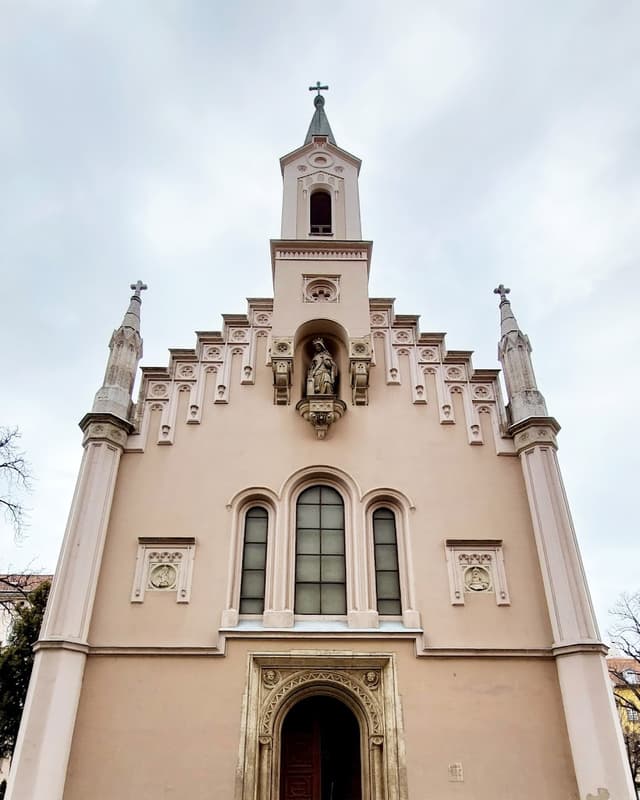
Budapest Cappuchin Church
@pedralexpereira
The Budapest Capuchin Church (Budapesti Kapucinus Templom), also known as the Church of Saint Elizabeth of the Árpád Dynasty (Árpád-házi Szent Erzsébet Plébánia), is a notable Roman Catholic church located in the heart of Budapest. It is named in honor of Saint Elizabeth of Hungary (1207–1231), a royal figure from the Árpád dynasty, known for her charitable works and dedication to the poor.
The church was built by the Capuchin Order, a branch of the Franciscan community, and its architectural style reflects the simplicity and austerity characteristic of the Capuchins. The building features a Baroque design, with elegant but unadorned elements typical of the order's spiritual focus. The interior is peaceful and serene, decorated with religious icons, statues, and paintings that reflect the themes of Saint Elizabeth's life and devotion.
The church holds an important place in the spiritual life of the city, offering masses, religious ceremonies, and community events. Its dedication to Saint Elizabeth, who is the patron saint of Hungary, further strengthens its connection to the country’s rich Catholic history.

Details
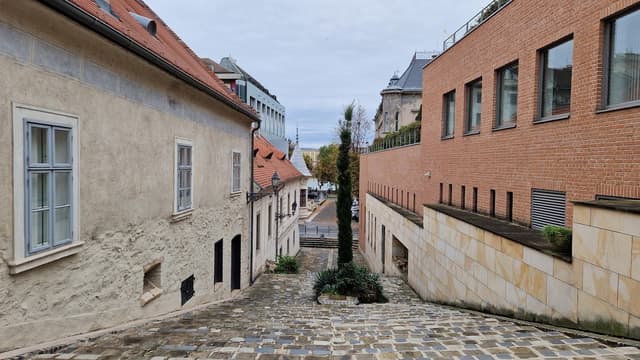
Pala Staircase
@pedralexpereira
The Pala Staircase (Pala lépcső) is an elegant and historical staircase located in the Castle District of Budapest, near the iconic Buda Castle. This staircase, named after the Pala family who once resided in the area, is a notable architectural feature of the district, offering both functional and aesthetic value.
The staircase is built in a classic Baroque style, with wide steps and decorative elements that reflect the elegance of the period. It was originally constructed to connect different levels of the Buda Castle complex and the surrounding areas. Over the years, it has become a well-known landmark, offering beautiful views of the castle and the surrounding city, especially for those who appreciate the historic charm of the Castle Hill.
The Pala Staircase is not just a practical route for moving between levels; it also serves as a quiet and picturesque spot for visitors to rest and admire the surrounding architecture. Its historic significance and location in the heart of the Castle District make it a charming addition to the many cultural and historical attractions in Budapest's Buda side.

Details
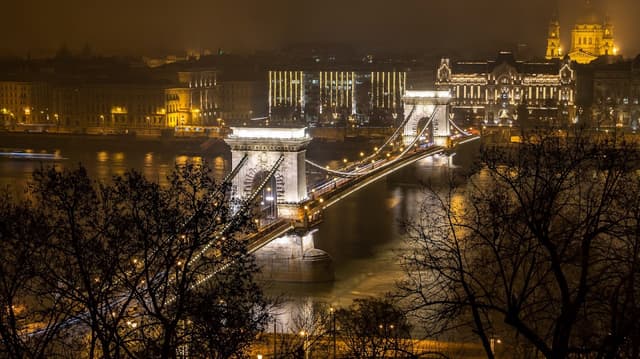
Széchenyi Chain Bridge
@pedralexpereira
Designed by English engineer William Tierney Clark and constructed under the supervision of Scottish engineer Adam Clark, this architectural marvel was completed in 1849 as Hungary's first permanent bridge over the Danube. Its construction symbolized progress and unity during a period of transformative modernization in the country.
The bridge's design is a larger-scale version of Tierney Clark's Marlow Bridge in England. Its cast-iron components were manufactured in the United Kingdom and assembled in Hungary, showcasing cutting-edge engineering for its time. At its debut, the 202-meter central span ranked among the longest in the world, earning it widespread acclaim as a feat of innovation.
Count István Széchenyi, a fervent advocate for Hungary’s modernization, spearheaded the initiative for the bridge's construction, and its naming honors his dedication. Financial backing came from various sources, including Georgios Sinas, a Greek merchant whose contributions are commemorated on the bridge’s foundations.
The bridge is adorned with striking stone lions sculpted by János Marschalkó, which have drawn comparisons to the famous Trafalgar Square lions in London. Contrary to a popular urban legend, these lions do have tongues, though they are not readily visible.
The Chain Bridge has seen numerous historic events, including damage during World War II when it was destroyed by retreating German forces in 1945. It was subsequently reconstructed and reopened in 1949, exactly a century after its original completion. Extensive renovations in the 20th and 21st centuries have preserved its structural integrity, most recently between 2021 and 2023.
Cultural references abound, as the bridge has served as a backdrop for films, music videos, and literature. It appears in movies like Music Box, Spy, and Walking with the Enemy, and even in Katy Perry's Firework video. Its dramatic silhouette continues to inspire artists and filmmakers.
At night, the Széchenyi Chain Bridge is beautifully illuminated, creating a breathtaking scene as its lights reflect off the Danube. A walk across this historical structure offers unparalleled views of Buda Castle, the Hungarian Parliament, and the bustling riverbanks, making it a must-visit for anyone exploring Budapest.

Details
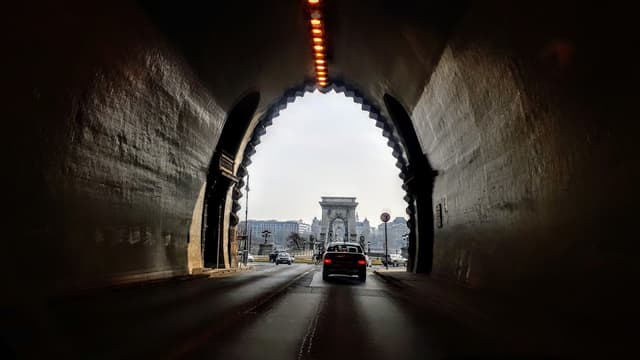
Budai Castle Tunnel
@pedralexpereira
The Budai Castle Tunnel (Budai Várhegy alagút) is a historic and functional tunnel located under the Buda Castle Hill in Budapest. It connects the Castle District with the Adam Clark Square at the foot of the Castle Hill, providing an important route for both pedestrians and vehicles. The tunnel is part of the city's extensive network of underground infrastructure, though its historical and architectural significance adds to its allure.
Construction of the tunnel began in 1859 and was completed in 1867, originally designed to ease the traffic flow between the Buda Castle and the city below. The project was commissioned by Emperor Franz Joseph I of Austria, who wanted to improve transportation in the capital. The tunnel is approximately 350 meters long and was a major engineering feat for its time. It is built into the steep hillside, and its architecture combines both functional and aesthetic elements, with arches and vaulted ceilings.
In the early years, the Budai Castle Tunnel was served by a funicular, but it has since become a part of the regular road network. Today, the tunnel remains a crucial connection, allowing for easier access to the Castle Hill area. It is also a popular spot for visitors, who can appreciate its historical value and the stunning views it offers as they approach the Castle District from the city center.

Details
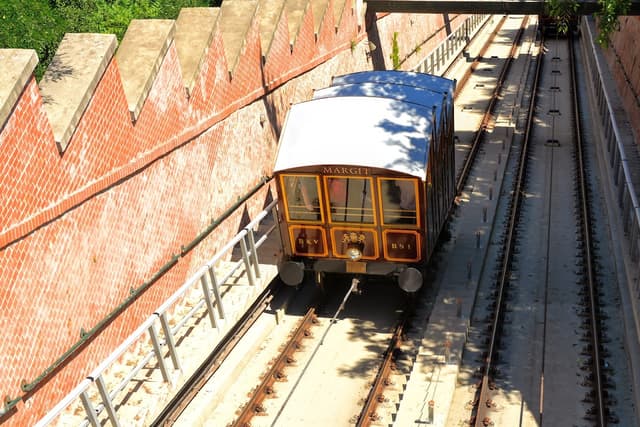
Buda Castle Funicular
@pedralexpereira
The Buda Castle Funicular (Budavári Sikló) is a historic cable railway in Budapest that connects the Chain Bridge at the foot of Castle Hill with Buda Castle at the top. Opened in 1870, the funicular is one of Budapest's oldest and most iconic forms of transport, offering both a practical means of reaching the castle district and a scenic, enjoyable ride.
The original funicular was designed by the Hungarian engineer Károly Zsigmondy, with the goal of making the ascent to Buda Castle easier for both locals and visitors. It was an immediate success, but the original wooden cars and tracks were destroyed during World War II. After the war, the funicular was rebuilt and reopened in 1986 with modern, more durable materials, while retaining the historical charm of its predecessor.
The funicular is a unique piece of engineering, using a system of counterbalanced cars that are connected by a cable. As one car travels up the steep slope of Castle Hill, the other car descends, making the journey efficient and fast. The ride lasts just a few minutes, but during this time, passengers can enjoy sweeping views of the Danube River, the Pest side of the city, and the iconic Hungarian Parliament Building across the river.

Details

Zero Kilometre Stone
@pedralexpereira
At the approximate geographical center of Budapest, a 10-foot-tall limestone sculpture takes the form of a pointedly oval digit zero. This sculpture, though simple in its appearance, holds significant meaning as it marks the reference point from which the distances of all roads leading to Budapest are measured, visible on highway signs across Hungary.
The sculpture rests on a four-sided base inscribed with “KM,” and around it are faded names and distances of various Hungarian cities and towns, radiating outward from the base toward their respective locations. These inscriptions subtly hint at the monument’s function, but many passersby, especially tourists, often miss its significance as they focus on the benches surrounding the area, unaware of its historical importance.
The first kilometer-zero reference point of Budapest was originally placed at the threshold of the royal palace. However, it was relocated to its current position after the Chain Bridge was completed in 1849. The existing sculpture, created by Miklós Borsos, was installed in 1975 at the bottom terminus of the Buda Castle Hill Funicular. Borsos, known for his work in Budapest’s Kerepesi Cemetery, is also credited with designing the tombs of several notable individuals.

Details
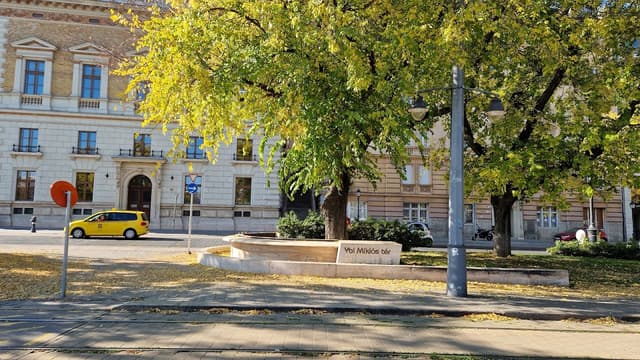
Ybl Miklós Square Fountain
@pedralexpereira
Ybl Miklós Square Fountain, located near the Castle Garden Bazaar on the Buda side of Budapest, is an elegant and serene monument honoring Miklós Ybl, one of Hungary's most renowned architects. Ybl, who lived during the 19th century, played a significant role in shaping Budapest's architectural landscape, including his design of the iconic Hungarian State Opera House.
The fountain is a harmonious blend of neoclassical and romantic elements, reflecting Ybl’s architectural style. It features a central statue of a female figure symbolizing the Danube River, surrounded by detailed sculptures of water creatures and floral motifs. Water cascades gently into a circular basin, creating a tranquil atmosphere in this historic and scenic area.
Ybl Miklós Square, where the fountain is situated, serves as a quiet retreat with picturesque views of the Danube and Pest side of the city. It is a fitting tribute to Ybl’s enduring legacy and a charming spot for visitors and locals alike to pause and appreciate both history and beauty amidst Budapest’s rich architectural heritage.

Details
Várkert Bazár
@pedralexpereira
The Várkert Bazaar, nestled at the base of Castle Hill along the Buda riverfront, is a splendid neo-Renaissance complex designed by renowned Hungarian architect Miklós Ybl. Constructed between 1875 and 1883, it originally served as a luxurious arcade of shops. However, the structure endured extensive damage during World War II and later gained a new identity as the Youth Park, a vibrant venue for Hungary's most popular pop and rock bands from the 1960s to the 1980s.
After closing in 1984, the bazaar fell into disrepair and was even threatened with demolition. Fortunately, a comprehensive renovation in 2014 revitalized this historic site. Today, the Várkert Bazaar is a thriving cultural hub featuring exhibition spaces, a beautifully landscaped neo-Renaissance garden, a serene park, and a cinema. Visitors can also use the escalator to ascend directly to the Royal Palace, making the site a seamless blend of historical elegance and modern utility.

Details

Várkert kioszk
@pedralexpereira
Built between 1875 and 1882, it was designed by the renowned Hungarian architect Miklós Ybl as part of the Castle Garden Bazaar complex. Originally constructed to house the pumping station for the Royal Palace's water supply, the building has undergone multiple transformations and now serves as the Ybl Buda Creative House, a cultural and event venue.
The kiosk was conceived as a decorative yet functional structure within the elegant Castle Garden ensemble. Its eclectic design blends Renaissance and Baroque influences, with fine sculptural details crafted by the Schröffl brothers and striking sgraffito wall paintings by Róbert Scholtz. The northern section of the building originally housed a café, while the southern portion contained the machinery for waterworks. A tower rising between these parts cleverly concealed the chimney of the steam boilers, reflecting Ybl's architectural ingenuity. The system pumped purified Danube water up to the Royal Palace, using a series of six underground cisterns discovered during excavations in 2009.
Over the years, the kiosk evolved from a utility building to a hub of social life. By the early 20th century, it had transformed into an elegant café-restaurant with a music pavilion, dance floor, and lively terrace. However, the structure suffered damage during World War II and subsequent neglect. Despite renovations in 1992, its role diminished until it was repurposed as an event palace in 2008.
In 2016, the Pallas Athéné Foundations took ownership and reimagined the building as the Ybl Buda Creative House. Its restoration aimed to preserve the historical character while introducing a new focus on the arts. Today, it hosts contemporary exhibitions, workshops, concerts, film screenings, and family-friendly programs. A café, garden, and terrace complete the inviting setting, ensuring that the Castle Garden Kiosk continues to contribute to Budapest’s cultural vibrancy.

Details
Budai Várnegyed
Budai Várnegyed (the Buda Castle District) is one of Budapest’s most iconic and historically significant areas, perched atop Castle Hill on the Buda side of the city. The district is home to the Buda Castle, a grand palace complex that has served as the seat of Hungarian kings for centuries. The castle itself, a UNESCO World Heritage site, dates back to the 13th century and has been expanded and renovated multiple times, with notable architectural styles including Gothic, Baroque, and Renaissance elements. The castle complex houses several important museums, including the Hungarian National Gallery and the Budapest History Museum, making it a cultural hub for visitors seeking to understand Hungary’s royal past.
Beyond the castle, the district features cobblestone streets, historic buildings, and charming squares that provide a glimpse into the city’s medieval and Ottoman past. One of the district’s standout features is Matthias Church (Mátyás-templom), a stunning Gothic-style church with a colorful tiled roof and a rich history tied to royal coronations and important state events. The area also boasts the Fishermen’s Bastion, an enchanting terrace offering panoramic views of the Danube, the Parliament building, and the Pest side of the city. Historically, the Buda Castle District has been a focal point of political power, military defense, and royal life, with layers of history from the medieval period through the Ottoman era and into the modern day. Today, it remains one of Budapest’s top attractions, blending historical depth with artistic and architectural beauty.
Architecture and urban spaces
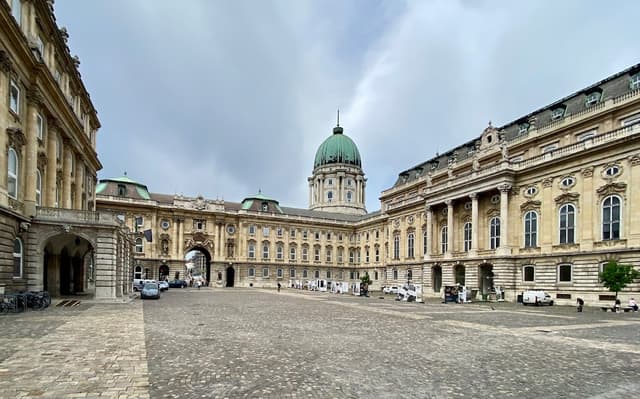
Buda Castle
@pedralexpereira
Buda Castle, known in Hungarian as Budavári Palota and in German as Burgpalast, is a historic castle and palace complex in Budapest that once served as the residence of Hungarian kings. Originally completed in 1265, the site’s current Baroque palace was constructed between 1749 and 1769. The structure endured significant damage during the Siege of Budapest in World War II and was later rebuilt in a simplified Baroque style during Hungary's communist era. Today, it serves as the home of the Hungarian National Gallery, the Budapest History Museum, and the National Széchényi Library.
Perched on the southern end of Castle Hill, the palace is encircled by defensive walls that extend to encompass the Castle Quarter (Várnegyed) to the north. This neighborhood is renowned for its medieval, Baroque, and neoclassical architecture, including historic houses, churches, and notable monuments. It is also home to important government buildings, such as Sándor Palace and the Carmelite Monastery of Buda. Collectively, the castle and its surrounding area are referred to locally as "the Castle" (Vár).
Castle Hill is connected to Clark Ádám Square and the Széchenyi Chain Bridge by the Castle Hill Funicular, offering a direct link to the city below. This area, including the Castle Quarter, was designated a UNESCO World Heritage Site in 1987.

Details
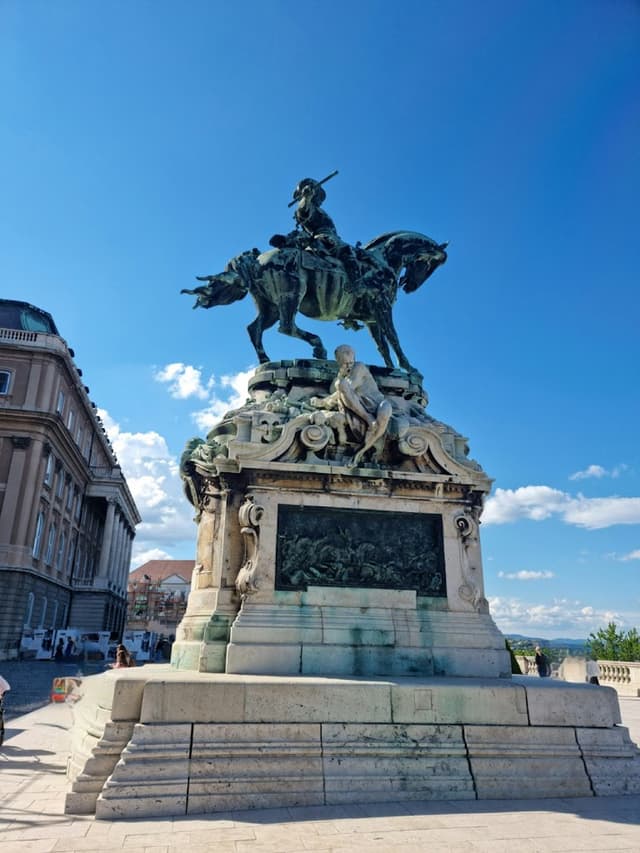
Statue of Prince Eugene of Savoy
@pedralexpereira
Eugene of Savoy (1663–1736) was one of modern Europe’s most celebrated military leaders and a prominent statesman in the Habsburg court in Vienna. Born in Paris to an aristocratic Italian family, Eugene’s early ambitions to serve in King Louis XIV's French army were thwarted, prompting him to seek a career in Austria. Aligning himself with the Habsburg Monarchy, he became a crucial figure in their military and political strategies. His legendary victory at the Battle of Zenta in 1697 decisively defeated the Ottomans, curbing their westward expansion and liberating Central Europe from over 150 years of Turkish rule. Eugene’s triumphs also played a pivotal role in safeguarding the Habsburg Empire from French incursions.
In Buda Castle, an equestrian statue of Prince Eugene of Savoy stands prominently on the Danube terrace, commanding a view over Budapest. This Neo-Baroque masterpiece, crafted by József Róna, was initially commissioned for the town of Zenta. However, financial constraints prevented its installation there. Alajos Hauszmann, the chief architect of the Royal Castle’s reconstruction, acquired the statue in 1900 as a temporary fixture, intending to replace it with a monument to King Franz Joseph. The latter project never materialized, leaving Prince Eugene’s imposing figure as a permanent symbol of his legacy and historical importance.

Details
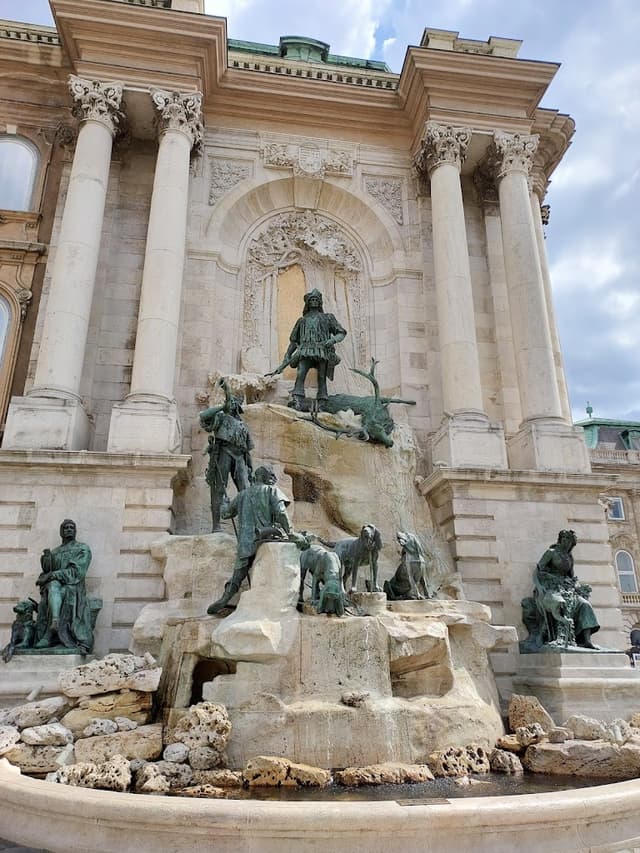
Fountain of King Matthias
@pedralexpereira
The Matthias Fountain depicts a dynamic hunting scene led by Matthias Corvinus, the king of Hungary, rendered in bronze and set against the northern facade of the former Castle Church. This dramatic arrangement features figures poised on a rocky cascade with water trickling through the crevices, evoking the grandeur of Rome's Trevi Fountain on a smaller scale. Behind the fountain, a monumental facade is framed by Corinthian columns, with its central triumphal arch adorned with King Matthias' personal coat of arms. While the facade once boasted intricate balustrades and a Mansard roof, these elements were simplified following damage in World War II. The niche's Art Nouveau arboreal motifs contrast with the fountain’s traditional elements, enhanced by a golden mosaic background.
At the heart of the composition, King Matthias stands atop the highest rock, dressed in hunting attire, a crossbow in hand, and a stag lying at his feet. Below, a huntsman blows his horn while another figure reclines with his back to the viewer. Three hounds complete the central group. Two additional figures flank the basin, adding narrative depth. On the right is Szép Ilonka, the heroine of Mihály Vörösmarty's ballad, gazing at the king while shielding her fawn, symbolizing their tragic love story. On the left is Galeotto Marzio, an Italian chronicler from Matthias' court, holding a falcon while a sighthound rests at his feet.
The fountain, a collaboration between sculptor Alajos Stróbl and architect Alajos Hauszmann, was commissioned during the Royal Palace's reconstruction. Stróbl began work in 1899 after receiving approval from King Franz Joseph. Notable details include the henchman figure, which earned a state gold medal in 1901, and the stag, modeled after a poached animal Stróbl encountered in 1896. Duke Pálffy contributed by sending hounds as models. The fountain was inaugurated in 1904 in the presence of the king.
Remarkably, the fountain endured World War II with only minor losses, including the middle dog, later reconstructed by Jenő Grantner. However, the simplified architectural elements slightly disrupted the overall harmony. A restoration in 2010 revived its splendor, preserving the historic and artistic essence of this iconic feature of Buda Castle.

Details
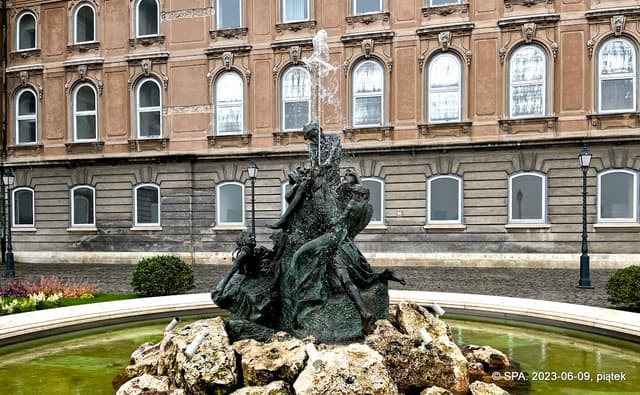
Fountain of the Fishing Children
@pedralexpereira
The Fountain of the Fishing Children is a charming bronze sculpture located in the courtyard of Buda Castle. This delightful work depicts two young boys engaged in the timeless act of fishing, their playful expressions and lively postures capturing a sense of innocence and joy. One boy stands holding a net, seemingly triumphant, while the other crouches at the edge of the basin, intent on the fish they have caught. Below them, a bronze fish leaps from the water, adding movement and dynamism to the scene.
Designed by sculptor Károly Senyei in the late 19th century, the fountain blends artistic finesse with whimsical storytelling. Its naturalistic detail and vibrant energy make it a beloved feature of the castle's grounds. The figures are set within a circular basin, with water gently cascading around the sculpture, enhancing the sense of vitality and refreshing the atmosphere of the surrounding area.
The Fountain of the Fishing Children reflects the lighthearted charm of everyday life, offering a contrast to the grand historical and architectural elements of Buda Castle. Its delicate artistry and cheerful theme have made it a favorite spot for visitors, providing a moment of tranquility and delight amidst the castle's grandeur.

Details
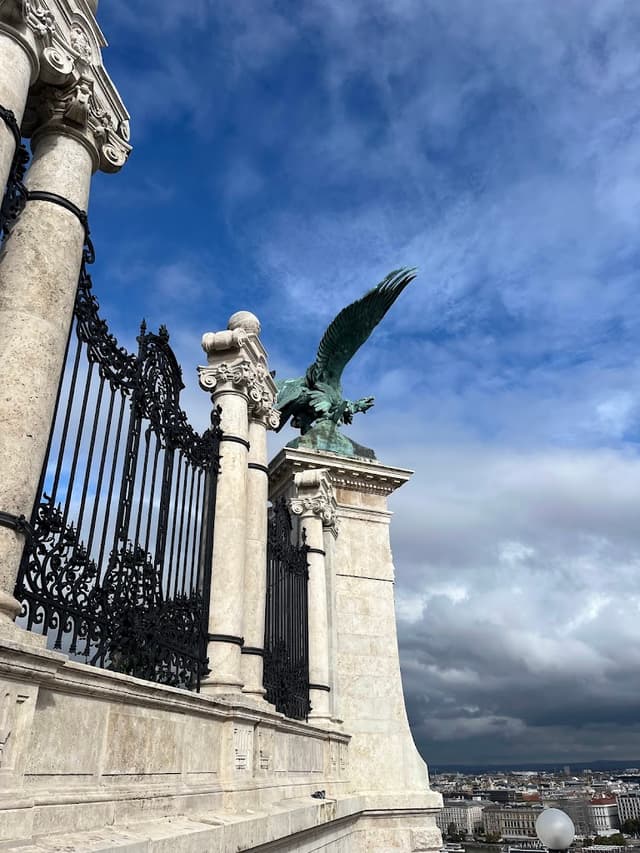
Turul statue
@pedralexpereira
High above the city, the Turul Statues of Budapest serve as powerful symbols of Hungary's cultural and historical heritage, deeply rooted in mythology and national identity. The Turul bird, often depicted as a falcon or eagle, holds a special place in Hungarian legend. According to tradition, it appeared in a prophetic dream to Emese, the mother of Árpád, foretelling that her lineage would lead the Hungarian people to a new homeland. This mythical creature embodies protection, strength, and divine guidance, becoming a cherished emblem of the nation.
The Turul Statue at Buda Castle is one of the most iconic representations of this mythical bird. Installed in 1905, the bronze sculpture was created by artist Gyula Donáth and is prominently perched atop the Royal Palace gates. With its wings outstretched in a commanding pose, the statue gazes over the city, symbolizing vigilance and guardianship. Its placement atop the castle complex enhances its majestic presence, making it a significant landmark and one of the most photographed attractions in Budapest.
The Turul's enduring symbolism connects Hungary's past and present, reminding visitors of the country's rich traditions and the myths that have shaped its identity. The striking imagery and strategic positioning of the statue ensure its place as a lasting emblem of national pride.

Details
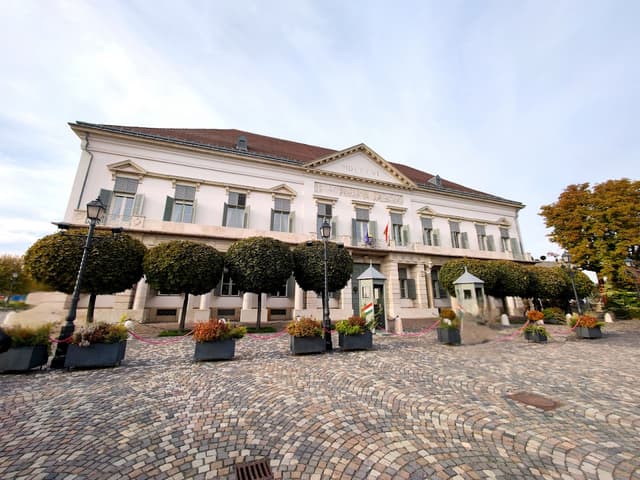
Sándor Palace
@pedralexpereira
Sándor Palace, located beside the Buda Castle complex in Budapest, Hungary, serves as the official residence and workspace of the president of Hungary. Built in the early 19th century, the palace was originally commissioned by Count Vincent Sándor and completed around 1806. Over time, it has seen many changes, including serving as the residence for Hungarian prime ministers and undergoing significant damage during World War II.
In the 19th century, the palace was leased to several prominent figures, including Prime Minister Gyula Andrássy, who renovated it to accommodate government offices and his personal residence. After World War II, the palace suffered severe damage from bombing, with much of its valuable contents looted. It remained neglected until the political changes in Hungary after 1989, when a long restoration project began. The restoration, which followed the original blueprints, was completed in 2002, and the palace interior was updated with replicas of the lost furnishings.
The architecture of Sándor Palace features Neoclassical elements, with notable facades facing both the square and the surrounding areas. The southwest façade includes doors with inscriptions for the President’s Office, flanked by the Hungarian and European Union flags. Inside, the palace houses various salons, including the Blue Salon with its baroque-style furniture, the Red Salon (Maria Theresa Salon) with murals designed by Miklós Ybl, and the Hall of Mirrors, used for formal events. Additionally, the palace contains the President's Conference Room, the President's Study, and the Knights' Hall, which was once used as stables.

Details
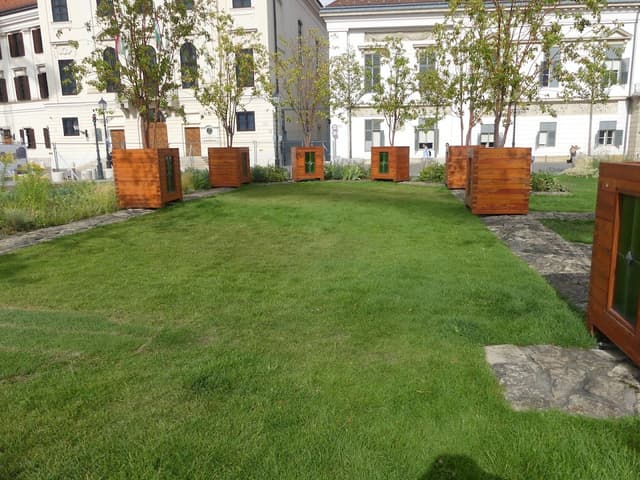
Remains of the medieval Sigismund Church
@pedralexpereira
The remains of the medieval Sigismund Church in Budapest offer a poignant glimpse into the city’s layered history. Originally constructed during the reign of King Sigismund of Luxembourg in the early 15th century, this Gothic church once stood as a symbol of the flourishing medieval Kingdom of Hungary. Located within the Buda Castle complex, it was likely built to serve the spiritual needs of the royal court and the local community.
The church's design featured characteristic Gothic elements, including pointed arches, ribbed vaults, and richly decorated stonework. Its patron, King Sigismund, was a significant figure in European history, known for his role as Holy Roman Emperor and his efforts to strengthen Hungary's cultural and political ties with the broader continent.
Over the centuries, the church suffered significant damage during various conflicts, particularly the Ottoman occupation of Buda and the later sieges that ravaged the castle. By the modern era, only fragments of its structure remained, with ruins scattered across the site. Archaeological excavations have uncovered parts of its foundation, decorative stone carvings, and other remnants, shedding light on the architectural grandeur of the original building.
Today, these remains stand as a quiet testament to the medieval era, inviting visitors to reflect on the turbulent history of Buda Castle and the resilience of its cultural heritage. The site offers a tangible connection to the past, preserving the memory of a once-prominent religious and royal institution.

Details
Statue of the Independence War
@pedralexpereira
The bronze statue, built in 1893 by sculptor Zala György, commemorates the freedom fighters who fought and perished in one of the pivotal battles of the Hungarian War of Independence, which took place at Buda Castle in 1848. Situated near the Fisherman's Bastion, the statue, though relatively small and unassuming, is a popular spot for tourists. It honors the anonymous heroes of the war, with its banner bearing the inscription "Freedom or Death," symbolizing the fierce determination and sacrifice of those who fought for Hungary's independence.

Details
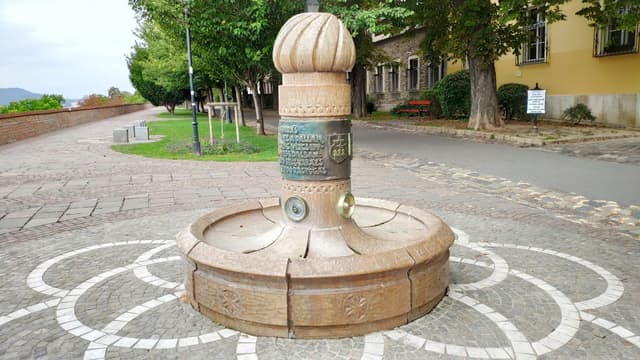
Ősforrás (Zsolnay-díszkút)
@pedralexpereira
Ősforrás, also known as the Zsolnay Fountain, is a beautiful and historic fountain located in the City Park (Városliget) in Budapest, Hungary. The fountain, created by the renowned Hungarian artist and sculptor Zsolnay, is an iconic work of art, known for its elegant design and symbolic connection to Hungary's cultural heritage.
The Ősforrás fountain was designed by József Zsolnay, who was famous for his work with ceramics and porcelain. It features stunning decorative elements and is primarily made from Zsolnay’s signature ceramic materials, renowned for their iridescent glazes. The design incorporates figures and motifs inspired by Hungarian mythology and natural elements, creating a harmonious blend of art and nature. The fountain represents a connection to ancient, mythical sources, symbolizing Hungary’s deep cultural roots.
Located in a tranquil area of the City Park, the Ősforrás fountain is a popular spot for both locals and tourists, offering a picturesque and peaceful atmosphere. The intricate ceramic details, combined with its cultural symbolism, make the fountain an important and admired landmark in Budapest.

Details
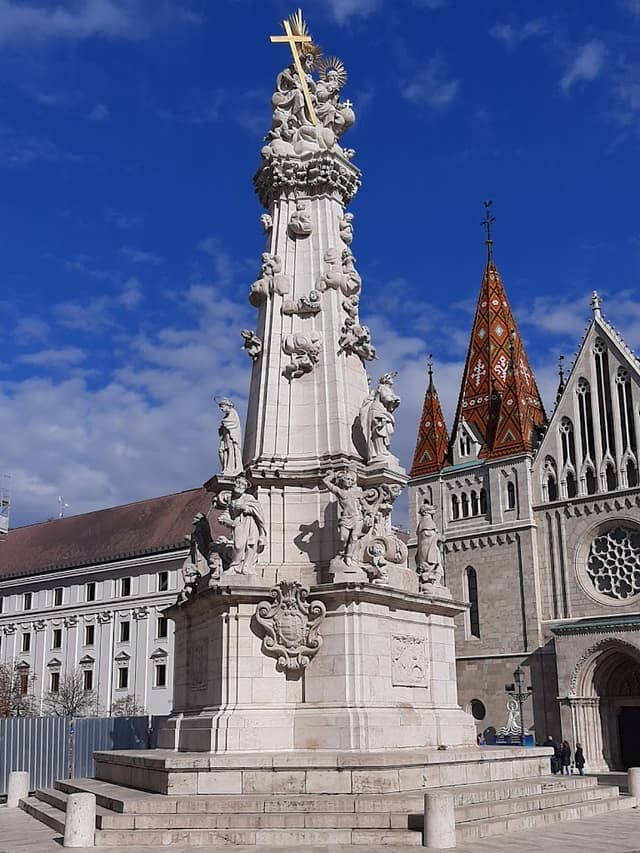
Holy Trinity Statue
@pedralexpereira
The Holy Trinity Column in Buda was erected as a symbol of gratitude for the cessation of the plague and as a means of protection against future outbreaks. The decision to build the column was made by the Council of Buda in 1694, and the foundation stone was laid in 1700. The initial statue, designed by architect Ceresola Vereio and sculptor Bernát Ferretti, was completed in 1706. However, following another epidemic in 1709, the original column was moved to Újlak and replaced with a larger and more decorative one.
The current Holy Trinity Column, completed in 1713 and inaugurated on June 11th, was crafted by Fülöp Ungleich. The reliefs and coats of arms were designed by Antal Hörger. The column is a prominent example of Baroque religious art and serves as a reminder of both the plague's impact and the city's resilience.
The hexagonal obelisk features several statues on its cornice, each representing saints associated with healing and protection. These include Saint Roch (showing his plague wounds), Saint John (holding a cross), Saint Christopher (carrying the Christ child), Saint Augustine (with a burning heart), Saint Joseph (holding a lily), and Saint Sebastian (with arrows piercing his body). Beneath the cornice are three reliefs depicting King David in prayer, the horrors of the plague in Buda Castle, and the column itself.
The column also includes three coats of arms: one for the Emperor, one for the town of Buda, and one for Hungary. Above the statues, three prominent figures appear: the Virgin Mary, John the Baptist, and Saint Francis Xavier. The upper part of the pedestal is adorned with angelic heads, and at the very top stands the Holy Trinity group: God the Father with a scepter, the Son holding a cross, and the Holy Spirit represented as a dove, symbolizing divine protection and grace.

Details
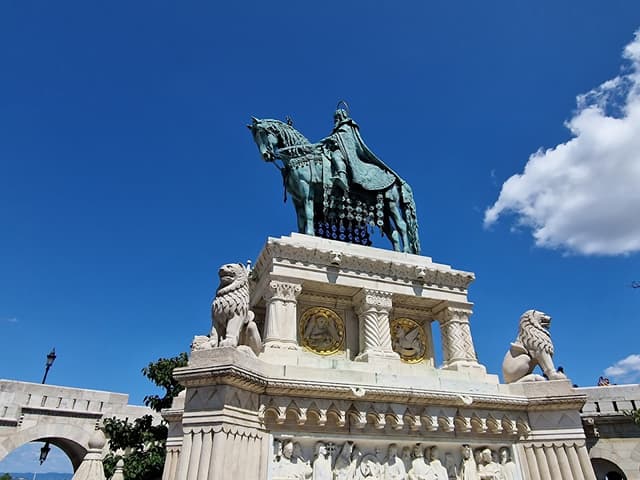
Statue of St. Stephen I
@pedralexpereira
The Statue of St. Stephen in Buda Castle is a prominent monument honoring the first King of Hungary, Saint Stephen (Szent István). Located in the square between the Fisherman's Bastion and Matthias Church, this equestrian statue is one of the most iconic sculptures in Budapest, commemorating the nation's founding monarch.
Unveiled in 1906, the statue was designed by the Hungarian sculptor Alajos Stróbl, a renowned figure in Hungarian monumental sculpture. The statue features St. Stephen in regal attire, mounted on a horse, symbolizing his leadership and pivotal role in establishing Christianity in Hungary. The pedestal of the statue stands at 540 cm (about 17 feet), while the bronze figure of St. Stephen on horseback reaches a height of 400 cm (around 13 feet), making it a striking and grand monument.
The statue serves not only as a tribute to St. Stephen's legacy but also as a powerful symbol of Hungarian national identity, situated in the heart of Budapest's historic Castle District.

Details
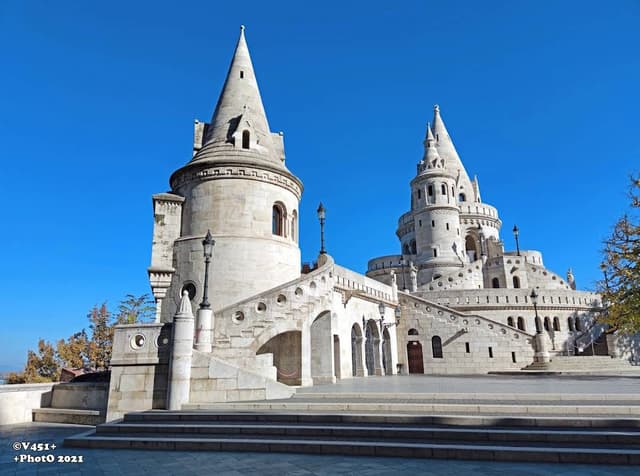
Fisherman's Bastion
@pedralexpereira
The Fisherman's Bastion (Hungarian: Halászbástya) is one of the most iconic historical landmarks in Budapest, located in the Buda Castle District near the Matthias Church. This Neo-Romanesque structure offers a stunning panoramic view of the city, including the Danube River, Pest, and other landmarks such as the Parliament and Gellért Hill.
The original walls of the Fisherman's Bastion date back to the 1700s, when it formed part of the Buda Castle's fortifications. The area was traditionally protected by the guild of fishermen, who lived in the nearby settlement known as Fishtown (Halászváros). These fishermen not only sold fish but also defended the castle walls during times of conflict. The bastion's name is derived from this guild and the surrounding district, rather than from its original purpose as a defensive structure.
The current Fisherman's Bastion was built between 1895 and 1902 in Neo-Romanesque style under the design of Frigyes Schulek, who also played a key role in the restoration of the Matthias Church nearby. Schulek transformed this historically military area into a peaceful promenade and lookout point, creating a significant architectural feature on Castle Hill.
The Fisherman's Bastion is marked by seven towers, symbolizing the seven chieftains of the Magyars, who founded Hungary in 895. The main structure is about 140 meters long, with the central parapet measuring 35 meters. The bastion's terraces provide sweeping views of Budapest, making it a popular spot for both locals and tourists.
The design of the Fisherman’s Bastion includes an ornate, decorative stonework façade, corridors that connect different sections of the bastion, and several statues of warriors and historical figures from the 10th century, representing the Árpád dynasty and the early Hungarian military.
A notable feature is the main staircase, which is adorned with Romanesque-style reliefs and statues of warriors. The statues on the main stairs, sculpted by Ferenc Mikula, include figures representing the military culture of the Árpád era, and a lion holding a shield stands guard at the top.
In addition to the view, visitors can explore the parapet that connects different sections of the bastion and enjoy the covered corridors and arches that line the walls of the bastion. These architectural features not only create a serene environment but also offer sheltered spaces for visitors to stroll, making it an ideal spot for relaxation and sightseeing.
Since 1987, the Fisherman's Bastion has been recognized as a UNESCO World Heritage Site as part of the Buda Castle District. The bastion's transformation from a military defense structure into a peaceful observation point highlights its importance in both Hungary's military history and its modern cultural life. Today, it serves as one of Budapest's most visited and photographed attractions.

Details
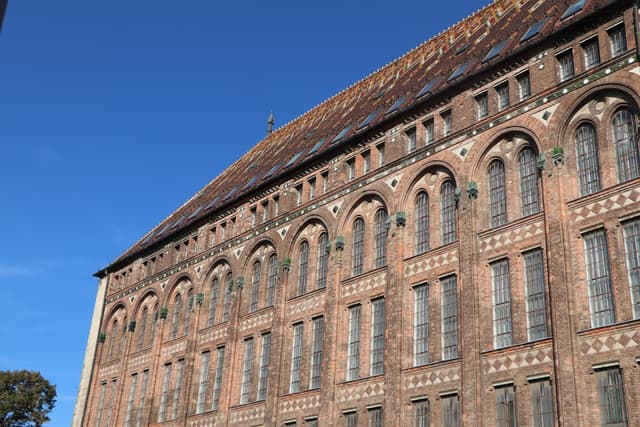
National Archives of Hungary Building
@pedralexpereira
The National Archives of Hungary (Országos Levéltár) is located in the Buda Castle District of Budapest, housed in a grand building that is a significant part of Hungary's historical and architectural heritage. The building itself has a long history, originally constructed in the 18th century and serving various purposes throughout the years. It is renowned for its impressive Baroque architecture, which reflects the grandeur of the period.
The National Archives is home to an extensive collection of historical documents that are essential to Hungary's cultural and political history. It preserves records dating back to the medieval period and includes state documents, governmental papers, manuscripts, and other important historical materials. The archives serve as an invaluable resource for historians, researchers, and anyone interested in Hungarian history.
In addition to its archival work, the building itself is often admired for its beautiful architecture, with elegant facades and meticulously maintained interiors. The building is located near several other important historical landmarks in Buda, making it a central part of the area’s cultural heritage. Visitors to the National Archives can explore its historical collections and also enjoy the architectural beauty of its surroundings.

Details
Museums, cultural venues and activites
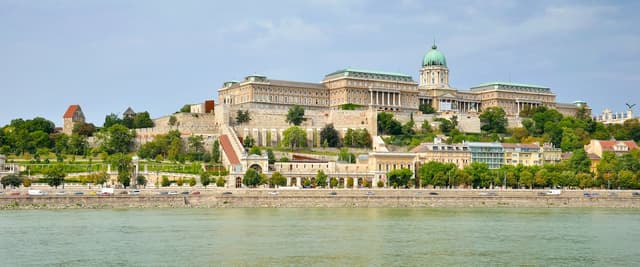
Budapest History Museum / Castle Museum
@pedralexpereira
The Budapest History Museum, located within Buda Castle on Castle Hill, offers an insightful journey into the city's vibrant past. From life before the unification of Buda and Pest in 1873 to the transformative periods under the Habsburg Monarchy and the Austro-Hungarian Empire, the museum provides a detailed exploration of Budapest’s cultural and historical evolution. Despite significant losses during World War II, the museum still boasts a diverse collection of exhibits that capture the city's rich heritage.
Visitors can discover a variety of artifacts, including photographs, furniture, tools, clothing, books, and graphics, each reflecting life in Budapest across different eras. The exhibits vividly portray daily life during the Habsburg era, when Austrian noblemen held power over Hungary, and after the Compromise of 1867, which created the Austro-Hungarian Empire with a more balanced power dynamic.
The museum’s medieval section is particularly fascinating. Highlights include intricately carved stones, stove tiles adorned with the coats of arms of ruling families, and artifacts from King Matthias Corvinus’ Renaissance library. Interactive touchscreens offer detailed accounts of the ruling families of Buda Palace, their seals, coins, and heraldic symbols, enriched with stories and legends. Visitors can also view artistic constellations painted during the reign of King Matthias, who was deeply fascinated by astrology, alongside displays of medieval latrines, castle guard accommodations, and a stone carving workshop.
The museum’s strategic location makes it accessible via a new entrance opened in 2014, connecting visitors from the Castle Garden Bazaar through an elevator or escalator. With a mix of medieval and modern elements, the museum is an excellent destination for history enthusiasts keen on exploring Budapest’s storied past.
The museum is open from Tuesday to Sunday, 10 am to 6 pm, and is closed on Mondays. It is open on many bank holidays and offers free admission on Hungarian national holidays such as March 15, August 20, and October 23. Tickets are available at 3,800 HUF for adults and 1,900 HUF for students and seniors, though prices may vary slightly due to inflation. An audio guide is also available for an additional fee, although it is temporarily unavailable. The museum can be found at 2 Szent György Square, Budapest 1014, and can be contacted at +36-1-487-8854. Festival days, such as the Crafts and Wine Festivals, often include museum access in the entry price, but separate admission is required for other sections of the Buda Castle, such as St. Stephen’s Hall and the National Gallery.

Details
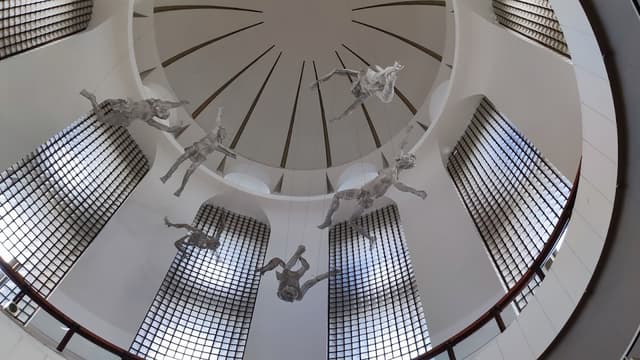
Hungarian National Gallery
@pedralexpereira
The Hungarian National Gallery, established in 1957, serves as Hungary’s national art museum and is located within the historic Buda Castle in Budapest. Its collections span the full range of Hungarian art across all genres, with a particular focus on the works of 19th- and 20th-century Hungarian artists, including those who spent part of their careers in Paris and other Western art hubs. While the gallery is dedicated to Hungarian art, the Museum of Fine Arts in Budapest houses the city’s primary collection of international works.
The gallery’s extensive exhibitions include Medieval, Renaissance, Gothic, and Baroque Hungarian art, with highlights such as 15th-century wood altars and significant examples of Gothic artistry. Sculpture is well represented, featuring works by noted Hungarian sculptors like Károly Alexy, Miklós Izsó, Miklós Borsos, and Gyula Donáth. The gallery also displays paintings and photographs by prominent artists such as Brassai and Ervin Marton, both of whom contributed to the vibrant pre-World War II art scene in Paris.
Key pieces in the collection include works by Mihály Munkácsy, László Paál, Tivadar Kosztka Csontváry ("Ruins of Ancient Theatre, Taormina"), József Rippl-Rónai ("Models"), and Károly Ferenczy. The gallery also features masterpieces by Henrik Weber, Károly Markó the Elder, József Borsos, Miklós Barabás, Bertalan Székely, Pál Szinyei Merse, István Csók, and Béla Iványi-Grünwald. Visitors to the National Gallery can explore a rich array of Hungarian artistic heritage housed in this iconic location.

Details

National Széchényi Library
@pedralexpereira
The Hungarian National Library was established in 1802 by Count Ferenc Széchényi, a patriotic Hungarian aristocrat who dedicated himself to collecting Hungarian books from around the world. These books were assembled into a collection that he generously donated to the nation. By 1803, the public library opened in Pest, inspiring a nationwide movement of book donations to expand its holdings.
In 1808, the Hungarian National Assembly created the Hungarian National Museum to preserve the historical, archaeological, and natural relics of Hungary. The museum was merged with the library, forming a combined institution that served as a repository for both written and physical artifacts of Hungary’s heritage for over two centuries.
The Hungarian National Museum moved into its own building in 1846, but the library remained part of it until 1949, when it was re-established as a separate entity and renamed the Hungarian National Library. In 1985, the library found its current home within the Buda Castle Palace. Today, it continues to expand its accessibility through ongoing work on its catalog and digital resources.

Details

The House of Houdini
@pedralexpereira
The House of Houdini, located at 11 Dísz Square within Buda Castle in Budapest, Hungary, is a private exhibit and performance venue dedicated to the legendary magician and escape artist Harry Houdini. Opened on June 16, 2016, the venue houses the only collection of original Houdini artifacts in Europe. The collection includes items such as handcuffs, personal correspondence, and even a Bible once owned by Houdini. It also features original props from the 1999 film *Oxygen*, in which Adrien Brody starred as Houdini, as well as props from a subsequent miniseries.
Budapest was chosen as the site for the exhibit due to Houdini's birth in the city, though he never performed there. The owner of the House of Houdini is David Merlini, an escapologist who also served as a technical advisor for the Houdini miniseries. The venue serves as a research center exploring Houdini's life, particularly his Hungarian and Jewish heritage.
In addition to the exhibition, the venue hosts performances in the "Orpheum," a small in-house theater where six magicians take turns performing. Visitors must decode a secret "arcane" message to gain entry; if unsuccessful, they are refunded the price of admission.

Details

Labyrinth
@pedralexpereira
The Labyrinth of Buda Castle is an underground network of tunnels and chambers located beneath Castle Hill in Budapest, Hungary. This historic site, often referred to simply as the "Buda Castle Labyrinth," spans several levels and is renowned for its mysterious, eerie atmosphere. The labyrinth has a long and storied history, with its origins dating back to medieval times.
The Labyrinth was originally built in the 13th century, serving various purposes over the centuries. During the medieval period, it was used as a royal storage space, and later, it functioned as a wine cellar. Over time, the underground tunnels gained notoriety as a secretive area, with rumors of it being used for military purposes, including as a hiding place during wartime.
One of the most famous events in the Labyrinth’s history occurred in the 16th century, when the Ottoman Empire occupied Budapest. It is believed that the Labyrinth was used as a prison for important figures, and some of the tunnels were linked to the nearby Royal Palace.
The Labyrinth continued to evolve throughout the centuries. During the 20th century, it became a site for several significant historical events, including being used as a hospital during World War II. It is also rumored to have been the place where the infamous Countess Elizabeth Báthory, known for her gruesome acts, was imprisoned.
Today, the Buda Castle Labyrinth is a popular tourist attraction, offering a unique glimpse into Budapest’s history. Visitors can explore the maze-like tunnels, admire the surreal stone formations, and learn about the various historical periods that the Labyrinth has witnessed. The Labyrinth also includes several themed exhibits, with displays related to Hungary's royal past, historical figures, and legends.
The Labyrinth's dark and atmospheric ambiance, combined with its rich history, makes it a fascinating and slightly eerie attraction for visitors interested in Budapest's past.

Details
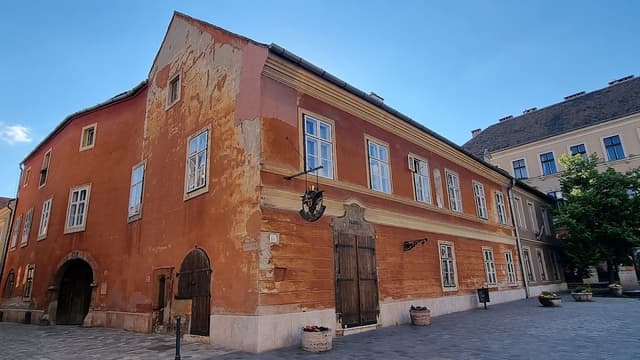
Arany Sas Patikamúzeum
@pedralexpereira
This unique museum is housed in one of the oldest pharmacies in Hungary and offers visitors a fascinating glimpse into the history of pharmaceutical practice, medicine, and health care in Hungary.
The museum is named after its original sign, which features a golden eagle — a symbol of health and healing. The Golden Eagle Pharmacy was established in 1827, making it one of the oldest pharmacies in Budapest. The building itself, with its original design and decorations, has been preserved over the years to maintain the authenticity of the setting.
Visitors to the museum can explore an extensive collection of pharmaceutical tools, medicines, and packaging from the past, dating from the 18th century to the early 20th century. The museum exhibits old pharmacy jars, historical drug containers, and ancient medical instruments. It also showcases how medicines were prepared and administered in the past, offering a comprehensive look at the evolution of pharmacy practice.
In addition to pharmaceutical history, the museum offers insights into the medical knowledge of the times, presenting the development of treatments and remedies. Some of the exhibits also explore the role of pharmacists in society throughout history and how medicine was often intertwined with the arts and alchemy.

Details
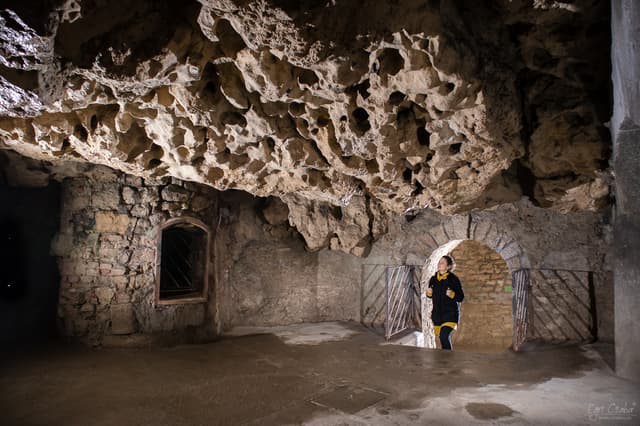
Vár-barlangi séták (Budai Vár-barlang)
@pedralexpereira
The Vár-barlangi Séták (Castle Cave Tours) offer visitors a chance to explore the underground caves beneath the Buda Castle in Budapest. The Buda Castle Cave System, also known as the Budai Vár-barlang, consists of a series of natural and man-made tunnels that stretch underneath the Castle Hill area. These caves have a fascinating history and have been used for various purposes throughout the centuries, including as storage areas, shelters, and even as a part of the city's defense system.
The caves are a unique and lesser-known aspect of the Buda Castle, offering a different perspective on the history and architecture of Budapest. During the tours, visitors can see the geological formations and learn about the historical use of the caves, as well as the role they played during various military conflicts.
The cave tours are guided, and participants can discover the hidden depths of the Castle Hill while learning about the geological and historical significance of the caves. This is an exciting way to explore a different side of Budapest, especially for those interested in history and underground exploration.

Details
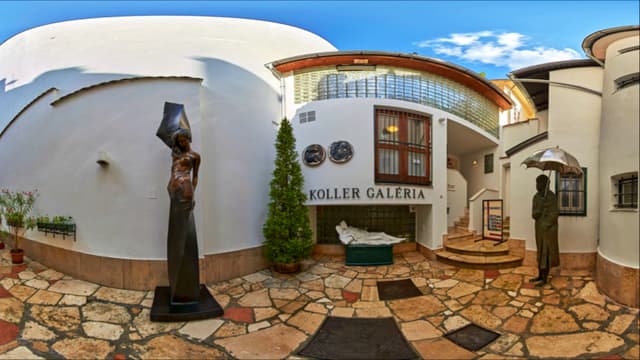
Koller Gallery
@pedralexpereira
The Koller Gallery is a renowned private art gallery located in the Castle District of Budapest, Hungary. It was founded in 1953 by György Koller (1923–1996), a key figure in the Hungarian art scene, particularly in the field of graphic art. The gallery is housed in a three-story atelier-house and has played a significant role in promoting both Hungarian and international contemporary art.
The gallery's history began shortly after World War II, when György Koller also founded the Association of Hungarian Engravers (RMAK) in 1953, to support and promote Hungarian printmakers. In 1980, the Koller Gallery opened its doors as Hungary’s first private gallery in the atelier-house of the Hungarian-Italian sculptor Amerigo Tot. Tot, known for his sculptures and artistic contributions, was closely associated with the gallery, which began to showcase not only graphic art but also sculpture and painting.
In addition to its exhibitions, by 1984, Koller Gallery was involved with the Hungarian National Gallery, where it opened an exhibition and auction space. The gallery also expanded to include exhibition rooms in Sándor Petőfi Street and at the Hilton Hotel in the Castle District. After the passing of György Koller in 1996, the gallery was managed by his grandson, continuing its mission to support modern and contemporary art.
In 2010, a memorial room dedicated to Amerigo Tot was inaugurated on the top floor of the gallery. This space serves as a tribute to the artist's legacy, showcasing his work and offering a deeper insight into his contributions to both Hungarian and international art scenes. The memorial room functions as a permanent exhibition center for Tot’s sculptures and is a key part of the gallery's offerings.
The gallery is also home to a sculpture garden, where visitors can enjoy outdoor exhibitions and installations, furthering the gallery’s dedication to showcasing both modern and contemporary sculpture.
From its inception, the Koller Gallery has focused on representing contemporary Hungarian artists, especially those working in engraving and graphic arts. Over time, the gallery expanded its scope to include sculptors and painters. Today, the gallery continues to represent a diverse array of artists, offering a platform for both Hungarian and international talent in the realm of modern and contemporary art. Additionally, it provides art appraisals and services for art collectors.

Details
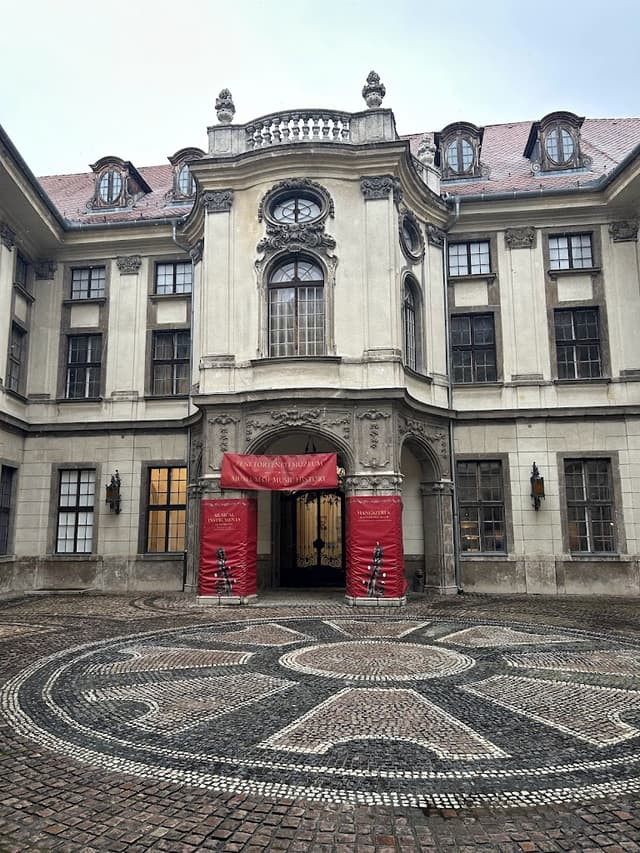
Museum of Music History
@pedralexpereira
The Museum of Music History, also known as the Institute for Musicology, showcases the rich musical heritage of Hungary from the 18th century to the present day. Located in a beautiful courtyard near the Fisherman’s Bastion and Matthias Church, the museum offers a comprehensive journey through Hungary's musical history.
The museum’s exhibits include recitals, sheet music, and original scores, along with multimedia displays. This immersive experience allows visitors to listen to recordings of the instruments on display, enhancing the museum's appeal to anyone with an interest in music.
A key highlight of the museum is the gramophone used by Hungarian composers Béla Bartók and Zoltán Kodály. This instrument was pivotal in capturing the authentic folk music from the diverse nations of the Carpathian Basin, including Hungarian, Szekler, Transylvanian, Romanian, and Slovakian influences. These recordings are crucial in understanding the blend of folk traditions that shaped Hungarian music.
The museum's collection also features a remarkable array of original scores, programs, books, and historical musical instruments, many of which are numbered and labeled, some in English. The focus is on Hungarian music, emphasizing its deep folk traditions. Visitors can explore the works of composers like Franz Liszt, Béla Bartók, and Zoltán Kodály, as well as Hungarian Gypsy music, all of which showcase the diversity and richness of the country’s musical culture.

Details
Mediaeval Jewish Chapel
@pedralexpereira
The Medieval Jewish House of Prayer is located in the Buda Castle District on Táncsics Mihály Street, within the historical Jewish quarter of medieval Buda. The synagogue was built in 1461 on the ground floor and in the courtyard of a house in the area. It remained in use throughout the Turkish occupation of Hungary.
The synagogue’s walls offer insight into the Jewish life in Buda during the Middle Ages and under Ottoman rule. The vault features painted images from the 16th and 17th centuries, and there is a collection of tombstones on display. The building also contains interior drawings and inscriptions dating from the 16th century.
The synagogue was destroyed in 1685 during the war against the Turks, but it was rediscovered in 1964 and restored in 1968. Today, the building houses an exhibition on Jewish culture and history and also serves as a place of worship.

Details
Religious temples
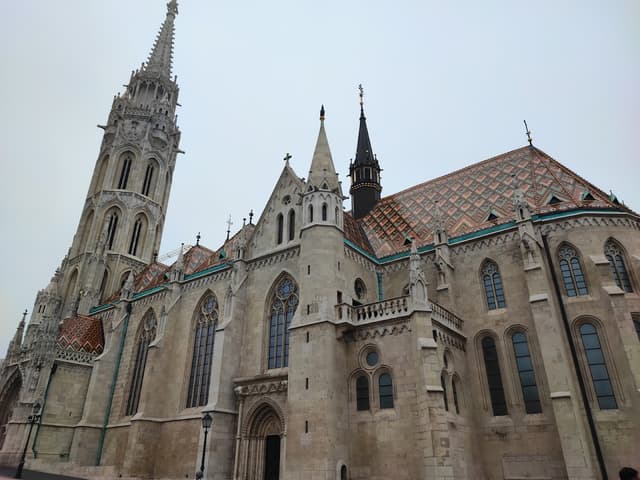
The Church of Our Lady of Buda Castle
@pedralexpereira
Originally built in Romanesque style in 1015, the church underwent several reconstructions over the centuries, and the current structure was built in the late Gothic style during the second half of the 14th century. Extensive restoration work in the late 19th century brought the church to its present state, highlighting its florid Gothic features. It was the second-largest church in medieval Buda and the seventh-largest in the medieval Kingdom of Hungary.
The church holds a significant place in Hungarian history, serving as the site of the coronations of two Hungarian kings: Franz Joseph I and Charles IV. It is also famous for its role during the Marian Miracle of Buda in 1686. During the siege of Buda by the Holy League, the church had been converted into a mosque by the Ottoman occupiers. When a wall of the mosque collapsed due to cannon fire, a Madonna statue hidden behind the wall was revealed. This event, perceived as a divine sign, led to a collapse in the morale of the Muslim forces, and Buda fell on the same day.
The pulpit of Matthias Church, built between 1890 and 1893 during the restoration, is an example of Neo-Romanesque art and was designed by Frigyes Schulek with contributions from art historian Béla Czobor. The pulpit is made of sandstone and features ornamental painting and statues carved by Ferenc Mikula. The abat-voix, a feature resembling a medieval tower, is carved from oak, and the statue of the Good Shepherd on top is made of linden wood. The sculptural decoration of the pulpit’s parapet includes statues of the four evangelists and the four Latin doctors of the Church.
The church's bell tower houses six bells, three of which are historic (dating from 1723, 1724, and 1891). The seventh bell hangs in the cavalry tower. Four new bells were added in 2010, and the St. Károly bell underwent a sound correction at that time.

Details
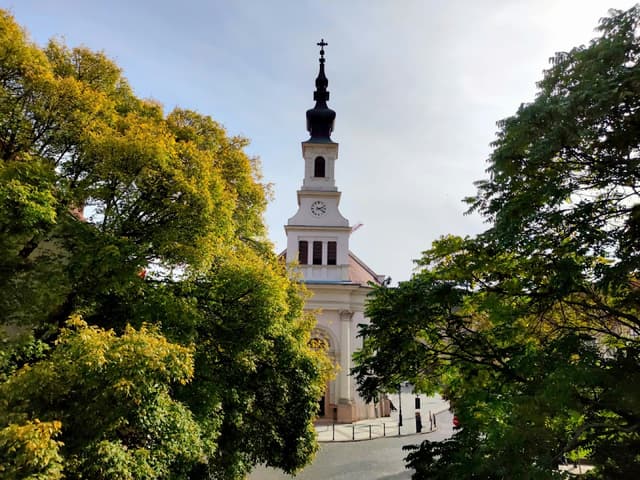
Budavári Evangélikus Templom és Gyülekezet
@pedralexpereira
The Budavári Evangelical Church and Congregation is located in the Buda Castle District of Budapest, Hungary. The church is a prominent place of worship for the Lutheran community in the city. It was originally built in the 18th century and underwent significant restoration and expansion in the 19th century, making it a key historical and religious landmark in the area.
The church's architecture reflects a blend of Baroque and Neo-Classical styles, typical of many buildings from that period in Budapest. The interior of the church is known for its simple yet elegant design, with wood paneling and stained-glass windows that enhance its peaceful and reflective atmosphere.
The Budavári Evangelical Church serves not only as a place for religious services but also as a cultural hub for the local Lutheran community. The congregation hosts various events, including concerts and educational programs, and it plays an active role in community outreach.

Details
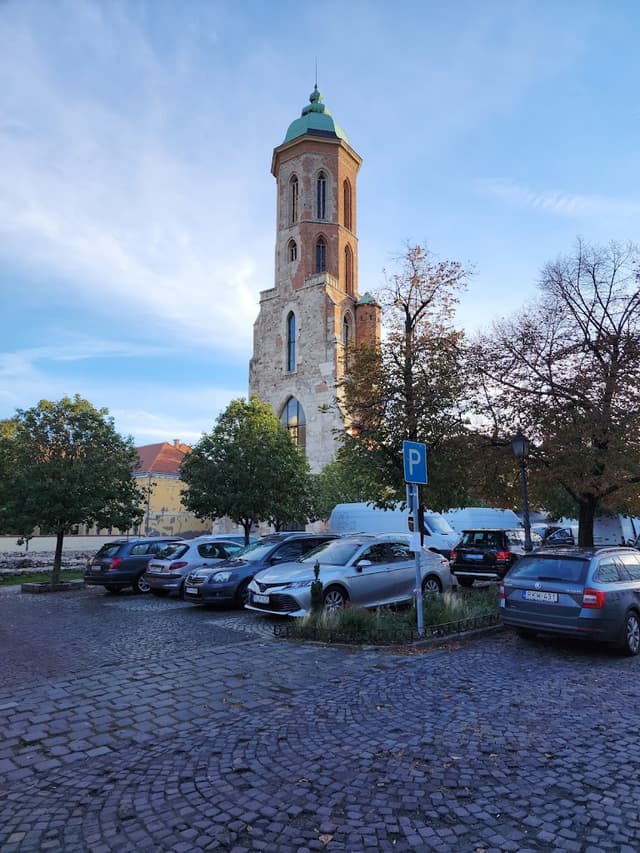
Church of Saint Mary Magdalene
@pedralexpereira
The Magdalene Tower, also known as Buda Tower, is a unique and fascinating landmark in the Buda Castle District, offering some of the most spectacular views in the area. The tower is part of the Church of Mary Magdalene, a historic church built in the 13th century. The church and its tower have had a tumultuous history, much like the broader history of Hungary itself.
The church suffered significant damage during World War II, and for many years, the tower and church were closed to the public. After extensive restoration, the Magdalene Tower was reopened to visitors. The tower stands tall, offering an impressive view of Budapest from its summit, accessible by climbing 170 stairs. The panoramic vistas are well worth the climb, allowing visitors to see many of Budapest's most iconic buildings from a unique vantage point.
The Church of Mary Magdalene, which the tower is part of, has a rich historical background, having endured wars, damage, and destruction over the centuries. Despite its troubled past, the tower now serves as a symbol of resilience and provides a glimpse into the city’s layered history.

Details
Tabán and Gellérthegy
Tabán is a historic neighborhood located at the foot of Gellért Hill (Gellérthegy) on the Buda side of Budapest, known for its picturesque, village-like charm and its significant role in the city’s history. The area was once a working-class district, predominantly inhabited by fishermen, artisans, and laborers, with narrow, winding streets and traditional houses. It has undergone significant changes over the years, particularly after World War II, when much of the old neighborhood was demolished and rebuilt. Today, while the area has modernized, it still retains traces of its past in the form of old houses and a relaxed, residential vibe. Tabán was historically associated with vineyards, and remnants of this agricultural past can still be seen in the surrounding landscape.
Gellérthegy (Gellért Hill), rising majestically above the Tabán area, is one of the most prominent natural landmarks in Budapest. The hill, named after Saint Gellért, is a site of historical and cultural significance. According to legend, Saint Gellért was martyred by being thrown from the hill during the 11th century, and a monument dedicated to him stands on the summit. Today, Gellért Hill is a popular destination for both locals and tourists, offering sweeping panoramic views of the city, including the Danube River, Buda Castle, and the Parliament Building. The hill is also home to the famous Gellért Baths, an iconic Art Nouveau thermal spa that draws visitors seeking relaxation in its historic, mineral-rich waters. Historically, the hill has been a strategic location for military fortifications, and it played an important role in Budapest’s defense during various wars, including World War II. The combination of lush green spaces, historical sites, and stunning views makes Gellért Hill and the neighboring Tabán area a must-visit for anyone exploring Budapest’s rich history and natural beauty.
Architecture and urban spaces
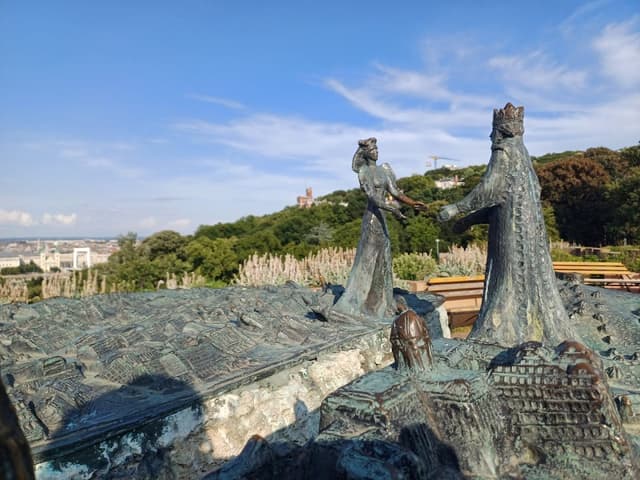
Prince Of Buda & The Princess Of Pest Monument
@pedralexpereira
The Prince of Buda and Princess of Pest is a poignant sculpture located on Gellért Hill, overlooking the city of Budapest. This artwork symbolizes the unification of the once independent towns of Buda, Óbuda, and Pest into the city of Budapest in 1873. The sculpture tells the story of Prince Buda and Princess Pest, two lovers separated by the Danube River. It captures the moment they reach out to embrace each other over the river, symbolizing the joining of the two halves of the city.
The statue's narrative is a beautiful yet tragic one, reflecting the geographical and historical contrasts between Buda and Pest. Buda is characterized by its hilly, greener, and older landscape, while Pest is known for its flat, dynamic, and urban qualities. The sculpture, created by Martha Lesenyei in 1982, is positioned near the Garden of Philosophers on Gellért Hill. From this vantage point, visitors can enjoy a panoramic view of Budapest, with its iconic landmarks, representing the unity of the city today.

Details
Statue of Elizabeth Queen of Hungary
@pedralexpereira
Northwest of Elizabeth Bridge, you’ll find a statue of Empress Elizabeth of Austria, known affectionately as "Sissi," who was also Queen of Hungary through her marriage to Franz Joseph I. Sissi was adored by the Hungarian people, particularly because she made an effort to learn their language, which endeared her to them. Tragically, she was assassinated in 1898 by an Italian anarchist in Geneva, who used a sharpened needle file to take her life. The statue stands as a tribute to her enduring legacy and her strong connection with Hungary.

Details
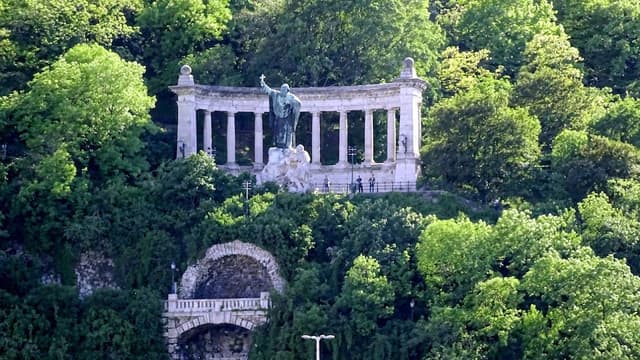
St. Gerard Sagredo Statue
@pedralexpereira
In the early 11th century, Gellért (Gerard in English), a Benedictine Abbot from Venice, was on a pilgrimage to Palestine when he was detained by King Stephen of Hungary. The king asked Gellért to stay in Hungary to tutor his son Imre and assist in converting the Magyars to Christianity. Gellért accepted the king's request and remained in Hungary for many years under royal protection.
However, after King Stephen's death in 1038, unrest grew among the pagan insurgents. In 1046, Gellért was captured in Buda by these insurgents who wanted to return to paganism. According to legend, he was placed in a barrel pierced with nails and rolled down the steep hill, leading to his death. The hill, previously called Kelen-hegy, was later renamed Gellért-hegy in honor of the saint.
A monument commemorating Gellért's death was erected in 1904 at the site of his martyrdom. The statue, designed by sculptor Gyula Jankovits, stands 12 meters tall (39 feet) and depicts Gellért holding a crucifix triumphantly. At his feet, a wild-looking Magyar gazes up at the bishop in awe. The statue is framed by a neoclassical semicircular colonnade, and a small waterfall flows below the sculpture.
For a stunning view of the monument, you can look from the nearby Elizabeth Bridge. If you'd like a closer look, you can climb a set of steps that lead up to the statue. The monument is visible from across Budapest, and it is especially striking at night when it is illuminated.

Details
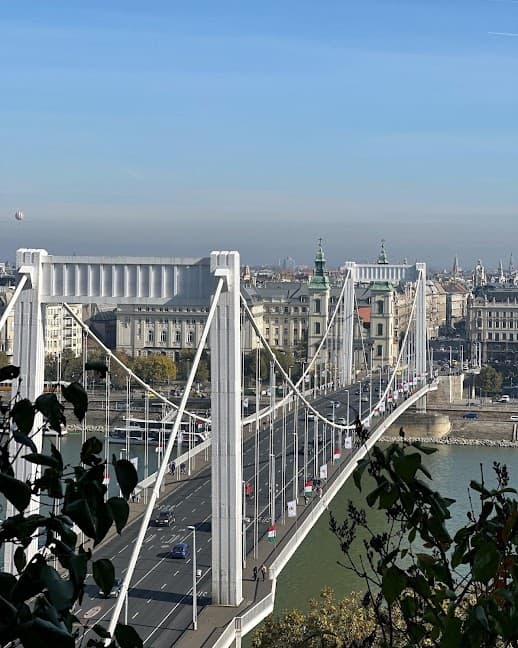
Erzsébet Bridge
@pedralexpereira
The Elisabeth Bridge, connecting Buda and Pest across the Danube, is the third newest bridge in Budapest and spans the river at its narrowest point in the city, measuring just 290 meters. Named after Elisabeth of Bavaria, the beloved Austrian-Hungarian queen who was assassinated in 1898, the bridge commemorates her legacy with a bronze statue on the Buda side, nestled within a small garden.
The bridge's history begins with its original construction between 1897 and 1903, a decorative suspension structure in the eclectic style, built amidst a corruption scandal involving inflated land sales. The bridge’s placement near Gellért Hill necessitated complex road arrangements. Initially built for horse-drawn carriages, the design’s sharp curves have since proven hazardous for modern vehicles, leading to tragic accidents and a speed limit on westbound lanes.
The original bridge was destroyed during World War II, like many of Hungary’s crossings. Unlike others, it could not be rebuilt in its original form, and remnants of its ornate structure now reside in the Museum of Transport. Between 1961 and 1964, a new design by Pál Sávoly replaced the old structure. This modern iteration, inspired by the Mülheim Bridge in Cologne, is a starkly simple white cable bridge, reflecting the brutalist aesthetic of its era. Its construction relied on existing foundations due to financial constraints. However, structural issues required the removal of tram tracks by 1973, and weaknesses in its design highlighted the technological limitations of early computer modeling.
In recent years, Elisabeth Bridge has been enhanced with special lighting designed by Japanese artist Motoko Ishii, marking cultural and diplomatic milestones between Hungary and Japan. The lighting project, partially funded by Japan, highlights the bridge’s significance as a symbol of unity and renewal.
Adding to its cultural resonance, the statue of Elisabeth of Bavaria has a history as intricate as the bridge itself. Initially unveiled in 1932 on the Pest side, the monument suffered damage during the war and underwent multiple restorations before finding its current home on the Buda side in 1957. Today, the Elisabeth Bridge stands not just as a functional crossing but as a testament to the city’s resilience, bridging historical epochs and architectural styles.

Details
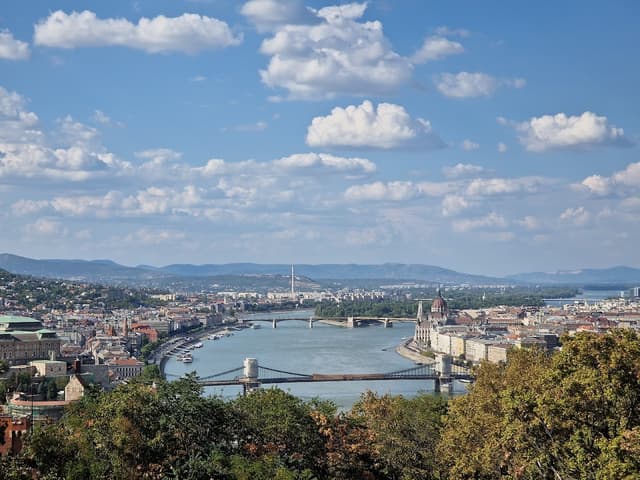
Citadel Lookout
@pedralexpereira
The Citadel Lookout, located atop Gellért Hill in Budapest, offers one of the most spectacular panoramic views of the city. The Citadel itself, built in 1851 by the Habsburgs, was originally constructed as a military fortress to control the city after the Hungarian Revolution of 1848. Today, the Citadel serves as a popular tourist destination, offering sweeping views of Budapest, including the Danube River, the Buda Castle, Parliament Building, and the surrounding bridges that connect Buda and Pest.
The lookout is easily accessible via a series of steps or by a winding road leading up the hill. Once at the top, visitors can take in breathtaking vistas, with the city spread out beneath them. The view is especially stunning at sunset or at night when the city's lights illuminate the skyline.
The Citadel is also home to a large statue of Liberty (Szabadság Szobor), erected in 1947 in honor of the Soviet liberation of Hungary during World War II. The lookout area around the statue offers great photo opportunities, as it allows visitors to capture the unique blend of historical architecture and natural beauty of the city. The Citadel Lookout is a must-visit for anyone exploring Budapest, offering a comprehensive and memorable view of the city.

Details
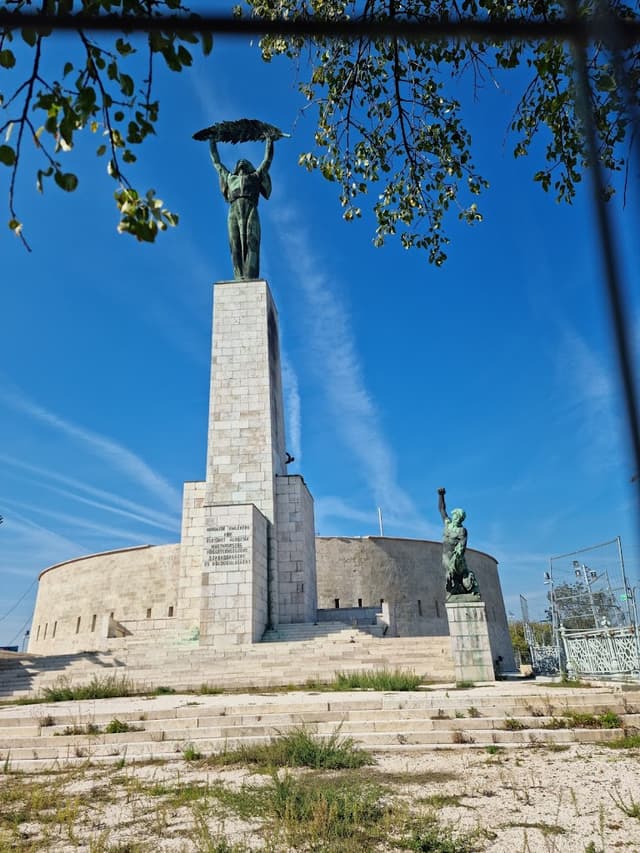
Citadella
@pedralexpereira
The Citadella, located on top of Gellért Hill in Budapest, is a prominent fortification with a significant role in Hungary's military and political history. Built in 1851 by the Austrian Empire following the Hungarian Revolution of 1848, it was designed by architects Emmanuel Zitta and Ferenc Kasselik. The fortress was erected to suppress any future uprisings and to establish Austrian dominance over Hungary. It is a large U-shaped structure with a central courtyard, measuring 220 meters long and 60 meters wide, and originally housed sixty cannons. The citadel was completed in 1854, largely by Hungarian forced labor.
During its early years, the Citadella housed Austrian garrison troops until 1897 when the military presence ended, following the Austro-Hungarian Compromise. While the Hungarians sought to demolish the structure, it remained intact until late 1899 when the city took ownership. In the early 20th century, parts of the fortress were dismantled. The Citadella played a role in the Hungarian Revolution of 1956 when Soviet forces used it as a base, firing down on the city as they quelled the revolution.
Today, the Citadella remains a historic landmark offering stunning panoramic views of Budapest, including the Danube, Buda Castle, and the Parliament Building. It also features the Statue of Liberty (Szabadság Szobor), erected in 1947 to commemorate the Soviet liberation of Hungary.

Details
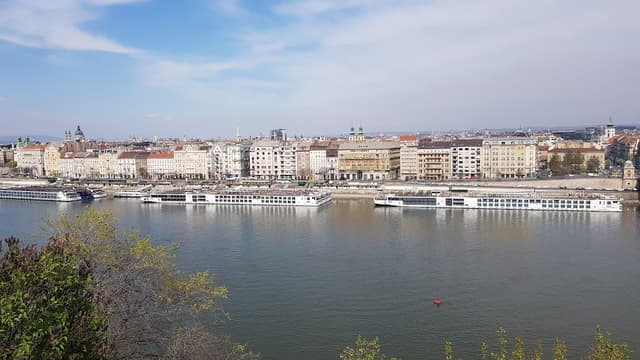
Citadella-Kilátóterasz
@pedralexpereira
The Citadella-Kilátóterasz, or Citadella Lookout Terrace, is a popular viewpoint located at the top of Gellért Hill in Budapest, offering some of the best panoramic views of the city. The terrace is part of the Citadella, a historic fortress that was built in the mid-19th century, and it provides a stunning vantage point of Budapest's landmarks, including the Danube River, the Buda Castle, the Parliament Building, and the Pest side of the city.
The lookout terrace is a prime spot for visitors to admire the sweeping vistas and take photographs, especially at sunrise and sunset when the city is bathed in warm light. The Citadella-Kilátóterasz is accessible by a scenic walk up the hill or via public transport, and once at the top, visitors can enjoy breathtaking views of Budapest's skyline and the surrounding hills. The area is also home to the famous Statue of Liberty (Szabadság Szobor), which stands near the terrace and adds to the historical and symbolic significance of the site.

Details
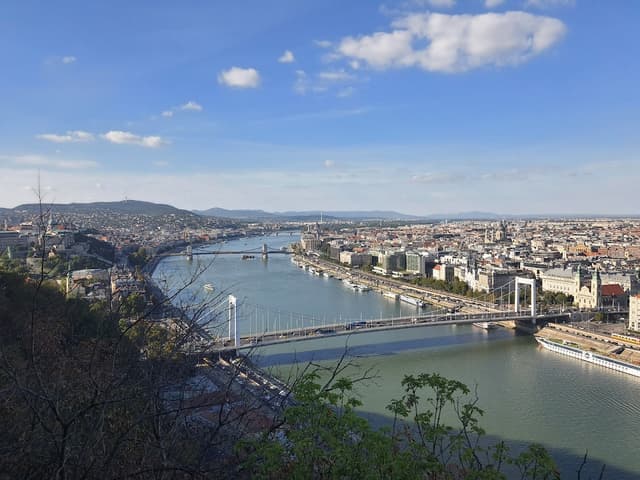
Gellért Hill Vista Point
@pedralexpereira
The Gellért Hill Vista Point is another fantastic viewpoint located at the top of Gellért Hill in Budapest. Gellért Hill itself is one of the most iconic locations in the city, offering sweeping panoramic views of Budapest, including the Buda Castle, the Danube River, the Parliament Building, and the Pest side of the city.
The vista point is accessible by a series of walking paths, or visitors can take a bus to the summit. The area is well known for its stunning vistas and is a popular spot for tourists and locals alike to relax and take in the scenery. It is also home to some historical landmarks, such as the Citadella fortress and the Statue of Liberty, both of which add to the cultural and historical value of the vista point.
From the Gellért Hill Vista Point, visitors can enjoy one of the most picturesque views in Budapest, making it a perfect spot for photography, sightseeing, and enjoying the beauty of the city. The spot is particularly striking at sunset or in the evening when the city's lights illuminate the skyline.

Details
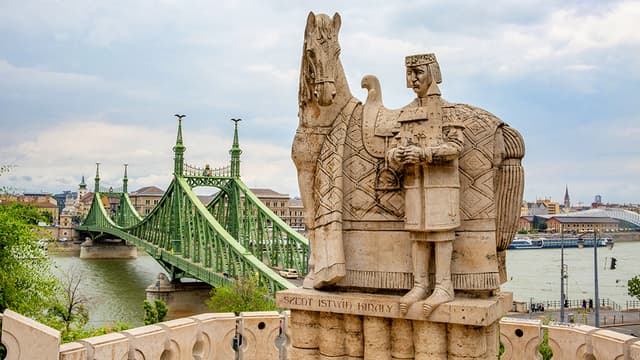
Szent István Király szobra
@pedralexpereira
The statue of Saint Stephen by Pál Kő, consecrated on Pentecost in 2001, stands on Gellért Hill in Budapest, in front of the rock chapel. The sculpture portrays Saint Stephen, Hungary’s first Christian king, standing next to his horse while holding a Romanesque-style church model in his hands. The model symbolizes his role in the establishment of Christianity in Hungary.
The composition of the statue is unique, with the horse being the dominant figure in the scene. Instead of carving the horse in full, the sculptor envelops the animal in a shroud-like covering that reveals only its neck and head at the front, with its rear and tail exposed at the back. This creates a visual effect that emphasizes the horse’s mass in comparison to the relatively small figure of Saint Stephen.
The figure of the king is portrayed as a young, somewhat fragile man, on the cusp of adolescence, his gaze pious yet somewhat melancholic. His knightly boots, with their long toes hanging loosely, add a touch of playful absurdity to the statue. The crown on his head is intentionally simple, with Byzantine influences, hinting at a historic, medieval aesthetic.
The statue incorporates references to medieval imagery, particularly the depiction of the king as a church founder, a figure common in medieval miniatures. The combination of historical symbolism, the expressive form of the statue, and its location in front of the rock chapel makes it a compelling addition to the views and landmarks on Gellért Hill.

Details
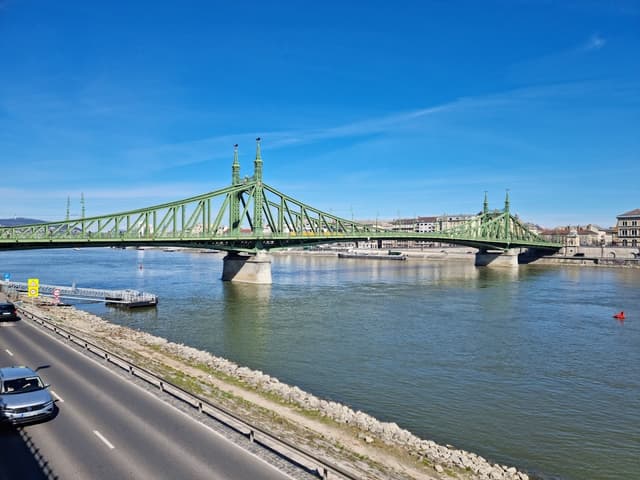
Liberty Bridge
@pedralexpereira
Liberty Bridge, known locally as Szabadság híd, is one of Budapest’s most striking and historically significant bridges, connecting the Buda and Pest sides of the city over the Danube. Originally completed in 1896 as part of the grand celebrations for the Millennium World Exhibition, it was first named Ferenc József híd after Emperor Franz Joseph, who inaugurated the bridge. The emperor himself placed the last rivet into the Pest abutment, marking the completion of the bridge. In 1956, following the Hungarian Revolution, it was renamed Liberty Bridge to symbolize the desire for freedom.
The bridge, built to a design by János Feketeházy, is renowned for its distinctive Art Nouveau style. The structure is a cantilever truss bridge, a type that was a modern engineering feat at the time. Though the design is different from that of earlier suspension bridges, its outline was deliberately modeled to evoke the appearance of a chain bridge, which was highly regarded for its elegance during that period. The bridge spans 333.6 meters in length and 20.1 meters in width, making it the shortest of Budapest's central bridges.
Decorative elements add to the bridge’s grandeur, including large bronze statues of the Turul, a mythical falcon-like bird, perched atop its four masts. These statues reflect Hungary’s rich history and mythological heritage. The bridge is also adorned with the national coat of arms, further emphasizing its symbolic importance.
At either end of Liberty Bridge are bustling public squares: Gellért tér on the Buda side, known for the iconic Gellért Spa and Hotel, and Fővám tér on the Pest side, which is home to the Great Market Hall. The bridge serves as a crucial transport link, with trams and vehicles crossing regularly. There are even plans to make it a pedestrian-only bridge now that the city’s metro system has been expanded with the completion of the fourth metro line.
Liberty Bridge stands as not only a functional crossing but also a testament to Budapest's architectural heritage, a symbol of its resilience through the years, particularly since it was the first bridge to be rebuilt after suffering damage during World War II. The northeastern corner of the bridge houses a museum dedicated to the history of Budapest’s bridges, adding an educational aspect to this iconic landmark.

Details
Museums, cultural venues and activities
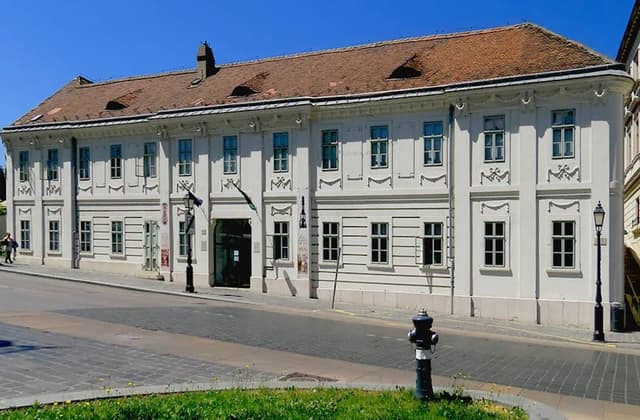
Semmelweis Museum
@pedralexpereira
The Semmelweis Museum, Library, and Archive of the History of Medicine is a significant institution in Budapest dedicated to the history of medicine, particularly highlighting the contributions of Ignaz Semmelweis, the Hungarian physician renowned for pioneering antiseptic procedures. The museum is located in Meindl House, the 18th-century building where Semmelweis was born on July 1, 1818. Established in 1965, the museum became a department of the Hungarian National Museum in 2017, expanding its scope to include not only the history of Hungarian healthcare but also key moments in the development of medicine across Europe.
Meindl House, where Semmelweis was born, is a national monument and holds a deep historical connection to both the Semmelweis family and the broader medical history. The building itself was constructed around 1790 and rebuilt after the Great Tabán Fire of 1810 in the Late Baroque style. Its location at the foot of Castle Hill, near the Pest-Buda Floating Bridge, made it a significant spot for trade and traffic during the 19th century. Semmelweis's family lived there while his father, Joseph Semmelweis, ran a grocery shop. Ignaz Semmelweis, who went on to study medicine in Vienna, made groundbreaking discoveries in obstetrics that led to a drastic reduction in childbed fever through the implementation of hand disinfection in obstetrical clinics. His contributions earned him the title "Savior of Mothers."
The Semmelweis Museum offers an in-depth look at the evolution of medical practices, with a primary focus on Semmelweis's life and legacy. The museum’s collections include medical instruments, manuscripts, and a variety of historical objects related to healthcare. The Ignaz Semmelweis Memorial Room is part of the museum's permanent exhibition, which also features a re-creation of Török Pharmacy, a historic pharmacy that highlights the development of pharmaceutical practices. The Motherhood statue, a bronze sculpture by Miklós Borsos, stands in the museum's courtyard in honor of Semmelweis's contributions.
The museum underwent significant renovations in the 1960s, including the restoration of the building’s facade and the addition of modern wings to accommodate its growing collection. It also became a key site for commemorating Semmelweis's legacy, with the remains of the doctor relocated to the museum in 1963.
The museum has been instrumental in advancing the study of medical history in Hungary. Under the leadership of József Antall, who later became the first democratically elected Prime Minister of Hungary, the museum made significant strides in medical historical research. The museum organized international conferences and exhibitions, and Antall’s contributions helped establish medical history as an academic discipline in Hungary.
With its rich history, the Semmelweis Museum continues to play a crucial role in educating the public about the pivotal moments in medical history and the lasting impact of Semmelweis’s work on modern medicine. The museum won the Museum of the Year Award in 2010 and is regarded as an important cultural institution in Budapest.

Details
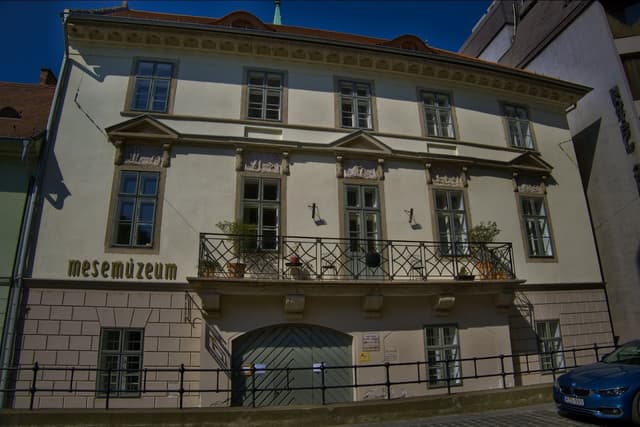
Fairy Tale Museum, Budapest
@pedralexpereira
The Fairy Tale Museum (Mesemúzeum) in Budapest offers an enchanting experience for children and families, immersing visitors in the magical world of Hungarian folklore. The museum's permanent exhibition, titled the "World of Hungarian Fairytales", takes visitors on an imaginative journey through the realm of local legends and fairy tales. Beginning their adventure by crossing over the mythical Crystal Mountains, visitors must navigate a series of tasks and challenges, closely aligned with the stories and characters that have shaped Hungarian storytelling traditions.
In addition to the exhibition, the museum serves as a creative space for children, hosting activities like theatre performances, shadow and puppet shows, and drama coaching. These performances allow children to engage with fairytales in a dynamic, hands-on way, helping them develop their artistic skills. Creative workshops also play a significant role, offering activities such as drawing, painting, and puppet- and costume-making. These workshops encourage young visitors to interact with the stories, bringing characters to life through their own imaginations.
The museum is designed with a visual approach to storytelling, allowing visitors to engage with the space and exhibits in a way that stimulates both creativity and critical thinking. It's an interactive and educational experience that nurtures a love for Hungarian folklore while offering a fun, hands-on environment for children to explore the world of fairytales.

Details
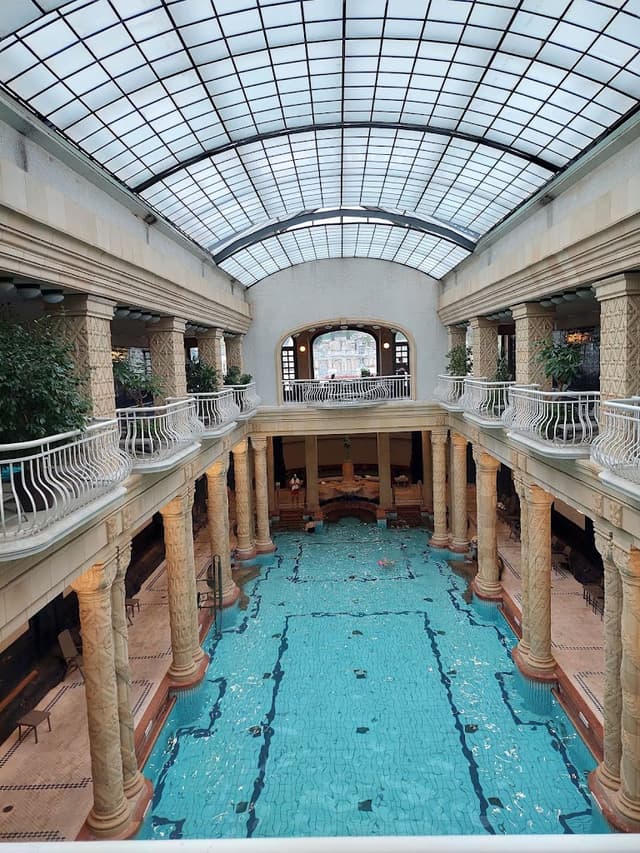
Gellért Thermal Bath
@pedralexpereira
The Gellért Thermal Bath, part of the renowned Hotel Gellért in Budapest, is a historic bath complex known for its Art Nouveau architecture. Built between 1912 and 1918, the bath was damaged during World War II but was later rebuilt. The history of healing waters at this location dates back to the 13th century, with a hospital present during the Middle Ages. The Turkish utilized the site during the Ottoman Empire, building baths and using the “magical healing spring” throughout the 16th and 17th centuries. The bath earned the name Sárosfürdő, meaning "muddy bath," due to the mineral mud that settled at the bottom of the pools.
The first extensive renovation of the Gellért Baths took place in 2008, restoring the facility to its former grandeur after years of economic challenges following World War II. The thermal bath had remained open even during the war, though the Art Nouveau women’s bath was bombed, destroying the ornate façade and wooden interiors. The post-war redesign was simpler, but the 2008 renovation returned the bath to its original splendor.
The Gellért Baths complex includes thermal baths supplied by mineral hot springs from Gellért Hill. The water is rich in calcium, magnesium, alkalis, chloride, sulfate, and fluoride, and is known to help treat degenerative joint diseases, spine problems, chronic joint inflammations, and circulatory disturbances. The water temperature ranges between 35 and 40 °C (95 to 104 °F). The bath is famous for its main hall with a gallery and a glass roof, showcasing the intricate Art Nouveau design.
The bath complex also features a range of facilities, including saunas, plunge pools, an open-air swimming pool with artificial waves created every 30 minutes, and a Finnish sauna with a cold pool. Medical services, including massages, are available, and towels and swimsuits can be purchased in the spa. The baths were originally divided by gender, but in January 2013, the pools became mixed-gender while maintaining separate sections for men and women. The indoor area includes four medical pools, a 246-square-meter swimming pool, underwater traction pools, and a warm sitting pool. The outdoor area features a large wave pool and additional plunge and sitting pools.

Details
Religious temples
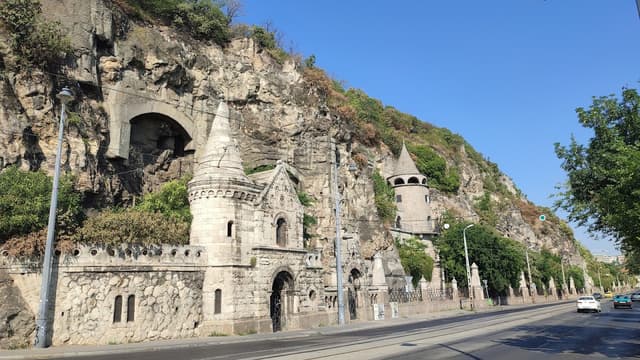
Gellért Hill Cave
@pedralexpereira
The Gellért Hill Cave (Hungarian: Gellérthegyi-barlang) is part of a network of caves within Gellért Hill in Budapest, Hungary. The cave is also referred to as "Saint Ivan's Cave" (Szent Iván-barlang), regarding a hermit who lived there and is believed to have used the natural thermal water of a muddy lake next to the cave to heal the sick. It is likely that this same water fed the pools of the old Sáros fürdő ("Muddy Baths"), now called Gellért Baths.[1][2]
Background
In the 19th century the cave was inhabited by a poor family who built a small house of sun dried bricks in the great opening. The mouth of the cave was closed off with a planking and it was used as a peasant courtyard. This situation was recorded on a painting by Mihály Mayr (made sometime in the 1860s) and a photograph by György Klösz in 1877.[3]
The first modern entrance for the caves was constructed in the 1920s by a group of Pauline monks who have been inspired by similar rock constructions during a pilgrimage in Lourdes, France. Kálmán Lux, professor at the Technical University, Budapest was the architect in charge.[4] After its consecration in 1926, it served as a chapel (Sziklatemplom English: Cave Church) and monastery until 1951. During this time, it also served as a field hospital for the army of Nazi Germany during World War II.
In 1945, the Soviet Red Army captured Budapest. For six years, the cave continued its religious functions, but in 1951, the State Protection Authority raided the chapel as part of increasing action against the Catholic Church. As a result of the raid, the cave was sealed, the monastery's superior, Ferenc Vezér, was condemned to death, and the remaining brothers were imprisoned for upwards of ten years.[citation needed]
As the Iron Curtain disintegrated, the chapel reopened on 27 August 1989 with the destruction of the thick concrete wall that had sealed the cave. By 1992, the Chapel had been restored and the Pauline Order had returned to the cave. Today, the monks continue to perform religious functions within, though the cave is also a common tourist attraction. The church is complemented by a mysterious[citation needed] monastery carved into the rock and decorated with striking neo-gothic turrets. The walls of the cave are formed of natural rock. The church features many rooms, worthy of attention is the one in which all the ornaments have been carved in hardwood by a faithful follower of the Pauline Order. The terrace in front of the entrance is proudly guarded by the statue of Saint Stephen standing besides his horse.[citation needed]

Details
Green and open spaces
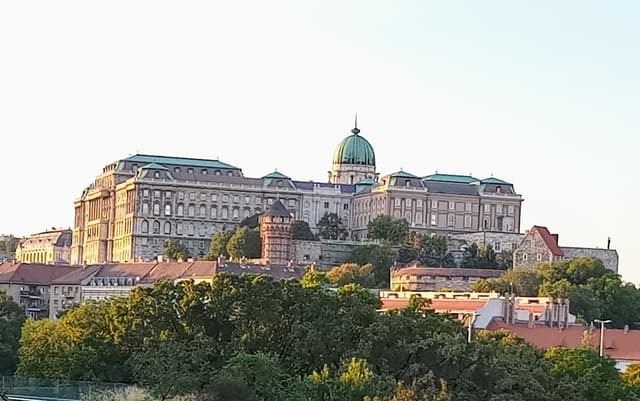
Tabán
@pedralexpereira
Tában Park (Tábán Park) is a public park located in Budapest, Hungary, in the Tabán district, near the base of Castle Hill. This area has a long history, with the name "Tabán" referring to the historical district that existed here, which was known for its proximity to the Buda Castle and its role in the city's medieval layout.
In modern times, Tában Park serves as a peaceful urban green space that offers a respite from the bustling city. It is a popular spot for both locals and tourists to relax, enjoy the outdoors, and take in the scenic views of the surrounding area, including Gellért Hill and the Buda Castle.
The park is situated in a historically rich area, and remnants of its past can still be seen in the surroundings. Over time, the Tabán district has undergone significant changes, including redevelopment projects, but the park remains an important part of the neighborhood's identity. It is an ideal location for casual strolls, picnics, and outdoor activities, offering a mix of open green space and pathways for visitors to explore. Additionally, its proximity to other notable attractions, such as the Gellért Hill Cave and the Gellért Baths, makes it a great stop for those exploring the Buda side of Budapest.

Details
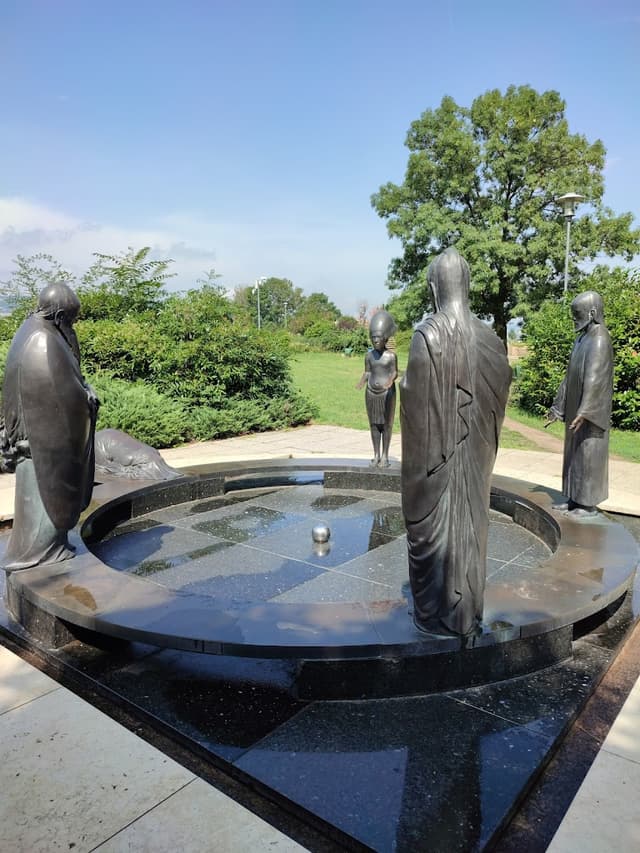
Garden of Philosophers
@pedralexpereira
In a secluded corner of Budapest’s Gellért Hill lies a unique and thought-provoking work of art known as "The Garden of Philosophy." Created by Hungarian sculptor Nándor Wagner in 1997 and relocated to its hillside spot in 2001, the sculpture brings together figures from the world’s major religions in a silent, symbolic gathering. Wagner’s goal was to promote mutual understanding and unity among the world’s religious traditions, and this peaceful installation is a testament to that vision.
The central element of the sculpture is an orb, around which five figures stand. These figures represent the founders of some of the world's major religious beliefs: Abraham, Jesus, Buddha, Laozi, and Akhenaten. The orb is about the size of a fist, symbolizing what is worshipped across these diverse faiths, and is the focal point of their silent gathering. Akhenaten, the ancient Egyptian pharaoh who introduced a form of monotheism centered around the sun god Aten, is an intriguing choice in this context. He stands slightly apart from the others, physically smaller and adorned with a large Egyptian war crown that gives him a distinct, otherworldly appearance.
Standing at the edges of this group are Mahatma Gandhi, Daruma Daishi (Bodhidharma), and Saint Francis, individuals whom Wagner saw as embodying spiritual enlightenment. Gandhi’s statue, recognizable to many, adds a modern, peaceful presence to the assembly.
Although Wagner initially envisioned a third circle of figures to include significant lawmakers like Hammurabi, Moses, and Justinian, he was unable to complete this part of the project before his death in 1997. The sculpture’s style reflects Wagner’s years spent in Japan, with an aesthetic that blends Eastern influences with global spirituality. In fact, another version of the installation was cast and displayed in the Japanese town of Mashiko.
Visitors to the site can also enjoy a striking view of Budapest from the hill, where they can find the personified statues of Prince Buda and Princess Pest. These figures represent the two historical cities that merged to form modern-day Budapest, adding another layer of symbolism to the already rich cultural tapestry of the area.

Details
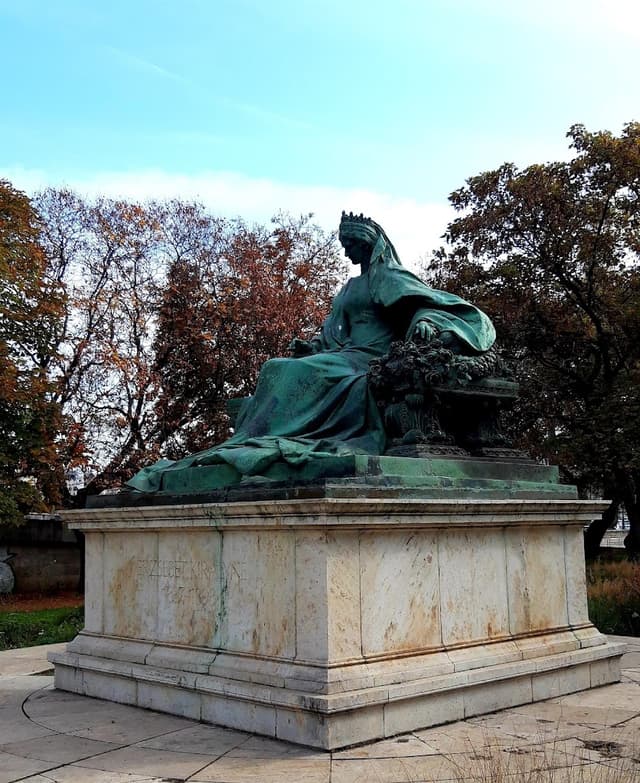
Döbrentei tér
@pedralexpereira
Döbrente Square (Döbrentei tér) is a small, quiet square located in the Buda side of Budapest, offering a pleasant retreat from the hustle and bustle of the city. Situated at the base of Gellért Hill, the square offers scenic views of the Danube River and the iconic Gellért Hill, making it a serene spot for relaxation and a starting point for exploration. It is particularly well-known for its proximity to the Gellért Baths and the famous Liberty Bridge, which is just a short walk away.
Though it is not a large park, Döbrente Square has a few green spaces and trees that enhance the area’s charm. The square features benches where locals and visitors can sit and enjoy the view, often accompanied by the sounds of nature and the city. The square is often used as a convenient location for those traveling around the area, and it’s easy to find, offering a restful spot before continuing your exploration of Buda.
In addition to its scenic value, Döbrente Square is connected to the surrounding historical landmarks, including the Liberty Bridge and the Gellért Hill, both of which hold great significance in Budapest's history and offer various cultural and sightseeing opportunities. The square provides a quieter alternative to the more tourist-heavy locations around the city, making it a pleasant stop on a Budapest tour.

Details
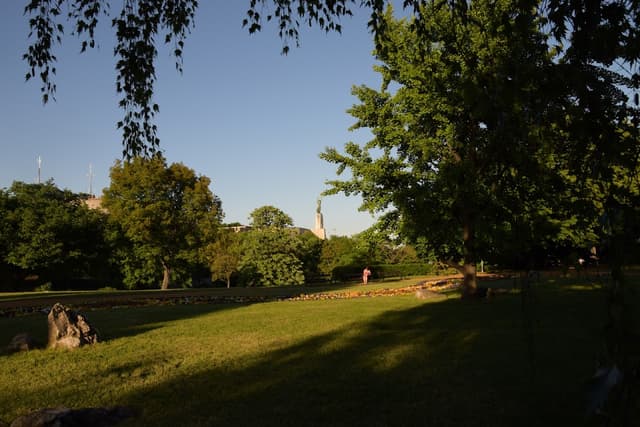
Gellért-hegy Jubileumi park
@pedralexpereira
Jubileumi Park (Jubilee Park) is a tranquil green space located on Gellért Hill in Budapest, offering a peaceful environment with scenic views of the city. The park was established to commemorate a significant anniversary, which is reflected in its name. It is positioned near the base of the hill and provides visitors with a quiet retreat while being in close proximity to several major landmarks, such as the Gellért Baths and the Liberty Bridge.
The park is well-maintained with grassy areas, trees, and benches, making it a great spot for a leisurely walk or a quiet rest while enjoying views of the Danube River, Pest, and the surrounding hills. It is not as crowded as other parks in Budapest, providing a more relaxed atmosphere for visitors who want to enjoy nature in the heart of the city.
Jubileumi Park is also a convenient starting point for those wishing to explore the famous Gellért Hill, known for its historical significance and panoramic vistas. The park itself offers a serene space to pause before heading up to explore the Citadel or the Statue of Liberty, both located at the summit of Gellért Hill.

Details
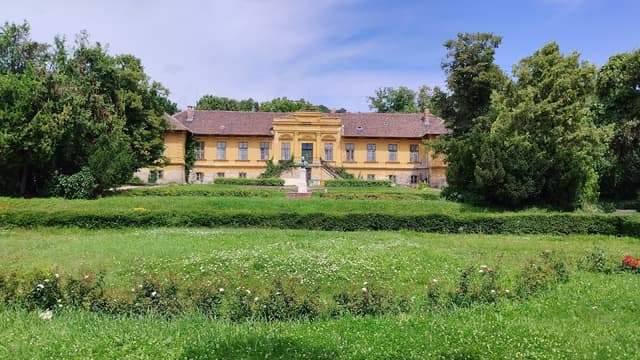
Buda Arboretum
@pedralexpereira
At the foot of Gellért Hill, a green sanctuary thrives amidst the lively pace of Budapest. This arboretum, established in 1835, spans 7.5 hectares and boasts nearly 2000 trees and shrubs, along with 240 bulbous flowers and 300 perennials, presenting a vivid display in every season. Its origins are rooted in the foundation of Hungary's first horticultural education garden by Ferenc Entz, a viticulturist, horticulturist, and former chief military physician during the 1848 Independence War. A bust of Entz stands in the Lower Garden as a tribute to his contributions.
Initially designed to support the Training Institute of Wine Making and Horticulture, the arboretum began with planting around its two main buildings in 1893 and 1894 under the supervision of Károly Räde, a chief horticulturist and dendrologist. The Upper Garden featured a taxonomic arrangement for educational purposes, while the Lower Garden, developed later in the 1920s, embraced a park-like design with themed plant communities. This expansion, led by landscape architect Dr. Béla Rerrich and dendrologist Gyula Magyar, brought the collection to over 1300 species, with notable additions like the rock garden, bamboo groves, and shade-loving plants.
Challenges such as the two world wars caused significant damage, reducing the number of species to around 800. However, post-war rehabilitation under Prof. Imre Ormos revitalized the collection. The arboretum achieved nature reserve status in 1975 and was later declared a protected heritage site in 2005. Today, visitors can explore its diverse flora year-round, from blooming flowers in spring to the vibrant autumn foliage, accompanied by the songs of native birds.
Serving as a campus for Szent István University since 2018, the arboretum provides education in horticulture, landscape design, and viticulture. Seasonal ornamental plant fairs and exhibitions further enhance its role as a hub of botanical and cultural significance. Open throughout the year, it offers free entry, inviting everyone to immerse themselves in its natural beauty and history.

Details
Belváros
Belváros (the Inner City) is the heart of Budapest, where history, commerce, and modern life intersect in a vibrant and bustling district. Located on the Pest side of the city, Belváros is home to many of Budapest's most iconic landmarks and cultural sites. Its most famous street, Váci utca, is a pedestrian thoroughfare lined with shops, cafes, and restaurants, offering a lively atmosphere for both locals and visitors. The area also boasts Vörösmarty Square, a central hub that hosts markets, festivals, and cultural events year-round.
Historically, Belváros has been the commercial and administrative center of Budapest since the city's founding. It is here that you'll find St. Stephen's Basilica (Szent István Bazilika), one of Hungary's most important religious structures, dedicated to the first king of Hungary, St. Stephen. The basilica’s impressive neoclassical design and its panoramic views from the dome make it a major draw for tourists. Just a short walk away, the Dohany Street Synagogue, the largest in Europe, stands as a testament to the city's rich Jewish heritage. Belváros is also home to the Hungarian National Museum, where visitors can learn about the country’s history from its early days to modern times. Over the centuries, Belváros has evolved from a medieval trading post to a bustling modern urban center, while still retaining much of its historical charm, with elegant architecture, cobbled streets, and charming squares. Today, it remains the cultural and commercial pulse of Budapest, offering a dynamic mix of history, shopping, dining, and entertainment.
Architecture and urban spaces

Erzsébet Bridge
@pedralexpereira
The Elisabeth Bridge, connecting Buda and Pest across the Danube, is the third newest bridge in Budapest and spans the river at its narrowest point in the city, measuring just 290 meters. Named after Elisabeth of Bavaria, the beloved Austrian-Hungarian queen who was assassinated in 1898, the bridge commemorates her legacy with a bronze statue on the Buda side, nestled within a small garden.
The bridge's history begins with its original construction between 1897 and 1903, a decorative suspension structure in the eclectic style, built amidst a corruption scandal involving inflated land sales. The bridge’s placement near Gellért Hill necessitated complex road arrangements. Initially built for horse-drawn carriages, the design’s sharp curves have since proven hazardous for modern vehicles, leading to tragic accidents and a speed limit on westbound lanes.
The original bridge was destroyed during World War II, like many of Hungary’s crossings. Unlike others, it could not be rebuilt in its original form, and remnants of its ornate structure now reside in the Museum of Transport. Between 1961 and 1964, a new design by Pál Sávoly replaced the old structure. This modern iteration, inspired by the Mülheim Bridge in Cologne, is a starkly simple white cable bridge, reflecting the brutalist aesthetic of its era. Its construction relied on existing foundations due to financial constraints. However, structural issues required the removal of tram tracks by 1973, and weaknesses in its design highlighted the technological limitations of early computer modeling.
In recent years, Elisabeth Bridge has been enhanced with special lighting designed by Japanese artist Motoko Ishii, marking cultural and diplomatic milestones between Hungary and Japan. The lighting project, partially funded by Japan, highlights the bridge’s significance as a symbol of unity and renewal.
Adding to its cultural resonance, the statue of Elisabeth of Bavaria has a history as intricate as the bridge itself. Initially unveiled in 1932 on the Pest side, the monument suffered damage during the war and underwent multiple restorations before finding its current home on the Buda side in 1957. Today, the Elisabeth Bridge stands not just as a functional crossing but as a testament to the city’s resilience, bridging historical epochs and architectural styles.

Details

Váci Street
@pedralexpereira
Váci utca is one of Budapest’s most famous streets, located in the heart of the city. It serves as a bustling pedestrian thoroughfare, attracting both locals and tourists alike. Lined with a variety of restaurants, cafes, and shops, it is a vibrant shopping destination, though it caters predominantly to the tourist market. Known for its array of international retailers such as Zara, H&M, Mango, ESPRIT, Swarovski, and Nike, the street is a key part of Budapest’s commercial scene. It leads to Vörösmarty Square, a well-known city landmark.
Though Váci utca is popular with visitors, it is also infamous for some of its less savory establishments, including "clip joints" that deceive tourists. These bars, which often pose as strip clubs or casual drinking spots, trick visitors into ordering expensive drinks, resulting in steep bills that tourists are forced to pay. Despite these drawbacks, the street remains a must-see for those exploring the city, offering an eclectic mix of attractions for first-time visitors.

Details
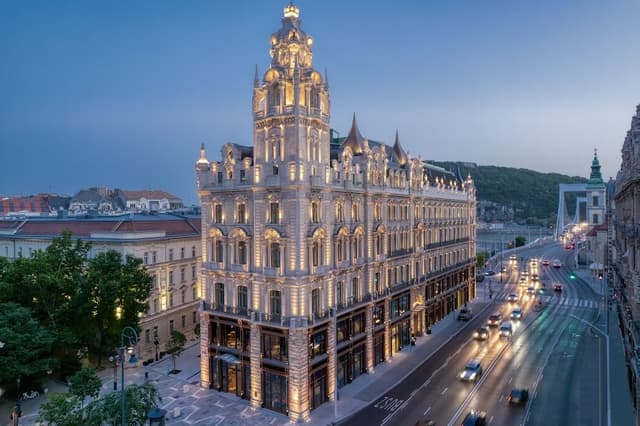
Klotild Palaces
@pedralexpereira
The northern Klotild Palace, a striking example of British neo-Baroque and eclectic architecture, stands proudly in the 5th district at Ferenciek Square. Alongside its southern counterpart, Matild Palace, it creates a symbolic gateway to the Elisabeth Bridge when viewed from Rákóczi Road. Commissioned in the 1880s by Princess Marie Clotilde, wife of Archduke Joseph Karl, the palaces were designed by architects Flóris Korb and Kálmán Giergl.
The intricate details of the northern palace showcase the era's artistic craftsmanship. Its 48-meter towers are crowned with enlarged replicas of the archduke’s crown, and its glass windows were crafted in the renowned workshop of Miksa Róth. This building also introduced notable innovations to Budapest, being the first to feature an elevator and fitted with furnaces from the prestigious Zsolnay Manufacture in Pécs.
Over the years, the northern Klotild Palace has served various purposes. For a long time, it was home to BÁV’s antique shop before transforming into the luxurious Buddha-Bar Hotel, blending its historic charm with modern luxury. Today, it remains a prominent landmark, embodying the city’s architectural and cultural richness.

Details
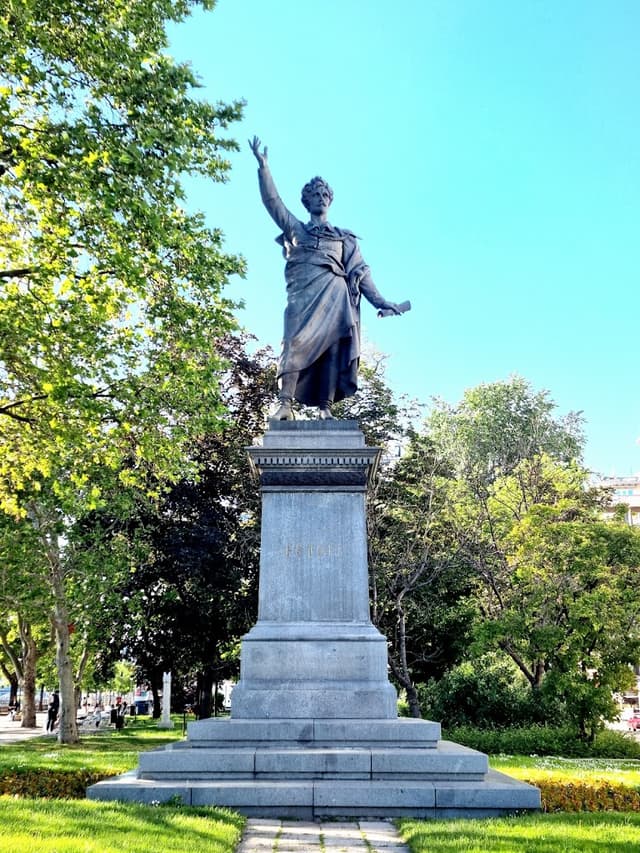
Petőfi Sándor statue
@pedralexpereira
The statue of Sándor Petőfi, located on the Pest side of the Chain Bridge, is a powerful tribute to one of Hungary's most beloved national heroes. Unveiled in 1882, the statue was crafted by sculptors Miklós Izsó and Adolf Huszár and has since become an iconic symbol of Hungarian pride. Petőfi was a central figure in the Hungarian Revolution of 1848, and his passionate poetry inspired the Hungarian people to rise against the Austrian Empire in pursuit of independence. His revolutionary spirit and powerful literary works left an indelible mark on the nation's history.
Petőfi's poetry remains a cornerstone of Hungarian culture, capturing the aspirations of the people for freedom, justice, and social change. His verses resonated deeply with those fighting for national sovereignty, and his legacy continues to inspire Hungarians today. Although he disappeared during the revolution and is believed to have died in battle, his memory endures through his contributions to both Hungarian literature and the nation's quest for independence.
The statue itself stands as a solemn reminder of Petőfi's role in the fight for freedom and the sacrifices made during the revolution. Over time, it has become a symbol of national unity and hope, reflecting the enduring values of liberty and patriotism cherished by the Hungarian people.

Details
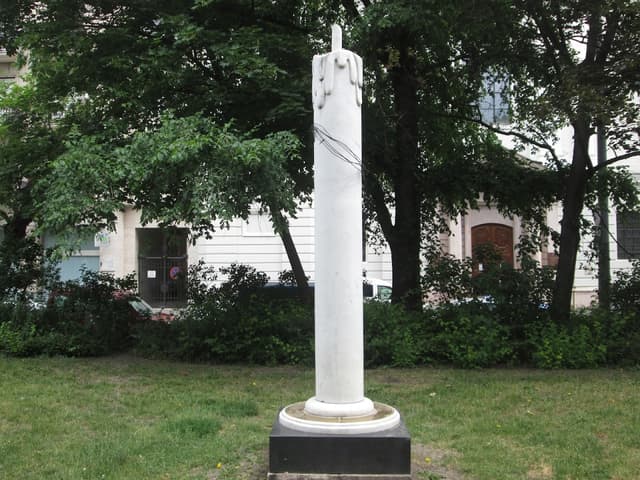
Memorial to the Victims of Holodomor in Ukraine in 1932-33
@pedralexpereira
On October 7, 2018, Hungary participated in the international memorial campaign “Let’s Light a Candle of Memory!” to commemorate the victims of the Holodomor, the 1932-33 man-made famine that devastated Ukraine. The events were organized by the Embassy of Ukraine in Hungary, the Society of Ukrainian Culture of Hungary, and various Ukrainian centers.
The commemorations began at 12:00 in the St. Michael Church in Budapest, where the Ukrainian Greek Catholic community gathers. Before the liturgy, candles were lit by Ambassador Liubov Nepop, the First Deputy Head of the World Congress of Ukrainians, and the Head of the Ukrainian Culture Society of Hungary, Yaroslava Khortiani, along with Father Damian Gaborius, priest of the Ukrainian Greek Catholic Church in Hungary. These candles, lit during each Sunday service, symbolized the memory of those who perished during the Holodomor.
Ambassador Nepop addressed the congregation, highlighting Hungary's role in recognizing the Holodomor as genocide in 2003 and expressing gratitude to the Hungarian people for their support in Ukraine's ongoing struggle against Russian aggression. The liturgy, accompanied by the choir "Novus," concluded with the song "Eternal Memory," honoring the victims.
Following the service, participants marched through Budapest, carrying signs in both Ukrainian and Hungarian, including “Ukraine remembers – the world recognizes” and “Genocide of the Ukrainian people of 1932-33,” to the Holodomor memorial in the city. There, the memorial ceremony continued with a reading of a poem about the Holodomor by Oksana Gabor. Names of 85 children who died due to the famine were read aloud, with each participant placing a spikelet near the monument in memory of the victims.
The ceremony continued with a memorial service, during which the Ukrainian choir “Novus” performed traditional church songs. Ambassador Nepop and Khortiani delivered speeches, expressing their heartfelt remembrances of the victims. A wreath made of wheat spikes, laid by children from the Ukrainian community, was followed by a symbolic lighting of candles and a moment of silence.
The events culminated in the singing of the Ukrainian national anthem, marking the end of a moving commemoration that brought together members of the Hungarian public, the Ukrainian community in Hungary, and Ukrainian embassy staff.

Details
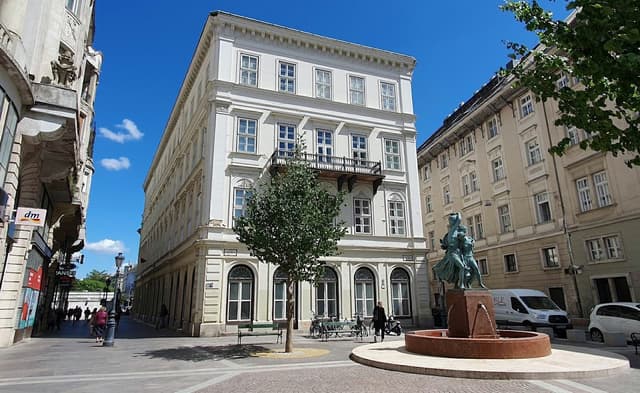
Well of Danaids
@pedralexpereira
The Danaidák Kútja (Danaids Fountain) is a notable statue located in Budapest, situated in Vörösmarty Square. It was created by Hungarian sculptor Károly Senyei in 1931. The fountain is inspired by the mythological story of the Danaides, the 50 daughters of King Danaus from Greek mythology, who were sentenced to fill a bottomless vessel with water as punishment for killing their husbands.
The statue depicts these women, carrying jugs to the fountain’s basin. The motif of eternal labor and futility—based on the myth of the Danaides—symbolizes the idea of perpetual, fruitless effort. In the fountain's design, the water flows through the jugs that the Danaids are depicted holding, though they can never fill the basin, echoing the mythological punishment.
This striking sculpture combines Art Nouveau and classical elements, and it remains one of the notable pieces of public art in Budapest. It has become a distinctive part of the square's landscape, symbolizing the struggle against impossible tasks.

Details

Deák Ferenc Square
@pedralexpereira
Deák Ferenc Square, named after Hungarian statesman Ferenc Deák, is one of Budapest's most important intersections and a central transportation hub. Situated in the heart of the city, it connects major thoroughfares such as Károly körút, Bajcsy-Zsilinszky út, Király utca, Deák Ferenc utca, and Harmincad utca. Beneath the square lies a significant metro station where all three lines of the Budapest Metro converge, making it a pivotal point in the city's public transport network. Additionally, tram lines 47 and 49 originate here, alongside several bus routes, ensuring the square's accessibility.
Deák Ferenc Square is not just a transport junction but also a vibrant social hub. Its grassy areas often serve as gathering spots, especially for young people. The square remains lively well into the night, with vendors selling beverages and a spirited atmosphere prevailing until the midnight hours.
The square's cultural influence extends beyond its practical functions, finding a mention in "Ending Theme," a song by Swedish progressive metal band Pain of Salvation. This blend of utility and culture makes Deák Ferenc Square a dynamic centerpiece of Budapest's urban life.

Details

Eötvös Loránd University
@pedralexpereira
The Eötvös Loránd University (ELTE) main building is an emblematic structure in Budapest, embodying the rich academic tradition of Hungary’s oldest and most prestigious university. Established in 1635 in Nagyszombat (modern-day Trnava, Slovakia), the university moved to Budapest in the late 18th century and has since played a pivotal role in Hungary's intellectual and cultural development.
The main building, located near the banks of the Danube, showcases a blend of historicist and neoclassical architectural styles. Its façade is adorned with columns and decorative motifs that exude a sense of academic gravitas and timeless elegance. The interior features spacious lecture halls and libraries, many of which are adorned with intricate woodwork and period details, reflecting the institution's commitment to scholarship and learning.
Named after the renowned physicist Loránd Eötvös, the university is known for its contributions to science, humanities, and law, attracting students and researchers from around the globe. Its location in the heart of Budapest makes it not only a hub of education but also a cultural landmark, bridging the city's historic past with its vibrant present.

Details
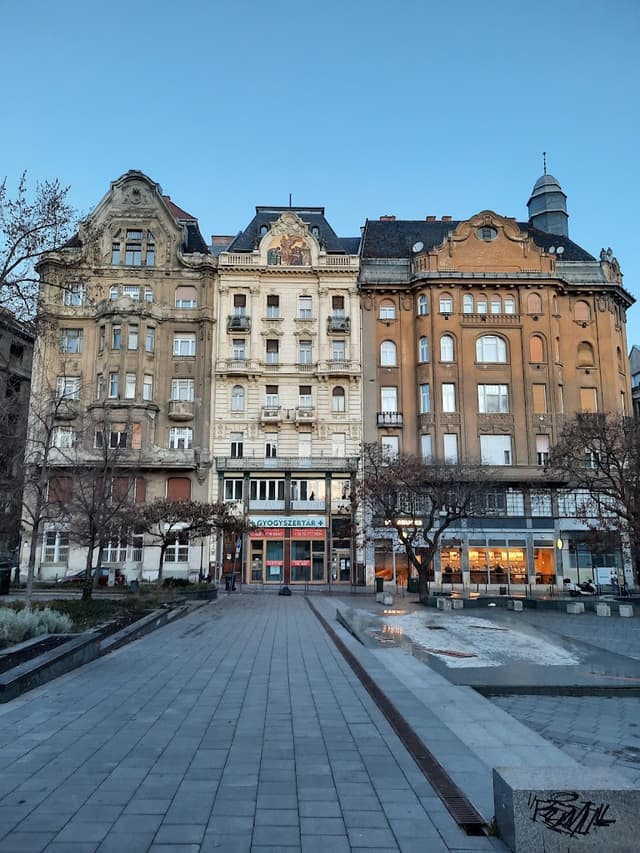
Fővám Square
@pedralexpereira
It serves as the gateway to the city’s bustling market district and is best known for being the location of the Central Market Hall (Nagyvásárcsarnok), one of Budapest's most iconic landmarks. This grand structure, built in the late 19th century, is an excellent example of neo-Gothic architecture with steel and glass elements, reflecting the era's industrial progress and urban development. The market hall itself is a must-visit for its vibrant atmosphere, where locals and tourists alike shop for fresh produce, spices, meats, and traditional Hungarian delicacies.
The square’s name, "Fővám," refers to the historical customs house that once stood here, as it was a key entry point into the city for goods coming from the south. This historical connection is a reminder of Budapest’s strategic position along major trade routes.
Fővám Square is also an important transport interchange, connecting various modes of public transportation, including trams, buses, and the M4 metro line, making it a bustling focal point for locals. The square’s layout and its proximity to the riverbank provide easy access to both the city center and the southern districts.

Details

Liberty Bridge
@pedralexpereira
Liberty Bridge, known locally as Szabadság híd, is one of Budapest’s most striking and historically significant bridges, connecting the Buda and Pest sides of the city over the Danube. Originally completed in 1896 as part of the grand celebrations for the Millennium World Exhibition, it was first named Ferenc József híd after Emperor Franz Joseph, who inaugurated the bridge. The emperor himself placed the last rivet into the Pest abutment, marking the completion of the bridge. In 1956, following the Hungarian Revolution, it was renamed Liberty Bridge to symbolize the desire for freedom.
The bridge, built to a design by János Feketeházy, is renowned for its distinctive Art Nouveau style. The structure is a cantilever truss bridge, a type that was a modern engineering feat at the time. Though the design is different from that of earlier suspension bridges, its outline was deliberately modeled to evoke the appearance of a chain bridge, which was highly regarded for its elegance during that period. The bridge spans 333.6 meters in length and 20.1 meters in width, making it the shortest of Budapest's central bridges.
Decorative elements add to the bridge’s grandeur, including large bronze statues of the Turul, a mythical falcon-like bird, perched atop its four masts. These statues reflect Hungary’s rich history and mythological heritage. The bridge is also adorned with the national coat of arms, further emphasizing its symbolic importance.
At either end of Liberty Bridge are bustling public squares: Gellért tér on the Buda side, known for the iconic Gellért Spa and Hotel, and Fővám tér on the Pest side, which is home to the Great Market Hall. The bridge serves as a crucial transport link, with trams and vehicles crossing regularly. There are even plans to make it a pedestrian-only bridge now that the city’s metro system has been expanded with the completion of the fourth metro line.
Liberty Bridge stands as not only a functional crossing but also a testament to Budapest's architectural heritage, a symbol of its resilience through the years, particularly since it was the first bridge to be rebuilt after suffering damage during World War II. The northeastern corner of the bridge houses a museum dedicated to the history of Budapest’s bridges, adding an educational aspect to this iconic landmark.

Details
Museums, culture and activities

IKONO Budapest
@pedralexpereira
IKONO Budapest is an immersive art and experience space located in the heart of the city, offering visitors a chance to engage with creativity in a hands-on, sensory-rich environment. Known for its unique approach to art and interaction, IKONO merges visual spectacle with tactile experiences, creating an inviting and playful atmosphere for all ages.
The venue features a series of themed rooms, each designed to transport visitors into a different world. From interactive installations and color-filled spaces to imaginative light displays, IKONO encourages exploration and participation rather than passive observation. Visitors are not only allowed but encouraged to touch, play, and pose, making it a favorite spot for photography enthusiasts and families alike.
Catering to both locals and tourists, IKONO Budapest showcases innovative concepts that blend art with modern technology, creating an unforgettable journey that goes beyond traditional museum visits. Whether you're looking to awaken your creativity or simply enjoy a unique outing, IKONO provides a vibrant, Instagram-worthy experience in the heart of Budapest.

Details
Eventuell Gallery
@pedralexpereira
Eventuell Gallery is a charming boutique-style space nestled in the heart of Budapest, offering a unique blend of design, craftsmanship, and contemporary art. This gallery focuses on showcasing the works of Hungarian artisans, with a strong emphasis on handmade products, sustainability, and innovative design. Visitors can explore a curated selection of ceramics, textiles, jewelry, and home decor items, each piece reflecting the creativity and skill of local artists.
The venue exudes a warm and intimate atmosphere, inviting visitors to engage with the stories behind the objects. Prices are reasonable, catering to both casual shoppers looking for distinctive souvenirs and collectors seeking exclusive design pieces. Beyond shopping, Eventuell Gallery often hosts exhibitions and workshops, fostering a deeper connection between creators and the community.

Details

Details

Budapest University Library
@pedralexpereira
The Budapest University Library, also known as the Library of the Eötvös Loránd University (ELTE), is one of the most significant academic libraries in Hungary. Located in the heart of Budapest, it is a key resource for students, researchers, and scholars. The library’s origins trace back to the founding of the university in 1635, making it one of the oldest academic libraries in the country.
The library houses an extensive collection of books, periodicals, and special archives that cover a wide range of academic fields, including the humanities, natural sciences, social sciences, and law. It is particularly renowned for its historical collections, including rare manuscripts, early printed books, and documents related to Hungarian history and literature.
The building itself is a blend of modern and traditional architecture, with spacious reading rooms and a serene atmosphere that fosters study and research. As part of Hungary’s leading educational institution, the Budapest University Library plays a vital role in supporting the academic community and preserving Hungary’s intellectual heritage.
The library also offers various services, including access to digital resources, interlibrary loans, and specialized collections, making it an essential hub for higher education and research in Hungary.

Details

Cats Museum Kft - FREE ENTRY
@pedralexpereira
The Cats Museum (Kiscica Múzeum) in Budapest is a unique and free cultural institution dedicated to promoting love and respect for animals, particularly cats, while exploring their historical and cultural significance across various civilizations. Located in the historic center of Budapest, near Deák Ferenc tér and the Great Synagogue, and just a short walk from the Hotel Astoria, the museum offers an intriguing and diverse collection of cat-related artifacts.
The museum’s exhibition spans two floors, showcasing works from different time periods that highlight the relationship between humans and cats. The collection includes antique books, coins, medals, paintings, engravings, manuscripts, vintage advertisements, postcards, musical scores, and even board games. Many items come from the Badoer collection in Venice, which is dedicated to the adoption of cats, along with private donations and targeted acquisitions.
Among the notable items on display are:
- *"Girl Feeding a Cat"*, a painting by Francesco Piattoli (1703–1773).
- A series of six engravings by Daniel Meisner (1585–1625), depicting cities like Bergen, Ostend, and Iula (Alba Julia, Transylvania).
- *"The Death of the Cat Mur"*, a lithograph by King Fernando II of Portugal (1816–1885).
- A poem printed in 1777 about the cat of Count Josef Wilzeck, ambassador of Maria Theresa in Naples.
- Engravings by Gottfried Mind (1768–1814), known as the "Raffaello of the Cats."
Popular sections in the museum include themes like black cats, witches, cats during World War I, philately, greeting cards, and the first international feline exhibitions. Visitors can also explore a small showroom at the end of the exhibition, where a variety of exclusive souvenirs are available, such as tea towels, books, notebooks, and over 200 types of cat-themed magnets.
Despite being the newest museum in Budapest, it has already gained recognition among tourists and is often included in thematic tours for families and small groups. It is important to note that the museum is not a cat cafe or therapy center, but rather a dedicated space for cat history and culture.
The museum’s commitment to animal welfare is reflected in its free admission, which makes it accessible to all visitors. It is open year-round, typically in the afternoons, and provides a delightful and educational experience for those interested in the cultural role of cats.

Details
Religious temples
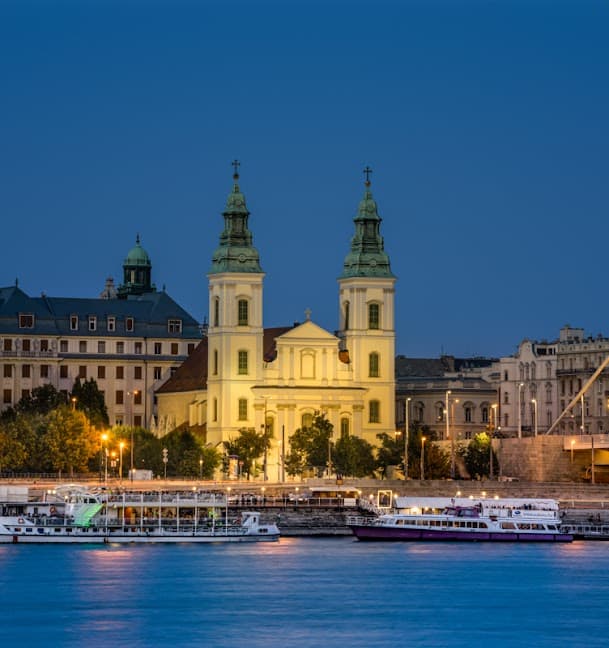
Mother Church of Our Lady of the Assumption
@pedralexpereira
The church traces its origins to the Romanesque period, with its earliest features dating back to this era. In 1046, it became the final resting place of St. Gellért, the Bishop of Csanád. Over the centuries, the church underwent numerous transformations, reflecting the evolving architectural styles and historical events shaping Budapest's rich heritage.
In the 14th century, King Sigismund of Hungary began its reconstruction in the Gothic style, a period during which King Matthias expanded the structure with two lateral aisles. During the Turkish occupation, the church was converted into a mosque, and a mihrab from that time remains embedded in the southeastern wall of the sanctuary as a reminder of this chapter in its history.
Following a fire in 1723, the church was restored in Baroque style under the supervision of János György Pauer. Over the years, it became a resting place for notable figures, such as István Kultsár, a prominent Enlightenment-era theater promoter entombed in its vault in 1828. Subsequent renovations sought to preserve its historical essence while uncovering long-hidden elements, including Gothic windows and twin buttresses revealed in the 20th century.
Renovations spanned centuries, from János Hild's work in the early 19th century to efforts by Imre Steindl in 1889 and László Gerő post-1945. The interior murals were carefully restored in the 1970s, and significant discoveries, such as a 14th-century Anjou-era throne of the Virgin Mary, were made during later restorations. The facade was finally rejuvenated in 2011, complementing the refurbishment of the park in front of the church.
Between 2014 and 2016, archaeological excavations unveiled previously unknown structures, enriching the church's historical narrative. Despite facing threats of demolition during the Communist era when the Elisabeth Bridge was being rebuilt, the church was preserved through strategic negotiations, showcasing the determination to protect this architectural and cultural treasure.

Details

Orthodox Cathedral of Our Lady
@pedralexpereira
The Orthodox Cathedral of Our Lady, situated along the Danube River near the Elizabeth Bridge in Pest, is an architectural gem with a rich history. The church was originally built in 1801 to serve the growing Greek-speaking population in Budapest, primarily Greek and Macedonian merchants who had settled in the city during the 18th century. The decision to construct the church was made in 1785, reflecting the increasing prominence of the Greek community in Hungary at the time.
Designed by architect József Jung, the church initially featured a simple neoclassical style, but it was later enhanced in 1873 under the direction of Miklós Ybl, one of Hungary’s most famous architects. Ybl’s contributions included the addition of twin towers and the finalization of the church’s striking façade, which became a defining feature of the city’s skyline along the Danube.
The Orthodox Cathedral is a notable example of neoclassical architecture, characterized by its grand proportions and elegant design. Its twin towers rise above the cityscape, serving as a prominent landmark visible from across the river. The church's design, while rooted in classical traditions, also features elements that reflect the Orthodox faith, contributing to its unique architectural identity in Budapest.
During World War II, the church suffered significant damage, particularly to its southern tower. Despite this, the cathedral remained a cherished place of worship and cultural heritage. The tower was eventually rebuilt and restored to its former glory in 2010, ensuring the church’s continued prominence in the city.

Details
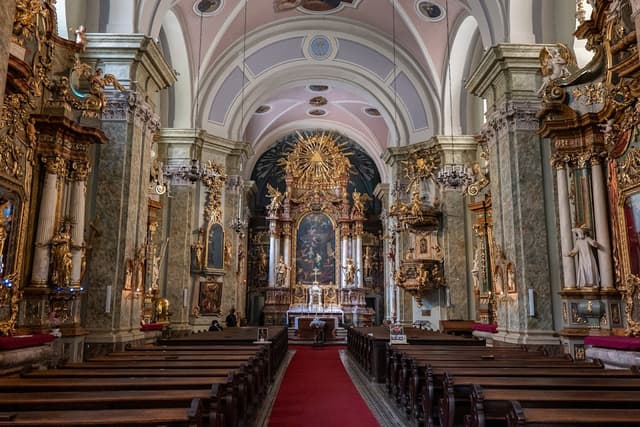
St. Anne Church, Downtown Budapest
@pedralexpereira
Batthyány Square's Church of St. Anne, described by writer Antal Szerb as a hidden gem destined for universal admiration, is one of Budapest's finest Baroque landmarks. This twin-towered masterpiece, standing proudly opposite the Hungarian Parliament, enriches the Buda skyline with its elegance and historical significance. Constructed in 1761 based on designs by Kristóf Hamon and Máté Nepauer, the church is a testament to the artistic and architectural splendor of its era.
The facade of the church is a harmonious blend of symbolism and craftsmanship. Above the main entrance, allegorical carvings of Faith, Hope, and Charity lend depth to its design, while the second storey features sculptures of St. Anne and Mary. Crowning the composition, the tympanum displays the coat of arms of Budapest, flanked by praying angels and the Eye of Providence, a potent symbol of divine watchfulness.
Inside, the church offers a spiritual and visual feast. The nave’s oval cupola, adorned with a Baroque-inspired fresco painted in 1938 by Béla Kontuly and Pál C. Molnár, bathes the interior in artistic glory. Among its treasures, the Loretto Chapel stands out as a serene and sacred space, adding layers of devotion and history to the site.
During the communist era, the church narrowly escaped demolition, allegedly to make way for metro construction. Thankfully, the plans were abandoned, preserving this architectural jewel for future generations.
As visitors ascend Castle Hill through the Víziváros district, the church's towers appear intermittently, framing enchanting views from every vantage point. The Church of St. Anne is more than a Baroque treasure; it is a symbol of resilience and a cherished feature of Budapest’s cultural and spiritual landscape.

Details
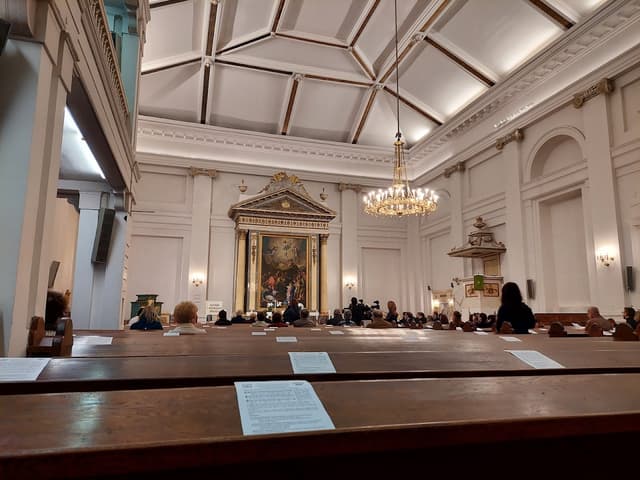
Lutheran church, Deák tér
@pedralexpereira
The Deák Square Lutheran Church, located in the heart of Budapest on Deák Ferenc Square (District V), is the oldest and most prominent Lutheran church in the city. Built in classicist style, this hall church is notable for lacking a tower, distinguishing it from many other churches. It is the largest Protestant church in Budapest and serves as the center of the city's evangelical community. Along with the church, several other evangelical institutions occupy the surrounding block, including an evangelical high school, pastor's office, pastor's apartments, bookstore, museum, and kindergarten, collectively referred to as *Insula Lutherana* or "Evangelical Island."
The church's façade is adorned with four Doric columns and a plain triangular pediment, resting on a main cornice decorated with triglyphs and metopes. The building is topped with a large, convex tin roof. Inside, the church features a rectangular hall with a double gallery. The altar, crafted by Mihály Pollack, depicts Raffaello's *Transfiguration* (Transfiguration of Christ on the Mount of Tábor), painted by Ferenc Lochbichler. The pulpit and baptismal font, made of red marble, were created by Lőrinc Dunaiszky.
Construction of the church began in 1799 and was completed in 1808, based on plans by Mihály Pollack. It was briefly used as a military clothing warehouse from July 1809 to 1811 before being consecrated in 1811. The church's double gallery was added in 1820, and in 1856, József Hild designed the church's current main façade, featuring Doric pillars and a tympanum. Over the years, the church has undergone several changes, including the removal of its classicist tower in 1875 due to structural concerns and the replacement of its vaulted ceiling with a coffered design. It was damaged during both the Second World War and the construction of the M2 metro line. In the early 2000s, the church received a small, computer-controlled set of bells that chime several times daily. The most recent external renovation occurred in 2003.
The church has historical significance beyond its architecture. During the Pest flood of March 1838, it served as a refuge for many. Lajos Kossuth, a key figure in Hungarian history, baptized his sons Ferenc and Lajos Tivadar here, a fact commemorated by a plaque on the façade. The church also honors the legacies of key figures in Protestant history, with two bronze reliefs commemorating the 500th and 300th anniversaries of Martin Luther's and Johann Sebastian Bach's births, respectively.
The church has been the site of numerous important events in the Hungarian Evangelical Church. It hosts regular services every Sunday and holiday and has been home to the Deák Square Organ Musical Devotion series since 1985 and the Budapest Bach Week every June since 1990. Many bishops and church district supervisors of the Bánya and Southern Lutheran Church Districts have been installed here. The church's carillon plays the Evangelical main hymn of the week every full hour, adding to the church's unique atmosphere. The church is also accessible to people with disabilities from the courtyard.

Details
Inner-City Church of the Franciscans
@pedralexpereira
The Inner City Franciscan Church, located in Budapest's bustling Ferenciek Square near Váci Street, is a Baroque treasure steeped in history. Originally constructed around 1240, the church has weathered centuries of transformation. It was burned during the 1526 Turkish invasion and later repurposed as a mosque under Ottoman rule. The Franciscans reclaimed the site in 1696, and the church as we see it today was rebuilt between 1727 and 1743.
The church's Baroque interior is a feast for the eyes, with its 1741 main altar serving as the centerpiece. Adorned with intricate sculptures, the altar is one of the most treasured elements of the space. Enhancing its grandeur are frescoes painted by Károly Lotz in 1895 and additional works by Viktor Tardos added in 1926, each contributing layers of artistic richness to the church. The tower, a later addition completed in 1861, stands as a striking feature of the structure.

Details
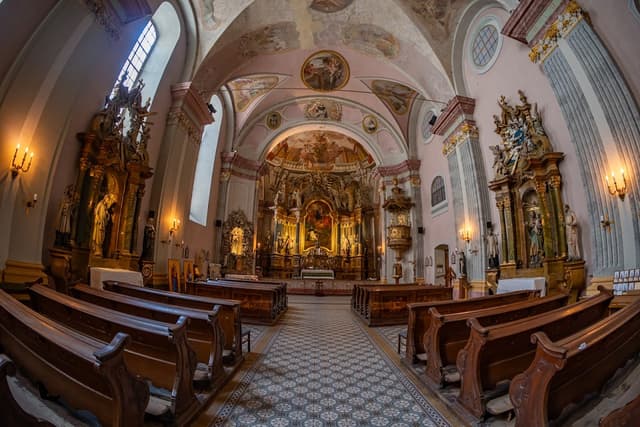
St. Michael's Church
@pedralexpereira
The Dominicans established a monastery and church in Pest around 1230, but following the devastation of the Tatar invasion, the church was relocated to a new site. This historical landmark played a pivotal role in 1308 when the parliament convened on its grounds to elect Róbert Károly as king. However, the church suffered destruction under Turkish rule after 1541. Following the expulsion of the Turks, the current Baroque-style church was constructed between 1700 and 1765.
Over the centuries, the building has undergone numerous changes in both use and structure. When the Dominican order was dissolved by King József II of Hungary, the Paulites temporarily took over the church in 1785. By 1787, it was handed over to the teaching order of the English Ladies. During this period, the church also became the custodian of the relic of St. Job, returned to Hungary from Salzburg in 1945, until the English Ladies' order was dissolved in 1950.
The church has faced significant natural and structural challenges. Floods in 1799, 1809, and the catastrophic deluge of 1838 left their mark, with water reaching two meters high inside. Fires also caused substantial damage, destroying the roof and twin towers in 1809. Despite these setbacks, restoration efforts persisted. The interior was renovated in 1892, the exterior in the 1960s, and a clock mechanism was added during this time. Comprehensive external renovations were completed in the late 1990s, followed by gradual restoration of the sanctuary and sacristy between 1998 and 2008. Ceiling murals by József Aman have been undergoing meticulous restoration since 2012.

Details

Saint George Serbian Orthodox Church
@pedralexpereira
The Church of St. George stands as a testament to the Serbian community's enduring presence in Budapest, tracing its roots back to the 16th and 17th centuries when Serbs settled in the area during Ottoman rule. Historical accounts suggest that a Serbian place of worship existed here even before the 1526 Battle of Mohács, with records from 1655 noting a church and a cemetery near the Kecskemét Gate. Ottoman traveler Evliya Çelebi also documented the presence of a Serbian church in Pest during his travels in the mid-17th century. However, the original church was destroyed during the Habsburg conquest in 1686.
After the 1690 Great Migrations of the Serbs, the growing community received permission to build a new church, which was completed in 1698 under the guidance of Patriarch Arsenije III Čarnojević. By the early 18th century, the expanding Serbian population necessitated a more substantial structure. In 1733, a new Baroque-style church was constructed, designed by Salzburg-born architect András Mayerhoffer. The church’s elegant bell tower, added in 1752, and its original iconostasis, crafted by Stefan Tenecki, highlighted its artistic significance.
In 1838, the church suffered damage during a devastating flood in Pest, leading to the replacement of its iconostasis in 1850 with a Neo-Renaissance design by a Greek artist. The churchyard, surrounded by a stone wall, features tombstones of Serbian believers, further underscoring its historical importance. A ceramic depiction of St. George slaying the dragon adorns the corner of Szerb Street and Veres Pálné Street, serving as a visual reminder of the church's dedication.
For centuries, the Church of St. George was one of two principal Serbian churches in Budapest, alongside the Church of Saint Demetrius. However, after the latter's destruction in 1949 following World War II, St. George’s became the sole remaining Serbian place of worship in the city. Archaeological research in 1959 confirmed the site’s deep historical layers, revealing evidence of earlier structures beneath the current building. Today, the church remains a vital link to Budapest's multicultural heritage, preserving the history and identity of the Serbian community in the city.

Details
University Church
@pedralexpereira
The Church of the Assumption, often referred to as the University Church, holds a significant place in Budapest’s religious and academic history. Originally founded by the Pauline monks in 1723, the church was constructed on the site of a former mosque, symbolizing the city’s transition from Ottoman to Habsburg rule. Following the dissolution of the Pauline Order in 1786, ownership of the church passed to the University of Pest, further embedding it within the academic fabric of the city. Today, it is also associated with Pázmány Péter Catholic University.
The church’s two striking towers, each standing 56 meters tall, dominate its exterior, reflecting the grandeur of its Baroque design. These towers contribute to the church’s commanding presence in the urban landscape. The interior, rich with artistic and architectural details, offers a serene yet opulent atmosphere, characteristic of the period in which it was built.

Details
Green and open spaces
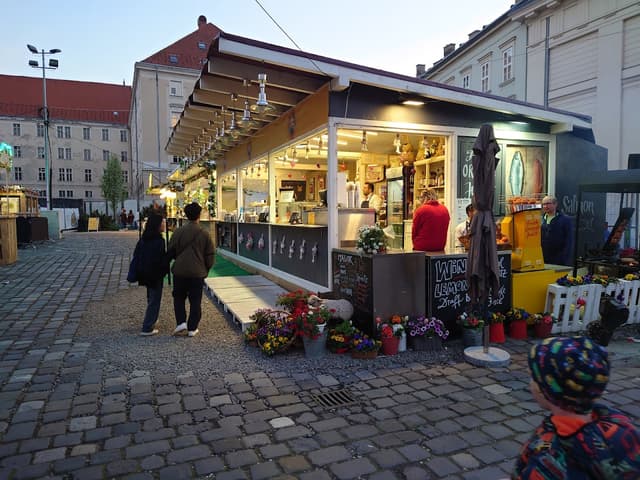
Városháza park
@pedralexpereira
For years, Budapest residents have eagerly awaited the transformation of the area behind the tram and bus stops at Deák Ferenc tér. This space, which was previously occupied by City Hall vehicles, has now been repurposed into a vibrant public park. The City Hall's courtyard officially opened its doors as a pop-up park on May 17th, offering a much-needed respite from the city's hustle and bustle. Gone are the rows of vehicles, replaced by a 7,000-square-metre park—almost double the original size! This temporary green haven features exciting landscaping, unique street furniture, and a variety of plants.
The exciting part is that the final design for the permanent park is already in the works, promising even more green space in the heart of Budapest. On November 17th, the City Hall courtyard first opened for the city's 150th birthday celebrations, with concerts and exhibitions marking the occasion. Six months later, it reopened as a pop-up park. This temporary space will remain open until autumn, offering residents and visitors a peaceful escape, along with catering facilities, seasonal programmes, workshops, concerts, and community events.
Summer activities are in full swing at the Városháza pop-up park, organized by the Municipality of Budapest and Budapest Brand nZrt. The park kicked off on May 17th with a spectacular opening performance featuring a DJ set and a stand-up comedy show. On May 18th, visitors were treated to a full day of activities, including a special memorial evening for the beloved Hungarian DJ, DJ Palotai. The park also boasts a restaurant open all day, offering the perfect place to relax and enjoy the atmosphere.
Throughout the summer and into autumn, the park will host themed evenings and special events, catering to all interests. Whether you’re into sports or just looking for something fun, there’s something for everyone. International sporting events will be shown on projectors, and visitors can cheer alongside Hungarians.
The park is family- and pet-friendly, welcoming all visitors to discover their new favourite summer hangout.
While the Városháza Pop-Up Park is initially a temporary space, the groundwork is being laid for a complete transformation within the next few years. The winning design for the park’s permanent renewal comes from Lépték-Terv Landscape Architecture. The innovative plan breaks away from traditional square layouts, featuring a flexible, concentric design that accommodates various activities, from communal yoga and open-air cinema to large-scale concerts and fairs.
The three-pronged vision for the revitalized Városháza Park includes:
1. Creating an expanded green space: With 8,000 square meters of new greenery, the park will be Budapest’s central green oasis. The eco-friendly design will also incorporate a rainwater recycling system, promoting sustainability in the heart of the city.
2. Embracing an ‘Open City Hall’ concept: The park will provide a platform for various events, such as commemorations, social gatherings, and political events. The ground floor of City Hall will be accessible to the public, fostering cultural and community activities, along with customer service functions.
3. Becoming a cultural hub: Regular events and activities will make the park a meeting place for Budapest residents, complementing the existing Budapest Gallery and Merlin building. The dynamic cultural zone promises to be a vibrant focal point of the city.

Details
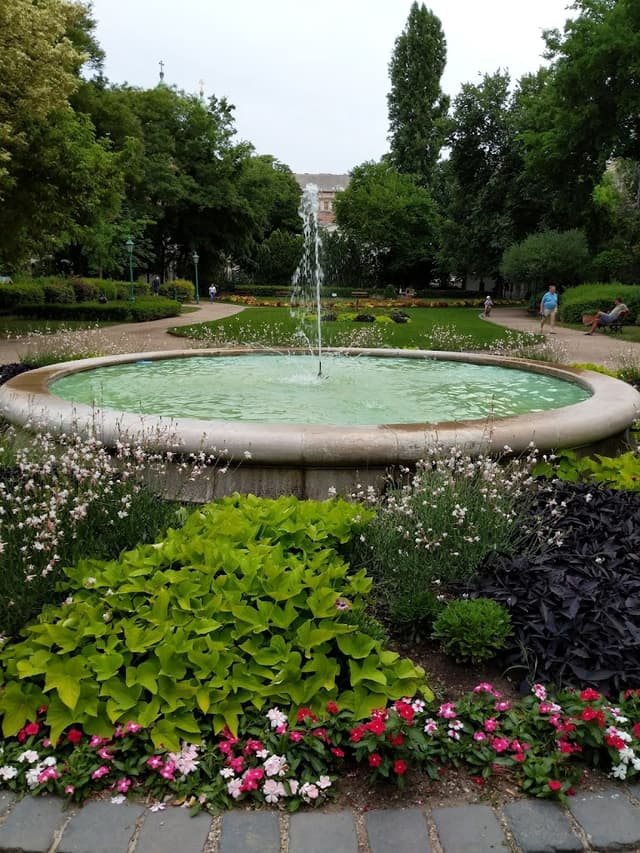
Károlyi Garden
@pedralexpereira
Károlyi-kert is the oldest garden in Budapest and a tranquil haven in the city center. Originally designed in the French style for the affluent Károlyi family, the park has since been transformed into a public space while still maintaining its historical charm. It is known for its beautifully landscaped grounds, romantic walkways, and peaceful atmosphere, making it a perfect spot to unwind.
The garden features a variety of plants and flowers that change with the seasons, adding to its allure. Visitors can stroll along meandering paths, enjoy the shade of mature trees, or relax by the fountain. The park also includes a children's playground, making it a family-friendly location, and various pieces of statuary that add to the park's character, including a statue of Károly, a beloved Belgian giant rabbit who once resided here.
Despite its central location, Károlyi-kert offers a sense of escape from the bustle of the city, ideal for a quiet break or an evening walk. The park is close to Csendes and Csendes Társ, two cafes where visitors can enjoy a drink while sitting at tables near the park's ornate entrance gates. The combination of natural beauty, historical significance, and nearby cafés makes Károlyi-kert a lovely retreat in Budapest.

Details
Coffeeshops

Details
Lipótváros
Lipótváros is one of Budapest’s most prestigious and cosmopolitan neighborhoods, situated along the Danube River on the Pest side of the city. Known for its elegant architecture, vibrant cultural scene, and proximity to key governmental and financial institutions, Lipótváros embodies the city’s modernity while also being deeply rooted in its historical legacy. The area takes its name from Leopold I, Holy Roman Emperor, who reigned during the 17th century, and has long been home to the Hungarian elite.
Lipótváros is renowned for its stunning Art Nouveau and Neo-Renaissance buildings, particularly along streets like Károly körút and Váci utca. These are complemented by grand boulevards lined with luxury shops, hotels, and restaurants, creating a mix of historical charm and modern sophistication. The neighborhood is also home to several important landmarks, including Parliament Building, one of the most iconic and largest legislative buildings in Europe. The Shoes on the Danube Bank, a poignant memorial to victims of the Holocaust, is located along the riverfront here. Lipótváros is also home to cultural and artistic venues such as the Museum of Ethnography and the Opera House, as well as the lush Kossuth Lajos Square, which is often the site of political gatherings and cultural events. Over time, Lipótváros has transformed into a hub for business and governance, yet it remains a center of high culture, sophisticated dining, and elegant living, making it one of the most desirable and historic districts in Budapest.
Architecture and urban spaces
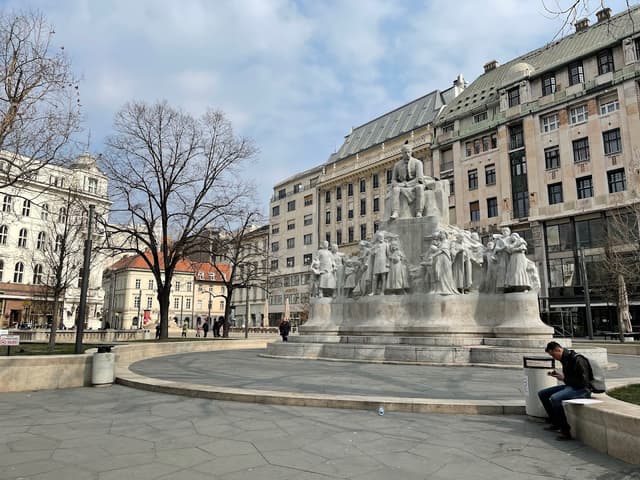
Vörösmarty tér
@pedralexpereira
Vörösmarty tér, located at the northern end of Váci utca in Budapest’s city center, is a lively public square steeped in history and culture. Dominating the square is a statue of Mihály Vörösmarty, one of Hungary’s most celebrated poets, crafted by Eduard Telcs and Ede Kallós. Behind the statue lies a tranquil park, complete with a fountain flanked by stone lions, offering a peaceful retreat amidst the city bustle.
The square is a hub of activity, home to the iconic Café Gerbeaud, known for its elegant interiors and exquisite confectioneries, and the southern terminus of the historic M1 metro line. It also serves as a business center, housing offices of Ibusz and Aeroflot, as well as the British Embassy.
Vörösmarty tér has undergone numerous name changes over its history, reflecting the evolving identity of Budapest. Originally called Theatro piatcza in 1812 due to a theater in the area, it has also been known as Harmincad tér, Séta tér, Gizella tér, and Károlyi Mihály tér, among others. A column in the square commemorates this diverse history, listing all its previous names.

Details
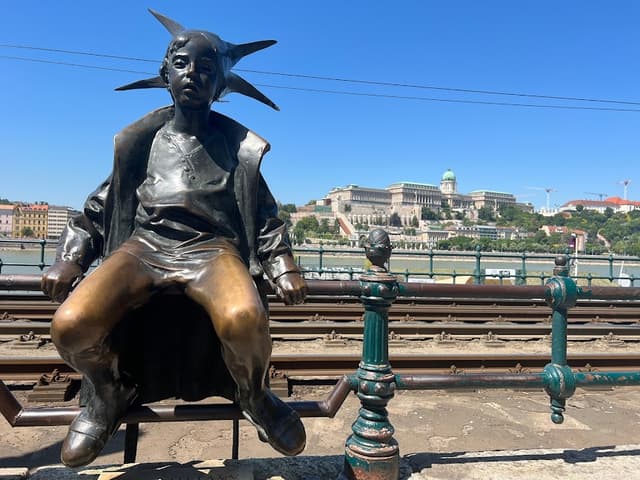
Little Princess Statue
@pedralexpereira
The Little Princess (Kiskirálylány) Statue, perched on the railings of the Danube Promenade in Budapest, is one of the city's most beloved symbols. Sculpted by László Marton, a renowned Hungarian artist and recipient of the Munkácsy and Kossuth Prizes, the original 50 cm statuette was created in 1972, inspired by a personal and tender moment.
Marton drew inspiration from his eldest daughter, Évike, who as a child loved to play dress-up as a princess. She would don a crown crafted from newspaper by her father and use bathrobes as a royal mantle while playing in the garden or at the Tabán playground. Captivated by her imaginative spirit, Marton translated this playful, regal image into the Little Princess, capturing the essence of childhood creativity and innocence.
The larger version of the statue was installed on the Danube Promenade in 1990, becoming an iconic fixture of the cityscape. Another version stands in Marton's hometown of Tapolca, and a replica was gifted to Japan, where it graces the plaza outside Tokyo Metropolitan Art Space. The original statuette remains part of the Hungarian National Gallery's collection.

Details
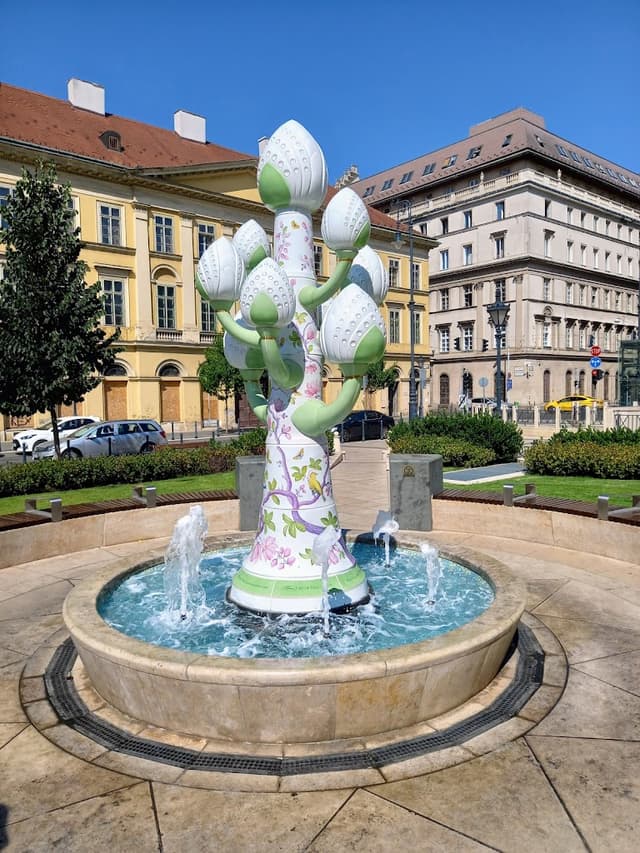
József Nádor Square
@pedralexpereira
József Nádor Tér, a square in the heart of Budapest, has undergone a striking transformation since its controversial renovation in 2016. What was once a leafy, shaded space is now a more structured, urban design featuring modern landscaping and underground infrastructure. The overhaul involved the removal of 24 mature trees to make way for a 500-space underground car park, a move that drew criticism from locals lamenting the loss of the square's original charm. In its place, 54 young trees—maples, alders, lindens, and oaks—now define the space, offering the promise of greenery for future generations, albeit not the immediate shade of their predecessors.
The redesigned 1,500-square-meter park, while sparse in the early hours of the day or during colder months, exudes a sense of spaciousness that highlights the architectural grandeur of the surrounding buildings, including the imposing Ministry of Finance. However, the true focal points are the two fountains, each a testament to Hungary's renowned porcelain craftsmanship.
One fountain, crafted by Zsolnay, showcases the artistry of the Pécs-based porcelain manufacturer, famed for its vibrant ceramic roof tiles adorning landmarks like Budapest's Museum of Applied Arts. The second, a Herend porcelain creation known as the "Tree of Life," reflects the intricate elegance of the Herend brand, whose flagship Palais Herend store—the largest in the world—overlooks the square. While some critics dismiss this fountain as overly commercial, it remains a conversation starter for visitors drawn to its unique style.
Presiding over the square is a statue of József Nádor, the Archduke of Austria and palatine of Hungary, installed in 1859. As one of Budapest's oldest statues, it commemorates a figure who played a pivotal role in Hungary's modernization. Nádor championed economic reforms, infrastructure projects like the regulation of the Danube, and the founding of the Hungarian Academy of Sciences. His contributions helped integrate Hungary more closely with Europe during his tenure.
Despite the square's modern appeal, the juxtaposition of street-level parking against its newly revitalized park space remains a point of contention, with many advocating for a more pedestrian-friendly environment. For those exploring Budapest, an early morning stroll through the city's squares—including József Nádor Tér—offers a rare chance to appreciate the quiet beauty of these spaces before they buzz with urban activity.

Details
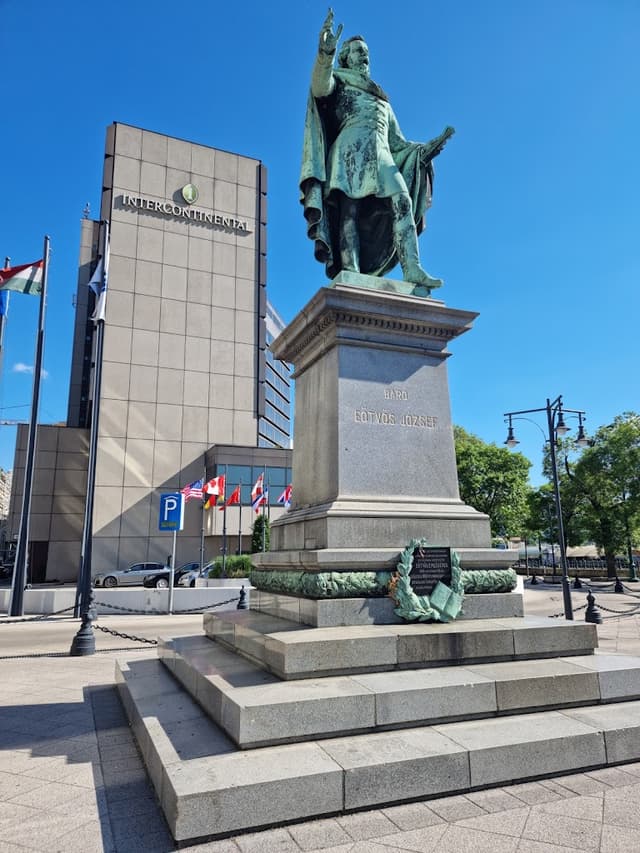
Baron József Eötvös Statue
@pedralexpereira
The Baron József Eötvös Statue in Budapest stands as a tribute to one of Hungary's most influential 19th-century statesmen, writers, and social reformers. Located in Eötvös Square, near the Danube River, this striking monument honors a man who was instrumental in shaping modern Hungary through his advocacy for education, equality, and progressive legislation.
Erected in 1879, just five years after Eötvös's death, the statue was crafted by Hungarian sculptor Miklós Izsó and later completed by Adolf Huszár. It portrays Eötvös in a contemplative pose, holding a book, symbolizing his profound dedication to knowledge and literature. Surrounding him are allegorical figures representing his ideals, including Education and Justice, underscoring his efforts to advance both causes during his lifetime.
Eötvös is remembered for his work as Minister of Religious Affairs and Public Education, during which he championed religious tolerance and laid the groundwork for Hungary's modern educational system. His contributions to literature, particularly his novels addressing social inequalities, remain celebrated as cornerstones of Hungarian literary heritage.

Details

Széchenyi Chain Bridge
@pedralexpereira
Designed by English engineer William Tierney Clark and constructed under the supervision of Scottish engineer Adam Clark, this architectural marvel was completed in 1849 as Hungary's first permanent bridge over the Danube. Its construction symbolized progress and unity during a period of transformative modernization in the country.
The bridge's design is a larger-scale version of Tierney Clark's Marlow Bridge in England. Its cast-iron components were manufactured in the United Kingdom and assembled in Hungary, showcasing cutting-edge engineering for its time. At its debut, the 202-meter central span ranked among the longest in the world, earning it widespread acclaim as a feat of innovation.
Count István Széchenyi, a fervent advocate for Hungary’s modernization, spearheaded the initiative for the bridge's construction, and its naming honors his dedication. Financial backing came from various sources, including Georgios Sinas, a Greek merchant whose contributions are commemorated on the bridge’s foundations.
The bridge is adorned with striking stone lions sculpted by János Marschalkó, which have drawn comparisons to the famous Trafalgar Square lions in London. Contrary to a popular urban legend, these lions do have tongues, though they are not readily visible.
The Chain Bridge has seen numerous historic events, including damage during World War II when it was destroyed by retreating German forces in 1945. It was subsequently reconstructed and reopened in 1949, exactly a century after its original completion. Extensive renovations in the 20th and 21st centuries have preserved its structural integrity, most recently between 2021 and 2023.
Cultural references abound, as the bridge has served as a backdrop for films, music videos, and literature. It appears in movies like Music Box, Spy, and Walking with the Enemy, and even in Katy Perry's Firework video. Its dramatic silhouette continues to inspire artists and filmmakers.
At night, the Széchenyi Chain Bridge is beautifully illuminated, creating a breathtaking scene as its lights reflect off the Danube. A walk across this historical structure offers unparalleled views of Buda Castle, the Hungarian Parliament, and the bustling riverbanks, making it a must-visit for anyone exploring Budapest.

Details
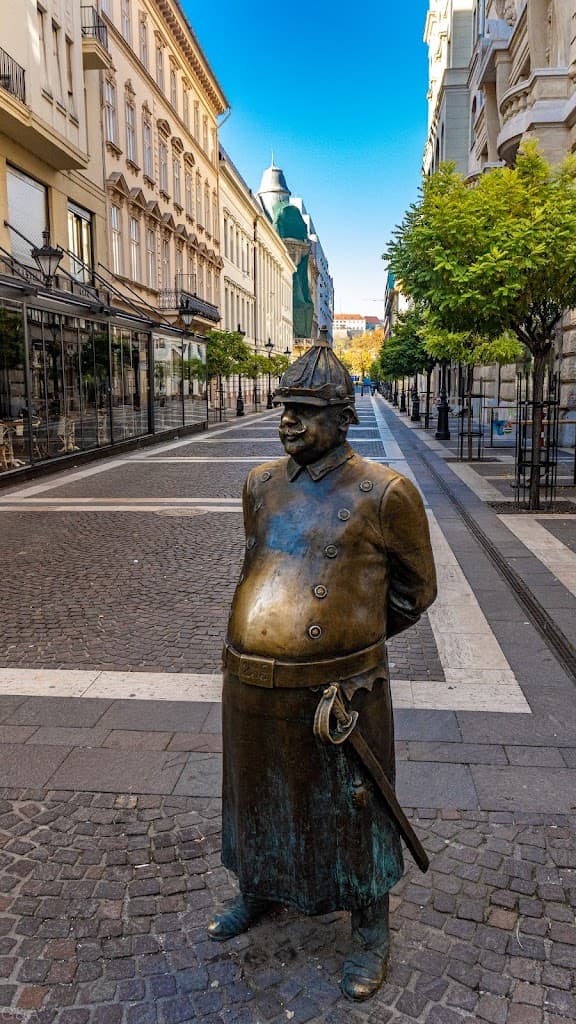
The Policeman
@pedralexpereira
The "Fat Policeman" statue, also affectionately known as Uncle Karl, is one of Budapest’s beloved and quirky landmarks. Created by Finnish sculptor Kaarlo Mikkonen in 1987, the statue sits proudly in St. Stephen's Square, near the magnificent St. Stephen’s Basilica. Uncle Karl is depicted in a mid-20th-century Hungarian police uniform, complete with a helmet and mustache, exuding a warm, approachable aura that has made him a favorite among locals and tourists alike.
The statue’s charm lies in its distinctive feature—its prominent belly, which has taken on a golden patina from years of frequent rubbing. It is said that rubbing Uncle Karl’s belly brings good luck and even helps with weight loss, leading many visitors to stop by and give it a rub, especially after indulging in Budapest's hearty cuisine.
Over the years, the statue has become more than just a piece of art; it is a symbol of Budapest’s playful and endearing side, blending with the city’s rich history and vibrant culture. Whether as a good luck charm or simply a photo opportunity, Uncle Karl remains an iconic and cherished figure in the heart of the city.

Details
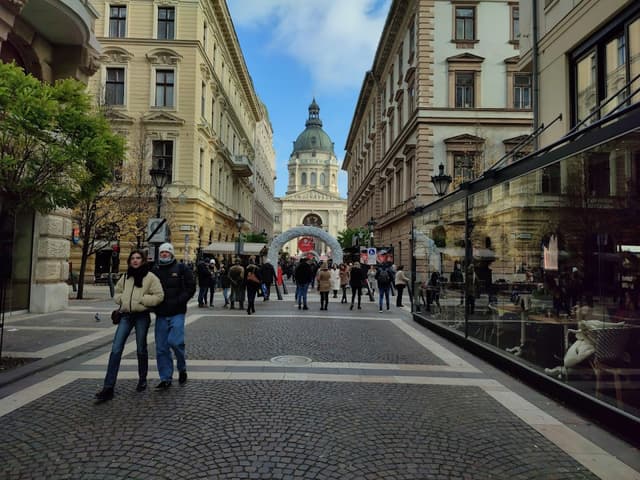
Zrínyi Street
@pedralexpereira
It runs between the Danube River and the vibrant Deák Ferenc Square, making it a well-traversed area with easy access to both the Buda and Pest sides of the city. The street is named after the renowned Hungarian noble family, the Zrínyis, who were influential in Hungary’s history, particularly in the 16th and 17th centuries.
Zrínyi Street is a relatively narrow, pedestrian-friendly road that boasts beautiful architecture, including neoclassical and Art Nouveau buildings. It is home to a range of cultural and historical sites, making it a popular stop for both locals and tourists. The street is perhaps best known for the stunning Szent István Basilica (St. Stephen's Basilica), which is just a short walk away, as well as the Széchenyi Chain Bridge, offering scenic views of the Danube.
The street is lined with a variety of shops, cafes, and restaurants, contributing to its lively character. It is also a great place to enjoy Budapest’s cafe culture or to take a stroll while soaking in the historical and architectural surroundings.

Details

Saint Stephen Square
@pedralexpereira
Szent István tér, located in the heart of Budapest, is a charming town square and a vibrant gathering place for locals and tourists alike. The square is best known as the home of St. Stephen’s Basilica, one of Hungary’s most iconic landmarks, whose impressive dome dominates the skyline. Surrounded by grand buildings that showcase Budapest’s architectural splendor, Szent István tér offers visitors a glimpse into the city's rich history and cultural heritage.
The square’s lively atmosphere is enhanced by an array of bustling cafes, restaurants, and shops, making it an ideal spot to relax, enjoy local cuisine, or simply observe the rhythm of city life. Its spacious layout, pedestrian-friendly streets, and seasonal events contribute to its appeal as a hub of activity throughout the year.
Szent István tér also serves as a convenient starting point for exploring nearby attractions. Whether marveling at the intricate details of the Basilica, wandering down neighboring streets lined with historical buildings, or enjoying the ambiance of open-air concerts and festivals held in the square, visitors are immersed in the unique blend of old-world charm and modern vitality that defines Budapest.

Details
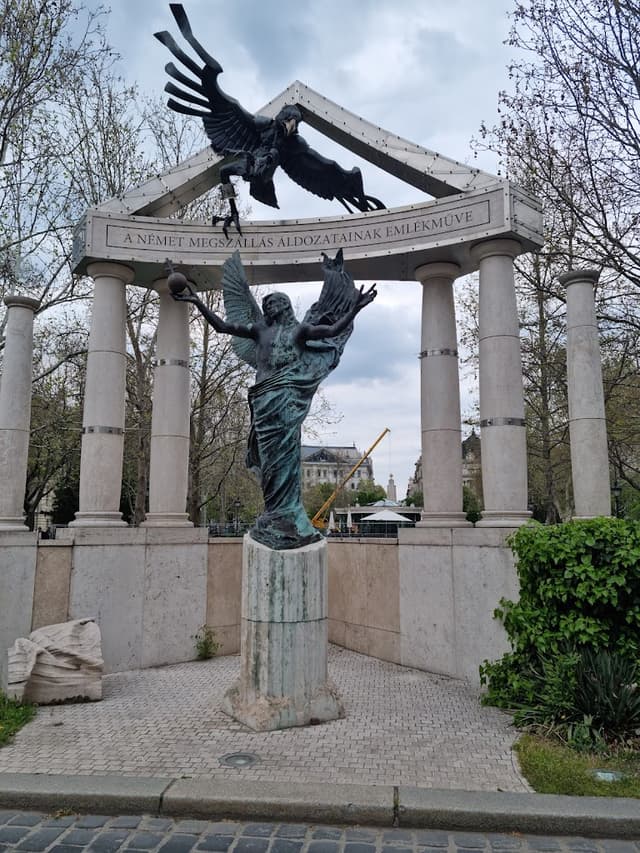
Memorial for Victims of the German Occupation
@pedralexpereira
The Memorial for Victims of the German Occupation, located at the southern end of Liberty Square in Budapest, was unveiled in 2014 to commemorate the Nazi takeover of Hungary on March 19, 1944. The monument features the archangel Gabriel, symbolizing Hungary, being attacked by a Germanic eagle marked with the year 1944 on its ankle. The scene is set against broken columns, with the inscription, “In memory of the victims,” intended to honor those who suffered under Nazi occupation.
However, the memorial has been steeped in controversy since its inception. Many Jewish groups and historians argue that it portrays Hungary solely as a victim of Nazi aggression, ignoring the active complicity of Hungarian authorities in the Holocaust. Critics claim it whitewashes Hungary’s role in the deportation of 437,000 Jews and other atrocities that occurred before and during the German occupation. The monument has been accused of shifting blame away from the Hungarian government of the time, particularly the Horthy regime, which enacted anti-Semitic laws and collaborated with Nazi policies.
The memorial’s construction was highly contentious, completed in secrecy overnight to avoid protests. Opponents, including Holocaust survivors and scholars, viewed it as a distortion of history, accusing Prime Minister Viktor Orbán’s government of “falsifying the Holocaust” and blurring the lines between victims and perpetrators.
Despite the official narrative, an informal counter-memorial has emerged in front of the monument. Families of Holocaust victims and activists have placed photos, documents, and messages to preserve the memory of those who perished. These personal tributes provide a stark contrast to the government’s depiction and serve as a reminder of Hungary’s complex and painful history during World War II.

Details
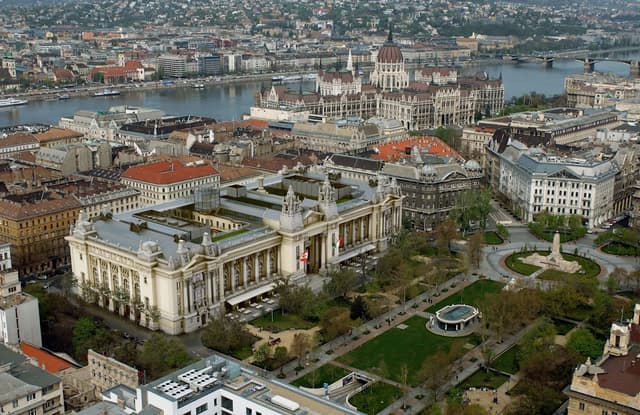
Exchange Palace
@pedralexpereira
The Exchange Palace (Tőzsdepalota) in Budapest is a grand example of Neo-Renaissance and eclectic architecture, located in the city center on Szabadság tér (Liberty Square). Originally built between 1902 and 1905, it was designed by Hungarian architects Ignác Alpár and Flóris Korb to house the Budapest Stock Exchange, which operated in the building until its closure in 1948 after World War II and the nationalization of Hungary's economy under the communist regime.
The palace’s monumental facade is adorned with intricate sculptures and grand columns, embodying the confidence and prosperity of pre-war Hungary. The richly decorated interiors once featured a stunning trading hall, complete with an ornate glass roof, creating a light-filled space that symbolized modernity and transparency.
During the 20th century, the Exchange Palace saw several changes in its use and significance. After the stock exchange was dissolved, the building became home to Hungarian state television, Magyar Televízió, which occupied the space for decades. This repurposing significantly altered some of the interiors, though many of its original architectural features remain intact.
In recent years, the palace has been the subject of ongoing restoration and redevelopment efforts aimed at preserving its historical character while adapting it for modern use. It is seen as an important architectural landmark in Budapest and a symbol of the city's economic and cultural evolution. Today, it stands as a striking representation of Hungary's transition through various political and economic eras.

Details
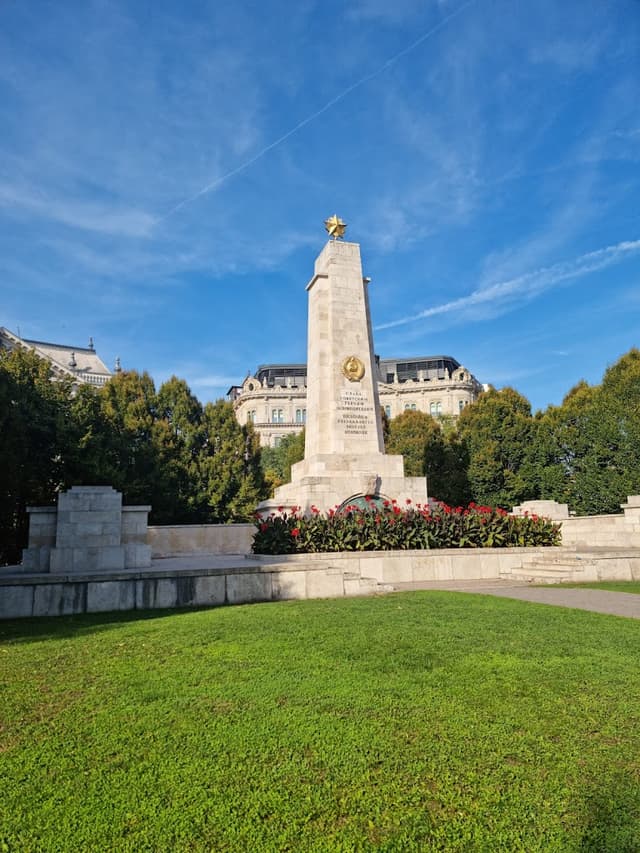
Soviet War Memorial
@pedralexpereira
It was erected to commemorate the Soviet soldiers who died during the liberation of Budapest from Nazi occupation in 1945. This prominent structure, a stark, minimalist obelisk topped with a red star, stands as a reminder of the city’s complex history during World War II and the subsequent Soviet influence over Hungary.
The memorial is one of the few Soviet monuments still standing in Budapest. While many were removed after the fall of communism in 1989, this particular memorial remains due to a diplomatic agreement with Russia. Its presence is often a source of mixed emotions, as it represents both the end of Nazi occupation and the beginning of Soviet dominance in Hungary, a period that lasted until 1989.
Surrounded by other notable landmarks, including the U.S. Embassy and the Ronald Reagan statue, the Soviet War Memorial is part of Liberty Square’s unique juxtaposition of historical and political symbolism. Visitors often reflect on Hungary's turbulent past while exploring this area.

Details
Ronald Reagan Statue
@pedralexpereira
At first glance, the statue of Ronald Reagan in Liberty Square, Budapest, may seem an unusual sight. However, it stands as a symbol of the Hungarian people’s gratitude for Reagan’s role in ending the Cold War and diminishing Soviet influence in Hungary.
The statue faces the U.S. embassy, symbolizing the importance of U.S.-Hungarian relations, but it also gazes directly at the monument commemorating the Red Army, providing a poignant reminder of Hungary’s tumultuous history during the Soviet era. The placement of Reagan's statue reflects both Hungary’s appreciation for his efforts and the complex legacy of Soviet control in Eastern Europe.

Details
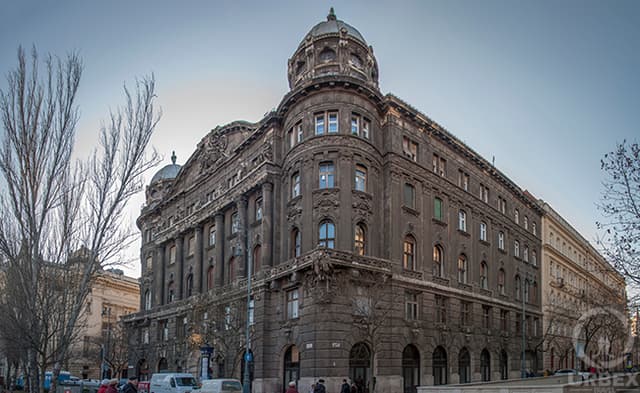
Adria Palace
@pedralexpereira
Adria Palace, located near Liberty Square in Budapest, is an architectural gem steeped in history. Completed in 1918, this imposing structure originally housed the headquarters of the Adriatic Insurance Company. Its name harks back to the days of the Austro-Hungarian Empire when Hungary shared borders with the Adriatic Sea, reflecting a bygone era of economic ambition and maritime connections.
The building’s exterior is a striking example of early 20th-century eclectic architecture, while its interior boasts marble-clad walls, grand staircases supported by stately columns, and an elegant, airy courtyard that has remained remarkably well-preserved. Unlike many abandoned buildings, Adria Palace retains an aura of its former splendor, devoid of graffiti or visible decay, offering a rare glimpse into Budapest’s architectural and cultural legacy.
Although the palace has stood empty for years, its timeless elegance has made it a popular location for film shoots, adding a cinematic touch to its mystique. Its gates remain open, inviting curious visitors to step inside and admire its enduring beauty—a rare opportunity to experience a piece of Budapest’s rich architectural history untouched by modern renovations.

Details
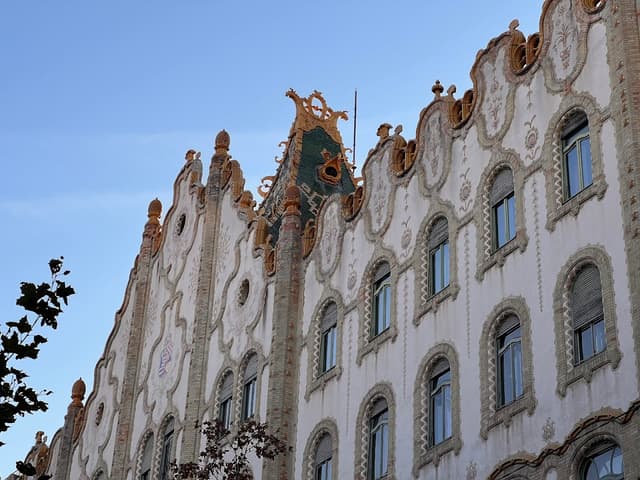
Postal Savings Bank
@pedralexpereira
The Postal Savings Bank building in Budapest is one of the most striking examples of Hungarian Secessionist architecture, designed by the renowned architect Ödön Lechner and completed in 1901. Situated on Hold Street in the Lipótváros district, the building stands out with its ornate design, intricate details, and vibrant Zsolnay ceramic tiles, which reflect Lechner's innovative use of local materials and motifs inspired by Hungarian folk art.
The façade of the building is adorned with swirling floral patterns and stylized natural forms, a hallmark of the Art Nouveau movement. One of its most distinctive features is the green ceramic roof, which catches the light beautifully, adding to the building's visual appeal. Above the main entrance, a sculptural motif of bees in a honeycomb pattern symbolizes industriousness and savings, aligning with the building’s original purpose as a financial institution.
Inside, the design continues to impress, with intricate detailing, stained glass windows, and elegant wrought ironwork. Although it no longer serves as a savings bank, the building remains a treasured architectural gem and a popular destination for those interested in Budapest’s unique blend of history and artistry.

Details
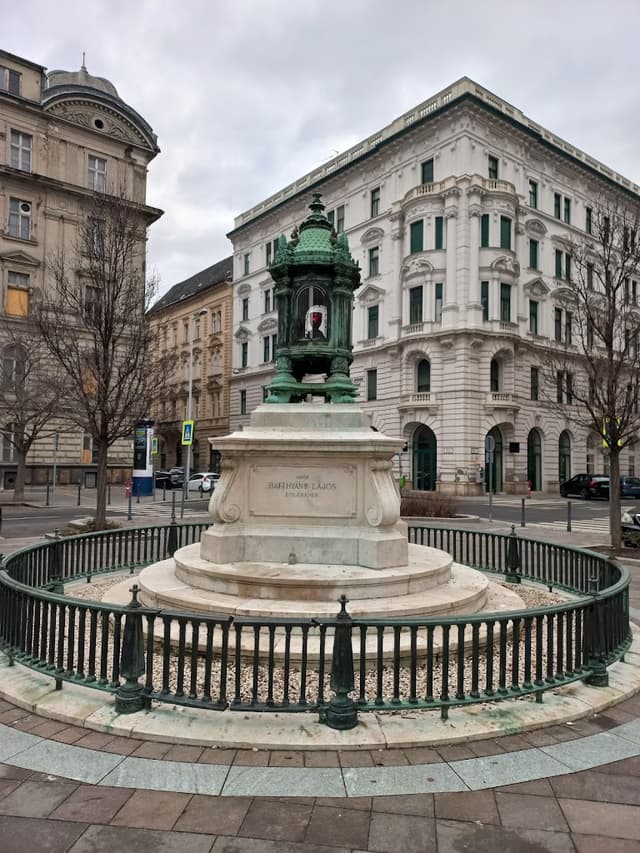
Lajos Batthyányi Eternal Flame
@pedralexpereira
Batthyány's Sanctuary Lamp (Batthyány Lajos-örökmécses) is a poignant national monument located at the intersection of Báthory Street and Hold Street in Budapest's Lipótváros district. The monument stands on the site of the former courtyard of the New Building, where Count Lajos Batthyány, Hungary's first Prime Minister, was executed on 6 October 1849. Batthyány was a key figure during the Hungarian Revolution of 1848 and his execution by firing squad, after the failed revolution, became a symbol of Hungary’s struggle for independence.
In 1905, the design for the monument was chosen by architect Móric Pogány, featuring a large lantern symbolizing the eternal remembrance of Batthyány’s sacrifice. However, due to the disruption of World War I, the construction was delayed, and the monument was eventually unveiled on 6 October 1926. The ceremony was attended by István Lebó, who was the last living member of the Hungarian army to have served during the 1848 revolution.
Over the years, the monument has become a focal point for political demonstrations, particularly in 1941, 1943, and 1988, serving as a place for public expression and remembrance of Hungary’s turbulent history.

Details
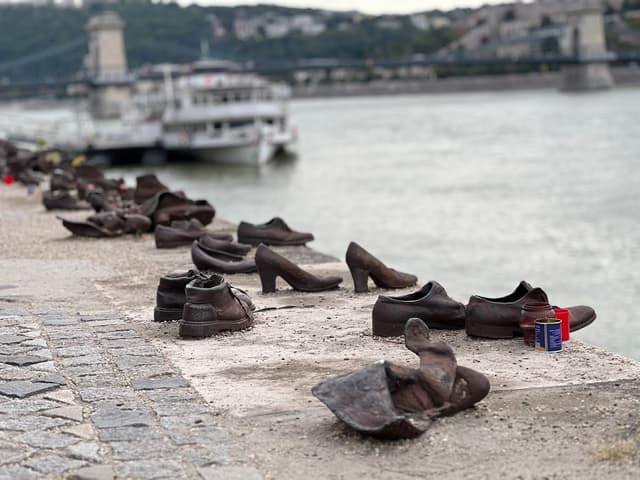
Shoes on the Danube Bank
@pedralexpereira
Shoes on the Danube Promenade is a poignant memorial in Budapest, commemorating one of the darkest chapters in the city's history during World War II. Situated along the banks of the Danube River, this monument serves as a stark reminder of the atrocities committed by the Arrow Cross Party, a fascist and anti-Semitic regime that came to power under Ferenc Szálasi in October 1944 after Adolf Hitler ousted Hungarian leader Miklós Horthy.
The Arrow Cross's terror included mass deportations and executions of Jews in Budapest. Among the most harrowing acts were the shootings along the Danube River, where approximately 20,000 Jews were murdered. Victims were forced to remove their shoes, a valuable wartime commodity, before being executed and left to fall into the freezing waters.
Created by film director Can Togay and sculptor Gyula Pauer, the memorial consists of 60 pairs of iron shoes, each designed in 1940s styles to represent men, women, and children. The variety of footwear—from work boots to delicate heels and children's shoes—reflects the indiscriminate nature of the killings. Arranged casually along the riverbank, as though their owners had just stepped out of them, the sculptures evoke a haunting sense of absence and loss.
Installed in 2005, the memorial includes plaques in Hungarian, English, and Hebrew, inscribed: "To the memory of the victims shot into the Danube by Arrow Cross militiamen in 1944–45." The simplicity of the monument amplifies its emotional impact, inviting quiet reflection on the lives stolen during this horrific period.
Visitors are encouraged to approach the site with reverence, taking time to contemplate the weight of its history while standing before the river that bore witness to such tragedy. This powerful tribute continues to resonate, serving as a somber reminder of the importance of remembering and confronting the past.

Details
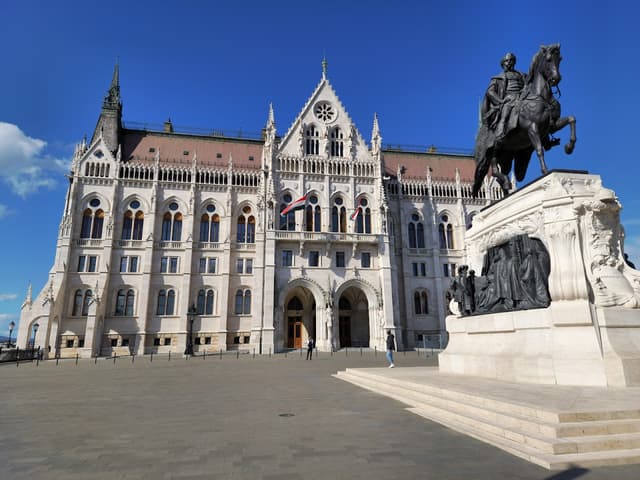
Statue of Count Gyula Andrássy
@pedralexpereira
Gyula Andrássy, a prominent Hungarian statesman, played a pivotal role in shaping Hungary's modern history. Born in 1823, he served as the first Prime Minister of Hungary from 1867 to 1871 after the Austro-Hungarian Compromise, a period that marked the dual monarchy's establishment. Later, from 1871 to 1879, he became the Foreign Minister of Austria-Hungary. A conservative by ideology, Andrássy sought to strengthen the empire's influence in Southeast Europe through diplomatic alliances with Britain and Germany, all while maintaining a careful balance to avoid antagonizing the Ottoman Empire. His policies reflected a deep mistrust of Russia, which he viewed as a rival due to its ambitions in Slavic and Orthodox regions. He also opposed Slavic nationalism, considering it a destabilizing force within the multi-ethnic Austro-Hungarian Empire.
The bronze equestrian statue of Count Gyula Andrássy stands as a tribute to his legacy on Kossuth tér, in front of Budapest's iconic Parliament building. Originally created by renowned Hungarian sculptor György Zala and unveiled in 1904, the statue became a symbol of Andrássy's enduring influence. Following a period of removal during the 20th century, the statue was recast and restored as part of a larger effort to return the square to its historic appearance. This reconstruction was completed by the Bencsik Alkotóközösség Művészeti Kft.
The 6.5-meter-tall statue, located on the southern side of the Parliament building, captures Andrássy astride a horse, embodying his strength and leadership. It stands as a reminder of his contributions to Hungary's political landscape and his role in navigating the complexities of 19th-century European diplomacy.

Details
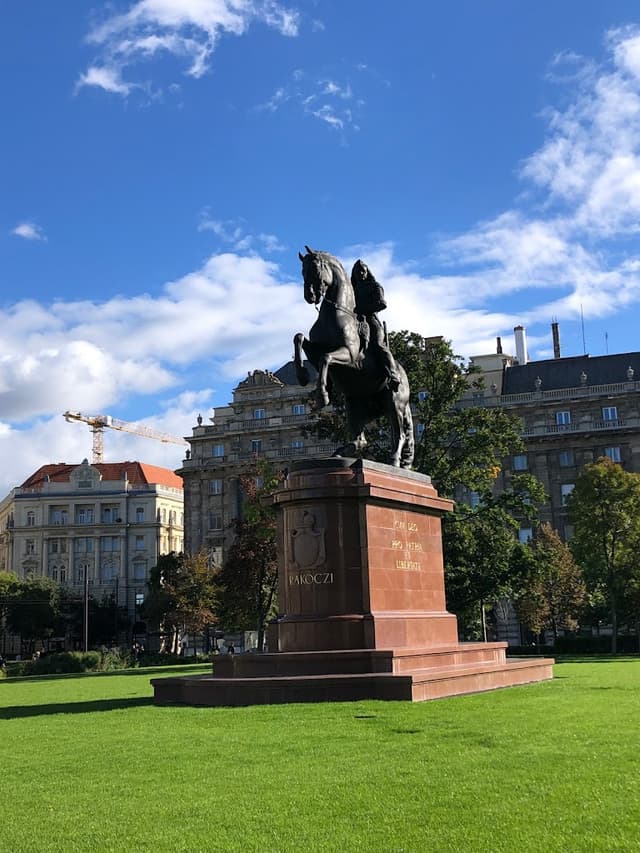
II. Rakoczi Ferenc equestrian statue
@pedralexpereira
The equestrian statue of II. Rákóczi Ferenc, one of Hungary's most revered historical figures, stands proudly on Kossuth tér near the Parliament building in Budapest. Ferenc Rákóczi II (1676–1735) was the leader of the Hungarian uprising against Habsburg rule during the early 18th century, remembered as the War of Independence (1703–1711). His efforts to establish Hungary's autonomy, though ultimately unsuccessful, made him a symbol of national resistance and a hero in Hungarian history.
The statue depicts Rákóczi on horseback, exuding determination and strength, a fitting tribute to his role as a commander and patriot. The dynamic pose of both rider and horse reflects his resolute leadership during the tumultuous period of Hungary's struggle for independence.
Originally sculpted by János Pásztor and unveiled in 1937, the statue was later removed during political upheavals in the 20th century. It was eventually restored as part of the Kossuth tér revitalization project to honor Hungary's historical and cultural heritage. The bronze sculpture is mounted on a grand pedestal, which bears an inscription commemorating Rákóczi’s leadership and dedication to the Hungarian cause.
Today, the II. Rákóczi Ferenc equestrian statue serves not only as a memorial to his fight for freedom but also as a reminder of Hungary's enduring spirit and its people's determination to preserve their identity and sovereignty. It is a significant landmark, blending artistic mastery with profound historical resonance.

Details
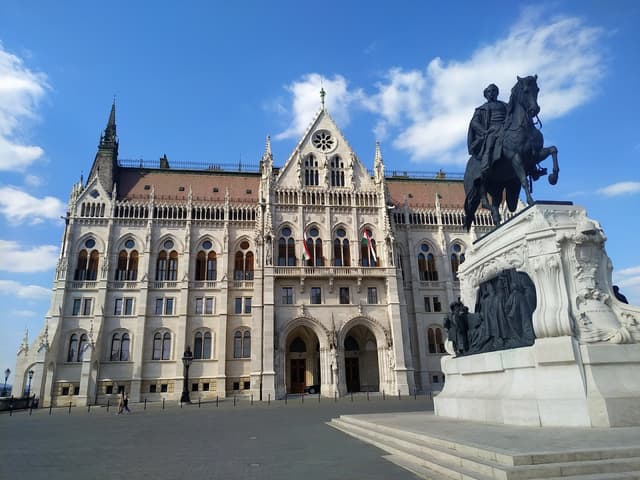
Kossuth Lajos Square
@pedralexpereira
It serves as a symbolic hub of Hungarian political and cultural life, with its most prominent feature being the grand Hungarian Parliament Building, a masterpiece of Neo-Gothic architecture. The square is easily accessible via the M2 Metro line and is a stop for the scenic Tram No. 2, making it a popular destination for both locals and visitors.
The square’s history is intertwined with Hungary's national identity. It was renamed in 1927 after Lajos Kossuth, the revolutionary leader who played a key role in the 1848-49 War of Independence. Previously, it had various names, reflecting its evolving purpose. Originally referred to as Stadtischer Auswind Platz ("Unloading Square for the Ships") in 1820, it became Tömő tér ("Landfill Square") when the area was raised using rubble to mitigate flooding. By 1898, it was known as Országház tér ("Parliament Square"), signifying its growing importance as the seat of government.
In the late 19th century, Kossuth Square transformed into a focal point of the Hungarian state, marked by the construction of prominent buildings, including the Palace of Justice and the Ministry of Agriculture. During World War II, the square gained further significance when a temporary bridge, the Kossuth híd, connected it to Batthyány Square on the Buda side. Though dismantled in 1960, its memory persists with commemorative stones on both riverbanks.
Kossuth Square also became a site of historical and political importance in modern times. It was the epicenter of anti-government protests in 2006 following the release of then-Prime Minister Ferenc Gyurcsány's controversial speech, and it has witnessed various demonstrations throughout Hungary’s post-war history. The square underwent significant restoration in 2012 to restore its pre-1944 appearance, reopening in 2014 as a car-free space featuring sustainable landscaping, tram tracks, underground parking, and memorials, including a poignant tribute to the victims of the 1956 Kossuth Tér massacre.

Details
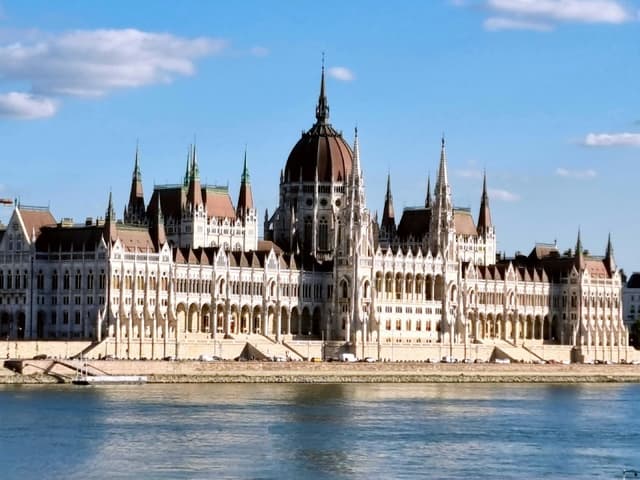
Hungarian Parliament Building
@pedralexpereira
The Hungarian Parliament Building (Országház), located on Kossuth Square in Budapest, is one of Hungary's most significant landmarks and a popular tourist destination. Designed by Hungarian architect Imre Steindl, the building was completed in 1902 in a neo-Gothic style, influenced by the Vienna City Hall and Renaissance elements from the Maria vom Siege Church in Vienna. The Parliament Building, which has been the largest building in Hungary since its completion, stretches 268 meters long and 123 meters wide.
The idea to build a new parliamentary building came after the unification of Budapest in 1873. A competition was held, and Steindl’s design was chosen, partly due to its resemblance to the Palace of Westminster in London. Construction began in 1885, with the building inaugurated on the 1,000th anniversary of Hungary in 1896. However, the building was not fully completed until 1904. Steindl, unfortunately, went blind during the project and died before the building was finished.
The Parliament Building is known for its symmetrical façade, a central dome, and its intricate interior design. It contains 10 courtyards, 13 elevators, 29 staircases, and 691 rooms, including over 200 offices. The building stands 96 meters tall, a symbolic height representing Hungary’s millennium and the conquest of the Kingdom of Hungary in 896.
Inside, visitors can see the impressive hexadecagonal central hall and two adjoining chambers: one used for current National Assembly sessions, and the other for ceremonies, conferences, and tours. The Holy Crown of Hungary has been on display in the central hall since 2000. The building is decorated with numerous statues, including of Hungarian rulers, military figures, and important historical figures like Árpád, Stephen I, and John Hunyadi. The façade is adorned with 242 sculptures, including those of Transylvanian leaders and Hungarian kings.
The Parliament Building is accessible via the Kossuth Lajos Square Metro and tram stations. Nearby attractions include the Kossuth Memorial, the equestrian statue of Francis II Rákóczi, and a memorial to the 1956 Hungarian Revolution. The building is also prominently featured on Hungarian postage stamps from 1917 to 1921.

Details
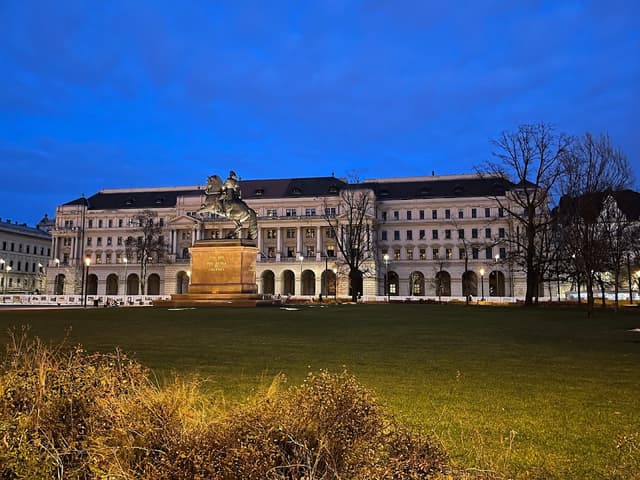
Ministry of Agriculture
@pedralexpereira
The Ministry of Agriculture Building, situated in Kossuth Lajos Square directly opposite Budapest’s Parliament, bears silent witness to one of Hungary’s most tragic moments: the 1956 Revolution against Soviet control. This historic structure became a grim backdrop to the events of October 25, now remembered as Bloody Thursday. On that day, Soviet troops and the state secret police fired on peaceful protesters gathered at the Parliament, leading to chaos and bloodshed.
Fleeing demonstrators sought refuge behind the building’s colonnade, but the pursuit continued. Gunfire scarred the building’s exterior, leaving behind bullet holes that would later be marked by dozens of bronze spheres, slightly smaller than tennis balls, embedded in the wall as a poignant memorial to the violence.
The massacre's death toll remains uncertain, with estimates ranging from 22 to as many as 1,000. Despite the courage of the protesters, the revolution was ultimately crushed by Soviet reinforcements in November 1956.
The bullet-marked arcade has long been accessible to visitors, offering a solemn reminder of the sacrifices made in the pursuit of freedom. However, as of June 2024, ongoing renovations have temporarily restricted access to the site. Although the bronze markers have been removed during this process, the building remains a powerful symbol of Hungary's fight for autonomy and the enduring impact of its revolutionary spirit.

Details
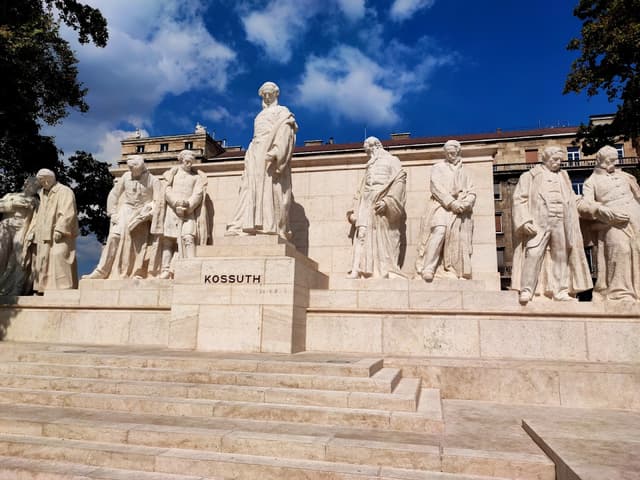
Kossuth Lajos Monument
@pedralexpereira
The memorial to the victims of the October 25, 1956 massacre at Kossuth tér was established as part of the square's 2012-2014 reconstruction. This solemn tribute is located in the southern ventilation tunnel of the square and commemorates the unarmed protesters who were tragically killed during the 1956 Hungarian Revolution. The event, referred to as "Bloody Thursday," occurred when Soviet troops and Hungarian state police opened fire on demonstrators who had gathered in Kossuth tér.
The massacre remains shrouded in uncertainty, with various aspects of the event still unclear, including who fired the first shot, why the protesters had assembled in the square on that day, and the exact number of casualties. Estimates vary widely, with sources reporting between 22 and 1000 deaths. British officials have suggested the death toll was likely between 300 and 800. The memorial at Kossuth tér, which includes photos, videos, candles, and era-specific memorabilia, serves as both a remembrance and a call for further information to help uncover the full story of what occurred that day.

Details
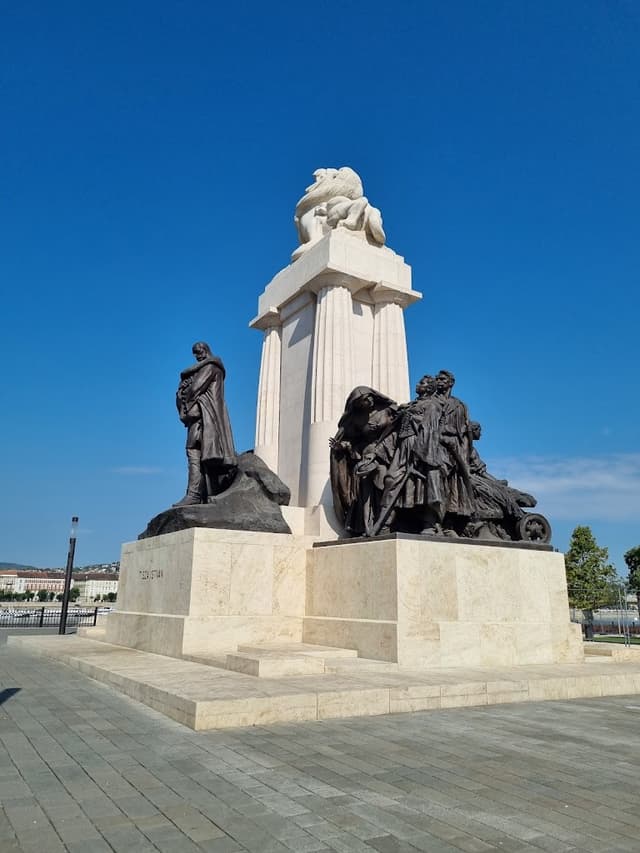
István Tisza Monument
@pedralexpereira
The István Tisza Monument, located in Budapest, commemorates one of Hungary’s most significant political figures of the early 20th century. István Tisza (1861–1918) was a Hungarian politician who served as Prime Minister of Hungary twice, first from 1903 to 1905 and then from 1913 to 1917. Tisza was a key figure during the late Austro-Hungarian Empire, known for his conservative and nationalist policies.
Tisza was instrumental in navigating Hungary through a period of political tension and crisis, particularly during World War I. He was a strong supporter of the Austro-Hungarian alliance and played a major role in leading Hungary through the war. Despite his efforts, the war's devastating consequences and the subsequent collapse of the Austro-Hungarian Empire led to Tisza's downfall. He was assassinated in 1918 by political opponents during the upheaval at the end of the war.
The monument to István Tisza is located on Kossuth Lajos Square, directly in front of the Hungarian Parliament Building. The statue was erected in 1934, during a period of political conservatism in Hungary, to honor Tisza's contributions to the nation. The monument is notable for its grand, imposing figure of Tisza, depicted in a dignified and heroic pose. The figure of Tisza is surrounded by intricate bronze reliefs, which highlight significant moments from his life and career.
Tisza's legacy is mixed, as he is remembered both for his contributions to Hungary’s political life and for his controversial stance during the First World War, where his policies have been criticized for exacerbating Hungary’s involvement in the conflict. The monument, however, stands as a tribute to his significant role in Hungarian history.

Details
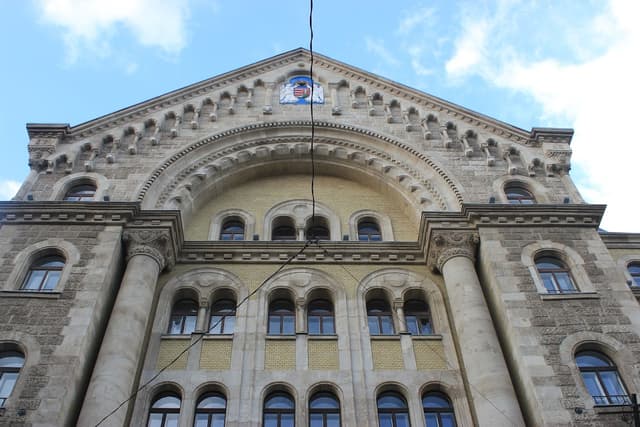
Pest Central District Court
@pedralexpereira
It serves as one of the key courts in the city, handling a wide range of legal matters, from civil cases to criminal proceedings.
The building is located on Párizsi utca in the 5th District, a central area of the Pest side of Budapest. It was designed in a grand, neoclassical style, with influences from the architectural movements of the late 19th and early 20th centuries. The design features impressive symmetrical facades, large windows, and a monumental entrance that highlights the importance of the judiciary and legal proceedings. Like many government buildings in Budapest, it also incorporates elements of classical design, such as columns and intricate stone carvings, symbolizing the authority and solemnity of the legal system.
The Pest Central District Court has historical importance, not only as a center for legal proceedings but also as part of the broader evolution of Hungary’s legal institutions. Located in the city’s political and cultural center, the court has witnessed many important legal decisions over the years. The building is closely associated with the city’s judicial history, including the post-World War II period when Hungary underwent significant legal and political changes.
Today, the Pest Central District Court remains an active part of Budapest’s judicial system, handling various cases involving civil, criminal, and administrative law. It is one of the busiest courts in the city, serving as a focal point for legal matters in the capital. In addition to its primary role, the building is also a notable landmark in the city’s urban landscape.

Details
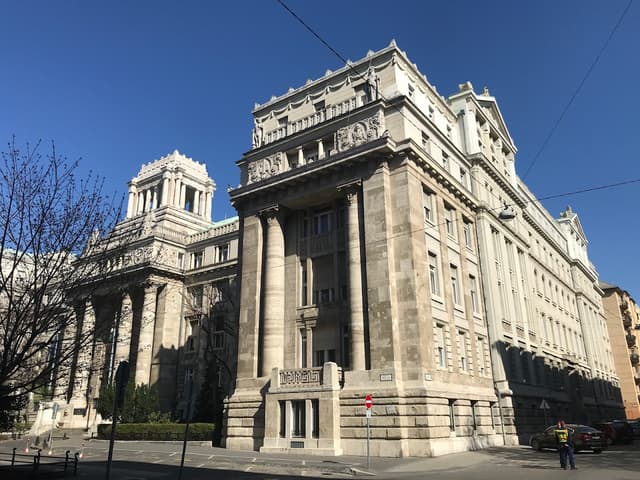
Supreme Court of Hungary
@pedralexpereira
The Curia traces its origins back to the Royal Court that existed in Hungary during the medieval era. The institution itself has undergone various transformations throughout history, reflecting the changing political and legal landscape of the country. It was originally the court responsible for legal matters during the medieval Hungarian Kingdom, evolving into a more modern judiciary institution over time.
The building that currently houses the Curia was constructed in the early 20th century, officially opened in 1909. It stands on Kossuth Lajos tér, near the Parliament and other important governmental buildings. The structure was built in the wake of Hungary’s early 20th-century political and social developments, as the country sought to modernize its infrastructure and legal institutions after the Austro-Hungarian Compromise of 1867.
The building itself is an example of neoclassical architecture, with a symmetrical façade and large, imposing columns. The design, meant to evoke grandeur and formality, reflects the importance of the institution housed within. The exterior is marked by the use of marble and stone, while the interior is equally impressive, with richly decorated halls and chambers that showcase the judicial significance of the building.

Details
Metropolitan Court
@pedralexpereira
The building was built between April 19, 1888 and August 1, 1890 according to the plans of Alajos Hauszmann and Ferenc Jablonszky, in addition to the execution of József Pucher
It is interesting that at that time Hauszmann designed not only a court building, but also a prison section. It is also in use today: Object No. 1 of the Capital Penitentiary Institute operates in it. Its entrance is located on Nagy Ignác Street.

Details
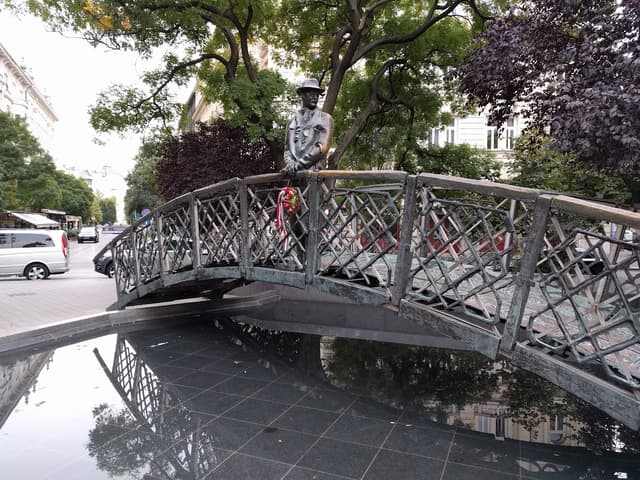
Statue of Imre Nagy
@pedralexpereira
The statue of Imre Nagy has experienced some controversy in recent years. Initially erected in 1996 at Martyrs’ Square, it was moved by Hungarian authorities from its original location in central Budapest to a park near the Hungarian Parliament.
Imre Nagy, a key figure in the 1956 Hungarian Revolution against Soviet influence, was executed in 1958 for his role in the uprising. As a pro-reform communist, he had attempted to break free from Soviet-imposed hard-line communism, but his efforts were crushed when Soviet tanks intervened, and pro-Moscow forces regained control.
The statue's relocation to Jászai Mari Square, north of the Parliament, sparked criticism, with many viewing it as part of a broader attempt by Prime Minister Viktor Orbán’s nationalist government to rewrite Hungary’s historical narrative. Despite the move, the statue remains a popular symbol of resistance, often visited by locals and tourists, who leave wreaths in tribute to the man and the events he represents.

Details
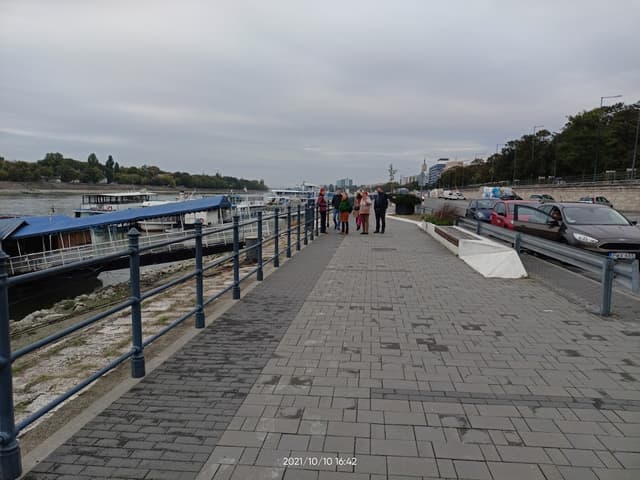
Carl Lutz rakpart
@pedralexpereira
Carl Lutz Rakpart, located along the Danube in Budapest, is named after Carl Lutz, a Swiss diplomat who played a crucial role in saving thousands of Hungarian Jews during World War II. As Vice Consul at the Swiss Legation in Budapest, Lutz issued protective Swiss documents, known as "Schutzpasses," which allowed Jewish people to avoid deportation by Nazi forces. His actions, often carried out under dangerous circumstances, helped to save approximately 62,000 Jews from certain death during the Holocaust.
The embankment along the Danube was named in his honor in recognition of his humanitarian efforts and his bravery in the face of enormous risks. Today, Carl Lutz Rakpart serves as a reminder of the courage and moral leadership shown by Lutz and others during one of history's darkest periods. It is a place of reflection on the history of Budapest and the Holocaust, where visitors can remember those whose lives were saved through extraordinary acts of compassion and diplomacy.

Details
Columbo Statue
@pedralexpereira
The Columbo statue in Budapest is a charming and unexpected tribute to the legendary TV detective portrayed by Peter Falk. Located on Falk Miksa Street, the statue was erected in 2014 and has become a quirky landmark that attracts fans of the show and curious visitors alike.
The life-sized bronze statue depicts the disheveled, trench coat-clad Lieutenant Columbo, complete with his signature cigar in hand. Beside him stands a smaller statue of his faithful basset hound, Dog, adding to the charm of the scene. Created by sculptor Géza Dezső Fekete, the statue captures the essence of the character's unassuming yet brilliant persona.
The location of the statue is thought to be a playful nod to a theory that Peter Falk might have had Hungarian roots, as the name Falk shares similarities with the street's name. While there’s no concrete evidence to confirm this connection, the statue has become a beloved addition to Budapest's eclectic mix of public art.

Details
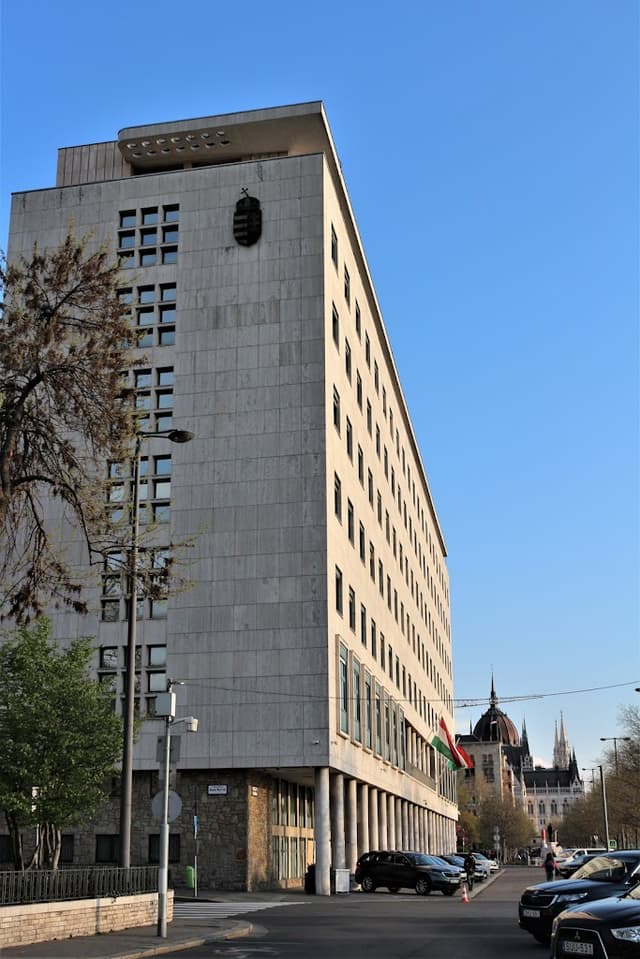
National Assembly Office Building
@pedralexpereira
Initially designed as a luxury apartment building, this structure near the Parliament in Budapest gained prominence due to its proximity to the ministerial district. Over the years, it transitioned from private residences to an office building for high-profile government functions. For many, it is remembered as the headquarters of the MSZMP during the socialist era.
The construction of the Parliament in the early 20th century significantly boosted the value of surrounding plots, leading to the development of this luxurious property on what was then Rudolf Square. Severely damaged during World War II, the building underwent major reconstruction influenced by the establishment of a new government district around the Parliament. Redesigned in a modernist style, it reopened as the Ministry of the Interior's offices. In 1951, it housed the ÁVH and later became the headquarters of the National Police Headquarters. Eventually, the MSZMP occupied the building, using it as their central office until 1990.
One of its notable features is the mural "Workers' State," painted by Aurél Bernáth in 1970. This artwork, located in the building’s auditorium, includes depictions of key party-state leaders like János Kádár and György Aczél, alongside Imre Nagy and Tibor Déry, albeit with subtle details to downplay their identities due to their controversial legacies. The building also became a stage for significant historical moments, such as the cremation of János Kádár in July 1989, just a month after Imre Nagy’s reburial, symbolizing the turbulent period of Hungary's political transformation.
Following the regime change, the property was transferred to the Office of the National Assembly. Today, it functions as the Office of the Representatives, continuing its role in Hungary's administrative and political history.

Details
Museums, cultural venues and activities
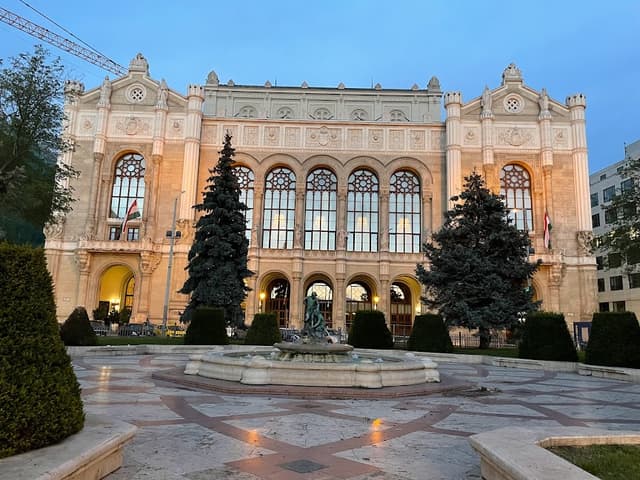
Vigadó Concert Hall
@pedralexpereira
The Vigadó, often referred to as the "Place for Merriment," is Budapest's second-largest concert hall and a striking architectural landmark along the Pest embankment. Designed by Frigyes Feszl in 1859, the building makes an imposing statement despite its reputation for less-than-ideal acoustics. It was constructed to replace an earlier concert hall destroyed during the 1848 War of Independence.
Feszl's original Vigadó was later heavily damaged during World War II, but its post-war reconstruction, which spanned over three decades, faithfully adhered to the initial design. Today, it continues to host performances by renowned conductors and artists from around the globe. Its façade underwent a meticulous cleaning and restoration in 2006, bringing back its intricate details and grandeur.
The Budai Vigadó, located on the Buda side, serves as the home stage for the Hungarian State Folk Ensemble, also known as the House of Traditions. Established in 1951, the ensemble showcases Hungarian traditional dance and music. It features 30 dancers, a Gypsy orchestra of 14 musicians, and a 5-member folk band, preserving and celebrating Hungary's rich cultural heritage through its captivating performances.

Details

Madame Tussauds Budapest
@pedralexpereira
Madame Tussauds Budapest is a vibrant addition to the iconic chain of wax museums, offering visitors the chance to get up close with lifelike wax figures of celebrities, historical figures, and cultural icons. Opened in the heart of Budapest, it combines international stars with uniquely Hungarian figures, making it a blend of global and local culture.
The museum features meticulously crafted wax figures of international celebrities, such as movie stars, athletes, and political leaders, alongside notable Hungarians, including historical heroes, cultural legends, and contemporary influencers. Interactive exhibits and themed rooms enhance the experience, allowing visitors to immerse themselves in the stories of these personalities.
Located in a central area of Budapest, Madame Tussauds is easily accessible and appeals to tourists and locals alike. It provides a unique mix of entertainment and education, making it an engaging stop for families, history enthusiasts, and pop culture fans.

Details
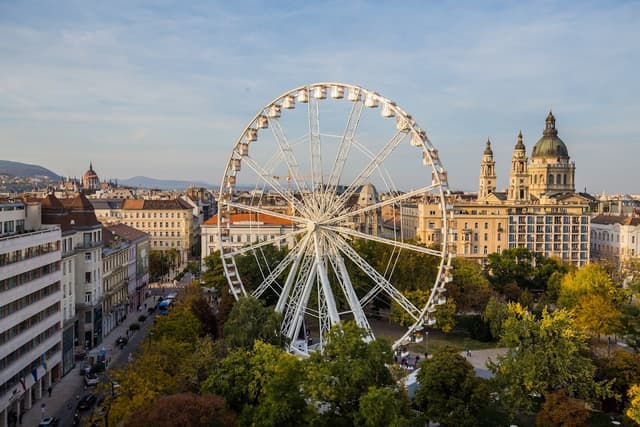
Ferris Wheel of Budapest
@pedralexpereira
The Budapest Eye, a striking ferris wheel located in Erzsébet Square, stands as one of the most recognizable landmarks in the heart of Budapest. Built by the same company behind La Grande Roue in Paris, it offers breathtaking panoramic views of the city all year round. Another similar ferris wheel appears seasonally on Hajógyári Island during the renowned Sziget Festival.
At 65 meters tall, the Budapest Eye is the largest ferris wheel in Europe, towering above the surrounding buildings. From its highest point, visitors can enjoy sweeping views of Budapest's most iconic sights, including St. Stephen’s Basilica, the Hungarian Parliament, and the UNESCO-listed Andrássy Avenue.
Open daily from 10:00 a.m. to midnight, the ferris wheel offers a ride lasting 8-10 minutes, during which it completes three full rotations. Tickets are available on-site, with prices set at 2,400 HUF (approximately 8 euros) for adults and 1,500 HUF (about 5 euros) for children aged 2 to 14.
While the lines can be long during peak seasons, the stunning views of Budapest make the wait well worth it, offering visitors a unique perspective on the city's beauty.

Details

Budapest Retro Élményközpont
@pedralexpereira
The Budapest Retro Élményközpont, or Budapest Retro Experience Center, is a nostalgic journey back to Hungary's socialist era between the 1960s and 1980s. Located in the heart of Budapest, this interactive museum provides visitors with an immersive glimpse into everyday life during this fascinating period of Hungarian history.
The center showcases a wide array of artifacts and exhibits, including vintage furniture, iconic Trabant cars, household appliances, toys, and propaganda posters. Visitors can explore recreated settings like a typical Hungarian living room or kitchen from the era, offering a tactile and visual connection to the past.
In addition to its exhibits, the Retro Center enhances the experience with audiovisual displays and even lets visitors try on retro clothing. It also features a cozy café, serving popular snacks and drinks from the time, allowing guests to literally taste history.
Open to all ages, the Budapest Retro Élményközpont is a great stop for those interested in learning about Hungary’s socialist past, combining education and entertainment in a uniquely engaging way.

Details
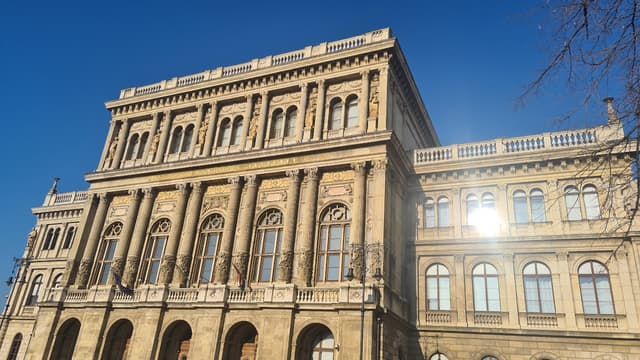
Hungarian Academy of Sciences
@pedralexpereira
The Hungarian Academy of Sciences (Magyar Tudományos Akadémia, MTA) is Hungary's foremost institution for the advancement of science and learning. Situated along the Danube River in Budapest, between Széchenyi rakpart and Akadémia utca, it is central to the cultivation and dissemination of scientific knowledge, supporting research, development, and representing Hungarian science on both the domestic and global stage.
The Academy’s origins trace back to 1825, when Count István Széchenyi, one of Hungary’s most influential reformers, offered the income from his estate for the establishment of a Learned Society. This initiative, presented during a session of the Diet in Pressburg (modern-day Bratislava), was followed by other delegates, marking the start of a national effort to develop the Hungarian language and promote scientific and cultural advancement in Hungary. The Academy was formally named the Hungarian Academy of Sciences in 1845.
The current building of the Academy, designed by architect Friedrich August Stüler in the Renaissance Revival style, was inaugurated in 1865. It stands as an architectural and cultural landmark, representing the long history of Hungarian scientific achievement.

Details
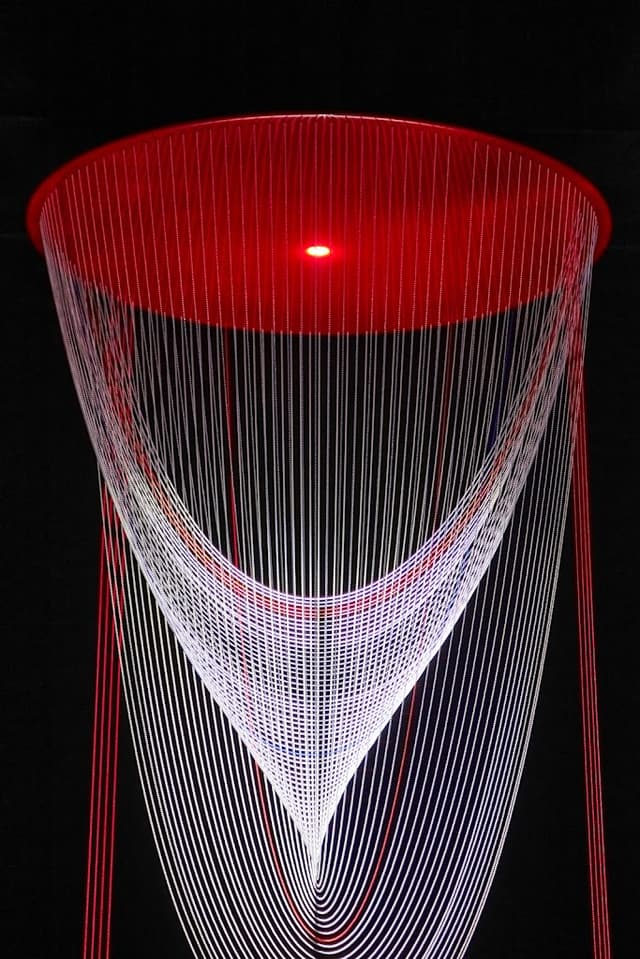
Light Art Museum
@pedralexpereira
The Light Art Museum in Budapest is a cutting-edge cultural attraction celebrating the dynamic interplay of light, art, and technology. Located in a historic industrial building near the Danube, this immersive museum offers visitors a chance to explore contemporary art installations crafted by both Hungarian and international artists. It showcases the innovative use of light as a medium in art, creating captivating and interactive experiences.
The museum’s exhibitions feature a mix of permanent and temporary displays, including holography, projection mapping, neon art, and LED sculptures. Each piece invites viewers to engage with the artwork in a multi-sensory way, transforming how they perceive space, color, and movement.
Perfect for families, art enthusiasts, or anyone seeking a unique experience, the Light Art Museum combines artistic creativity with cutting-edge technology, making it one of Budapest's most forward-thinking cultural destinations. It’s a haven for photographers and Instagram enthusiasts, as the vivid and surreal installations provide plenty of opportunities for stunning visuals.

Details

Cat Museum Budapest
@pedralexpereira
The Cat Museum in Budapest is a charming and whimsical destination dedicated to feline art, culture, and history. Located in the heart of the city, this quirky museum offers a delightful experience for cat lovers and curious visitors alike. Its exhibits feature a wide range of cat-themed artworks, from vintage posters and paintings to modern sculptures and crafts, showcasing how cats have inspired artists and captivated human imagination throughout the ages.
In addition to the art, the museum includes fun facts about cat breeds, their role in folklore, and their historical significance across different cultures. Interactive displays and cozy corners create a welcoming atmosphere, allowing visitors to enjoy the exhibits at their leisure.
A small gift shop within the museum offers cat-themed souvenirs, from cute trinkets to unique art prints, making it a perfect stop for anyone looking to bring home a memory of this purr-fect experience. Whether you're a devoted cat enthusiast or simply looking for a lighthearted and unique outing in Budapest, the Cat Museum is sure to bring a smile to your face.

Details
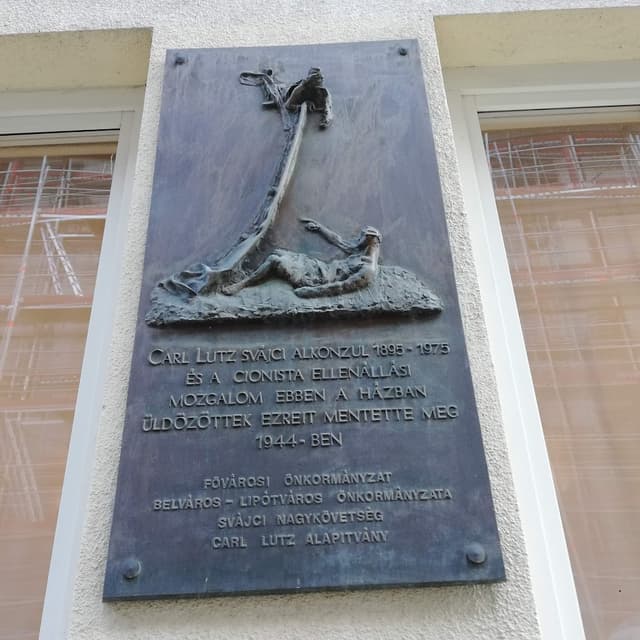
The Glass House Memorial Museum
@pedralexpereira
The Glass House (Hungarian: Üvegház), located at 29 Vadász Street in Budapest, is a significant historical site linked to the heroic efforts of Swiss diplomat Carl Lutz during the Holocaust. The building, once a glass factory, served as a refuge for approximately 3,000 Jews escaping the brutal persecution of Hungarian fascists, anti-Semitic groups, and the Nazi regime during World War II.
Carl Lutz, who was appointed as Swiss vice-consul in Budapest in 1942, played a pivotal role in saving the lives of tens of thousands of Jews. By issuing "letters of protection," a diplomatic tool he negotiated with Nazi authorities, Lutz was able to provide life-saving safe conduct for Jews at risk of deportation to concentration camps. He is credited with saving around 62,000 Jews, and his actions extended to organizing the emigration of 10,000 Jewish children to Israel.
Among the many safe houses Lutz established around Budapest, the Glass House became one of the most famous. It acted as a sanctuary where Jews could find refuge under the protection of the Swiss legation. Lutz’s courageous misinterpretation of a Nazi directive allowed him to issue thousands of protective letters, ultimately saving many lives.
After the war, Lutz faced initial reprimands for his bold actions, but he was later recognized for his heroism, receiving honors from the Swiss government and international organizations. In 1964, he was named "Righteous Among the Nations" by Yad Vashem, Israel's Holocaust memorial authority.
Today, the Glass House stands as a museum documenting the life and legacy of Carl Lutz and his extraordinary efforts to protect and save lives during one of history’s darkest times. The site includes exhibits about Lutz’s diplomatic work and the history of the Holocaust in Hungary, with a commemorative monument dedicated to his memory at the entrance to the old Budapest ghetto.

Details
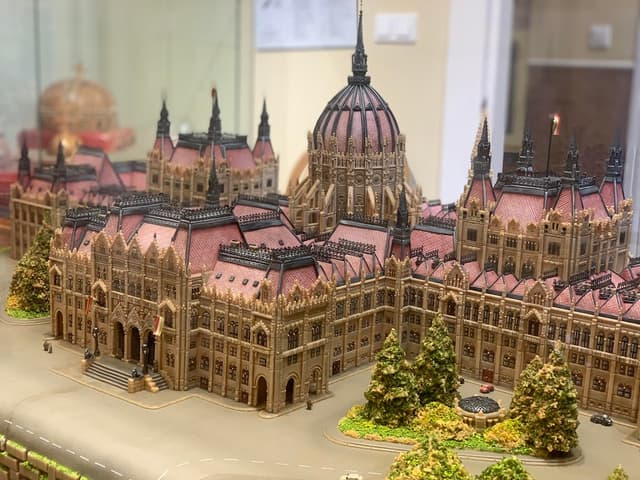
Szamos Chocolate Museum
@pedralexpereira
The Szamos Chocolate Museum, located in Budapest, is a delightful destination for those with a sweet tooth and an interest in the history of chocolate making. Founded by the Szamos family, one of Hungary's most renowned chocolate manufacturers, the museum offers an immersive experience into the world of high-quality Hungarian confectionery.
The museum showcases the craftsmanship behind Szamos’ famous chocolates, which have been a part of Hungarian culinary tradition for decades. Visitors can explore exhibits detailing the history of chocolate, from its ancient origins to modern-day innovations in the confectionery world. The museum highlights the process of chocolate making, from the selection of raw cocoa beans to the production of finished products. It also offers a collection of historic chocolate-related artifacts and tools.
In addition to the displays, the Szamos Chocolate Museum also features a café where visitors can indulge in a range of chocolates and pastries made on-site. The museum is a celebration of Hungarian chocolate culture and provides an opportunity to learn about the rich legacy of one of Hungary’s most prestigious chocolate brands while enjoying delicious treats.

Details

Memorial of National Cohesion
@pedralexpereira
The monument dedicated to the Trianon Treaty, which was inaugurated in 2020 to mark the 100th anniversary of the Versailles Peace Treaty, stands as a reminder of Hungary's loss of territory and population after World War I. It commemorates the country's painful history following the signing of the treaty in the Trianon Palace in Versailles, where Hungary lost two-thirds of its territories and a significant portion of its ethnic Hungarian population.
The memorial, located at Kossuth Lajos Square across from the Hungarian Parliament, consists of a 100-meter-long tunnel that symbolizes the grief and sorrow of those who lived through this historical event. The names of every Hungarian town or village that was once part of Hungary's borders are displayed along the tunnel walls, creating a somber reflection of lost regions. However, some find the tunnel’s design somewhat discouraging, as it ends abruptly with no forward path, evoking a sense of finality. This design choice contrasts with a vision of Hungary’s future, where history is continuously evolving, and its people are actively contributing to its present and future.
While the memorial effectively honors the collective memory of the loss, there is a sense of yearning for a more hopeful and forward-looking message, one that reflects the continuity of Hungarian history and a nation that continues to move forward despite its past struggles.

Details
Kresz Géza Ambulance Service Museum Budapest
@pedralexpereira
The Kresz Géza Ambulance Service Museum in Budapest is dedicated to the history and development of Hungary's ambulance service and emergency medical care. Named after Kresz Géza, a pioneering figure in Hungary's ambulance services, the museum showcases a wide variety of historical and contemporary medical equipment used in emergency response, including ambulances, uniforms, medical tools, and documents that highlight the evolution of emergency medical services in Hungary.
Located in the heart of Budapest, the museum provides visitors with a detailed look into the life-saving work of emergency medical personnel and the technological advancements in ambulance services over the years. Through its exhibits, the museum emphasizes the importance of emergency medicine and the role of ambulances in saving lives. It's a unique and informative stop for those interested in healthcare history and public services

Details
Religious temples
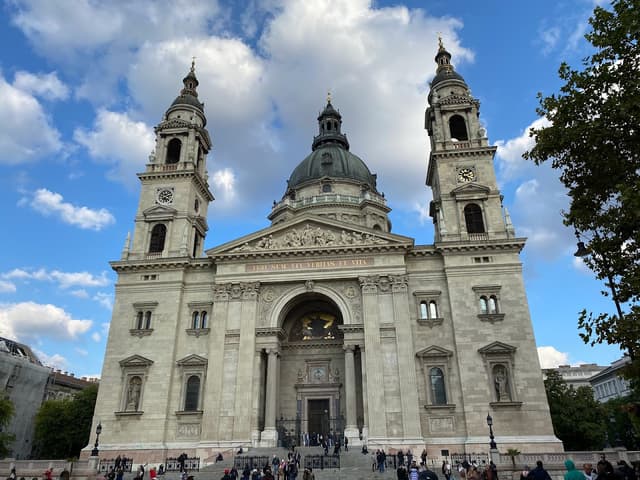
St. Stephen's Basilica
@pedralexpereira
The Basilica of St. Stephen, or Szent István Bazilika, is a monumental church in Budapest, dedicated to the first King of Hungary, Saint Stephen. It is the largest church in Budapest and the third largest in Hungary, notable for its grand neo-Renaissance style, its immense dome, and its historical significance. The church was constructed over more than five decades, from 1851 to 1905, initially designed by József Hild in a neo-classical style. After Hild's death, Miklós Ybl took over the project and altered the design, which was later completed by József Kauser.
The church stands at a height of 96 meters, matching the height of the Hungarian Parliament, symbolizing the equal importance of both spiritual and worldly matters. The basilica is a prominent landmark in Budapest's UNESCO World Heritage Site Buffer Zone and remains a central point of religious and cultural life in Hungary. Its design includes a Greek cross ground plan, a mosaic of Christ on the Throne above the main entrance, and rich decorations inside, including mosaics by renowned artists like Mór Than and Gyula Benczúr.
The basilica's largest bell, the Great St. Stephen Bell, is the largest in Hungary, weighing over 9 tons. The church is also home to the mummified right hand of King Stephen, preserved in a reliquary, making it a significant site for pilgrims. The church suffered damage during World War II but has been restored, continuing to serve as both a religious site and a tourist destination.

Details
Unitarian Church
@pedralexpereira
This Protestant church was constructed between 1786 and 1793. It is the home of the Unitarian community in Budapest, which is part of the larger Unitarian Church in Transylvania and Hungary, a Christian denomination that emerged from the Reformation.
The church's architecture is a mix of neo-Classical and Baroque elements, featuring a symmetrical facade with large columns and a grand entrance. The interior is spacious and simple, with a focus on the congregation and the sermon rather than ornate decorations. It houses beautiful woodwork, including pews, a pulpit, and gallery. The church is known for its peaceful atmosphere and is an important center for the Hungarian Unitarian community.

Details
Green and open spaces

Vigadó tér
@pedralexpereira
Vigadó tér is a public square in the heart of Budapest, located near the Danube River on the Pest side of the city. The square is named after the nearby Vigadó Concert Hall, a landmark building and one of Budapest’s major cultural venues. Vigadó tér is a lively area that offers a scenic view of the river and the Buda hills, with the beautiful Danube promenade running alongside it.
The square is a popular spot for both locals and tourists, surrounded by various cafes, shops, and historical buildings. The Vigadó Concert Hall, which gives the square its name, is a notable feature, often hosting classical music concerts, cultural events, and social gatherings. The architecture of the Vigadó building is in a neo-Renaissance style, with intricate details and a grand façade, making it a key landmark of Budapest's cultural heritage.
In addition to its cultural significance, Vigadó tér offers a pleasant environment for relaxation and is a great place to enjoy the picturesque views of the Danube, including the majestic Hungarian Parliament building just across the river.

Details

Elizabeth Square
@pedralexpereira
Erzsébet Square, named in honor of Empress Elisabeth of Bavaria (Sisi), the wife of Emperor Franz Joseph of Austria-Hungary, has evolved significantly over the centuries. The area surrounding the square began to be developed in the 18th century, and by the late 19th century, it became home to many striking buildings, especially financial institutions and ministries. These buildings were designed to rival palaces in terms of grandeur. Before its urbanization, the site was used as a cemetery, which was eventually abolished as the city expanded. A park was created in its place, often hosting fairs.
In 1858, the square was officially renamed Erzsébet tér in honor of Empress Sisi. During the socialist era, it was temporarily renamed Stalin Square (1946-1953) and later Engels Square (1953-1990), before returning to its original name after the fall of socialism in 1990.
Today, Erzsébet Square is a vibrant, multi-purpose space. It features a small playground, a skate park, and the "Budapest Eye" Ferris wheel, a modern landmark of the square. Near the Ferris wheel is a souvenir shop, and on the southwestern edge, there’s a memorial dedicated to Michael Jackson. In the eastern part of the square is the Akvárium nightclub, which has an innovative roof design featuring modern fountains with transparent bottoms.
At the heart of the park is the Danubius Fountain, designed by architect Miklós Ybl in 1883. The fountain was relocated here in 1959 and is topped with a statue of Neptune, symbolizing the Danube River. Beneath it are three female figures representing the major tributaries of the Danube: the Tisza, Drava, and Sava rivers. This historic fountain, along with the surrounding attractions

Details
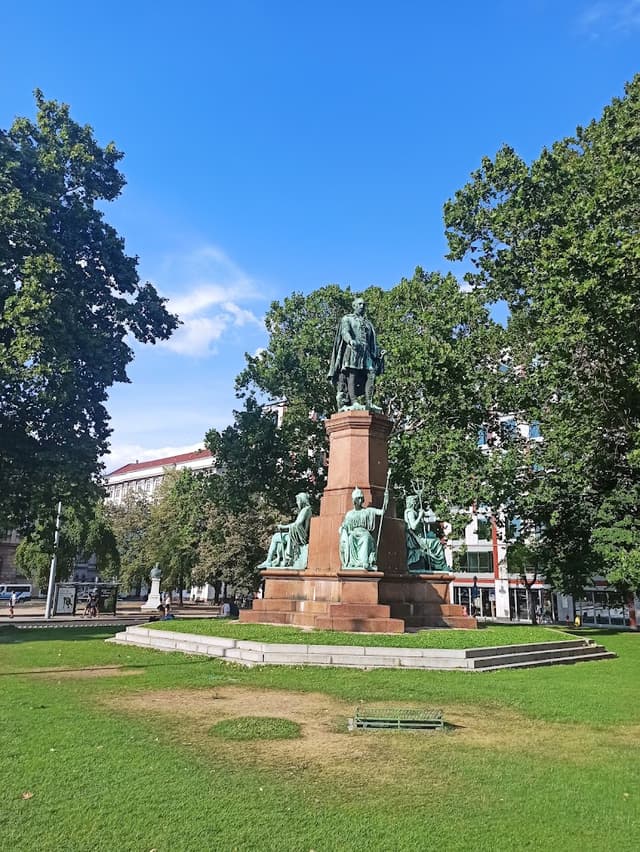
Stephen Széchenyi Square
@pedralexpereira
Széchenyi István Square is a significant and picturesque area located in the heart of Budapest, named after Count István Széchenyi, one of Hungary's most influential reformers and a key figure in the country's modernization during the 19th century. The square's history is tied to the city's development, with the construction of important landmarks and infrastructure shaping its character.
One of the most iconic features of Széchenyi Square is the Széchenyi Chain Bridge, which connects the Buda and Pest sides of the city, offering stunning views of the Danube River. The square is also home to the famous Gresham Palace, an early 20th-century Art Nouveau building that now houses a luxury hotel. These grand structures contribute to the square's elegant atmosphere and make it a popular spot for both locals and tourists.
Széchenyi Square also serves as a key public space, often hosting cultural events, outdoor performances, and gatherings. With its blend of historical significance, architectural beauty, and modern amenities, Széchenyi István Square remains an important focal point in Budapest's cityscape.

Details

Liberty Square
@pedralexpereira
Széchenyi István Square is a diverse area that blends business and residential elements, with a mix of architectural styles and significant historical landmarks. Situated in the heart of Budapest, it is bordered by notable structures, including the United States Embassy and the headquarters of the Hungarian National Bank, which is designed in a historicist style. Several buildings on the square are designed in the Art Nouveau style, with some works by renowned architect Ignác Alpár.
The square is home to several important monuments. One of the most prominent is a statue of Ronald Reagan, reflecting Hungary’s appreciation for the former U.S. president’s role in ending the Cold War. Also located in the square is a monument to Harry Hill Bandholtz, an American army officer, and a sculpture commemorating the Soviet liberation of Hungary during World War II. In 2020, a statue of U.S. President George H. W. Bush was unveiled, further cementing the square's connection to international figures.
A controversial monument in the square is the Memorial for Victims of the German Occupation, which portrays Hungary as an angel attacked by a German eagle. Critics argue that this symbolism glosses over Hungary's active role in the Holocaust. In response, a counter-monument was installed in 2014, featuring photos of Hungarian Holocaust victims who were deported to Auschwitz.
Historically, the square occupies the site of the former barrack-prison "Újépület," where Hungarian Prime Minister Lajos Batthyány was executed in 1849 after the failed Hungarian Revolution. The original building was demolished in 1897, and the square was developed in its place. Today, Széchenyi István Square is an important location in Budapest, marked by its rich history, diverse monuments, and architectural beauty.

Details
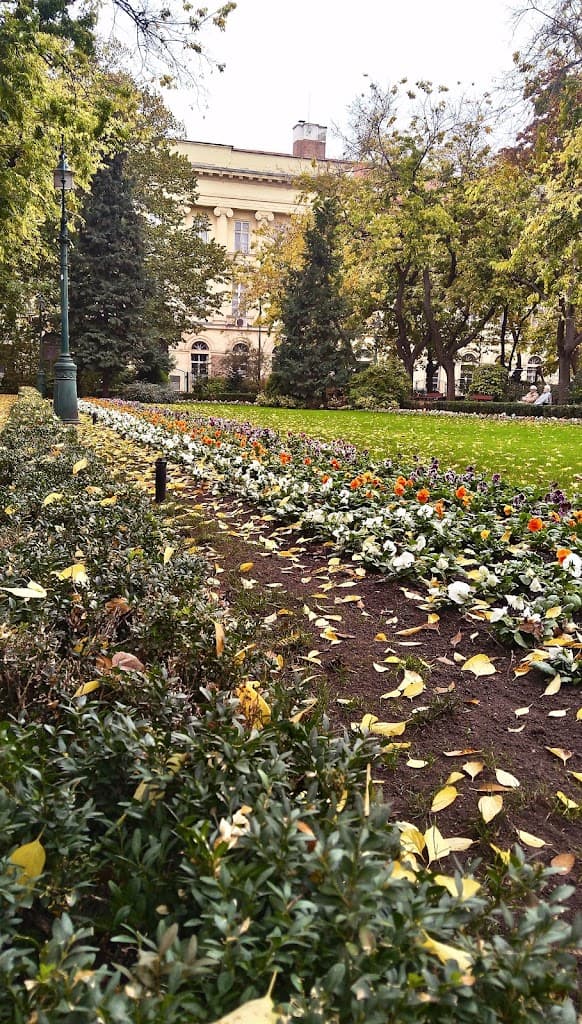
Honvéd tér
@pedralexpereira
The square is named after the Hungarian Honvéd Army, which fought during Hungary's War of Independence in 1848-1849. One of its most prominent features is the Kossuth Memorial, which honors the Hungarian revolutionary and statesman Lajos Kossuth, a key figure during the 1848 revolution. The memorial was erected in the early 20th century, and it remains a symbol of Hungarian patriotism and independence.
Adjacent to the square is the Hungarian National Museum, an important cultural institution showcasing Hungary’s history and heritage. Honvéd Square itself is located near a major traffic intersection and features a mix of residential and commercial buildings, providing a vibrant atmosphere. Its proximity to Budapest's downtown area makes it a popular spot for locals and tourists alike.
The square has been the site of various cultural and political events, and its monuments, including those commemorating the sacrifices of Hungarian soldiers, reflect the country’s complex history and national pride. The Honvéd Monument, dedicated to the soldiers of the Honvéd Army, is another notable feature of the square, paying tribute to the bravery and sacrifices of those who fought for Hungary’s independence.
While the area has undergone various modern developments, Honvéd Square remains a significant landmark in Budapest, offering a blend of historical reflection and contemporary life.

Details
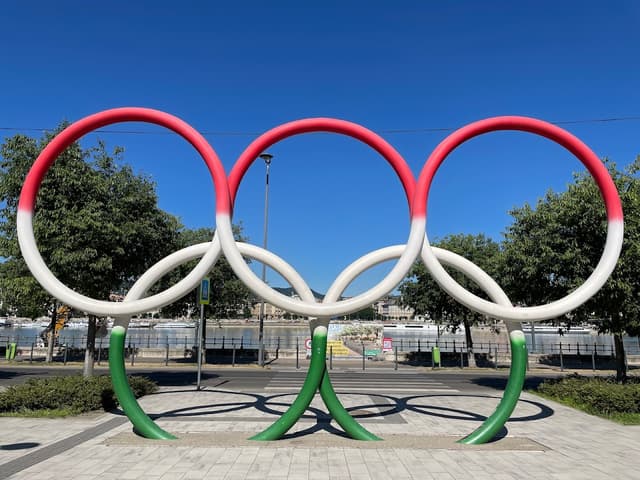
Olimpia Park
@pedralexpereira
Olimpia Park (Olimpia Park) is a public park located in the 14th district of Budapest, Hungary. It is named in commemoration of the Olympic Games, reflecting Budapest's historical connection to international sporting events. The park itself is not only a space for recreation but also a symbol of Hungary's sporting culture.
The park is known for its well-maintained green spaces, playgrounds, and sports facilities, making it a popular destination for both locals and visitors. There are areas for walking, jogging, and cycling, as well as open spaces used for various recreational activities. Olimpia Park is often used by families, athletes, and anyone looking for a peaceful retreat within the city.
One of the key features of the park is its proximity to the Puskás Aréna, a large stadium named after legendary Hungarian footballer Ferenc Puskás. The stadium, which was opened in 2019, is used for football matches and other sporting events, further connecting the area to Hungary's sporting traditions.
Olimpia Park's central location and combination of green space and sporting facilities make it a vibrant area for residents and a relaxed environment for those enjoying the outdoors in Budapest.

Details
Újlipótváros
Újlipótváros is a lively and eclectic neighborhood located just north of Lipótváros, on the Pest side of Budapest. Often referred to as "New Leopold Town," the district developed in the early 20th century and became one of the city’s most desirable residential areas. Unlike the stately grandeur of nearby Lipótváros, Újlipótváros boasts a more bohemian and artistic flair, attracting a vibrant mix of locals and expatriates. Its tree-lined streets are home to a blend of elegant modernist architecture, interspersed with lively cafes, independent shops, and local markets, contributing to the neighborhood’s unique charm.
Historically, Újlipótváros began as a fashionable residential area in the early 1900s, with many buildings reflecting the early 20th-century Budapest style, including Bauhaus influences and Art Deco elements. It has maintained its reputation as an artistic and cultural hub, offering an atmosphere that's both creative and relaxed. One of its most famous landmarks is the Március 15. tér, a popular square that regularly hosts local events and offers a great place to relax or enjoy a coffee. The neighborhood is also home to the Vígszínház, one of Hungary’s oldest and most respected theaters, contributing to the area’s artistic vibe. In recent years, Újlipótváros has gained recognition for its vibrant community, trendy bars, and unique dining spots, making it an ideal destination for those seeking a blend of culture, creativity, and urban energy.
See&Do

Jászai Mari Square
@pedralexpereira
It has always been possible to cross the Danube at Mari Square in Jásza: the square once housed the village of Révjenő, with its eloquent name, which was destroyed by the Turks. However, the people living here had to wait a long time for the bridge. When the Margaret Bridge was finally opened in 1876, the Vasárnapi Újság celebrated: “Last Sunday, the Margaret Bridge, which was opened to public use at the end of February, was solemnly opened, and which has been a huge and at the same time an elegant link connecting the two banks of the capital for centuries. The significance of the monumental structure is best illustrated by the fact that, in addition to the Chain Bridge, a second permanent bridge now connects the parts of Hungary divided by the Danube.” However, many more years passed after the ceremonial inauguration of the bridge before the area around the Pest bridgehead was also landscaped and landscaped, and in the 1930s, the plane trees that still provide shade were added to the square. Budapest's new square was named after the tragically deceased Crown Prince Rudolf, son of Emperor Franz Joseph and Queen Elisabeth, and then renamed Leiningen, presumably in memory of one of the martyrs of Arad, Charles Leiningen-Westenburg. However, the story did not end there, the name-givers soon changed their minds again: from 1919 the square bore the name Rudolf again, which was soon changed to Crown Prince Rudolf for emphasis. Since 1950, it has been persistently and unwaveringly called Jászai Mari Square, after the famous actress who went from being a rascal to one of the most well-known artists in Hungarian theatre history, and one of the few Hungarian women to have a public square named after her.

Details
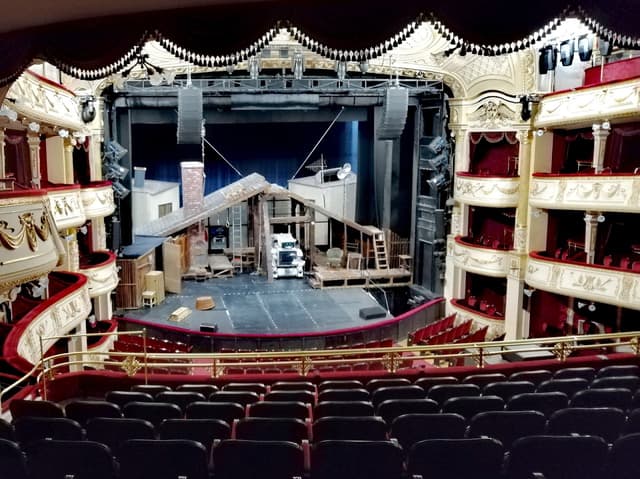
Vígszínház
@pedralexpereira
The Comedy Theatre of Budapest, known as Vígszínház, stands as one of the city's oldest and most esteemed theatres. Established at the turn of the 19th and 20th centuries as a modern counterpoint to the conservative National Theatre, it quickly became a trailblazer in Hungarian drama and a cornerstone of Budapest's cultural life.
Designed by Ferdinand Fellner and Hermann Helmer, renowned architects who created over 47 prominent theatres across Europe, Vígszínház was constructed on what was once a swampland. This area soon transformed into the upscale Lipótváros district. Financing for the project came from Count István Keglevich, writer Ferenc Szécsi, and businessman Gábor Faludi. Construction began in 1895 and was completed within a year, opening its doors on May 1, 1896. The building’s design, a prime example of late historicism, features grand baroque decorations with gold accents, three rows of box seats, spacious corridors, and wide staircases to accommodate the burgeoning social scene of the era. Its structure comprises three main sections: the stage, audience seating, and the entrance hall.
Mór Ditrói, the theatre's first director, brought a fresh vision from Kolozsvár (present-day Cluj-Napoca) along with a group of young, relatively unknown actors. Their innovative approach diverged from the classical theatrical traditions of the time, introducing French comedies, contemporary Hungarian works by writers like Ferenc Molnár and Sándor Bródy, and international dramas by figures such as Anton Chekhov and Bertolt Brecht. Vígszínház became a launching pad for theatrical legends like Gyula Csortos, Lili Darvas, and Klári Tolnay.
Vígszínház faced adversity during World War II when it was bombed on January 1, 1945, forcing the company to relocate temporarily to the Radius Movie Theatre on Nagymező Street. Restoration began under the guidance of Oszkár Kaufmann. In 1949, the theatre was nationalized and reopened in 1951 as the Theatre of the People's Army, before regaining its original name in 1960. From that point, it reestablished itself as a hub for contemporary Hungarian and international drama, presenting works by Arthur Miller, Friedrich Dürrenmatt, and celebrated Hungarian playwrights like István Örkény. In 1973, Vígszínház premiered *An Imaginary Report on an American Rock Festival,* which ushered in a tradition of musical productions led by Gábor Presser.
Despite nationalization and various challenges, Vígszínház has remained a vital part of Budapest's theatrical scene, selling approximately 350,000 tickets annually. The building underwent a major renovation in 1994, ensuring its architectural splendor continues to captivate audiences today.

Details
Flippermúzeum
@pedralexpereira
The Budapest Pinball Museum is a haven for gaming enthusiasts and a remarkable showcase of pinball history, boasting over 160 machines, including pinball, arcade video cabinets, and other interactive games. As one of the largest ongoing collections in Europe, the museum offers an immersive experience where all machines are set to free play, allowing visitors to enjoy hours of entertainment.
Among the collection are rare and antique pieces that highlight the evolution of pinball. Notable items include the first pinball machines equipped with flippers, introduced in 1947, and predecessors of modern pinball, such as intricate bagatelles from the 1880s. These early designs demonstrate the mechanical ingenuity that laid the foundation for today’s games.

Details
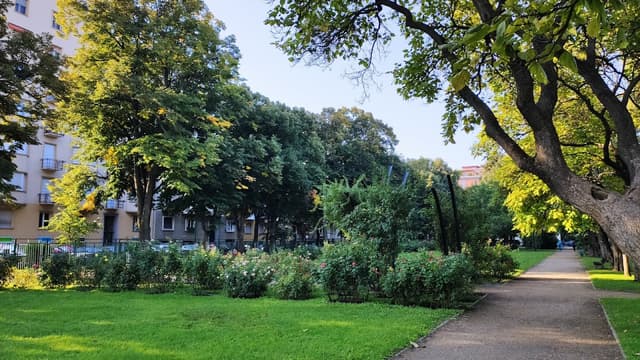
Szent István Park
@pedralexpereira
Szent István Park, a beloved urban retreat, lies along the Danube embankment and offers breathtaking views of Margaret Island and the Buda Hills. Opened in 1928 on the site of a former parquet factory, it was originally known as Lipótvárosi Park. The park’s historical significance is highlighted by its statue of Raoul Wallenberg, the Swedish diplomat who heroically saved tens of thousands of Jews from the Nazis, many from the surrounding area.
The park is a vibrant spot during fine weather, hosting events and concerts. Its lush greenery and peaceful pathways make it ideal for romantic strolls, picnics, or leisurely dog walks. Surrounding the park are elegant Bauhaus buildings, notable for housing Budapest's first penthouse apartments.
Adding to the charm is the Dunapark Café, which has been a fixture since 1938. Styled to resemble a luxury liner, it invites visitors to enjoy its timeless ambiance, making it the perfect complement to a relaxing day in the park.

Details
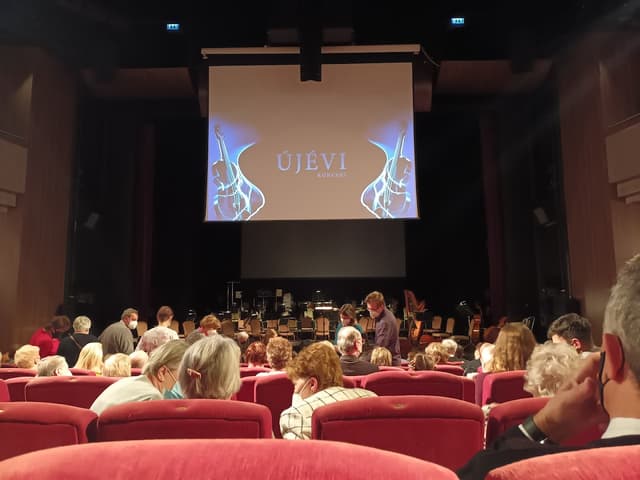
RaM-ArT Színház
@pedralexpereira
The RaM-ArT Theatre, located in Budapest, is a dynamic cultural venue offering a mix of contemporary performances, including musicals, dance productions, concerts, and theatrical plays. Known for its modern facilities and vibrant programming, the theatre is a hub for innovative performances that appeal to a broad audience.
The building itself reflects a modern architectural style, equipped with advanced sound and lighting systems that enhance the viewing experience. It regularly hosts local and international productions, emphasizing collaboration and diversity in the performing arts. The venue also serves as a community space, offering workshops, cultural events, and educational programs that engage people of all ages.
RaM-ArT Theatre is celebrated for its accessibility and welcoming atmosphere, making it a popular choice for families, tourists, and Budapest residents alike. Its location provides convenient access to nearby restaurants and cafés, allowing visitors to enjoy a full cultural outing in the city.

Details
Margaret Island
Margaret Island (Margitsziget) is a peaceful green oasis located in the heart of the Danube River, between the Buda and Pest sides of Budapest. Known for its tranquil atmosphere and recreational facilities, the island is a favorite escape for locals and tourists alike, offering a refreshing contrast to the city’s hustle and bustle. Historically, Margaret Island was named after Princess Margaret, the daughter of King Béla IV of Hungary, who lived as a nun at the Dominican convent on the island in the 13th century. Her name is immortalized in both the island’s name and the Margaret Island Monastery, remnants of which can still be seen today.
The island is home to a number of beautiful parks, walking paths, and gardens, making it an ideal spot for outdoor activities such as jogging, cycling, and picnicking. One of its most notable attractions is the Musical Fountain, which hosts light and music shows in the evenings, drawing crowds with its stunning performances. Margaret Island is also home to the Palatinus Baths, a large complex with thermal pools, outdoor swimming areas, and saunas, making it a great place to relax. Visitors can explore the Japanese Garden, enjoy the ruins of a medieval monastery, or simply stroll along the riverbanks for picturesque views of the city. In addition to its historical and natural beauty, the island is also home to the Margaret Island Hotel and a number of sports facilities, including a running track and tennis courts. Despite being located in the center of Budapest, Margaret Island offers a quiet and serene environment, making it a perfect spot for relaxation, recreation, and a little respite from the city.
See&Do
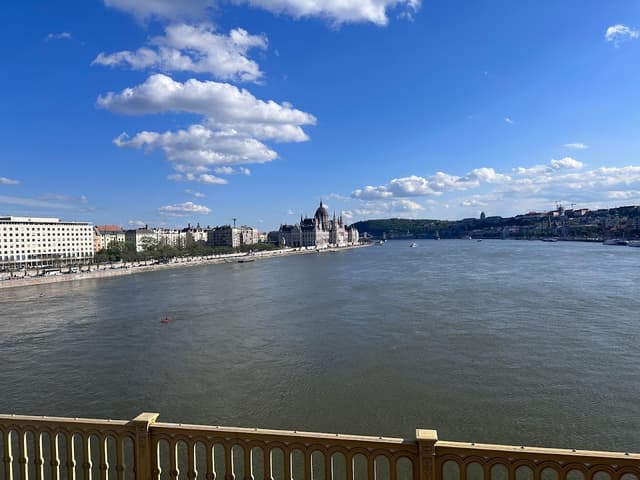
Margit Bridge
@pedralexpereira
Margaret Bridge, or Margit híd, is a three-way structure spanning the Danube River in Budapest. Connecting the city’s Buda and Pest sides, it also provides access to Margaret Island, making it a unique architectural feature in the Hungarian capital. This second-oldest bridge in Budapest was designed by French engineer Ernest Goüin and constructed between 1872 and 1876 by the Maison Ernest Goüin et Cie company, with Émile Nouguier overseeing the project. The design includes an unusual 165-degree angle to accommodate the link to Margaret Island, a later addition implemented two decades after the main structure was completed.
The bridge witnessed significant damage during World War II. In November 1944, an accidental explosion—triggered prematurely by a tram spark—destroyed the eastern span, resulting in the tragic loss of hundreds of lives, including civilians, soldiers, and Jewish forced laborers. The bridge was further devastated in January 1945 when retreating German forces demolished all of Budapest's Danube crossings. Reconstruction efforts salvaged much of the original steel, preserving its historic essence.
By the early 2000s, the bridge's deteriorated state necessitated extensive restoration. The renovation began in 2009 and concluded in 2011, funded partially by the European Union. The work involved structural updates, including durable steel replacements, widened lanes, expanded sidewalks, and the addition of bike paths, while striving to restore its 19th-century aesthetic.
During the restoration, human remains were unearthed, revealing victims of the Arrow Cross Party’s wartime atrocities. This dark history adds to the bridge's poignant legacy, which inspired Hungarian poet János Arany’s ballad "Híd-avatás" ("Bridge Inauguration"), capturing the emotional weight of its history.

Details
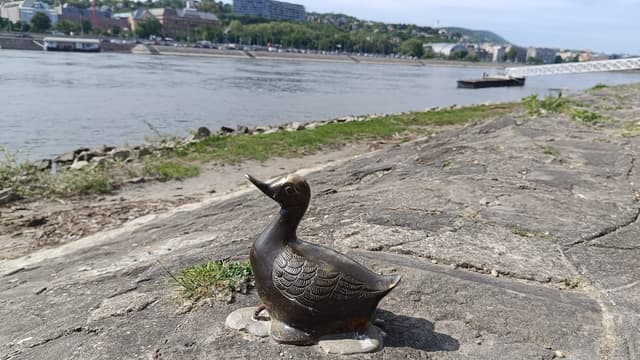
Golden Duck
@pedralexpereira
The Golden Duck statue, located on Margaret Island in Budapest, is a charming yet often overlooked feature of this serene retreat. Nestled amidst the island's lush greenery and recreational spaces, the sculpture pays homage to a local legend that has enchanted generations of Hungarians.
The story of the Golden Duck revolves around a magical duck said to inhabit the waters near the island. According to the tale, this mystical creature could lay golden eggs, symbolizing prosperity and good fortune. While the legend's origins are shrouded in mystery, it has become a beloved part of Budapest’s folklore, embodying themes of luck and whimsy.
The statue itself captures the essence of the legend, with its golden hue reflecting sunlight and drawing the attention of passersby. Its location on Margaret Island, a popular spot for leisurely strolls, picnics, and family outings, adds to its appeal, making it a delightful find for those exploring the island’s gardens and historical landmarks.

Details
Centenary Monument
@pedralexpereira
This striking monument, located in a flower-filled roundabout just 350 meters north of the Margaret Bridge tram stop on Margaret Island, is a unique relic of Budapest’s past. Unveiled in 1973 to commemorate the 100th anniversary of the unification of Buda, Pest, and Óbuda into a single city, it reflects the artistic and ideological currents of its era.
The sculpture, often interpreted as a split cone or hatched egg, is filled with intricate socialist and nationalist motifs that encapsulate the spirit of its time. These symbols provide a glimpse into the values and narratives that shaped Budapest during the late 20th century, making the monument feel like a tangible time capsule.
While its design may seem unusual or even puzzling to contemporary viewers, the monument stands as a fascinating testament to the city's layered history, offering a blend of artistic curiosity and historical reflection amidst the tranquil beauty of Margaret Island.

Details
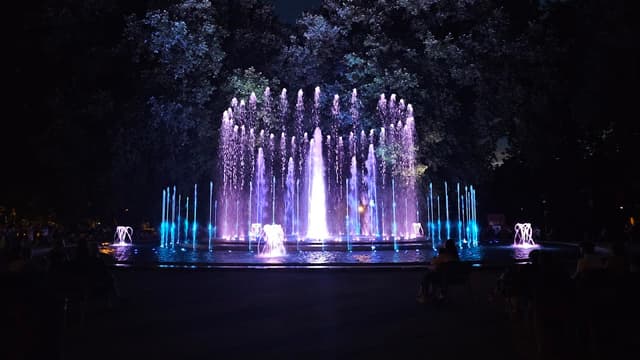
Zenéló szökőkút
@pedralexpereira
The Margaret Island Fountain is a grand spectacle, celebrated as one of the largest musical fountains in Hungary and Europe. With a 36-meter diameter, a pool capable of storing 400 cubic meters of water, and a water surface exceeding 10,000 square meters, it draws visitors to its vibrant displays. Originally inaugurated in 1962, the fountain offered live music performances to entertain its audience. Over time, it fell into disrepair, leading to a minor renovation in 1999 and a major overhaul in 2013, which brought it to its current impressive form.
The fountain features 154 nozzles that create dynamic water formations, with the central jet reaching an awe-inspiring height of 25 meters. In the evenings, the fountain dazzles visitors with synchronized light shows and short films projected onto a water curtain, adding a magical touch to its musical displays. It traditionally operates from May 1st to October 31st each year, marking the warmer months with its rhythmic charm.
During recent flood protection efforts, the fountain's mechanical components were removed and safely stored to prevent damage. As these repairs align with its annual seasonal shutdown, the fountain will remain dormant for the remainder of the year. Visitors can look forward to its full reactivation on May 1st, 2025, when it will once again captivate audiences with its mesmerizing performances.

Details
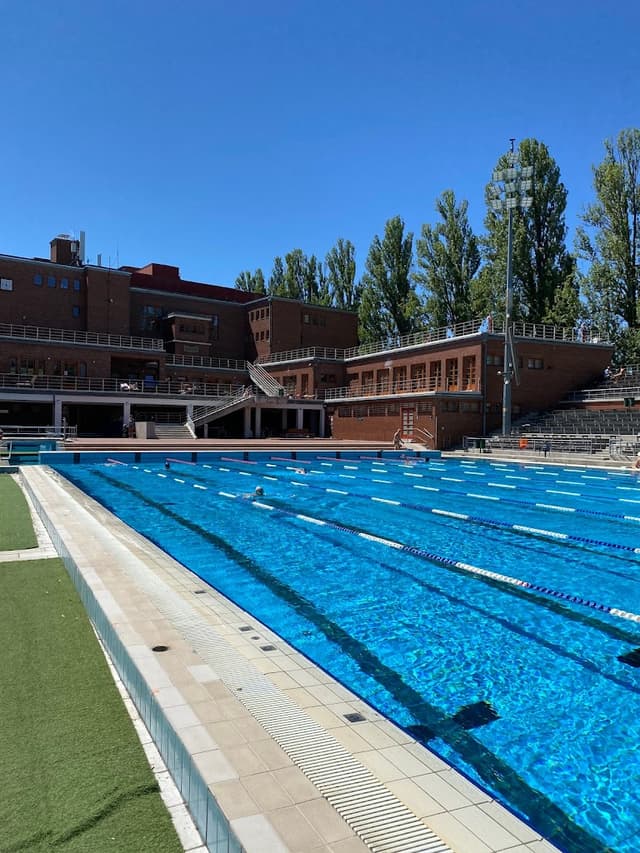
Alfred Hajos National Aquatics Complex
@pedralexpereira
The Alfred Hajos National Aquatics Complex is one of Budapest's premier sports and leisure facilities, located on the northern tip of Margaret Island. Named after the Hungarian swimmer and Olympic gold medalist Alfred Hajos, the complex plays a pivotal role in Hungary’s rich aquatic sports tradition. It was originally constructed to host the 2006 FINA World Swimming Championships, but its history dates back to 1930 when the first swimming complex was built on the island, which became a well-known location for aquatic events.
The modern Alfred Hajos complex consists of a large indoor swimming pool, an outdoor pool, and additional training facilities. It includes one of the largest open-air swimming pools in Europe, known for its Olympic-sized dimensions. The complex also hosts the Hungarian National Swimming Championships, international competitions, and serves as a training ground for athletes in disciplines such as swimming, water polo, and synchronized swimming.
Architecturally, the facility blends historical elements with contemporary design. The original outdoor pool is a classic, offering sweeping views of the Danube River and the surrounding greenery of Margaret Island. Visitors can enjoy the pool’s scenic surroundings, making it a popular spot for both athletes and those seeking leisure in the heart of the city.
The complex also offers a range of wellness and fitness services, including saunas, fitness rooms, and a variety of water-based activities such as aqua aerobics. The Alfred Hajos National Aquatics Complex is not only a hub for competitive aquatic sports but also a beloved destination for recreation and relaxation, drawing locals and tourists alike.

Details
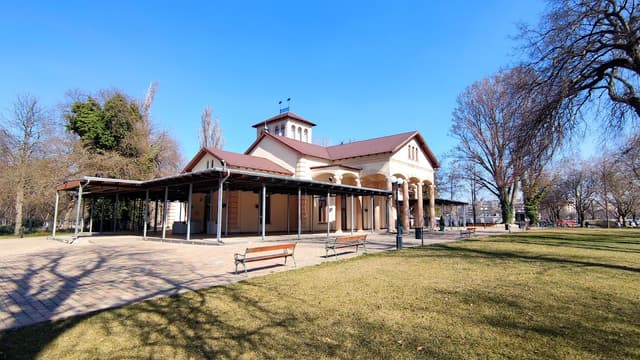
Holdudvar Event Venue
@pedralexpereira
Holdudvar Rendezvényhelyszín, located in the heart of Budapest, is a unique event venue known for its distinctive atmosphere and versatile spaces. Set along the Danube River, it offers stunning views of the water and the city’s skyline, making it an ideal setting for a wide range of events, from weddings and corporate gatherings to concerts and private parties.
The venue is designed with both indoor and outdoor spaces that can be adapted to various types of events. Its modern and stylish interiors, combined with outdoor terraces, provide a comfortable and visually appealing backdrop for any occasion. The most striking feature of Holdudvar is its open-air courtyard, which is perfect for enjoying warm summer nights, offering a relaxed yet sophisticated vibe.
Holdudvar is also known for its excellent catering services, providing a variety of menu options to suit different tastes and event types. Whether hosting a formal gala or a casual celebration, the venue ensures a high-quality experience with a personalized touch.
In addition to its aesthetic charm, Holdudvar’s prime location allows easy access to nearby Budapest attractions, making it a convenient choice for both locals and international guests. It is particularly popular for events that require a blend of elegance, accessibility, and a touch of the city's urban energy.

Details

Budapest Sign
@pedralexpereira
The Budapest Sign is a popular and iconic landmark located along the Danube River, typically positioned near key tourist attractions in the city. It is a large, modern sign featuring the name "Budapest" in bold, capital letters, making it a favorite spot for visitors to take photos and capture their memories in the Hungarian capital. The sign serves as a symbol of the city’s rich cultural heritage and its vibrant urban environment, becoming an essential part of Budapest's tourist experience.
Often found in prominent locations such as near the Széchenyi Chain Bridge, Margaret Island, or other scenic spots along the riverbank, the Budapest Sign offers panoramic views of the city's stunning architecture, including landmarks like the Parliament Building and Buda Castle. This spot is especially popular for selfies and group photos, with the Budapest skyline in the background.
The sign's design is minimalistic yet impactful, blending modernity with the historic charm of the city. It attracts tourists from around the world, contributing to Budapest's reputation as a must-visit European destination.

Details
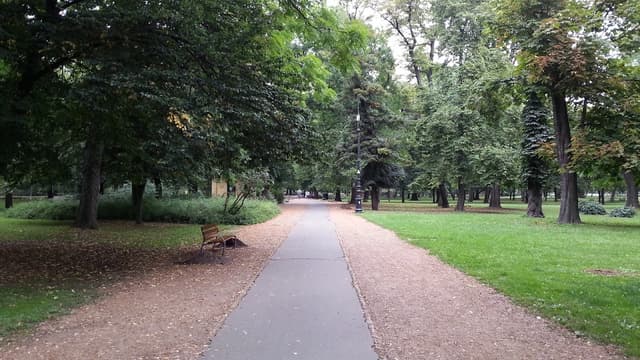
Gulliver Park
@pedralexpereira
Gulliver Park in Budapest is a unique, whimsical outdoor space that draws inspiration from the famous novel *Gulliver's Travels* by Jonathan Swift. The park is located in the city center, providing a playful and imaginative environment where visitors can engage with oversized, interactive sculptures that are reminiscent of the story’s fantastical elements. The park's most striking feature is a series of large, life-sized figures that depict the character of Gulliver in various poses and settings, offering both a fun and surreal experience for people of all ages.
One of the key attractions is a giant, reclining Gulliver figure, which allows visitors to sit on or around the sculpture, creating opportunities for creative and humorous photos. The park features additional oversized items, such as oversized books and furniture, that fit the theme of a miniature world in which the characters of the novel come to life.
Gulliver Park is popular for families and tourists who want to explore a playful side of Budapest, offering a different kind of experience compared to the city’s more traditional landmarks. It is a free-to-visit park that also provides a relaxed and peaceful atmosphere, making it a good spot for a casual outing. The location is well-maintained, with green spaces perfect for a leisurely stroll or a short rest, allowing visitors to escape the hustle and bustle of Budapest’s busy streets.

Details

Lumina Park Budapest
@pedralexpereira
Lumina Park, located at Palatinus Beach on Margaret Island in Budapest, is a mesmerizing light park that offers a truly magical experience, especially during the winter months. Created by the renowned light installation company Multidekor, Lumina Park has become one of the city’s top winter attractions, enchanting visitors with its stunning visual displays. The park is a celebration of lights, transforming the space into a fantasy world with installations that harmonize perfectly with Budapest’s landscape.
Inspired by the city’s rich cultural and historical heritage, the lights in Lumina Park reflect elements of Hungarian legends, nature, and iconic architecture. One of the standout features of the park is a glowing DeLorean, which adds a playful nod to time travel, symbolizing a connection to the past. As visitors stroll through the park, they encounter a variety of light displays that capture the essence of Hungarian folklore and the city’s architectural beauty, making the experience both whimsical and culturally significant.
Beyond its captivating visual appeal, Lumina Park is designed with sustainability in mind. Every installation created by Multidekor is energy-efficient and environmentally friendly, ensuring that the park not only dazzles visitors but also promotes eco-consciousness. The park has become a popular winter destination for both locals and tourists, offering an enchanting atmosphere that fosters a sense of community and wonder. Whether it's a romantic stroll or a family outing, Lumina Park creates lasting memories in a setting full of light and imagination.

Details
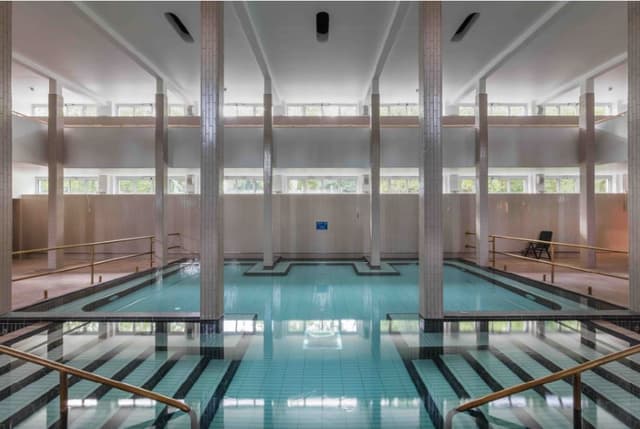
Palatinus Strand Baths
@pedralexpereira
Palatinus Baths features a variety of amenities, including saunas, steam rooms, water slides, and in-pool massage equipment. There are also playgrounds, football courts, and a fitness center, ensuring that visitors of all ages can enjoy their time at the facility. The large outdoor spaces, along with a dedicated children's pool, make the complex particularly ideal for families. While the thermal baths in Budapest are often designed for adults, Palatinus is specifically built with families in mind, offering a wide range of activities for children while also catering to adults seeking spa treatments and relaxation. Palatinus Baths is open daily from 9 am to 4 pm during the winter months (beginning on October 25, 2024). The cashier counters close one hour before the facility shuts, and guests must vacate the pool areas 20 minutes before closing time. The baths are located in the middle of Margaret Island, so you can also take time to explore the island before or after your visit. Ticket prices are €19 for adults, €15 for children aged 2-14 years, free for children aged 0-3 years, and €15 for seniors aged 66-99 years. A swim cap is required for the swimming pools, and children under 14 may only use the thermal pools with a medical prescription. In winter, the outdoor pools can be accessed via a heated corridor, allowing year-round enjoyment. Palatinus Baths first opened in 1919 and underwent expansion shortly after its opening. In 1921, the baths were handed over with larger pools and additional hot and cold water features. In the late 1930s, the baths were further expanded with the addition of a wave pool, which is still in operation today, almost 100 years later. After World War II, the bathhouse was restored in 1958, with a 10,000-square-foot grassy sunbathing area added to the beach. In the 1970s, the area expanded again by 18,000 square meters, adding playgrounds, football courts, and additional seating areas. Palatinus Baths remains one of the most beloved destinations for families in Budapest, offering a mix of history, relaxation, and fun activities in a beautiful and peaceful setting.

Details

Rose Garden
@pedralexpereira
The rehabilitation of the park included the addition of a new rose garden, which now features over 1,500 plants, recreating the romantic atmosphere reminiscent of Budapest's Golden Age. This garden, with its vibrant colors and fragrances, serves as a tribute to the cultural and historical significance of roses, which have been cherished for centuries.
Roses have a deep cultural history, with their cultivation and admiration stretching back over a thousand years. While roses have been loved in China for over a millennium, the first notable rose garden was established by Empress Josephine, the wife of Napoleon I, at her Malmaison residence in France between 1799 and 1814. Empress Josephine was known for funding numerous plant-collecting expeditions, helping to popularize roses in Europe.
In Hungary, the first rose garden was planted in the 1810s near the Palatine’s summer residence on Margaret Island, thanks to Károly Tost, the Head Gardener of Palatine and Archduke Joseph. This garden was part of Hungary’s early embrace of rose cultivation, which has continued to thrive on the island.
Throughout history, roses have been admired not only for their beauty but also for their medicinal properties. In ancient cultures, including those of China, India, Egypt, and Greece, rose oil and rose water were used in traditional medicine. The ancient Greeks even referred to the rose as the "queen of flowers," a title that has endured. The rose's association with love and beauty is rooted in mythology, with stories such as the one where Aphrodite, the goddess of love, pricked herself on a thorn and stained the white rose red with her blood, making red roses a symbol of love.
The careful placement of the rose garden, with its optimal sun exposure, was crucial in selecting the best species of roses for the site. The variety of colors and species in the rose beds are complemented by other plantings around them, creating a harmonious and lively display that draws attention to their timeless beauty. The garden is not only a visual feast but also a testament to the cultural significance of roses across centuries.

Details
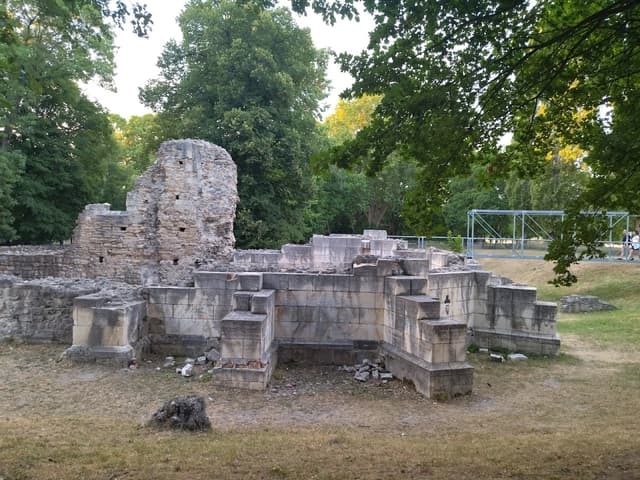
Medieval Dominican Convent and Royal Mansion
@pedralexpereira
Margaret Island (Margit-sziget) is a 225-acre teardrop-shaped island situated in the Danube River, right in the heart of Budapest. This peaceful green oasis is a favorite retreat for locals and tourists alike, offering a tranquil escape amidst the bustling city life. The island is named after Saint Margaret, the daughter of King Béla IV of Hungary.
According to legend, during the Mongol invasion of the 13th century, King Béla IV vowed to dedicate his daughter to a life of devotion in a convent if the Mongols were driven away and the city was spared. When the Mongols were defeated, Margaret entered the convent as promised.
Despite her beauty and the many royal suitors seeking her hand in marriage, including a Polish duke and King Ottokár II of Bohemia, Margaret refused all offers of marriage. She steadfastly chose to remain devoted to God, preferring a life of service in the convent over a life of royal luxury. By the age of 18, she had taken her vows, rejecting her father's plans to annul them so she could marry a king.
Margaret led a life of humility, performing menial tasks in the convent such as cleaning pots, scrubbing floors, and even cleaning latrines. She is said to have had the gift of performing miracles, including curing lepers and other healings. Her commitment to a life of asceticism and service earned her the admiration of many, and she was canonized as a saint in 1943.
Today, Margaret's memory is honored on the island. Her resting place, marked by a red marble sepulchre cover surrounded by a wrought-iron grille, is located within the ruins of a former church. It is a place of quiet reflection, often adorned with fresh flowers, and many visitors pause to pray here. Nearby, a brick shrine contains votives from people who attribute various favors or cures to St. Margaret’s intercession.
For those visiting the island, a metal structure near the ruins offers a fantastic viewpoint over the site, providing a scenic perspective of the historical ruins and the surrounding landscape. Margaret Island remains a place of historical and spiritual significance, with her story continuing to resonate deeply with the Hungarian people.

Details
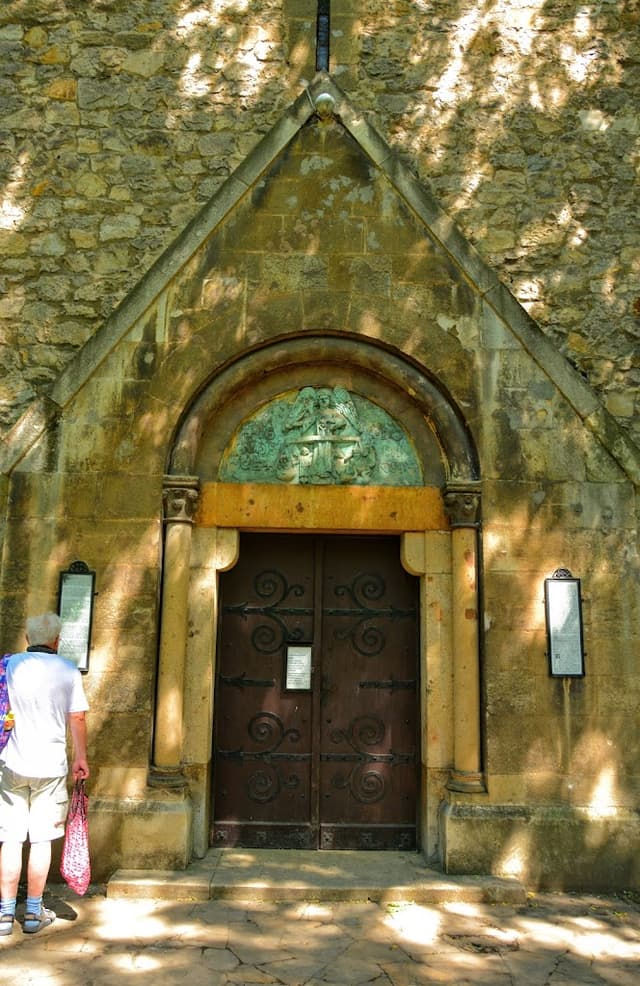
Saint Michael's Chapel
@pedralexpereira
The Premonstratensians, or the Order of Canons Regular of Prémontré arrived in Hungary soon after its founding, during the reign of King Stephen II between 1116 and 1131. The white canons remain active in Hungary today. The most notable structure connected to the order in Budapest is Saint Michael’s Chapel on the northern part of Margaret Island, which was reconstructed in the 1930s by the prominent Hungarian conservationist Kálmán Lux.
Monastic orders have played a crucial role in Budapest's history, influencing religion, culture, science, literature, and the fine arts. The city, with its rich and diverse monastic past, holds numerous traces of these religious communities. Margaret Island is particularly significant in this regard, home to the ruins of the Dominican convent where Saint Margaret once lived, a Franciscan church, and the remnants of the Premonstratensian Provostship of Archangel Saint Michael.
The Order of Premonstratensians was founded by Saint Norbert of Xanten in 1121 in Prémontré Valley, France. The order spread quickly to Hungary, with King Stephen II inviting them to settle in the country. By the time of the Mongol Invasion in 1241–1242, the Premonstratensians had established 24 monasteries, including the Provostship of Saint Michael on what is now Margaret Island. This small monastery prospered thanks to royal donations, including land from Kings Andrew II and Béla IV. However, the order’s influence began to decline with the founding of the Dominican nunnery, and they were eventually forced to leave the island after the Ottoman conquest of Buda in 1541.
The chapel and its surrounding buildings fell into ruin, and by the early 20th century, only the southwestern wall remained standing. In 1914, a storm on Margaret Island led to the discovery of a large, intact bell buried among the roots of a fallen tree. This event spurred archaeological excavations in the area, although progress was slow due to the outbreak of World War I. In the 1920s, the Budapest Public Works Council began restoring the site, including the chapel, under the direction of Kálmán Lux and other conservationists. Construction began in 1930, with the chapel being completed in 1932.
The restored chapel was consecrated by Prince Prelate Jusztinián György Serédi in September 1932. The ceremony was attended by notable figures, including Mrs. Miklós Horthy, the wife of the Hungarian governor, who had made significant financial contributions to the project. The chapel was placed under the care of the Óbuda-Újlak Parish, which was responsible for ensuring regular worship.
Today, Saint Michael’s Chapel stands as a remarkable example of Hungarian conservation, with its medieval-inspired architecture faithfully reconstructed by Kálmán Lux. The interior features stained glass windows by Dezső Kölber and sculptural works by Jenő Körmendi-Frim, including a bronze relief of the Last Judgment above the chapel’s entrance. The chapel's tower is adorned with the oldest bell in Budapest, a 15th-century bell discovered during the 1914 excavation. The bell, cast by Master János Strous, bears an inscription in German, invoking God’s help and the guidance of Mother Mary.

Details
Japanese Garden
@pedralexpereira
The Japanese garden on Margaret Island was established in 1882 and underwent renovations in 2014. It is a peaceful retreat, accessible via a charming wooden bridge. Inside the garden, visitors can find a serene waterfall, enhancing the tranquil atmosphere. At the center of the garden is a small pond, home to fish and turtles, surrounded by beautiful water lilies. In the middle of the pond stands a small statue, known as the Little Mermaid of Budapest, adding a whimsical touch to the picturesque setting.

Details
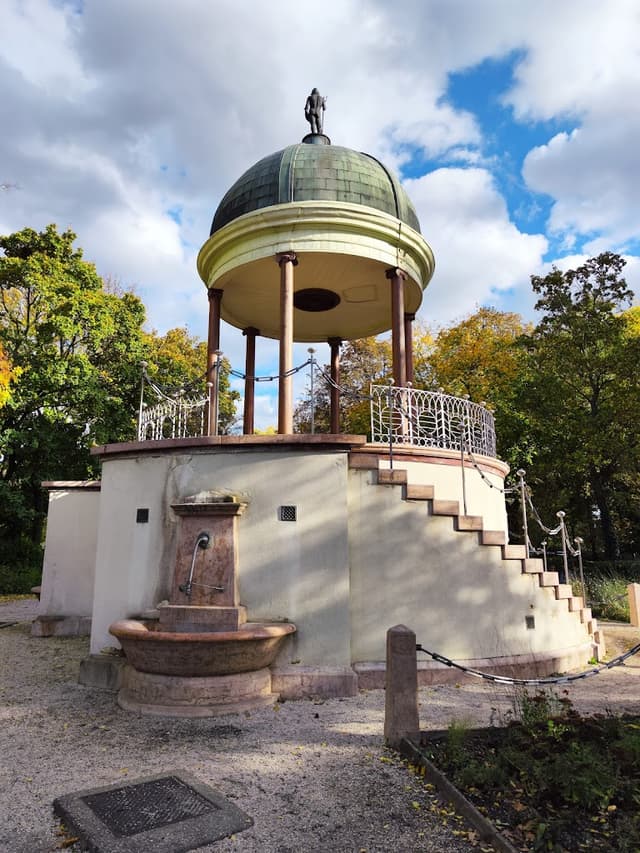
Musical Fountain
@pedralexpereira
From the History
In earlier times there was a bridge in the same area established by the Romans, it was connecting a fort and the old Roman settlement of Aquincum. There was a plan at the beginning of the 19th century, to create a new bridge named Árpád, however the tender was announced only in 1929.[1]
The original bridge
Construction began in 1939 by the plans of János Kossalka. It was planned to be named "Árpád Bridge" after Grand Prince Árpád,[2] the second Grand Prince of the Magyars.
Due to World War II, the bridge was finished only after the war in 1950. Because of the communist regime then ruling Hungary, the bridge was opened as Stalin Bridge (Hungarian: Sztálin híd).[2] The final construction works were directed by Károly Széchy and Pál Sávoly.
Although the pillars were built in their current dimensions, the original bridge contained only a 2x1 lane road, railroad tracks (for trams, but until the reconstruction of the Northern Rail Bridge the tracks were also used by cargo trains as well) with pedestrian paths. This bridge was 13 m (42.65 ft) wide, 11 meters (36 ft) of this was the road and the tracks, and an additional 1 m (3.28 ft) wide pedestrian path were on each sides. Today the tram tracks are where the original bridge was situated.
The name was changed back to Árpád Bridge in 1958.
Expansion
Between 1980 and 1984, by extensive reconstruction and expansion works, two more lanes were added for cars, the pedestrian pathways were widened, the tram track was modernized and overpasses were built for the intersections at both Eastern (Pest) and Western (Buda/Óbuda) ends of Árpád Bridge.
This was planned and executed in connection with the expansion of the adjacent Róbert Károly körút (further sections also called Hungária körút and Könyves Kálmán körút as well) to 2×3 lanes and double tramway tracks . The project was called Hungária körgyűrű (English: Hungária Beltway), although the last third of the belt (Könyves Kálmán körút) was finished only around the millennium, years after the completion of Lágymányosi Bridge at the other end of the planned beltway.

Details
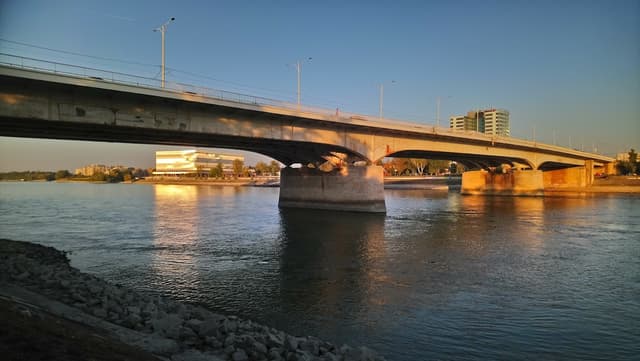
Árpád Bridge
@pedralexpereira
Spanning approximately 2 km, with the sections leading up to the bridge, or 928 meters without them, it was the longest bridge in Hungary until the inauguration of the Megyeri Bridge in 2008. The bridge is 35.3 meters wide and includes pedestrian and bicycle paths, as well as a tramline.
At its Óbuda end, Árpád Bridge reaches Flórián tér and Szentlélek tér, close to Óbuda's Main Square and museums like the Vasarely and Kassák Museums. The bridge also connects Margaret Island through an embankment in the middle of the structure. However, no road, pedestrian, or other connections exist between the bridge and Óbuda Island.
The Árpád híd metro station, located at the Pest end of the bridge, was previously named after the bridge until it was renamed on 31 January 2020.
Historically, this area has been the site of a Roman bridge connecting a fort and the settlement of Aquincum. In the early 19th century, there were plans to build a new bridge, but the tender for Árpád Bridge was not announced until 1929.
Construction of the original bridge began in 1939, designed by János Kossalka, and was intended to be named after Grand Prince Árpád, the second Grand Prince of the Magyars. Due to World War II, the bridge was not completed until 1950. Under the communist regime, it was initially named Stalin Bridge, though it was renamed to Árpád Bridge in 1958.
The original bridge was 13 meters wide, with a 2x1 lane road, tram tracks, and pedestrian paths. By the 1980s, the bridge underwent significant reconstruction and expansion, adding two lanes for cars, modernizing the tram tracks, and widening the pedestrian pathways. Overpasses were also constructed at both ends of the bridge, as part of the Hungária Beltway expansion project.

Details
Terézváros
Terézváros is a vibrant and diverse neighborhood located on the Pest side of Budapest, just west of the city center. Known for its lively atmosphere, cultural significance, and eclectic architecture, it has long been one of the city's most dynamic districts. Named after Queen Teresa of Austria, the wife of Emperor Leopold II, the area was developed in the mid-19th century as a fashionable residential quarter for the city's growing middle and upper classes. Over time, it has evolved into a hub for culture, business, and nightlife.
The architectural landscape of Terézváros is a blend of Classical, Neo-Renaissance, and Art Nouveau styles, with grand boulevards, ornate buildings, and beautiful mansions lining the streets. One of the district's main thoroughfares, Andrássy Avenue, a UNESCO World Heritage site, runs through Terézváros, offering a stunning display of historic buildings, upscale shops, and cultural institutions such as the Hungarian State Opera House and the House of Terror Museum, which chronicles Hungary’s tumultuous 20th-century history under fascist and communist regimes. The area also features a number of parks and squares, including the Liszt Ferenc Square, which is famous for its cafés, music venues, and vibrant cultural scene. Over the years, Terézváros has also become known for its bohemian atmosphere, with a mix of artistic venues, trendy bars, and a growing number of upscale restaurants. Despite its urban energy, the district retains a strong sense of its historic charm, balancing the old with the new and offering both locals and visitors a taste of Budapest’s lively cultural life.
Architecture and urban spaces
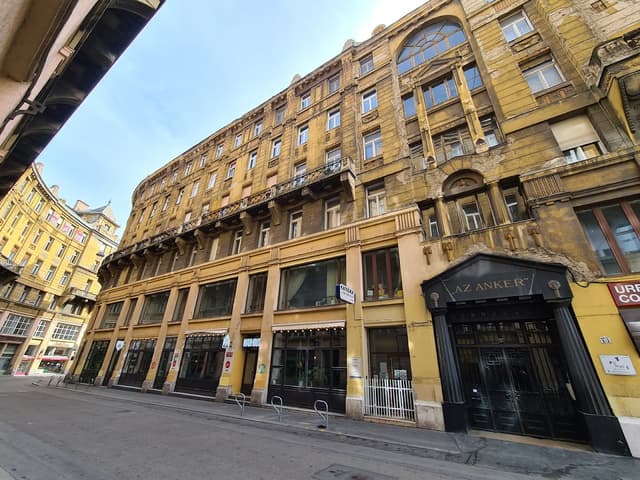
Anker Palace
@pedralexpereira
Anker Palace (Hungarian: Anker-palota) is an iconic building located in Terézváros, Budapest, designed by architect Ignác Alpár. Completed in 1910, the building was constructed for the Anker Life and Pension Company, a Viennese insurance company, and stands as a notable example of eclectic architecture.
The building’s façade is distinguished by Doric columns, which provide a classical touch to its design. On the roof, there are two statues of women with outstretched arms, which add a unique ornamental feature. These figures are symbolic, contributing to the building’s grand, historic appearance. The design of the building blends multiple architectural styles, combining elements from the classical with contemporary trends of the early 20th century, characteristic of the eclectic movement.
Anker Palace is situated near Deák Ferenc Square, one of Budapest's key locations, placing the building in a prominent and bustling part of the city. Additionally, Anker Köz, an alley that runs behind the palace, curves around the building and adds a sense of uniqueness to the surrounding area.
From 1910 to 1919, Anker Palace was home to the Galileo Circle, an intellectual and literary group. This connection to the Galileo Circle, a society that fostered discussion on scientific and philosophical ideas, adds cultural and historical value to the building, marking it as a center of intellectual life in early 20th-century Budapest.

Details

Andrássy Avenue
@pedralexpereira
Andrássy Avenue is a prominent boulevard in Budapest, Hungary, that dates back to 1872. It connects Erzsébet Square with Városliget (City Park). Lined with elegant Neo-Renaissance mansions and townhouses, the avenue is known for its beautiful facades and interiors. In 2002, it was designated a UNESCO World Heritage Site due to its architectural and historical significance. Today, it serves as one of the city's main shopping streets, home to a variety of cafes, restaurants, theatres, embassies, and luxury boutiques. Notable landmarks along the avenue include the State Opera House, the Hungarian University of Fine Arts, the Ferenc Hopp Museum of East Asian Arts, and the Zoltán Kodály Memorial Museum and Archives.
The avenue was originally conceived in 1870 to alleviate traffic from Király utca and connect the inner city with City Park. Construction began in 1872, and the avenue was officially inaugurated on August 20, 1876. The design of the boulevard was the result of a competition, with architects Lajos Lechner, Frigyes Feszl, and Klein & Fraser contributing to the plans. The area quickly became a desirable location for aristocrats, bankers, and landowners, with many of the palaces being completed by 1884. The avenue was named after Prime Minister Gyula Andrássy in 1885, in recognition of his role in the project's development.
In the late 19th century, the construction of the Budapest Metro, the first underground railway in continental Europe, was proposed to facilitate transportation to Városliget, the main venue for Hungary's millennium celebrations. The metro line was completed in 1896, running beneath Andrássy Avenue.
During the communist era, Andrássy Avenue underwent several name changes, reflecting the political shifts of the time. It was renamed Sztálin út ("Stalin Street") in 1950, then to Magyar Ifjúság útja ("Avenue of Hungarian Youth") in 1956, and later to Népköztársaság út ("People's Republic Street") in 1957. The original name, Andrássy út, was restored in 1990 after the end of the communist regime.
In recent years, there have been plans to expand the cultural institutions around Andrássy Avenue, including the creation of the Budapest Museum Quarter or Andrássy Quarter. The project aims to develop new museum buildings near City Park, though these plans have evolved and now focus on the construction of three new museums in the area.
The avenue is divided into four main sections: from Erzsébet tér to Oktogon, a commercial area; from Oktogon to Kodály körönd, with residential areas and universities; from Kodály körönd to Bajza utca, which is wider and features residential palaces; and from Bajza utca to Városliget, which includes villas and embassies.

Details
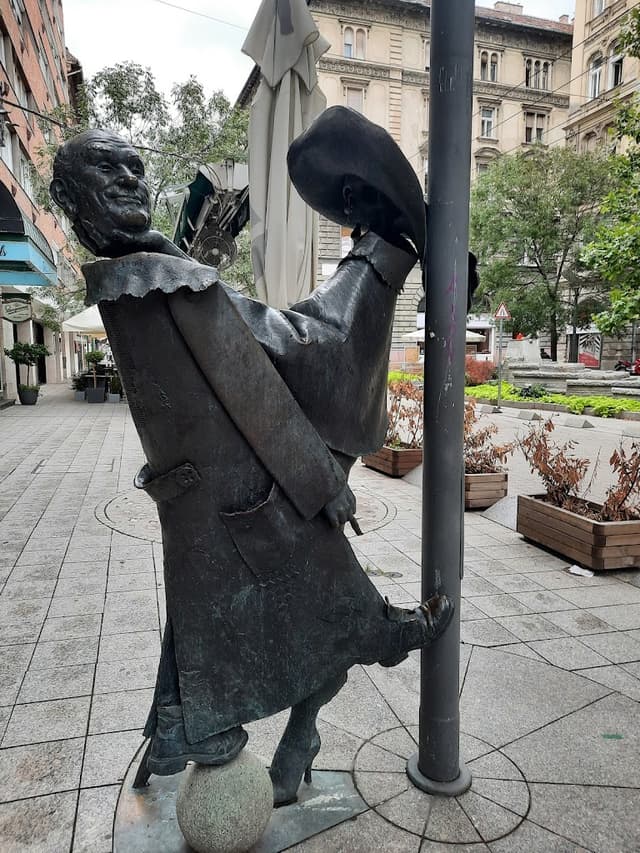
Nagymező Street
@pedralexpereira
Nagymező Street is a significant thoroughfare in Budapest's 6th district, known for its cultural and historical importance. Often referred to as "the Broadway of Pest" due to the large number of theaters located along it, the street hosts notable venues such as the Radnóti Miklós Theater, the Mikroszkóp Theater, the Thália Theater, the Tivoli Theater, and the Budapest Operetta Theater. In addition to the theaters, the street is home to several cultural institutions, including the Mai Manó Gallery in the Hungarian Photographers' House, the former Ernst Museum, and the popular Moulin Rouge nightclub. The street also features historic landmarks like the Terézváros Telephone Exchange building, Merkúr Palace, the Béla Bartók Conservatory, and the Terézváros Roman Catholic Parish Church.
The section of Nagymező Street between Mozsár Street and Paulay Ede Street is considered part of the Andrássy Avenue area, which is a UNESCO World Heritage Site. The street is lined with several listed buildings, contributing to its cultural and architectural significance. It runs from Király Street to Bajcsy-Zsilinszky Street, crossing Andrássy Street along the way.
Historically, the street was named after a large field that once existed in the area. In the 1720s, it was known as Feld Gasse and later as Grosse Feld Gasse in 1853. It has had its current name, derived from the Hungarian translation of the German name, since 1874.
Nagymező Street is a two-way street for its entire length, with a 2x1 lane configuration from Klauzál Square to Bajcsy-Zsilinszky Street, except for a short stretch between Andrássy Street and Mozsár Street, which is known as the "Pest Broadway." Public transportation along the street is well-served by trolleybuses 70 and 78, which run through the section between Bajcsy-Zsilinszky Street and Király Street. The area near Andrássy Street is accessible via the Millennium Underground Railway.

Details
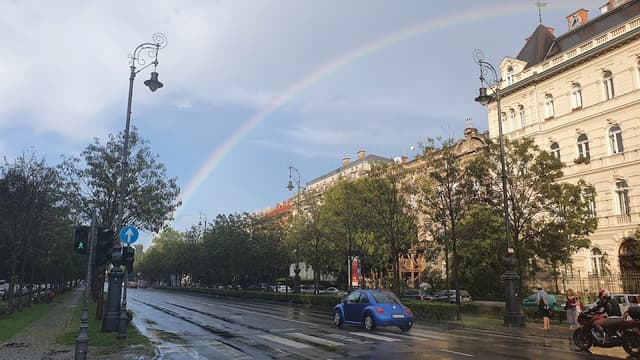
Kodály körönd
@pedralexpereira
Kodály körönd is a square located in the heart of Budapest, Hungary, situated in the District VI area, near the famous Andrássy Avenue. The square is named after the renowned Hungarian composer and music educator Zoltán Kodály, who, alongside Béla Bartók, was a key figure in the development of Hungarian folk music and music education in the 20th century.
Kodály körönd is a vibrant area known for its architectural beauty, offering a mix of residential and commercial buildings. The square is also home to several significant cultural landmarks. Among the most notable is the Kodály Institute, a major music school that offers courses in Kodály’s educational method, which emphasizes music as a fundamental part of childhood development.
One of the features that make Kodály körönd particularly interesting is its proximity to City Park and the Museum of Fine Arts. The square’s convenient location, combined with the surrounding greenery and cultural institutions, makes it a popular spot for both locals and tourists.
The square itself is also well known for its elegant streets and charming atmosphere, often filled with cafes, restaurants, and shops, making it a pleasant place to walk or relax. The area is well-connected by public transportation, including the M1 Metro line (which has a stop directly at Kodály körönd), making it easily accessible from other parts of Budapest.
Kodály körönd is not just a transportation hub, but also a space that carries a deep connection to Hungary's rich musical heritage, particularly through the legacy of Zoltán Kodály.

Details
Museums, cultural venues and activities
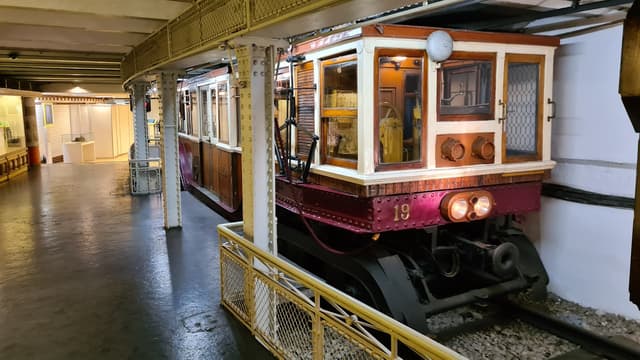
Underground Railway Museum
@pedralexpereira
The Underground Railway Museum (Hungarian: Földalatti Vasúti Múzeum), also known as the Millennium Underground Museum, is a unique museum located beneath Deák Ferenc Square in the heart of Budapest. This museum is housed in a historic tunnel that was once part of the M1 line of the Budapest Metro, the oldest underground railway system in Hungary, and one of the first in the world. The museum is accessible through a pedestrian subway system connecting the square to the Deák Ferenc tér metro station.
The M1 Metro line, which first opened in 1896, was a significant milestone in Budapest's public transportation system and in the history of rail transport worldwide. This original section of the metro ran from Gizella tér station (now Vörösmarty tér) to Aréna út station (now Hősök tere), passing through Deák Ferenc Square, which became an important hub for the underground network.
At the time, the Deák Ferenc Square station had two side platforms and was located just 2.7 meters (about 8 feet 10 inches) underground, which was relatively shallow for a metro system. The design of the station included a sharp curve due to the square's layout, which made the station a notable point in the early line.
In the 1950s, when preparations were being made for the construction of Line M2 (the second line of the Budapest Metro), the route of the M1 line was diverted under Deák Ferenc Square to ease the sharp curve. As a result, an 80-meter (about 260 feet) section of the original M1 tunnel was left abandoned and walled off.
Though Line M2 did not open until the 1970s, in the 1960s, further construction work in the area led to the creation of a large pedestrian underpass beneath the square. This raised the question of what to do with the abandoned section of the tunnel. Initially, it was planned to fill in the space, but instead, a proposal was made to turn the old metro tunnel into a museum dedicated to the history of the Budapest Metro.
The Underground Railway Museum opened its doors to the public on 26 October 1975, coinciding with the 79th anniversary of the opening of the M1 metro line. It quickly became a popular attraction for both locals and tourists, offering a fascinating glimpse into the early days of Budapest's metro system and its significant role in the city's development.
In 1996, on the 100th anniversary of the metro's opening, the museum underwent a significant renovation, updating its exhibits and preserving the historical elements of the tunnel. The museum is a tribute to the Millennium Underground, which is considered a pioneer of underground rail travel, and showcases various aspects of the M1 line's history, its construction, and its impact on Budapest’s public transport system.
The museum features a variety of exhibits, including historical photos, old metro carriages, and relics from the early years of the M1 line. Visitors can see preserved station signs, furniture, and architectural details that reflect the early metro system's design. The museum also provides insight into the technical advancements of the metro, the challenges of building an underground railway system, and the evolution of Budapest's transportation network.
One of the highlights of the museum is the original M1 train car, which allows visitors to step inside a piece of Budapest's history. The museum also showcases the Gizella tér tiling, which was a significant part of the original station's design.

Details
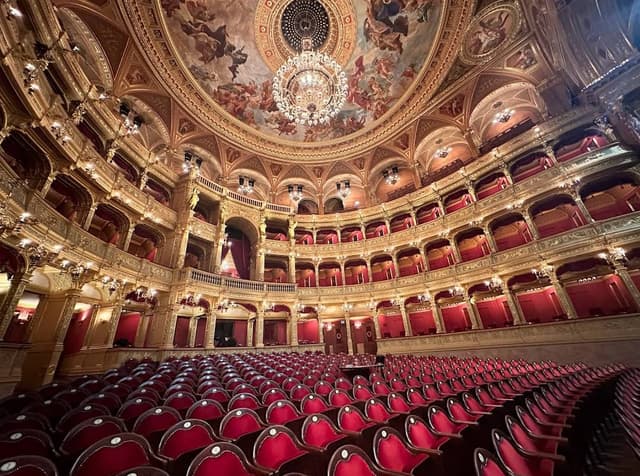
Hungarian State Opera
@pedralexpereira
The Hungarian State Opera House (Magyar Állami Operaház) is a historic and architectural landmark in Budapest, located on Andrássy Avenue. Originally known as the Hungarian Royal Opera House, it was designed by Miklós Ybl, one of Hungary's foremost architects of the 19th century. The construction of the opera house began in 1875, funded by both the city of Budapest and Emperor Franz Joseph I of Austria-Hungary, and it opened to the public on September 27, 1884. Before the closure of the Népszínház (People’s Theatre) in Budapest, it was the third largest opera building in the city, and today it remains the second largest opera house in both Budapest and Hungary.
Opera performances had been a part of Budapest's cultural life since the early 19th century, but it was in 1835 that the Kasa National Opera and Theatrical Troupe established a strong presence in the city. After taking over the Castle Theatre and performing under conductor Ferenc Erkel, the troupe became the Hungarian National Theatre by 1840. When the Hungarian Royal Opera House was completed, it became the home of opera performances, rapidly gaining a reputation for excellence, with a repertory of around 45 to 50 operas and approximately 130 annual performances. Since its opening, the Opera House has also hosted the prestigious Budapest Opera Ball, which began in 1886.
Many renowned artists have graced the stage of the Hungarian State Opera House, including Gustav Mahler, who served as the opera house’s director from 1888 to 1891, and Otto Klemperer, who was its music director from 1947 to 1950. In the 1970s, the state of the building prompted major renovations, which were completed in 1984, marking the centennial of its original opening.
Architecturally, the building is a masterpiece of neo-Renaissance style with elements of Baroque. It is richly adorned with sculptures and paintings by Hungary's leading artists, such as Bertalan Székely, Mór Than, and Károly Lotz. The acoustics of the auditorium are among the finest in the world, with the space holding 1,261 seats in a horseshoe-shaped layout. Noted for its superb acoustics, the Opera House is considered one of Europe's best, ranked third in acoustics after La Scala in Milan and the Palais Garnier in Paris, according to 1970s measurements.
The building’s exterior features statues of two of Hungary’s most famous composers, Ferenc Erkel and Franz Liszt, who played pivotal roles in the country's music history. Inside, the marble foyer leads to a sweeping staircase, adding to the grandeur of the space. The central hall is illuminated by a massive bronze chandelier and adorned with a fresco by Károly Lotz, depicting the Greek gods on Mount Olympus. The opera house is also home to a revolving stage and hydraulic machinery that were the latest innovations at the time of its construction.
In addition to being the venue for opera performances, the Hungarian State Opera House is home to the Hungarian National Ballet. The season runs from September to June, and the venue offers guided tours in multiple languages, allowing visitors to explore its rich history and stunning architecture.
Since 1951, the Erkel Theatre has served as the company's secondary venue. Originally opened in 1911 as the Népopera (People’s Opera), the theatre underwent various renovations over the years, serving multiple functions including as a cinema, before coming under the control of the State Opera House in the 1960s. It has been extensively renovated and reopened in 2013 after a period of closure and restoration.

Details
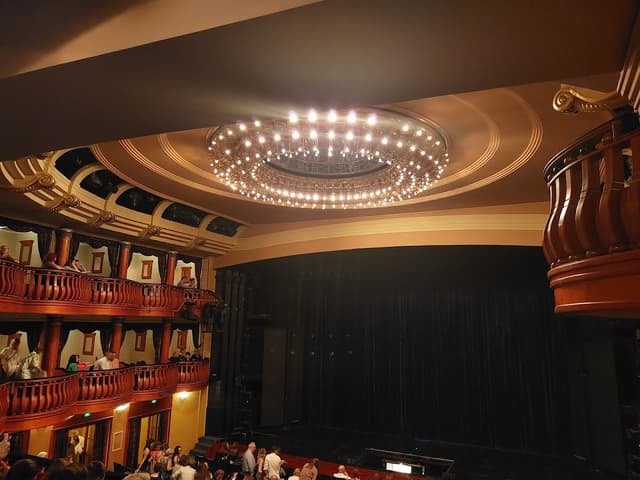
Thalia Drama Theater
@pedralexpereira
The Thália Drama Theatre was established as a response to the evolving cultural landscape of Budapest in the 1990s, aiming to provide a space for more experimental and modern productions alongside traditional theater. The venue quickly gained a reputation for hosting contemporary Hungarian and international plays, often featuring bold and innovative stagings. It was designed to be a dynamic space that could accommodate a variety of performances, from classic to cutting-edge works.
The theater is part of a group of state-supported venues that are integral to Budapest’s vibrant cultural scene, and it is a key player in the city's theater district, which is centered around Andrássy Avenue. Over the years, the Thália Drama Theatre has become a favorite for theatergoers who seek high-quality productions that push the boundaries of traditional drama.
The Thália Drama Theatre is housed in a historic building, which was originally constructed as a cinema in the early 20th century. Over the years, the building underwent significant renovations to meet the needs of modern theatrical performances. Today, it has a contemporary, functional design that is enhanced by its historic charm.
The theater features a main auditorium with a seating capacity of over 400, offering an intimate yet expansive experience for the audience. It also includes a smaller studio theater that hosts more experimental works and intimate performances. The design of the theater allows for excellent acoustics, making it ideal for both large-scale performances and more personal, close-up experiences.
The Thália Drama Theatre is known for its diverse range of programming, which includes both Hungarian and international plays. The theater hosts a variety of performances, from contemporary drama and classic plays to avant-garde works and musicals. It is particularly known for its strong commitment to Hungarian playwrights and their contributions to the national theater scene.
In addition to its theatrical productions, the Thália Drama Theatre is also involved in various educational and outreach programs, promoting theater arts to young people and helping to nurture the next generation of theater artists. The venue regularly collaborates with local and international theater companies, further establishing its reputation as a hub for innovative performance art.
The theater’s productions often reflect contemporary social issues, with many plays focusing on personal and political themes, offering audiences a chance to reflect on current events and human experience.

Details
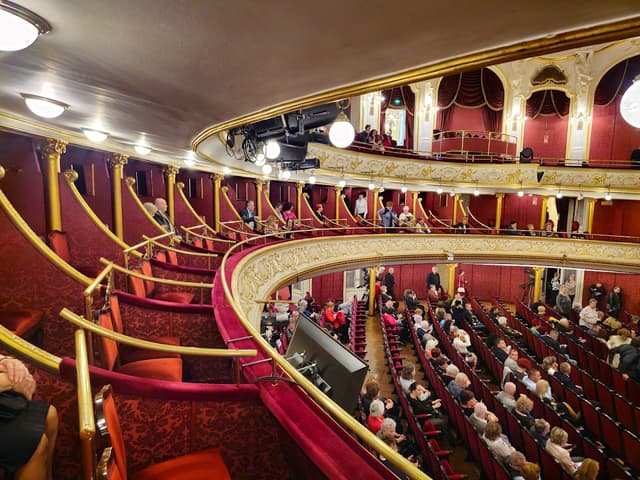
Budapest Operetta Theatre
@pedralexpereira
The Budapest Operetta Theatre was founded in 1923 and has since become one of the premier venues for operetta in Hungary. It initially operated under the name "Operett Színház" and was dedicated to the light, melodic operetta genre, which had gained popularity across Europe in the late 19th and early 20th centuries. The theater’s founding marked the establishment of an iconic cultural institution focused on operetta, a genre known for its catchy tunes, humorous plots, and lavish performances.
Over the years, the theater has undergone several renovations and expansions, but it has always stayed true to its origins, providing top-tier operetta productions. It has hosted some of the best-known operettas from composers like Franz Lehár, Emmerich Kálmán, and Johann Strauss II, as well as many Hungarian composers who have contributed to the genre’s development in the country.
Today, the Budapest Operetta Theatre continues to honor the traditions of operetta while embracing modern productions, including musical theater, contemporary works, and grand productions that appeal to both domestic and international audiences.
The Budapest Operetta Theatre occupies a historical building that dates back to the early 20th century. The neo-Renaissance-style exterior reflects the grandeur of the period, with ornate details and an elegant facade. Inside, the venue boasts a classic design that exudes old-world charm while offering modern amenities. The theater is equipped with a large, well-appointed auditorium that can seat over 1,000 people.
The building’s acoustics are excellent, making it ideal for operettas and musicals, which often involve elaborate orchestral arrangements and vocal performances. The interior features luxurious decor with richly painted ceilings, gilded details, and large chandeliers, adding to the sense of grandeur associated with operetta productions.
The theater also has smaller venues for more intimate performances, such as chamber productions and smaller musicals, making it a versatile space for a wide range of performances.The Budapest Operetta Theatre is renowned for its repertoire of operettas, musicals, and operas, particularly those that celebrate the joy, lightheartedness, and romance associated with the operetta genre. It regularly stages productions by classical operetta composers such as Franz Lehár (with his famous works like The Merry Widow), Emmerich Kálmán (known for Die Csárdásfürstin and Mariza), and Johann Strauss II (including Die Fledermaus).
In addition to classic operettas, the theater also presents modern musicals and performances from a variety of genres. Productions like "Les Misérables", "Cats", and "The Phantom of the Opera" have also been part of its repertoire, broadening the range of musical theater styles on offer.
The Budapest Operetta Theatre has been a hub for talented Hungarian performers, including both singers and dancers, many of whom have gained international acclaim. Its productions are known for their lavish sets, colorful costumes, and dynamic choreography, all contributing to the spectacle that makes operetta so enjoyable for audiences.

Details
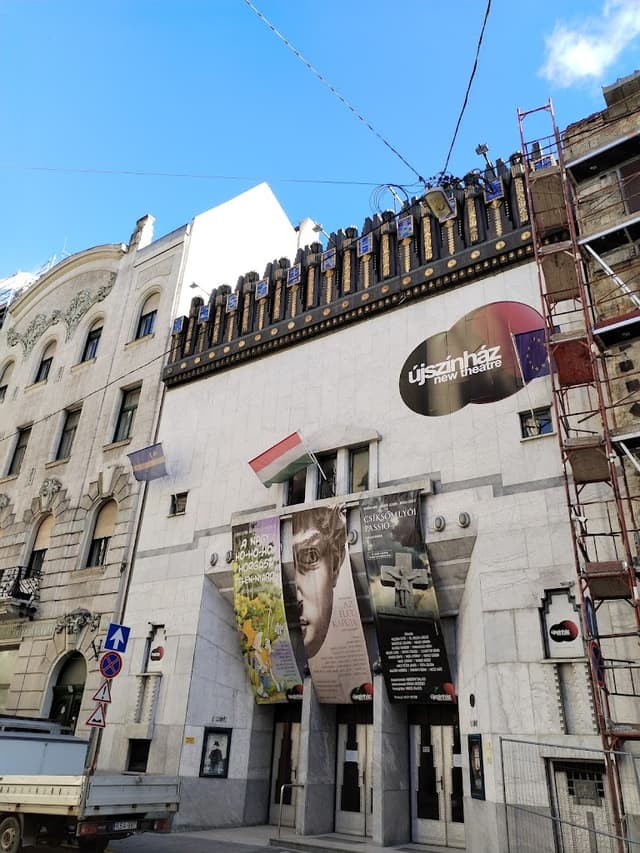
New Theatre
@pedralexpereira
The building was originally constructed in 1909 as a music hall under the name Parisiana. Its design included a ground floor furnished with tables and chairs, a winter garden on the upper level, and a narrow gallery. In 1910, the name changed to Crystal Palace, and by 1912, it was renamed Dance Palace. In 1919, the venue became the Vaudeville Theatre (Revüszínház), and its interior was reconfigured to include rows of seats in the stalls.
A major reconstruction took place in 1921, designed by architect László Vágó, who transformed the building with Neo-Baroque elements. This reconstruction added a series of boxes in the auditorium, establishing its present-day appearance. Over the years, the theatre hosted a variety of companies, including the Chamber Theatre of the National Theatre, Kamra Theatre, Andrássy Theatre, and Művész Színház.
After nationalization in 1949, the theatre became the Pioneer Theatre and later the Youth Theatre, adapting to a new repertoire for a younger audience. In the 1950s, the building underwent a significant façade reshaping in the socialist-realist style, which included the removal of the stone pavement and redesigning of the entrances. The venue was renamed Jókai Theatre and later hosted other theatre companies, including Bartók Theatre (1971), Arany János Theatre (1980s), and Budapest Children’s Theatre (1974).
The theatre's most recent renovation took place in the 1980s, when the service areas were modernized, and the foyer and cloakroom were enlarged. This restoration aimed to preserve the Art Deco façade designed by Béla Lajta while reinstating the Baroque splendour of the auditorium designed by László Vágó.
In 1991, following the renovation, the theatre reopened as Arany János Theatre with a performance of Sándor Weöres' Holdbéli csónakos (Shipman of the Moon). In 1994, the theatre was renamed Új Színház, a name it still holds today, and hosted the premiere of Mihály Vörösmarty's Csongor és Tünde.
The building’s architecture reflects its complex history and multiple reconstructions. The entrance to the theatre is located on Paulay Ede Street, where visitors pass through a windbreak before entering the lobby. The ground floor of the auditorium is reached via a staircase, and the theatre is designed in a linear, axially aligned layout. The auditorium features two balconies that form a protracted horseshoe shape, widening towards the stage. This design is intended to enhance the acoustics and ensure a good view from all seats.
Due to the narrow plot of land, the building’s design incorporates slight angles in its layout. The back and main stages are not aligned perpendicular to the street, giving the theatre a distinctive architectural character. The building is tightly nestled among neighbouring apartment houses, with service areas, including changing rooms and management offices, located in a neighbouring building. Additionally, rehearsal rooms and stores are housed in an attached building at the back of the theatre.

Details
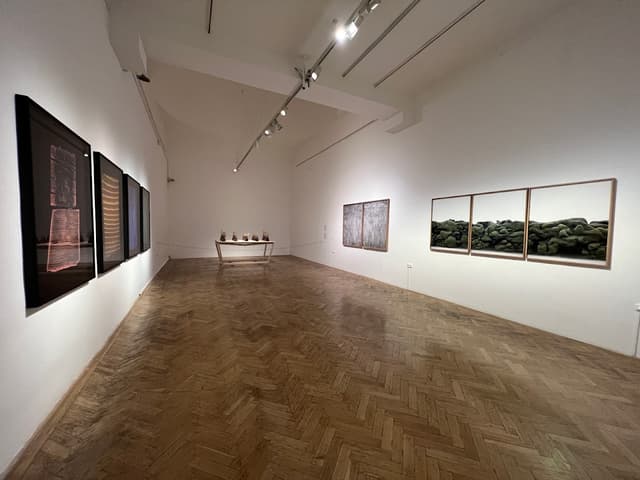
Robert Capa Contemporary Photography Center
@pedralexpereira
The Robert Capa Contemporary Photography Center is a prominent institution in Budapest dedicated to contemporary photography. Named after Robert Capa, the renowned Hungarian-born war photographer, the center showcases a wide range of photographic works, focusing on both Hungarian and international artists. Its mission is to promote the art of photography and highlight its significance in visual culture.
Located in the heart of Budapest, the center features rotating exhibitions that explore the diversity of photographic expressions, from documentary photography to conceptual art. It provides a platform for both emerging and established photographers, offering a dynamic space for experimentation and dialogue in the world of contemporary photography.
The center also houses an extensive archive of Capa’s work, which is an important part of Hungary's cultural heritage. Robert Capa is widely regarded as one of the greatest war photographers in history, and his images have left a lasting impact on the field. The center serves as a tribute to his legacy, while simultaneously embracing the evolving nature of photography as an art form.
In addition to its exhibitions, the Robert Capa Contemporary Photography Center offers educational programs, workshops, and events designed to engage the public with photography and foster a deeper understanding of the medium. It plays a vital role in promoting the photography scene in Hungary, offering a space for dialogue, discovery, and innovation in visual storytelling.

Details
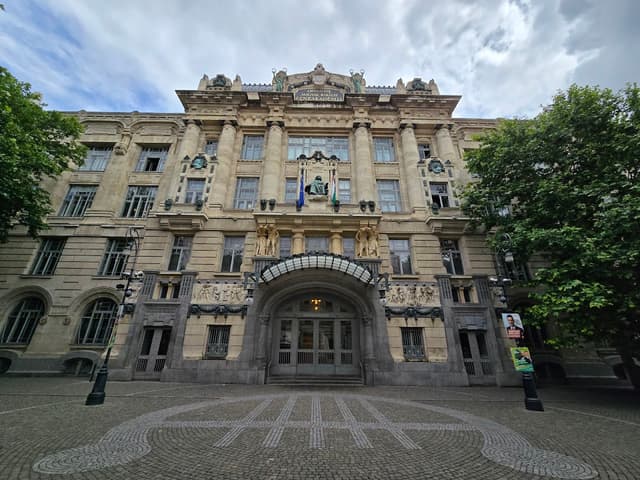
Franz Liszt Academy of Music
@pedralexpereira
The Franz Liszt Academy of Music (Liszt Ferenc Zeneművészeti Egyetem, or Zeneakadémia) is a prestigious music university and concert hall located in Budapest, Hungary. Founded on November 14, 1875, by the legendary composer and pianist Franz Liszt, the institution is renowned for its contributions to music education and performance. It was named after its founder in 1925, roughly 50 years after it was relocated to its current location in the heart of Budapest.
Originally called the "Royal National Hungarian Academy of Music," it served as a center for music training and higher education. The Academy’s first home was in Liszt's residence, but it soon moved to a three-story Neo-Renaissance building designed by Adolf Láng on Andrássy Avenue, completed between 1877 and 1879. This building, referred to as the "Old Academy of Music," is now the "Ferenc Liszt Memorial and Research Center."
In 1907, the Academy moved to its current location at the corner of Király Street and Liszt Ferenc Square, into a building designed in the Art Nouveau style by Flóris Korb and Kálmán Giergl. The façade is highlighted by a statue of Franz Liszt sculpted by Alajos Stróbl. The interior features decorative frescoes, Zsolnay ceramics, and statues of notable musicians, including Béla Bartók and Frédéric Chopin. Stained glass windows by Miksa Róth originally adorned the building, adding to its artistic charm.
Apart from the main facility, the Academy operates additional institutions such as the Budapest Teacher Training College, the Bartók Béla Secondary School of Music, and a student dormitory. The Academy is also home to a new Folk Music Faculty, further enhancing its diverse offerings in the music field.
The Franz Liszt Academy of Music is a living monument to Hungary's musical heritage and continues to be a hub for musical excellence. The museum inside the Academy, known as the Franz Liszt Museum or Liszt Ferenc Memorial Museum, showcases three restored rooms of Liszt's home where he lived in the last years of his life, from 1881 to 1886. The museum is open to the public and offers exhibitions such as "Liszt, the Teacher," running from May 2023 to May 2024.

Details
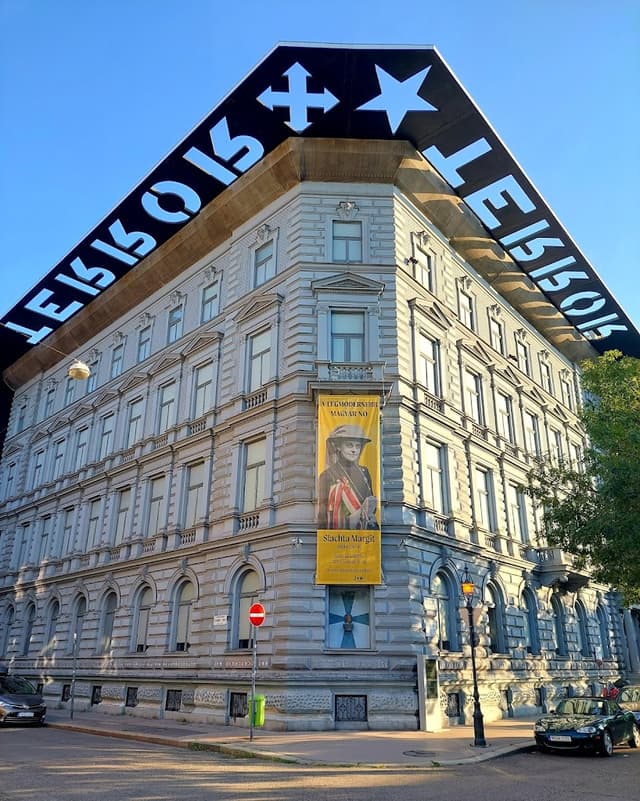
House of Terror Museum
@pedralexpereira
The House of Terror (Terror Háza Múzeum) is a museum located at Andrássy Avenue 60 in Budapest, Hungary. It was inaugurated on February 24, 2002, to preserve the memory of the victims of both the fascist and communist regimes that ruled Hungary during the 20th century. The museum commemorates those who were detained, interrogated, tortured, or killed in the building, which was used by both the fascist Arrow Cross Party and the communist ÁVH (State Protection Authority, similar to the Soviet KGB).
The museum was created under the government of Viktor Orbán and was established by the Public Foundation for the Research of Central and East European History and Society, which purchased the building in December 2000. The renovation and transformation of the building were carried out by architects János Sándor and Kálmán Újszászy, with the final exhibition design and the building's black exterior by architect Attila F. Kovács. The museum’s striking exterior contrasts with the surrounding buildings on Andrássy Avenue, and the interior features a T-54 tank as part of the permanent exhibition.
The museum's exhibition focuses on Hungary's historical relationship with Nazi Germany and the Soviet Union, as well as detailing the activities of the fascist Arrow Cross Party and the communist ÁVH. One of the most powerful parts of the museum is located in the basement, where visitors can see reconstructed cells used by the ÁVH to torture prisoners. Audio guides in multiple languages, including English, German, Spanish, Russian, and Italian, are available, and each room provides detailed information in both Hungarian and English.
Some have critiqued the museum for emphasizing Hungary's victimhood under foreign regimes, with less attention given to the role played by Hungarians in these regimes. Additionally, critics note that the museum dedicates more space to the communist terror than to the fascist period. However, the museum's curators have defended this choice, explaining that while the German occupation and the fascist regime of Ferenc Szálasi lasted less than a year, the communist regime lasted for four decades. The museum also points out that the Hungarian Holocaust has its own dedicated museum. Despite these critiques, the House of Terror remains an important site of reflection on Hungary's troubled 20th-century history.

Details
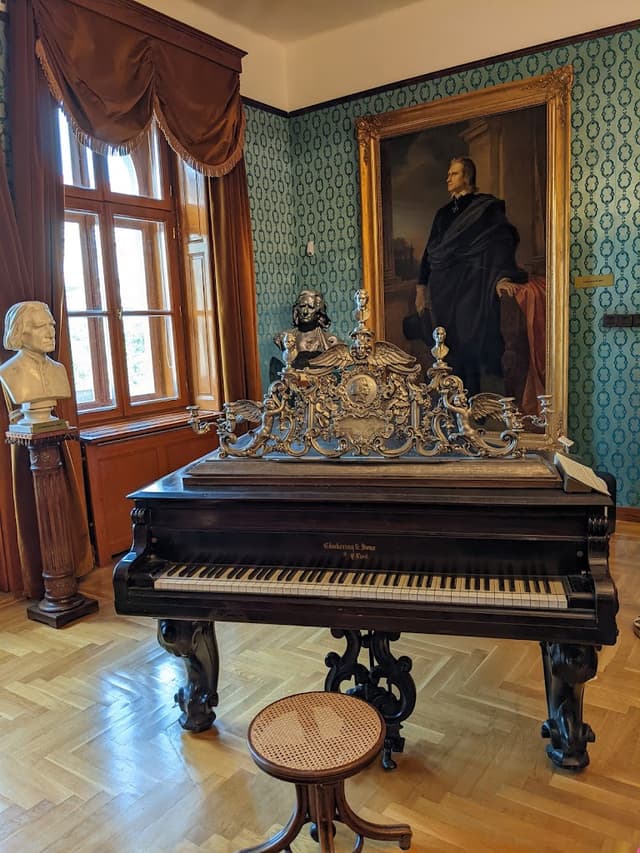
Franz Liszt Memorial Museum
@pedralexpereira
The Franz Liszt Memorial Museum and Research Centre, part of the Liszt Academy of Music, functions as the central hub for Liszt research in Hungary. It is located in the former apartment of Franz Liszt, which now houses a permanent exhibition showcasing a variety of personal items belonging to the composer. The museum’s collection includes Liszt’s original musical instruments, furniture, books, sheet music, and other personal effects. The space also hosts temporary exhibitions, displayed in the museum’s middle room and ground floor foyer.
Adjacent to the flat is a concert hall where weekly matinee concerts are held every Saturday, offering visitors an opportunity to experience Liszt’s music in a historic setting. The museum continues to preserve and process Liszt-related documents, which are occasionally made available to the public through temporary exhibitions. Additionally, the museum’s library provides valuable resources for researchers, supporting ongoing scholarly work related to Liszt’s life and legacy.

Details
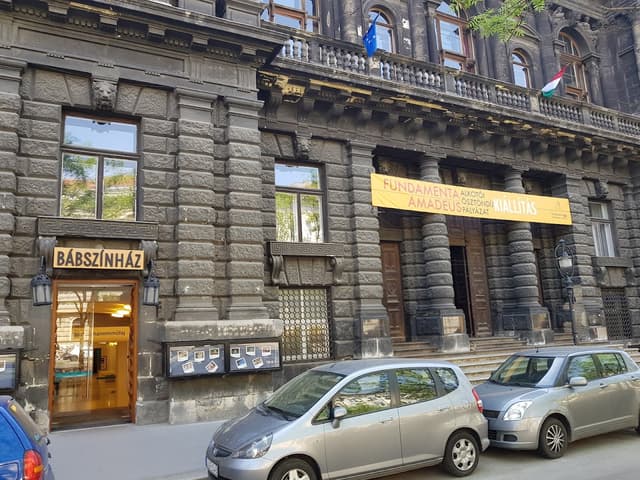
Budapest Puppet Theater
@pedralexpereira
The Budapest Puppet Theater (Budapesti Bábszínház) has been a cornerstone of Hungarian cultural life since it opened in 1949. Located at 69 Andrássy Avenue, it is the largest puppet theater in Central Europe and the oldest professional puppet theater in Hungary. Known for its motto, "the puppet is not the matter of age, but a genre," the theater offers performances for both children and adults, breaking boundaries and proving that puppetry is a versatile and timeless art form.
Initially known as the State Puppet Theater, it was renamed in 1992 to Budapest Puppet Theater. Over its long history, the theater has offered a wide range of performances, including traditional puppetry with hand and rod puppets, as well as more experimental works. It is particularly famous for its ability to blend classical music, drama, and puppetry, earning international acclaim for its innovative puppet adaptations of classic works.
The theater has three stages: the main stage with 400 seats, the Ország Lili Studio with 100 seats, and the Kemény Henrik Room, opened in 2017. In addition to regular performances, it organizes the BÁBU festival and celebrates World Puppet Day on March 21. The theater is also home to a gallery dedicated to one of Hungary's most influential puppet designers, Koós Iván, showcasing designs and works of significant puppet artists.
With an impressive 360-380 performances annually, the Budapest Puppet Theater continues to be a vital educational and entertainment venue, with 80% of its audience being children. It emphasizes both pedagogical and artistic concerns in its repertoire, ensuring that the magic of puppetry is accessible to audiences of all ages.

Details
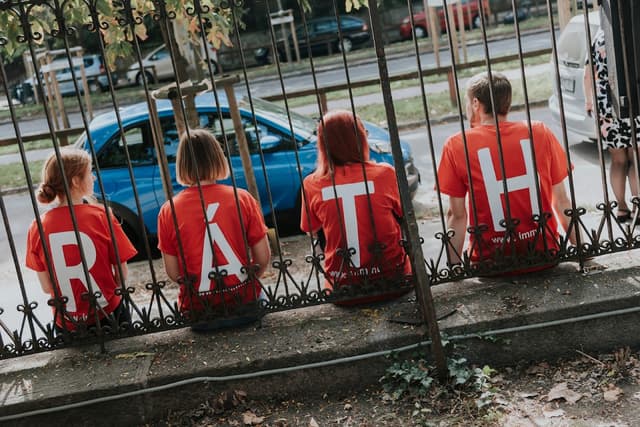
Ráth György-villa
@pedralexpereira
The villa is notable for its architectural and historical significance and is one of the prominent buildings along this grand avenue, which is known for its elegant structures dating back to the 19th and early 20th centuries.
The villa was built in the late 19th century, and it was named after György Ráth, a prominent Hungarian physician and philanthropist, who was the original owner of the building. Ráth György was known for his contribution to medical sciences and his significant role in Hungarian society at the time. The villa, which is a representative example of the period's bourgeois architecture, reflects the social standing of its original owner.
The building itself is a striking example of eclectic architecture, which combines elements of various historical styles. Its design features a blend of Neo-Renaissance, Baroque, and Art Nouveau influences, which was typical for the period of its construction. The façade is adorned with decorative elements that reflect the grandeur and elegance of the time, including intricate window moldings and wrought iron details. The villa’s high ceilings, spacious rooms, and decorative interiors are characteristic of the affluent homes of Budapest’s elite during this period.
Today, the Ráth György-villa houses a part of the Hungarian National Museum’s collection, specifically the Museum of Applied Arts. The villa serves as a venue for exhibitions and events, contributing to Budapest's cultural and artistic scene. The villa's location on Andrássy Avenue, a UNESCO World Heritage Site, places it in proximity to other cultural landmarks, further enhancing its significance as part of Budapest's historical and artistic heritage.

Details
Postal Museum
@pedralexpereira
The Postal Museum in Budapest has a collection that began in 1881 with items from the National Finance Office and the Central Telegraph Storage, initially focused on telegraph history. Over time, the collection expanded to include postal, telephone, and eventually radio and television-related objects. Today, the museum houses a vast array of antiques from postal, telegraph, radio, and television history, along with notable pieces from more recent times.

Details
Hopp Ferenc Museum of East Asian Art
@pedralexpereira
The Ferenc Hopp Museum of Asiatic Arts in Budapest was founded in 1904 and is dedicated to the art and culture of Asia. Its collection includes a wide range of artifacts from China, Japan, India, and Southeast Asia, such as sculptures, paintings, textiles, ceramics, and religious objects. The museum is named after Ferenc Hopp, a Hungarian businessman and philanthropist who collected these pieces during his travels in the late 19th and early 20th centuries. The museum’s exhibits offer insights into the diverse artistic traditions of Asia, and it serves as an important center for the study and appreciation of Asian cultures in Hungary.

Details
Museum of Tax And Customs
@pedralexpereira
The Customs and Tax History Museum in Budapest features two permanent exhibitions. The Hungarian Financial Guard Historical Exhibition showcases the history of the Customs and Finance Guard, along with its predecessors, arranged in chronological order. The Hungarian Tax History Exhibition offers a detailed exploration of Hungary's taxation history, spread across three rooms. Together, these exhibits provide visitors with a comprehensive understanding of Hungary's financial and taxation systems throughout the centuries.

Details
Religious temples
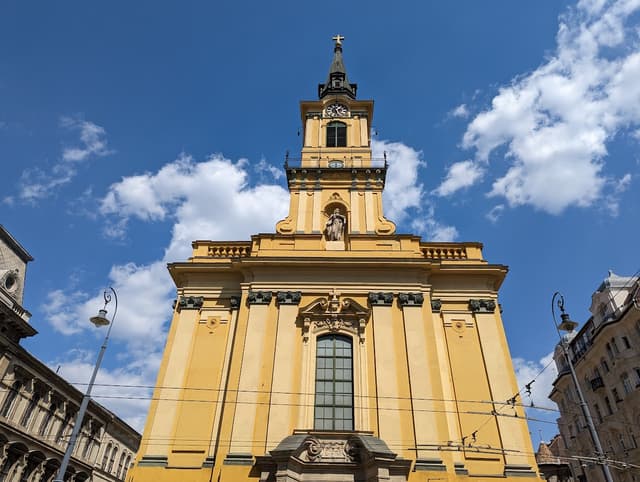
St. Teresa of Avila Parish Church
@pedralexpereira
St. Teresa of Ávila Parish Church is the oldest church in Terézváros, with a rich history that spans several centuries. Originally a wooden chapel built in 1777, it was surrounded by village-style houses at the time. The church's construction began in 1801 based on the plans of architect Fidél Kasselik and blends Baroque, Gothic, and Classicist elements.
Significant changes were made to the church in the 19th century. In 1811, Lőrinc Dunaiszky created the statue of St. Teresa that adorns the church's façade. Miklós Ybl, in 1871, replaced the steeple's spire with a brass helmet and added balustrades and vases around the roof. The church also features a rare fire-watching balcony at a height of 30 meters. Its mechanical clock, still in use today, is unique in Budapest.
The interior was designed by Mihály Pollack, and the monumental high altar is one of its most impressive features. The altarpiece, created by József Schöfft, depicts the ecstasy of St. Teresa, as the church was renamed in her honor in 1822. The church also boasts an altar of St. Joseph paired with St. Stephen's altar, with altarpieces painted by Schöfft. St. Stephen's altar is decorated with allegories of Love and Hope, while St. Joseph's altar is surrounded by kneeling angels.
Another distinctive feature of the church is its Moorish baptismal altar, designed by Mihály Pollack, and the new organ installed in 1890 by the renowned Angster factory. The church also has a second organ, a Rieger 9-stop monument organ, installed in 2011.
An interesting historical detail is the gilded wooden chandelier, which was once used in the ballroom of the former Vigadó and survived the 1849 siege of Buda.
In 1994, an urn crypt was built beneath the sanctuary, and the crypt was later extended in 2004 to include the area under the nave, with underfloor heating installed.

Details
Parks and green spaces
Jókai Square
@pedralexpereira
The square is named after the renowned Hungarian novelist Mór Jókai, one of the most famous figures of Hungarian literature in the 19th century. Jókai’s works, rich in historical themes and passionate storytelling, earned him a prominent place in Hungarian cultural history.
The area around Jókai tér is characterized by a mix of historical and modern buildings, with several architectural gems located nearby. The square itself is a quiet, pleasant spot in the city, offering a retreat from the busy streets of central Budapest. It is surrounded by residential buildings, small cafes, and shops, making it a charming and relatively less touristy area to explore.
One of the notable landmarks near Jókai tér is the Jókai Memorial House, a museum dedicated to Mór Jókai’s life and works, which is located just a short walk from the square. The museum offers visitors a glimpse into the author's personal history and the literary era he helped define.

Details
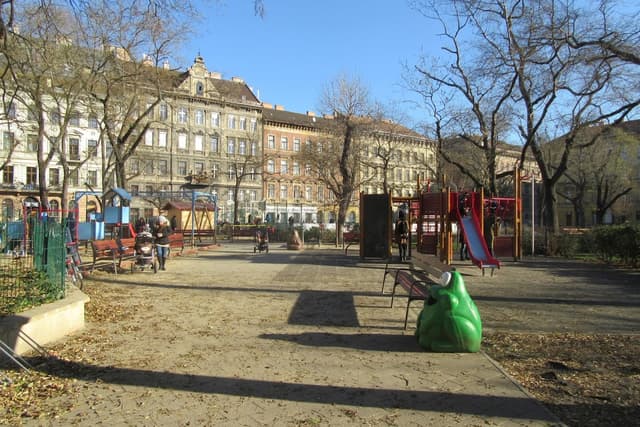
Hunyadi Square
@pedralexpereira
Hunyadi tér is a square located in Budapest's 6th district, near the western edge of the city center. The square is named after John Hunyadi, a Hungarian military leader and regent in the 15th century, who is celebrated for his defense of Hungary against Ottoman invasions and his significant role in Hungarian history.
The square is a lively and residential area, known for its central location and easy access to various parts of the city. It is primarily surrounded by residential buildings, shops, cafes, and small businesses, making it a neighborhood hub. Although Hunyadi tér is not a major tourist destination, it offers a more local atmosphere compared to the more crowded central squares in Budapest.
One of the highlights of the square is the Hunyadi tér Market Hall, a bustling and popular spot where locals come to buy fresh produce, meats, dairy, and other goods. The market is a great place to experience the daily life of Budapest's residents and enjoy the flavors of Hungarian cuisine.
The square is also known for its proximity to the City Park (Városliget), a large public park that houses several important cultural and historical landmarks, including the Vajdahunyad Castle and the Széchenyi Thermal Bath. Hunyadi tér itself offers a peaceful atmosphere with green spaces and benches, providing a pleasant place for relaxation. It is well-served by public transportation, including the nearby metro station, which makes it easy to access from other parts of the city.

Details
Városliget
Városliget (City Park) is one of Budapest’s largest and most beloved green spaces, located in the heart of the city just to the northeast of the city center. Established in the late 19th century, the park is a prominent example of Budapest’s dedication to providing residents and visitors with expansive outdoor spaces for recreation and leisure. Originally designed as a public park for the city, Városliget has evolved over the years into a cultural hub, home to several important landmarks and institutions. It stretches over 1.5 square kilometers and offers a serene escape from the bustling urban environment.
One of the park's most iconic features is the Széchenyi Thermal Bath, one of the largest and most famous thermal bath complexes in Europe, known for its grand architecture and outdoor pools. Visitors to the park can also enjoy the scenic beauty of Hősök Tere (Heroes' Square) located at the park's edge, which is adorned with statues of Hungarian historical figures and the Millennium Monument, commemorating the 1000th anniversary of Hungary. The park is also home to the Vajdahunyad Castle, an architectural gem that blends various European architectural styles and houses the Hungarian Agricultural Museum.
See&Do
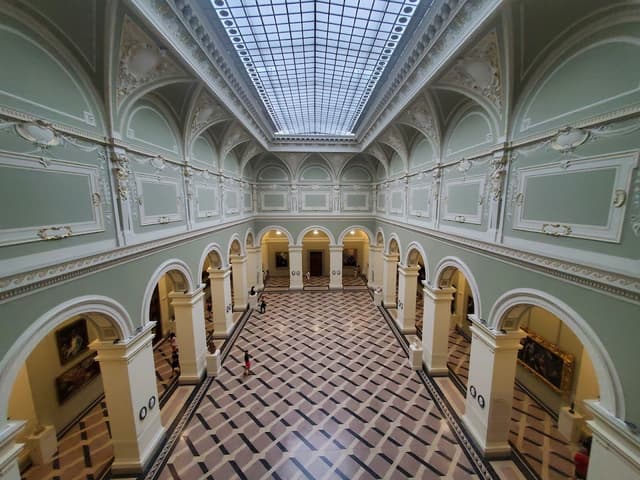
Museum of Fine Arts
@pedralexpereira
The Museum of Fine Arts in Budapest, located in Heroes' Square, is a renowned institution housing an extensive collection of international art spanning all periods of European history. Designed by Albert Schickedanz and Fülöp Herzog in an eclectic-neoclassical style, the museum was completed between 1900 and 1906. Its vast collection, exceeding 100,000 pieces, is divided into six departments: Egyptian, Classical Antiquities, Old Sculpture, Old Master Paintings, Modern Art, and Drawings and Prints.
The Egyptian collection, one of the most significant in Central Europe, features artifacts such as painted mummy sarcophagi. The Classical Antiquities department showcases works from Ancient Greece and Rome, including the notable 3rd-century marble statue, the *Budapest Dancer*, along with impressive Cypriot and Mycenaean artifacts.
The Old Master Paintings gallery provides a nearly complete survey of European art from the 13th to 18th centuries. It includes masterpieces from artists like Raphael, El Greco, Pieter Bruegel the Elder, and Titian. This section is particularly notable for its Italian, Flemish, Dutch, German, Spanish, and French paintings.
The Old Sculpture collection emphasizes works from the Middle Ages through the 17th century, featuring painted wooden sculptures and pieces such as a small equestrian bronze attributed to Leonardo da Vinci. The Drawings and Prints department includes notable works by Rembrandt, Goya, and Leonardo da Vinci, with a rotating display of highlights from its vast holdings.
The museum’s collection of 19th- and 20th-century art, though smaller, includes works by Romantic, Barbizon, and Impressionist artists like Eugène Delacroix, Édouard Manet, and Claude Monet. Sculptures by Auguste Rodin and Constantin Meunier also enrich this department.
The Vasarely Museum, dedicated to the works of Hungarian artist Victor Vasarely, is an extension of the Museum of Fine Arts. Situated in the Zichy mansion in Óbuda, it is a unique institution in Eastern Europe, celebrating Vasarely's contributions to the Op Art movement.

Details
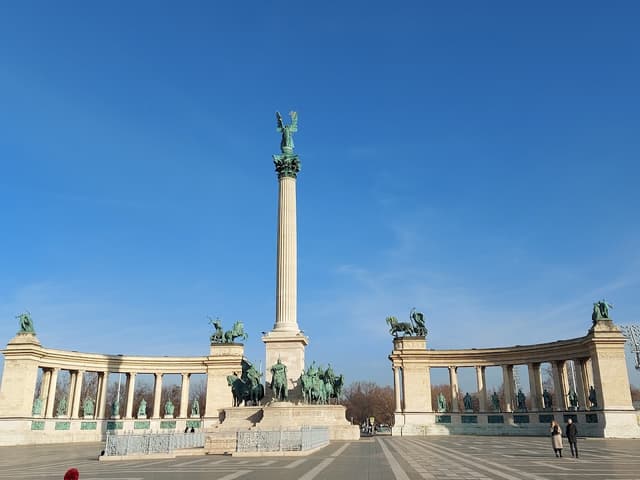
Heroes' Square
@pedralexpereira
Heroes’ Square, or Hősök tere, is among the most iconic landmarks of Budapest. Positioned at the terminus of Andrássy Avenue and adjacent to City Park, the square is dominated by the Millennium Monument, a tribute to Hungary’s history and the thousandth anniversary of the Magyar conquest of the Carpathian Basin. The site also features two prominent cultural institutions: the Museum of Fine Arts and the Hall of Art (Műcsarnok).
At the heart of the square is the Millennium Memorial, completed in stages between 1896 and 1906. Its centerpiece is a towering column crowned by a statue of Archangel Gabriel, holding the Holy Crown of St. Stephen and an apostolic double cross, symbolizing Hungary’s Christian heritage. At the base of the column stand statues of the seven Magyar chieftains led by Árpád, the nation’s founder, depicted in an evocative and imaginative style rather than strict historical accuracy.
The semi-circular colonnades behind the column house statues of key figures from Hungarian history. The left colonnade celebrates medieval and early modern monarchs like Stephen I, Hungary’s first king, and Louis I, who expanded Hungary’s influence. The right colonnade features national heroes and statesmen, such as Matthias Corvinus and Lajos Kossuth, symbolizing Hungary’s cultural and political evolution. Above the colonnades are allegorical sculptures representing ideals such as Peace, Knowledge, and Glory.
In front of the monument lies the Memorial Stone of Heroes, a cenotaph dedicated to those who gave their lives for Hungary’s independence. Despite being referred to as the "Tomb of the Unknown Soldier" by some, it contains no human remains and serves solely as a symbolic tribute.
The square has been a venue for major historical events, including the 1989 reburial of Imre Nagy, a leader of the 1956 Hungarian Revolution. The Millennium Monument itself has undergone modifications over the years, with statues of Habsburg rulers replaced by figures more representative of Hungarian national identity following World War II.

Details
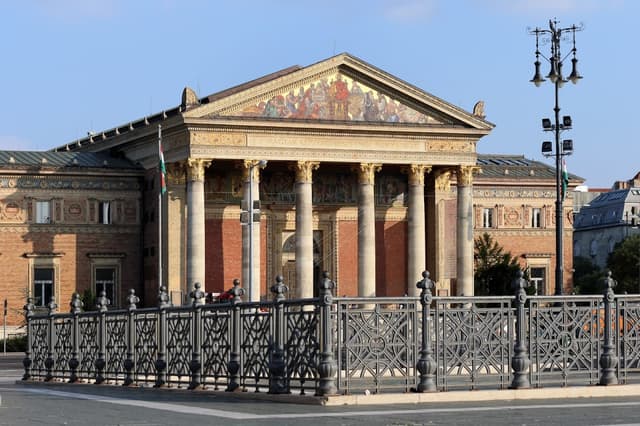
Kunsthalle
@pedralexpereira
The Budapest Hall of Art, also known as the Palace of Art (Műcsarnok Kunsthalle), stands prominently on Heroes’ Square opposite the Museum of Fine Arts. Dedicated to contemporary art, this institution does not maintain a permanent collection but instead showcases rotating exhibitions, making it a dynamic venue for modern artistic expression. Operated by the Hungarian Academy of Arts and supported by the Ministry of Education and Culture, it serves as a significant cultural platform in Hungary.
The building itself is a masterpiece of Neoclassical architecture, designed by Albert Schickedanz and Fülöp Herczog. Completed in 1896 for the millennial celebrations, its design reflects a Greek Revival influence, with a striking portico and a semi-circular apse that houses a skylit exhibition space. A major renovation in 1995 restored its historic grandeur while ensuring modern functionality.
In addition to its exhibition halls, the Hall of Art includes a library, a bookshop, and the Műcsarnok Café, offering views over the bustling Heroes’ Square. This blend of cultural programming and inviting amenities makes it a focal point for art enthusiasts and visitors alike.

Details
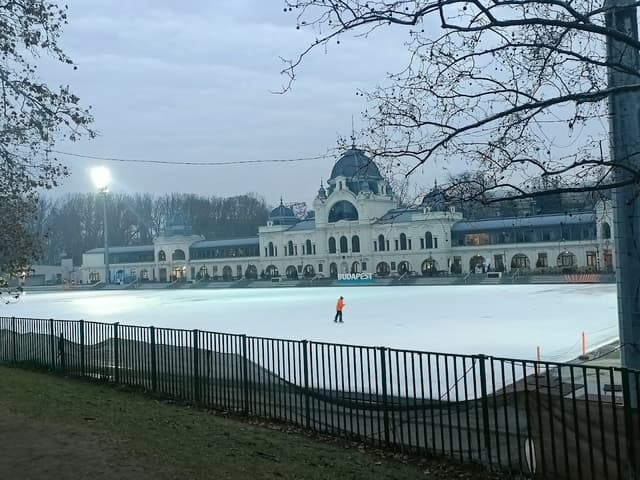
City Park Ice Rink and Boating
@pedralexpereira
The City Park Ice Rink (Városligeti Műjégpálya) in Budapest is a historic and iconic destination, nestled between Heroes' Square and the Vajdahunyad Castle within the scenic City Park. First opened in 1870, it is not only the largest but also one of the oldest ice rinks in Europe, blending sports, history, and cultural significance. During the warmer months, the ice rink transforms into a picturesque pond, serving as a venue for boating and unique events like the 2009 snowball fight world record attempt and the Art on Lake exhibition in 2011.
The facility underwent a major renovation between 2009 and 2011, revitalizing its neo-Baroque main building to reflect its 19th-century design. The upgrade expanded the skating area to 12,000 square meters and included the addition of an international-standard ice hockey rink. Reopened in December 2011, the rink hosted the 2012 European Speed Skating Championships shortly thereafter. The Hungarian Ice Hockey Hall of Fame was inaugurated here in February 2012, further cementing its reputation as a hub for winter sports.
Historically, the rink played a crucial role in introducing and promoting skating in Hungary. Established in 1869 by the Skating Association of Pest, it quickly gained popularity, hosting its first official race in 1870. The arrival of figure skating pioneer Jackson Haines in the early 1870s further fueled interest in the sport. Over the years, the rink has hosted significant events, including the 1895 European Figure Skating Championships and the 1909 World Figure Skating Championships, where Hungarian skater Lily Kronberger achieved global acclaim.
Despite setbacks, such as damage during World War II, the rink has been continually restored and expanded. Today, its state-of-the-art cooling system and restored historic interiors make it a premier destination for skating, cultural programs, and events. Framed by the stunning Vajdahunyad Castle, the rink offers visitors a unique blend of recreation and heritage, making it a standout attraction in Budapest.

Details
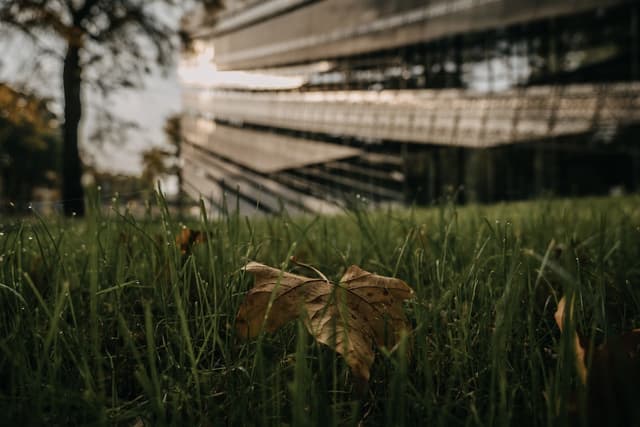
Museum of Ethnography
@pedralexpereira
The Museum of Ethnography (Néprajzi Múzeum) in Budapest stands as a prominent institution preserving Hungary's rich cultural heritage and ethnographic diversity. Established in 1872 as a department of the Hungarian National Museum, it became an independent entity in 1947. Over its history, the museum has faced numerous relocations, reflecting both its growing collections and the challenges of maintaining adequate facilities. Since May 2022, the museum resides in a state-of-the-art building in City Park, designed by Napur Architect Ltd., offering a modern space for exhibitions and research.
The museum houses an extensive and diverse collection representing both Hungarian and global cultures. Its African, Asian, Oceanic, and American collections include tens of thousands of artifacts, many gathered during the late 19th and early 20th centuries, offering rare insights into the traditions and daily lives of various communities. The European collection, with a particular focus on the Finno-Ugric peoples and the diverse ethnic groups of the former Austro-Hungarian Monarchy, highlights embroidered textiles, ceramics, musical instruments, and decorative objects that reflect centuries of craftsmanship and cultural exchange.
In addition to its international scope, the museum plays a crucial role in documenting and preserving the traditions of the Carpathian Basin. Its Hungarian collections, spanning from the 17th to the 20th century, capture the lifestyle and artistry of peasant communities before the transformative effects of modernization and urbanization. These include tools and objects associated with agriculture, animal husbandry, crafts, and daily life, alongside an impressive array of textiles, costumes, and ceramics.
The museum's dedication extends to intangible cultural heritage. It safeguards invaluable sound recordings by notable figures such as Béla Bartók and László Lajtha, who documented the music of Hungarians and other ethnic groups in the region. The collection of 4,500 phonograph cylinders, along with tens of thousands of analogue recordings, underscores the museum's commitment to preserving traditional music and oral traditions.
The Ethnological Archives add further depth with a Film and Video Collection dating back to the 1930s, a Photograph Collection of 340,000 items, and a Manuscript Collection containing 30,000 pieces. These archives, combined with a library of nearly 200,000 volumes, make the Museum of Ethnography a hub for researchers and scholars worldwide.
Beyond its collections, the museum's mission extends to engaging the public through exhibitions, educational programs, and cultural events. Its efforts to preserve and present the vibrant cultural mosaic of Hungary and the world make it a vital institution for understanding human creativity and diversity.

Details
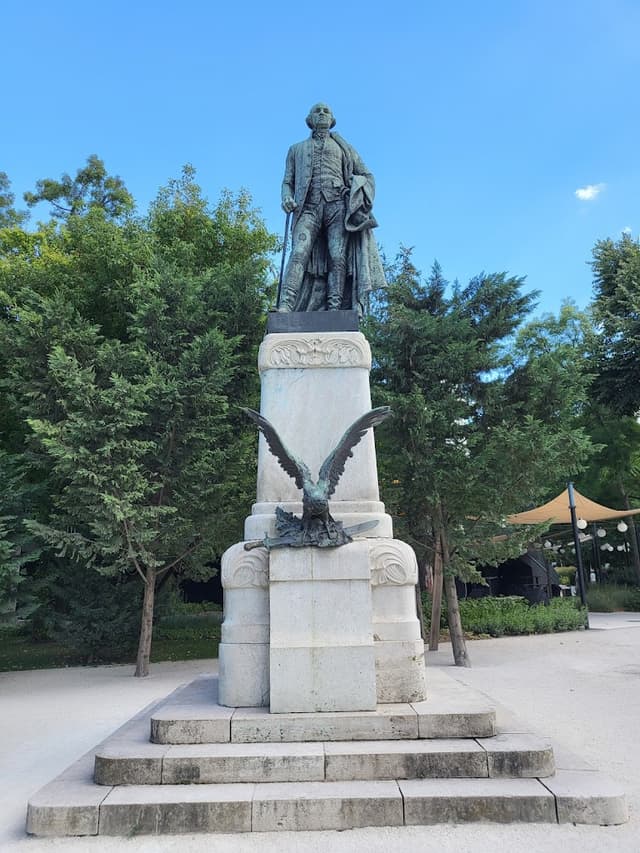
George Washington Statue
@pedralexpereira
The George Washington Statue in Budapest is a powerful symbol of unity between Hungary and the United States, celebrating shared ideals of democracy and freedom. Its origins trace back to the early 20th century when Hungarian-American leaders sought to honor George Washington, the "Father of American Democracy," as a counterpart to the statue of Hungarian revolutionary leader Lajos Kossuth erected in Cleveland. This initiative reflected a mutual respect for each nation’s historical struggles for independence and self-determination.
Announced by Kohányi Tihamér and Marcellus Ujlaky at a ceremony in Budapest's Grand Central Palace, the project quickly gained momentum. Count Albert Apponyi, speaking at the event, eloquently connected the American fight for liberty with European aspirations, emphasizing the inspiration that the United States provided to those in less free nations. Fundraising efforts spearheaded by the American Hungarian Federation (AHF) successfully financed the statue, which was unveiled on September 16, 1906, in City Park (Városliget) amidst significant fanfare. Thousands of Hungarians and Hungarian-Americans attended the event, with a parade through the streets of Budapest displaying American and Hungarian flags intertwined.
The unveiling ceremony underscored the profound gratitude Hungarian immigrants felt toward the United States for providing opportunities and refuge, especially following Hungary’s failed revolutions of 1848 and 1956. The statue’s dedication also served to commemorate the democratic values shared by both nations. Figures such as future President Grover Cleveland and William Jennings Bryan supported the effort, emphasizing the statue's symbolic importance.
The connection between Hungary and the United States deepened over time, with annual wreath-laying ceremonies honoring George Washington’s legacy. At the centennial commemoration in 2006, U.S. Ambassador George Walker drew parallels between the American Revolution and Hungary’s fights for independence. He highlighted the courage and resilience of both nations’ heroes, noting how their struggles for freedom resonated globally.
The statue stands not only as a tribute to Washington but also as a testament to the enduring friendship between Hungary and the United States. Hungarian leaders, U.S. officials, and citizens continue to celebrate the monument as a beacon of democratic values, commemorating the sacrifices made by those who fought for liberty. It remains a poignant reminder that the quest for just governance and civil rights is a shared human endeavor.

Details

House of Music Hungary
@pedralexpereira
The House of Hungarian Music, nestled within Budapest's vibrant City Park, transcends the conventional role of a museum, embodying a holistic vision where music, culture, nature, and innovation converge. Designed to immerse visitors in the very essence of sound, this dynamic space invites active participation rather than passive observation. The experience here is fluid and organic, mirroring the natural ebb and flow of life in the park, where visitors wander freely, much like sound moves through space—unbounded, resonating, and ever-changing.
This 21st-century museum is a harmonious extension of its environment. It blends seamlessly into the park's landscape, its ecological design complementing the natural surroundings while fostering an inclusive space for learning, performing, and sharing. By breaking down traditional barriers, both physical and conceptual, the museum becomes a symbol of connectivity—reflecting the freedom of movement and exchange in the modern world.
Inspired by the abundant trees of City Park, the museum draws parallels between its architecture and the forest canopy. The dense foliage of the park forms a protective embrace, with occasional openings that allow sunlight to filter through—a motif echoed in the museum’s design. The interplay of light and shadow, structure and openness, creates a sanctuary that is simultaneously rooted in history and forward-looking, celebrating the rhythm of nature alongside the universal language of music.
In this space, architecture becomes a sensory journey, one that resonates with the visitor’s curiosity and creativity. Whether one comes to study, perform, listen, or simply be, the House of Hungarian Music fosters a shared experience—a testament to the unifying power of sound and the enduring connection between people, culture, and the natural world.

Details
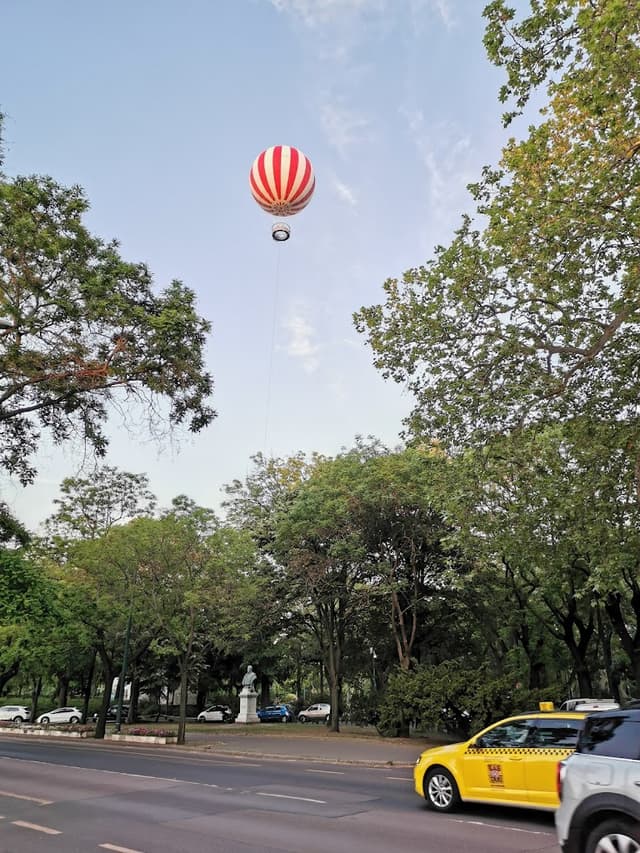
City Park
@pedralexpereira
Spanning 302 acres (1.2 square kilometers), this rectangular park is situated in District XIV, bounded by prominent city roads including Dózsa György út and Hungária körút. Its main gateway, Heroes’ Square (Hősök tere), is a UNESCO World Heritage site, providing an iconic entry point to this vibrant urban oasis.
Originally called Ökör-dűlő, or "Oxmeadow," the park's history dates back to medieval times, with its earliest recorded mention in 1241. By the 18th century, the area had evolved into a scenic landscape under the name Batthyány-erdő (Batthyány Forest), after its notable tenants, the Batthyány family. The transformation into a public park began in 1751 with the planting of trees and the creation of walkways. By the early 19th century, it was officially named Városliget, a nod to its role as one of the earliest public parks globally.
City Park gained prominence as the centerpiece of Hungary’s 1896 millennium celebrations. At this pivotal time, Budapest unveiled architectural and infrastructural marvels such as Andrássy Avenue, the Millennium Underground Railway, and the Grand Boulevard, linking the park to the city's core. This period marked the park’s rise as a cultural hub, an identity it maintains today.
The park's historical significance extends to its role as a motorsport venue during the 1950s and its ongoing transformation under the Liget Budapest Project. This ambitious initiative aims to restore and enhance the park’s green spaces while introducing cutting-edge cultural institutions like the House of Hungarian Music and the Museum of Ethnography.

Details
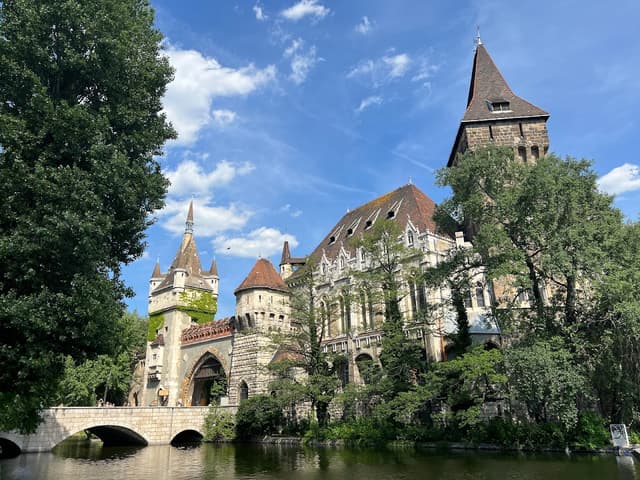
Vajdahunyad Castle
@pedralexpereira
Originally constructed in 1896 for the Millennial Exhibition celebrating Hungary's thousand-year anniversary, the castle was designed by Ignác Alpár as an homage to various architectural styles and historic edifices of the Kingdom of Hungary. Chief among these inspirations was Hunyad Castle, or Corvin Castle, located in present-day Hunedoara, Romania. Initially built from cardboard and wood, the castle's popularity led to its reconstruction in stone and brick between 1904 and 1908.
A unique feature of Vajdahunyad Castle is its amalgamation of Romanesque, Gothic, Renaissance, and Baroque styles, each represented in different sections of the structure. This eclectic design mirrors Hungary's rich and diverse architectural heritage, making it a visual journey through time. Today, the castle is home to the Museum of Hungarian Agriculture, the largest institution of its kind in Europe, offering insights into the country’s agrarian history and traditions.
Within the castle grounds, visitors encounter the statue of Anonymus, created by sculptor Miklós Ligeti. This enigmatic figure, a notary of King Béla III in the 12th century, authored the Gesta Hungarorum, a chronicle of Hungary's early history. The mysterious aura surrounding Anonymus has made his statue a favorite for those seeking inspiration or a touch of legend.
Adding a cinematic connection to the site, the castle’s exterior features a bust of Béla Lugosi, the Hungarian-American actor famed for his portrayal of Count Dracula in the 1931 film. This nod to a figure of Hungarian heritage enhances the castle's appeal for film enthusiasts and history buffs alike.

Details
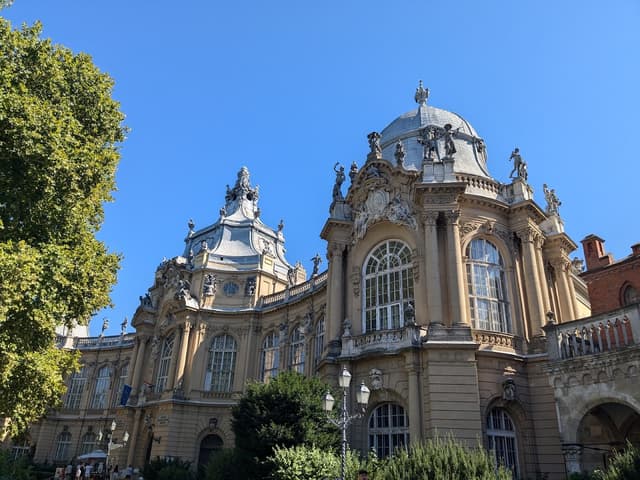
Museum of Hungarian Agriculture
@pedralexpereira
While its Eastern European Baroque design may seem timeless, the castle is, in fact, a replica of a much older fortress in Transylvania, Romania. Originally constructed from cardboard and wood as a temporary exhibit for Hungary’s Millennial Exhibition in 1896, the castle's charm captured the hearts of visitors, leading to its reconstruction in stone and brick by 1908. Today, it stands as a permanent and beloved feature in the park, housing the Hungarian Agricultural Museum.
The museum's location inside the castle adds to its appeal, with visitors not only exploring exhibits of agricultural history but also stepping into the magnificent, almost fantastical architecture of the castle itself. The structure is a blend of artistic and natural elements, featuring lush gardens, tranquil ponds, and the towering, ornate stonework that lends an almost magical quality to the space.
One of the most intriguing sections of the museum is the "Hall of Hunting." Upon ascending a grand staircase, visitors are met with a striking collection of antlers, horns, and mounted animal heads, including bears and birds. The hall is adorned with intricately crafted objects such as antler chandeliers, fox-carved cutlery, and even antler furniture, creating a surreal atmosphere. The vaulted ceilings and stained-glass windows enhance the room’s ethereal ambiance, while the museum's relative quietness gives it the feeling of a sacred space dedicated to the relics of a long-forgotten hunting deity.
Despite its current beauty, the Agricultural Museum's collection has faced significant hardships. The museum has been destroyed and rebuilt not once but twice—first during World War II and again following the Hungarian Uprising of 1956, when the museum's treasures were ravaged during the conflict. However, through years of effort, donations, and restoration, the museum has regained its former glory, and today, the Hall of Hunting remains a testament to Hungary's rich agricultural and natural heritage.

Details
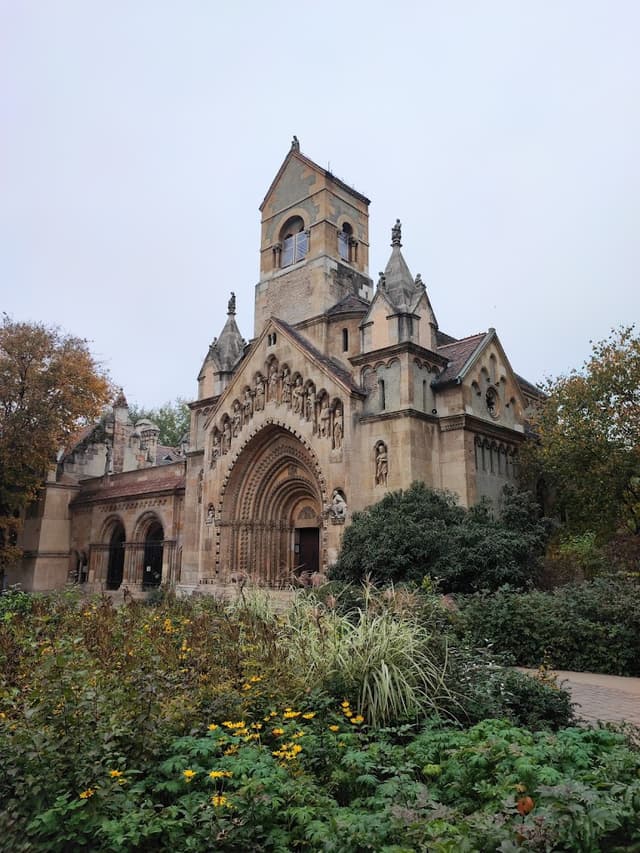
Jaki Chapel
@pedralexpereira
Opposite Vajdahunyad Castle, nestled within the lush greenery of City Park, stands the charming Ják Chapel, a small but captivating structure with a history steeped in Hungarian heritage. The chapel’s most striking feature is its intricately detailed portal, which was meticulously copied from the 13th-century Abbey Church in Ják, located in western Hungary. This Gothic portal, with its elaborate carvings and layered arches, brings a touch of medieval craftsmanship to Budapest, serving as a quiet testament to Hungary’s architectural history.
While the exterior is visually captivating, the interior of the chapel is far more modest in comparison. It lacks the grandeur and intricate decoration of its façade, offering a simple and peaceful space that contrasts with the ornate details of the portal. The chapel’s peaceful location, surrounded by the overgrown, jungle-like cloister, adds to its charm, making it a serene spot in the park for reflection or a brief escape from the bustle of the city.

Details
Gatehouse Tower
@pedralexpereira
The tower is part of the castle's complex and stands as a picturesque and imposing entrance to the grounds. The Vajdahunyad Castle itself, a notable landmark in Budapest, was built in 1896 for the Hungarian Millennium Exhibition and features a mix of architectural styles that represent various historical periods of Hungary. The Gatehouse Tower contributes to this architectural variety, which includes Romanesque, Gothic, Renaissance, and Baroque elements.
The Gatehouse Tower is designed to resemble a medieval fortress entrance, featuring defensive-style elements like crenellated walls and a large arched doorway. This was intended to evoke the feeling of a traditional castle gate, welcoming visitors to the castle grounds. The tower, along with the rest of the castle, is made from stone, but like much of the castle complex, it was initially constructed using temporary materials for the exhibition, later being rebuilt in a more permanent form.

Details
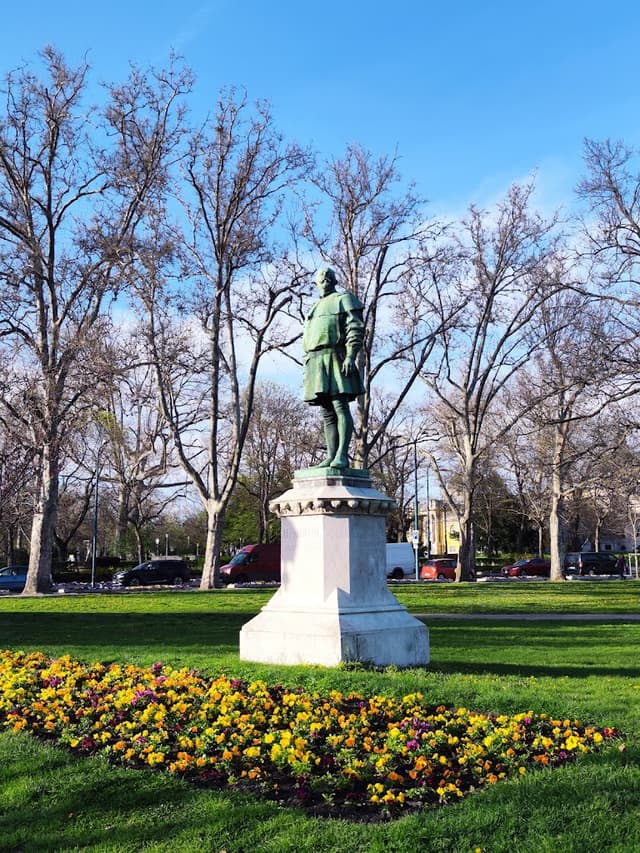
Alpár Ignác Statue
@pedralexpereira
Alpár Ignác was a renowned Hungarian architect, and while there is no widely recognized statue of him specifically in Budapest, his legacy is preserved through his architectural works, including some of the city's most notable landmarks. Alpár designed many significant buildings and structures in Budapest, especially during the late 19th and early 20th centuries, and his work is integral to the city’s architectural identity.
One of his most famous designs is the Vajdahunyad Castle in City Park, which was initially built as part of the Hungarian Millennium Exhibition in 1896. The castle, with its eclectic architectural style blending Romanesque, Gothic, Renaissance, and Baroque elements, is one of Budapest’s most iconic landmarks and continues to be a symbol of Alpár’s architectural talent.
Although Alpár Ignác may not have a dedicated statue in Budapest, his contributions to the city’s architecture are honored through the buildings he left behind, which remain part of Budapest's cultural and historical fabric.

Details
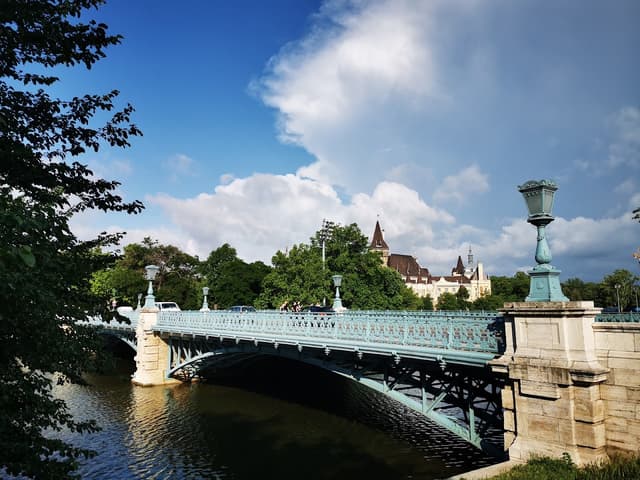
Zielinski Bridge
@pedralexpereira
The Zielinski Bridge (formerly known as the Millennium Bridge) is an important metal-framed bridge located in Budapest's City Park, connecting the Kós Károly Promenade with Heroes' Square over the City Park Lake. The bridge was constructed in time for Hungary's 1896 millennium celebrations, marking 1,000 years since the Hungarian Conquest of the Carpathian Basin.
The design competition for the bridge was initiated by Ernő Dániel, Hungary's Minister of Trade, with the goal of creating an 82-meter-long bridge with a 10 + 2×3-meter-wide roadway. The bridge's design was ultimately selected from several submissions, and Szilárd Zielinski's iron-framed design was chosen for implementation. Zielinski oversaw the bridge’s construction, which was carried out by the Ganz Danubius factory. The foundations were made of concrete, with the pillars adorned in carved limestone. The roadway was originally paved with larch blocks, while the sidewalks were covered in asphalt.
The cost of the bridge's construction was 169,000 forints, slightly exceeding the initial budget due to the ornate railings and lighting fixtures added to the design. The bridge has undergone several renovations over the years, including a major reconstruction in 1929 when the road and sidewalk were replaced with a reinforced concrete track. The bridge suffered no damage during World War II, though some lamps were replaced with those from the destroyed Chain Bridge.
In the latter half of the 20th century, the bridge continued to require maintenance, including multiple painting projects (1952, 1969) and railing repairs (1976). A more significant renovation took place in 1981 to address corrosion and increased traffic. During this time, the bridge’s metal structure was reinforced, and the roadway was insulated.
In 1994, the bridge was officially renamed the Zielinski Bridge to honor Szilárd Zielinski, the bridge's original designer, on the 70th anniversary of his death.
Most recently, in 2005, the bridge underwent another renovation lasting 3.5 months. This renovation focused on replacing the insulation and expansion joints, as well as repairing the pillars and parapets. The bridge currently has a weight limit of 3.5 tons for freight traffic, ensuring that it remains a reliable and historic structure for pedestrians and light traffic alike.

Details
Széchenyi Thermal Bath Park
@pedralexpereira
The Széchenyi Thermal Bath Park is the area surrounding the Széchenyi Thermal Bath, located in City Park (Városliget) in Budapest, Hungary. The Széchenyi Bath itself is one of the largest and most famous thermal spas in Europe, renowned for its grand Neo-Baroque architecture and therapeutic thermal waters. The park area surrounding the bath offers a relaxing and scenic environment that enhances the overall experience of the spa.

Details
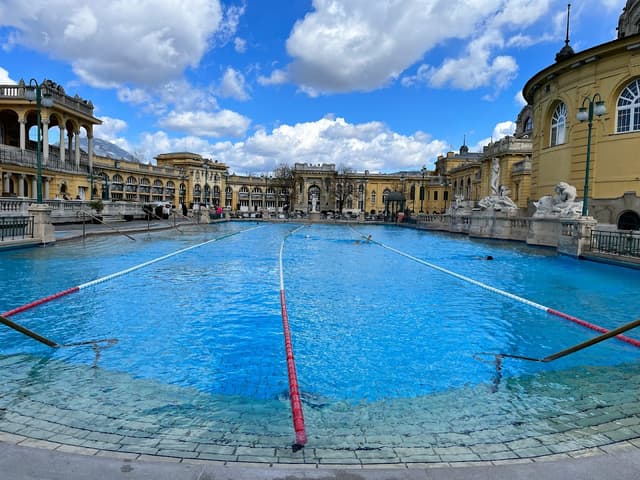
Széchenyi Thermal Bath
@pedralexpereira
The Széchenyi Medicinal Bath (Hungarian: Széchenyi gyógyfürdő) in Budapest is the largest medicinal bath in Europe, renowned for its therapeutic thermal waters. Located in the City Park, the bath's waters are sourced from two thermal springs, one at 74°C (165°F) and the other at 77°C (171°F). These thermal waters are rich in sulfate, calcium, magnesium, bicarbonate, metaboric acid, and fluoride, which are believed to have various health benefits.
The bath’s origins trace back to the late 19th century. In 1865, Vilmos Zsigmondi drilled a deep well under City Park to access the thermal water, reaching a depth of 975 meters (3,200 feet). This well became the primary source for the bath's therapeutic waters.
Initially planned as the Artesian Spa in the 1880s, it was officially named Széchenyi Spa upon its grand opening on June 16, 1913, in honor of István Széchenyi, one of Hungary’s most prominent historical figures. Designed by architect Győző Czigler in the Neo-Baroque style, the construction of the bath began in 1909, and it was completed with a budget of approximately 3.9 million Austro-Hungarian korona. The bath complex spanned over 6,220 square meters (67,000 square feet) and was immediately popular, with over 200,000 visitors in the first year.
In the following decades, the bath expanded to meet growing demand, with the complex growing in size and adding more pools. In 1938, a second thermal spring was discovered at a depth of 1,256 meters (4,121 feet), providing a significant increase in the daily supply of hot water, which now totals 6,000,000 liters (1.6 million US gallons) per day.
The Széchenyi Bath underwent a major renovation between 1999 and 2009, restoring its facilities and ensuring its continued popularity as a wellness destination.
The Széchenyi Bath offers a wide range of pools with varying temperatures. The outdoor pools include a swimming pool and an adventure pool with temperatures ranging from 27°C to 38°C (81°F to 100°F). The thermal sitting pool provides a relaxing experience in warm waters. The indoor pools have temperatures between 18°C and 38°C (64°F and 100°F), catering to a variety of preferences. The complex also features saunas and steam rooms for added relaxation.
For those seeking additional wellness experiences, the bath also provides whirlpool features, water streams, and massaging water beams. The combination of thermal baths, modern amenities, and beautiful historic surroundings makes Széchenyi a popular and unique destination for relaxation and rejuvenation.

Details

Capital Circus of Budapest
@pedralexpereira
The Capital Circus of Budapest is a historic circus building located in Városliget, Budapest's City Park. Known for its distinctive architecture and its status as the only stone circus in Central Europe, it is a major cultural venue in the city. The circus is home to a variety of performances, including animal acts, clown shows, artistic performances, and other special events like concerts, theater productions, and even fashion shows.
The current building, which opened in 1971, is a permanent structure that is independent of the weather. This allows the circus to hold events throughout the year, in both summer and winter. The circus can accommodate up to 1,450 people, offering an intimate yet spacious setting for its diverse array of performances. While it originally focused on traditional circus acts, today the Capital Circus hosts a wide range of events, including classical music concerts, pop music performances, folk dance shows, and even sporting events and opera.
The first iteration of the Capital Circus was opened in 1889 by the German-Dutch circus director Ede Wulff. It was located in the same area of Városliget, with a capacity of 2,290 seats. The building served as the city's main circus venue for many years. In 1896, a competing venue, the Ősbudavára Club, was established nearby in the Zoo area, offering entertainment that drew some attention away from the circus. However, the Capital Circus continued to thrive under various managements. The circus underwent significant renovations, especially under the ownership of Matvey Beketov in 1904, when it was renamed Beketow Circus. It became a popular venue for world-class acts until the mid-20th century.
The circus was closed during World War II and, after some tumultuous years, was reopened in 1945. During the 1950s, it was nationalized, and by 1971, the current stone building was inaugurated, marking a new era for the circus. The Capital Circus of Budapest continues to be a beloved part of the city's entertainment scene, combining tradition with modern versatility to host a wide variety of performances year-round.

Details
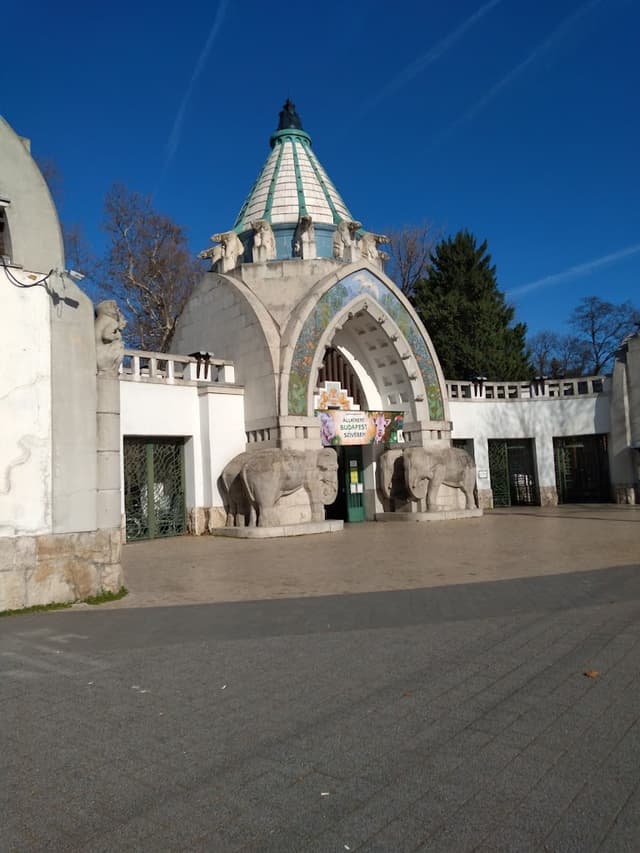
Budapest Zoo & Botanical Garden
@pedralexpereira
The Budapest Zoo & Botanical Garden, established in 1866, is the oldest zoo in Hungary and one of the oldest in the world. Located in the City Park, it is home to over 1,000 animal species and attracts around 1 million visitors each year. The zoo is known for its Art Nouveau architecture, designed by Kornél Neuschloss and Károly Kós, and its unique collection of animals, including the Komodo dragon and the wombat.
The zoo's founding idea dates back to the 1820s, and it officially opened in 1866, initially showcasing Hungarian species and exotic animals like monkeys, parrots, and camels. Over time, the zoo expanded its animal collection, with notable donations from Franz Joseph and Queen Elizabeth. The zoo struggled financially in its early years, leading to the involvement of entertainers and a shift towards an animal and plant naturalizing company.
In 1907, the zoo was taken over by the city of Budapest and underwent major reconstruction, reopening in 1912 with modern facilities. The zoo was heavily damaged during World War II, with most of its buildings and animals destroyed. After the war, it reopened with a small number of animals, and significant modernization took place in the following decades.
By the 1990s, the zoo had once again become a leading institution in Europe. It underwent further modernization, with the animal habitats being expanded and naturalized. In 2007, the zoo achieved a major milestone with the birth of the first rhinoceros conceived through artificial insemination. New attractions such as The Magical Hill and the America Tropicana exhibit were added in the 2010s, showcasing the zoo’s commitment to education and conservation.
The zoo also expanded its footprint, taking over part of the Budapest Amusement Park's territory in 2012. The exhibits include the Savannah Zone, Australia Zone, and India Zone, each dedicated to specific regions and their native animals. The zoo also houses a wide variety of primates, including gorillas, orangutans, lemurs, and tamarins, offering a comprehensive and engaging experience for visitors of all ages.

Details
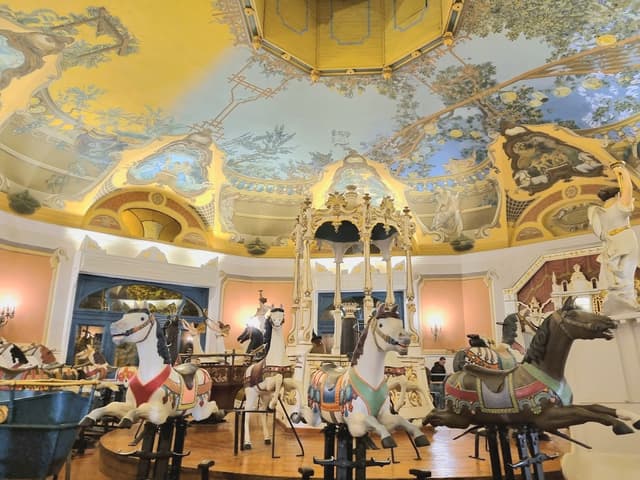
Körhinta (Budapest)
@pedralexpereira
The Art Nouveau-style Korhinta carousel, dating back to 1906, was a cherished attraction at the Budapest Amusement Park (Vidám Park) until its closure in 2014 when the park was absorbed into the Budapest Municipal Zoo for expansion. The carousel, which was last restored in 1996, earned the prestigious Europa Nostra Award in 1997 for its exceptional preservation of cultural heritage. The carousel's restoration revealed several fascinating details: multiple layers of paint on the horses and carriages, and the discovery that the inner row of horses had been moved from another carousel and were older than the rest.
The original power mechanism for the carousel came from horses hidden beneath the platform. During the 1996 restoration, the carousel was carefully stripped and renovated, funded in part by donations. The design of the carousel is unique, as the outer row of horses faces outward, perpendicular to the direction of movement, and features spring-like mechanisms that allow them to move forward and backward. This design mimics the motion of a Derby Racer, adding to the ride's charm. Along with the ornate horses, the outer row also includes chariots and rocking boats, while the inner row contains more static horses and spinning tubs.
The horses themselves are highly detailed, carved into prancing and jumping poses, while the ornate building housing the carousel boasts a beautifully decorated interior, including a lavishly adorned ceiling. The carousel remains a beloved example of Budapest’s rich cultural and historical heritage, continuing to be preserved as part of the zoo’s expansion plan.

Details
BalloonFly
@pedralexpereira
BalloonFly Budapest offers a unique aerial experience, taking visitors to a height of 150 meters for an unforgettable view of the city. On clear days, the view stretches up to 20 kilometers, with the possibility of even spotting the distant snowy peaks of the Tatra Mountains. From the basket, passengers are treated to a bird’s-eye view of iconic landmarks such as the Széchenyi Thermal Bath and Heroes’ Square, along with a host of other fascinating sights that are rarely seen from such a perspective. This balloon ride provides a fresh and exhilarating way to explore Budapest’s landscape.

Details
Erzsébetváros
Erzsébetváros is one of Budapest's most eclectic and rapidly changing districts, located in the heart of the Pest side. Known as the 7th District, it is a vibrant mix of residential areas, cultural sites, and nightlife hotspots, attracting a diverse crowd of locals, tourists, and young professionals. The district was named after Queen Elisabeth of Hungary, often referred to as Sisi, the beloved consort of Emperor Franz Joseph I. Erzsébetváros has deep historical roots, originally developed in the 18th century as part of the city’s expansion beyond its medieval boundaries. Over time, it became a melting pot of different cultures, ethnicities, and social classes, and this diversity still characterizes the area today.
Erzsébetváros is famous for its Jewish Quarter, home to the Dohány Street Synagogue, the largest in Europe, and the Jewish Museum. The area is also dotted with historic buildings, including traditional Jewish courtyards and beautiful Art Nouveau structures. In recent years, Erzsébetváros has undergone significant gentrification, transforming from a historically working-class neighborhood into one of the city’s most fashionable districts. Its vibrant nightlife scene, particularly around Ruin Pubs like Szimpla Kert, has drawn international attention, making the district a focal point for Budapest’s young, alternative crowd. The area also offers a mix of trendy cafes, independent boutiques, and street art, alongside historical sites that highlight Budapest’s rich Jewish heritage. Erzsébetváros remains a dynamic and energetic part of the city, where the past and present blend together seamlessly, offering visitors a glimpse into Budapest’s evolving identity.
See&Do
Róth Museum
@pedralexpereira
Miksa Róth, a highly regarded applied artist, contributed to the decoration of numerous public and private buildings in Budapest. In 1910, he acquired a property on Nefelejcs Street, where the street-facing building served as the Róth family’s residence, while the courtyard workshop was dedicated to creating stunning glass paintings and mosaics. Today, the memorial house preserves three rooms in their original state, offering visitors a glimpse into the life of this influential artist. Some of Róth’s remarkable glass artworks are also on display, allowing for a unique opportunity to step back in time and experience the artist’s home and craftsmanship.

Details
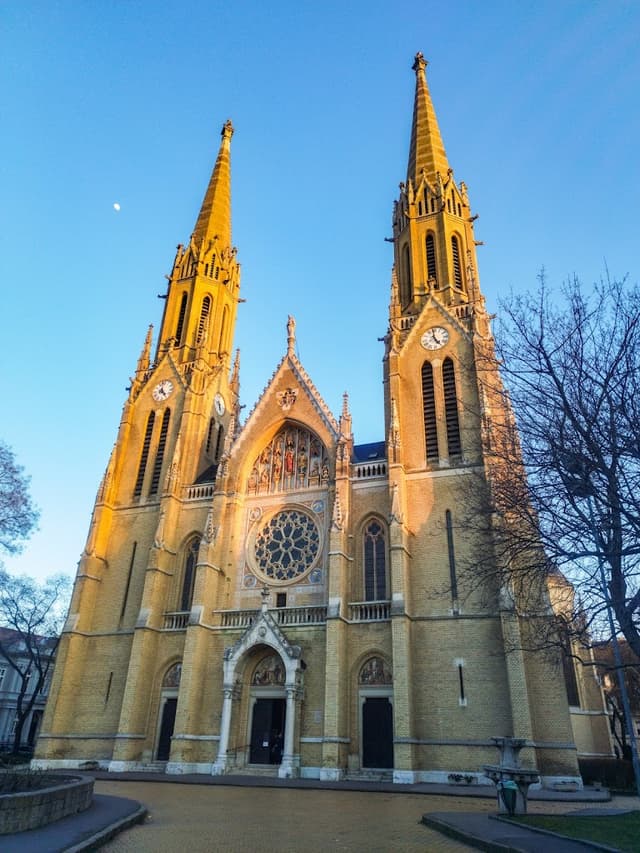
St. Elizabeth Parish Church of the Árpád House in Budapest
@pedralexpereira
The Árpád-házi St. Elizabeth Parish Church, also known as the Erzsébetváros Parish Church, is a Roman Catholic church located in the VII District of Budapest, near Rákóczi Street and Rózsák Square. Built between 1895 and 1901 based on the neo-Gothic plans of Imre Steindl, it is the second largest church in the district and one of its most significant landmarks. The church is dedicated to Saint Elizabeth of the Árpád dynasty.
The history of the church begins in 1881, when the citizens of the newly formed VII District, Erzsébetváros, built a small Roman Catholic church on the north side of Szegényház Square, later known as Rózsák Square. However, as the area rapidly grew, the small church became insufficient. The Roman Catholic Church acquired the central plot of the square in 1889, and a new church building committee was formed. In 1892, the neo-Gothic design of Imre Steindl was accepted, and construction began in 1893. The ceremonial laying of the foundation stone, which took place in 1895, was attended by Emperor Franz Joseph I. The church was consecrated on May 16, 1901, and named after Saint Elizabeth. The original small church was later handed over to the Hungarian Greek Catholic Church in 1905.
The church's growth mirrored that of the district, and in 1918, the parish named after Saint Elizabeth was established. A statue of Saint Elizabeth by József Damkó was erected in 1932 in front of the church, and the square was renamed Rózsák tér in her honor. During World War II, the church was damaged by bombing, but restoration work was completed by 1949. Despite further deterioration in the following decades, the church was granted monument status in 1995, and extensive renovations began under the leadership of parish priest Antal Spányi. The renovation was completed in 2004, along with the landscaping of the surrounding park.
The church features two towers at its northwestern corner, each standing 76 meters high. The church's total length is 62 meters, with a floor area of 1,800 m², and it can accommodate nearly 2,600 people. The building's design draws inspiration from French Gothic traditions while incorporating modern technical solutions. The façade includes a statue of Saint Elizabeth by György Kiss, as well as statues of Saint László, the Virgin Mary, and Saint Stephen by Miklós Köllő. The church's interior is marked by puritanical design, with decorative columns supporting the vaulted ceiling. Notable features include stained glass windows, a pulpit with reliefs of the four evangelists by Sándor Hauszmann, and altars created by Mór Hölzel, Gyula Aggházy, and Lóránt Zubriczky. The main altar, made of marble, onyx, and bronze, houses images of Hungarian saints.

Details
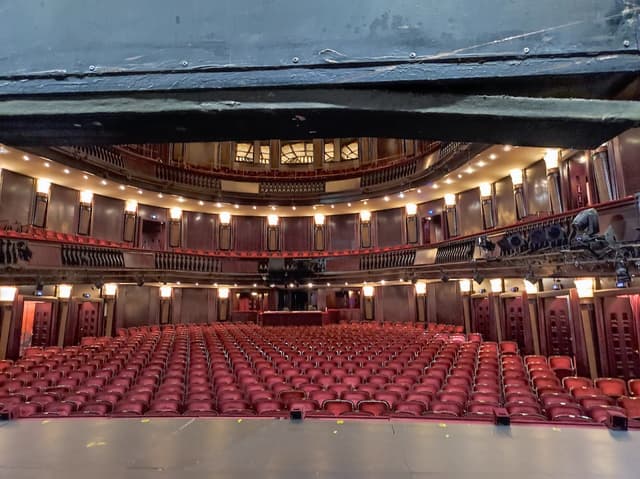
Madách Színház
@pedralexpereira
The first Madách Theatre emerged in 1919 in the small hall of the Music Academy, a company primarily composed of actors who had returned from the front lines after World War I. This group, representing the intellectual heirs of the Thalia Company, focused on presenting works by Hungarian authors as well as modern European playwrights. Their most notable success was Tomorrow Morning by Frigyes Karinthy, which premiered on March 5, 1919, and ran for 100 performances. However, this theatre was short-lived, operating only for a little over a year before being evicted from the Academy of Music in March 1920. Their final performance was Dangerous Man by Nándor Korcsmáros.
In 1940, a new Madách Theatre opened in the building at Madách tér, originally designed as a cinema by Gedeon Gerlóczy. István Károlyi, who purchased the building, relaunched the Madách Theatre with a 600-seat capacity. Its first performance on November 29, 1940, was Little Bird by Zsigmond Móricz, with Margit Dajka in the lead role. However, the theatre’s early years were challenging. In 1941, under the management of Andor Pünkösti, a well-known critic and director, the theatre adopted an anti-fascist stance and revived its programming with a fresh spirit. Pünkösti staged Luigi Pirandello's Henry IV, which premiered on September 19, 1941, and was a major success.
The theatre’s dramaturgy, overseen by the esteemed theatre historian Géza Staud, aimed to bridge the gap between theatre and literature. Staud also helped launch the Madách Library, a 15-volume series of theatrical works that contributed to the intellectual foundations of the theatre’s programming. Other notable figures in the early years included Zoltán Várkonyi, Jenő Danis, and Zita Szeleczky. The theatre built a reputation for intimate performances and was committed to producing classical, contemporary world literature, and Hungarian drama.
The Madách Theatre’s programme was heavily influenced by its desire to offer an intellectual and artistic platform, with a focus on psychological depth and direct audience engagement. Despite the challenges of working with a small stage, directors and designers constantly pushed the boundaries of set and costume design. For instance, Álmos Jaschik and his wife were frequent set and costume designers, alongside other talents such as Tibor Bercsényi and Miklós Neogrády.
The theatre also fostered a studio for young artists, emphasizing voice training, physical exercise, and miming, preparing them for the challenges of performing in intimate settings. Over the years, the theatre has evolved into one of Budapest’s most important cultural institutions, continuing its legacy of presenting powerful and thought-provoking works.

Details
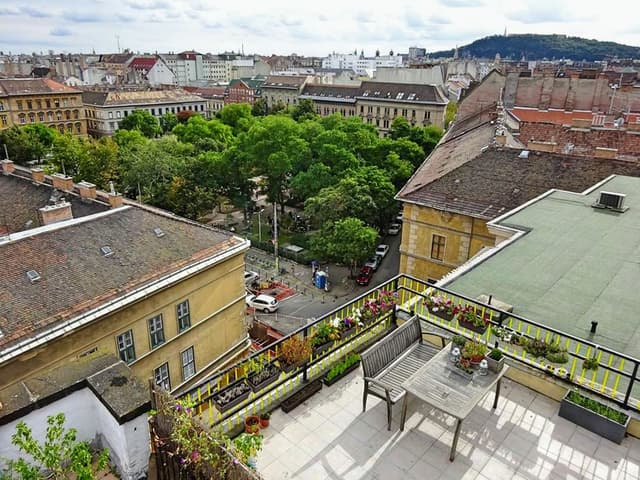
Klauzál Square
@pedralexpereira
The square’s original name was Stephans Platz, and it was later renamed István tér in 1874. In 1907, the square was given its current name in honor of Gábor Klauzál, a prominent Hungarian politician and a key figure in the Reform Era. Klauzál served as the Minister of Agriculture, Industry, and Trade during the pivotal year of 1848.
In 1872, a theater opened at Klauzál tér, but it was tragically destroyed by a fire in 1874. The site of the former theater was repurposed in 1897 for a shopping hall, which became the third such hall in Budapest. This marked a significant development in the commercial life of the area.
Jenő Brandi, a notable figure, lived in the area, and a plaque was later erected at Klauzál tér 9 in memory of Attila Gérecz, a martyr of the 1956 Hungarian Revolution, who was associated with the square. Another historical aspect of the square is its connection to Budapest’s public transportation system. The old tram No. 2 once passed through Klauzál tér, running from Keleti Railway Station to Angyalföld, adding to the square's role in the city’s connectivity.
Today, Klauzál tér remains a vibrant part of Budapest’s cultural and nightlife scene, reflecting both its historical significance and contemporary relevance. The square’s legacy as the heart of the Jewish quarter and its modern identity as a center for socializing and entertainment are central to its appeal.

Details
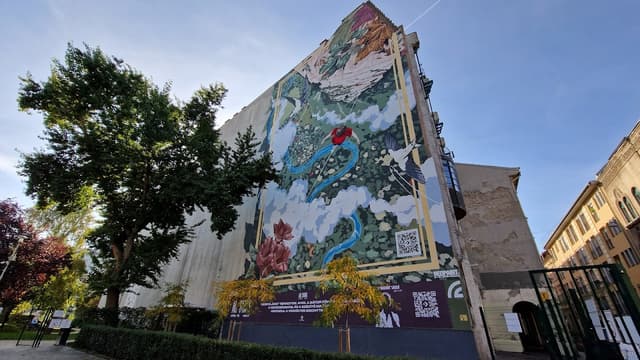
Downtown Janikovszky Park
@pedralexpereira
The park was named in honor of Ágnes Janikovszky to celebrate her contributions to Hungarian literature, particularly her popular children's books. Janikovszky's works often centered around the lives and thoughts of children, making her a cherished figure in Hungary. The park was designed as a tribute to her lasting legacy and influence on Hungarian culture and literature.
Janikovszky Park is a modest, yet beautifully landscaped area, with tree-lined paths, benches, and a tranquil atmosphere. The park provides a pleasant environment for relaxation, casual walks, and occasional outdoor activities. The greenery of the park offers a welcome escape for locals and visitors alike, providing a break from the urban bustle of downtown Budapest.
Despite its small size, the park is valued for its central location, offering a quiet respite in the heart of the city. The park often hosts events and community activities, particularly for families and children, in keeping with its literary inspiration.

Details
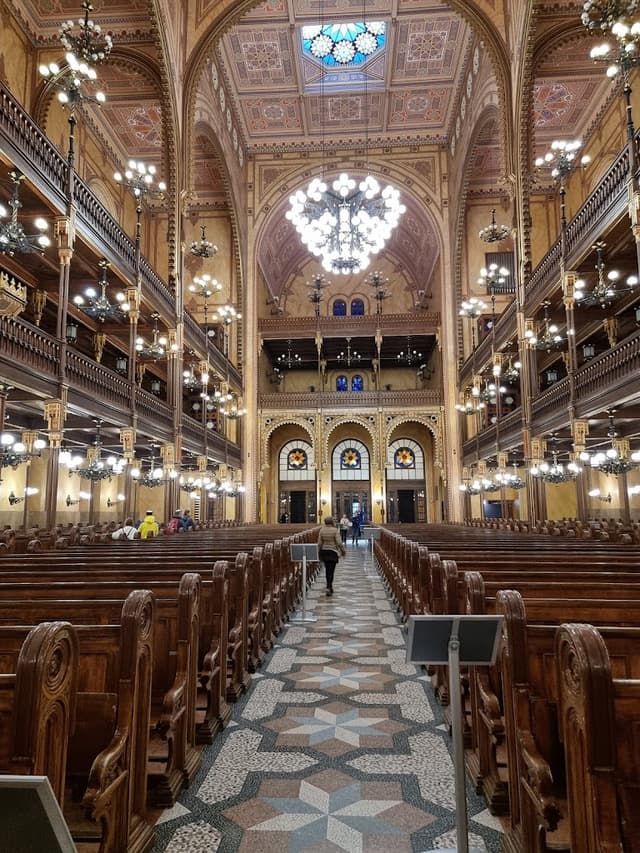
Dohány Street Synagogue
@pedralexpereira
Constructed between 1854 and 1859, the synagogue was designed by Ludwig Förster in a blend of Moorish Revival and Romantic Historicist styles, incorporating elements inspired by Islamic architecture from North Africa and medieval Spain, including the Alhambra. The synagogue was intended as a monumental statement of the Jewish community's presence in the city and was consecrated on September 6, 1859. At the time of its completion, it was the largest Jewish place of worship in the world.
During World War II, the synagogue suffered damage from bombing raids, particularly from the Hungarian pro-Nazi Arrow Cross Party. It was repurposed as a stable and radio base by the occupying forces. Despite this, it remained a place of prayer for the Jewish community during the Communist era. After the fall of Communism, extensive restoration efforts began in 1991 and were completed in 1998, funded through both state and private donations.
The Dohány Street Synagogue measures 75 meters (246 feet) in length and 27 meters (89 feet) in width, with its façade dominated by twin octagonal towers topped by onion domes. The design incorporates a mix of architectural styles, including Byzantine Revival, Romanesque Revival, and Gothic Revival, with the most prominent being the Moorish Revival, evidenced by the alternating red and yellow brickwork. The rose window above the main entrance and the presence of Jewish symbols, like the Star of David and the Stone Tablets, are part of the external decoration.
Inside, the synagogue features three aisles, with the seats arranged in a traditional manner, where men sit on the ground floor and women on the upper gallery. The interior is richly decorated with colored and golden geometric frescoes, and the Torah ark, designed by architect Frigyes Feszl, houses Torah scrolls salvaged from synagogues destroyed during the Holocaust.
One of the synagogue's unique features is its pipe organ, an instrument not commonly found in Jewish places of worship. The original organ, built in 1859, was played by composers such as Franz Liszt and Camille Saint-Saëns. A new 63-voice organ was installed in 1996, and it remains a significant part of the synagogue's musical heritage.
After decades of damage and neglect, the synagogue underwent a major renovation starting in the early 1990s, which was completed in 1998. The restoration was supported by the Hungarian government, as well as Jewish-American philanthropists such as Estée Lauder and Tony Curtis. Today, the synagogue complex includes the Heroes' Temple, a Jewish museum, and a cemetery, and serves as a major cultural and religious center for the Jewish community in Budapest.
The Dohány Street Synagogue remains one of the most important landmarks in Budapest, reflecting both the rich cultural heritage of Hungary's Jewish community and the resilience of its people through turbulent historical periods.

Details
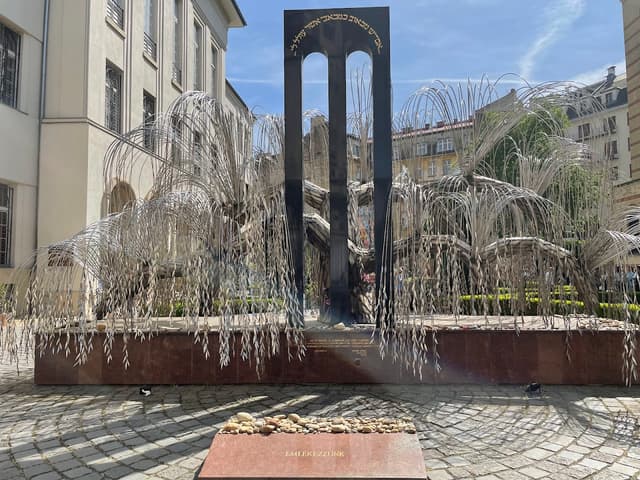
Raoul Wallenberg Holocaust Memorial Park
@pedralexpereira
The Raoul Wallenberg Emlékpark (Raoul Wallenberg Memorial Park) is located in the rear courtyard of the Dohány Street Synagogue and serves as a poignant tribute to the Hungarian Jewish martyrs of the Holocaust. The park includes the Memorial of the Hungarian Jewish Martyrs, a striking sculpture created by artist Imre Varga. The memorial is designed in the shape of a weeping willow, with the leaves inscribed with the names of victims, symbolizing the deep sorrow and loss of at least 400,000 Hungarian Jews who were murdered by the Nazis during the Holocaust.
In addition to honoring the Jewish victims, the park also commemorates Raoul Wallenberg, the Swedish diplomat who is famed for his courageous efforts to save tens of thousands of Hungarian Jews. Wallenberg, along with other figures recognized as Righteous Among the Nations, is celebrated in the park. The memorial also acknowledges individuals such as Swiss Vice-Consul Carl Lutz, Spanish Ambassador Ángel Sanz Briz, Italian diplomat Giorgio Perlasca, and Vatican Prelate Monsignor Angelo Rotta, all of whom played crucial roles in saving Jewish lives during World War II.
These figures are remembered for their bravery in providing protection to Jews, issuing false documents, and creating escape routes to safeguard lives during one of the darkest periods in history. Wallenberg and his peers’ actions exemplify selflessness, courage, and humanity, serving as a testament to the power of individual efforts in the face of systemic persecution.

Details
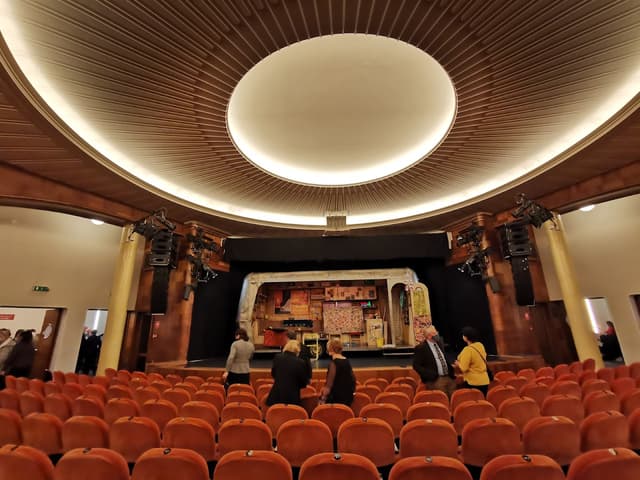
Belvárosi Színház
@pedralexpereira
Originally established in the early 20th century, the Belvárosi Színház has undergone several transformations over the years. It has been a significant cultural hub in Budapest, attracting audiences with a diverse range of theatrical productions, including both classic Hungarian works and international plays. The theatre's history is marked by its involvement in various periods of Hungarian history, including its adaptation during the socialist era and its resurgence in the post-communist period.
The Belvárosi Színház is known for hosting both dramatic plays and musical performances. Its modern program often features a mix of contemporary works, as well as timeless classics, offering a platform for both well-established and emerging Hungarian playwrights and directors.
The building itself reflects Budapest's architectural heritage, blending traditional elements with modern updates. The intimate size of the theatre allows for a closer, more personal experience between performers and audiences. Its design is functional yet inviting, with a focus on creating a comfortable environment for theatre-goers.
The Belvárosi Színház plays an essential part in Budapest's vibrant cultural life. Its central location in the city makes it a key stop for anyone interested in experiencing Hungarian theatre. The theatre attracts locals and tourists alike, contributing to the lively atmosphere of Budapest's cultural district.
Additionally, the Belvárosi Színház often organizes educational programs and events for young audiences, fostering a new generation of theatre lovers and performers.

Details
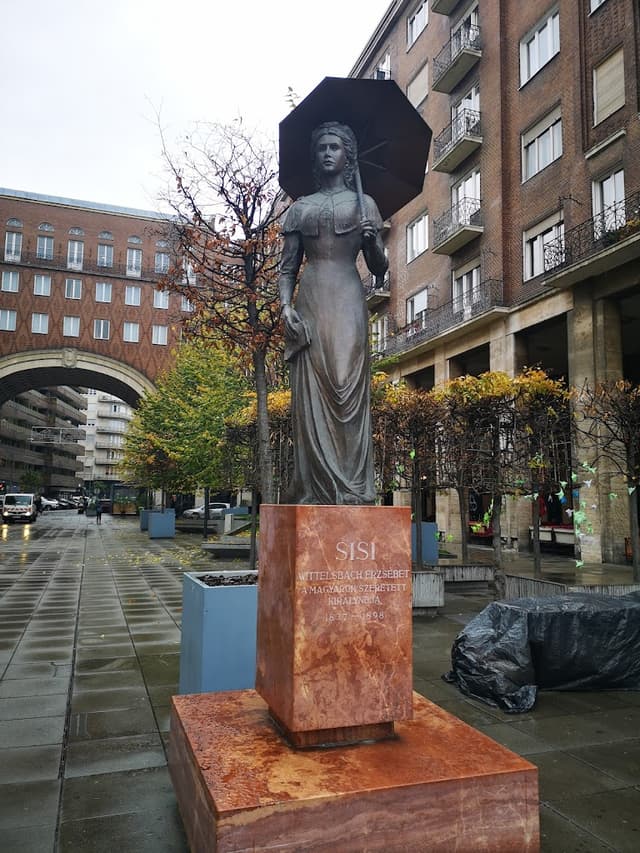
Sissi Statue
@pedralexpereira
The Sissi Statue (or Empress Elisabeth Statue) is a prominent monument in Budapest, Hungary, dedicated to Empress Elisabeth of Austria, often affectionately known as Sissi. Located in the Városliget (City Park) near the Széchenyi Thermal Bath, the statue honors one of Hungary’s most beloved historical figures, the wife of Emperor Franz Joseph I and the Queen of Hungary.
Empress Elisabeth of Austria (1837–1898) was a figure who captivated the hearts of many, both in Hungary and abroad. She became Queen of Hungary in 1867, during a period of political tension and transformation in the Austro-Hungarian Empire. Elisabeth was deeply fond of Hungary, its culture, and its people, which earned her immense popularity in the country. Her frequent visits to Budapest and her efforts to promote Hungarian causes cemented her legacy as a symbol of Hungarian identity and affection.
The Sissi Statue was erected in 1908, a decade after her tragic assassination in 1898, and it was placed in Városliget, a central park that has long been associated with Hungarian history and leisure. It stands as a tribute to her memory and her significant influence on Hungarian and European history.
The statue was designed by the Hungarian sculptor György Zala and depicts Empress Elisabeth in an elegant pose, wearing a flowing gown and looking serene. It reflects her graceful and dignified public image, with an emphasis on her elegance and regal presence. The statue is made of bronze, and its simplicity in design is contrasted by the elaborate surroundings of the City Park.
The statue is part of a larger tribute to Sissi's legacy in Budapest. The city's affection for the empress is further reflected in the presence of the Sissi Museum, located inside the Budapest History Museum, where visitors can learn more about her life and her close ties to Hungary.
The Sissi Statue holds an important place in Hungarian national identity, particularly in terms of its emotional and historical connection to the Habsburg monarchy. For many, Sissi symbolizes the last days of the Austro-Hungarian Empire and the complex relationship between Hungary and Austria. The monument is a testament to her enduring popularity and the affection that Hungarians still feel for their Queen.

Details
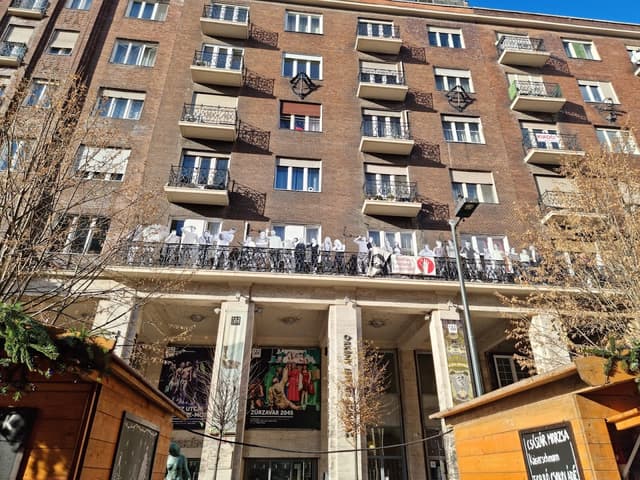
István Örkény Theatre
@pedralexpereira
The Örkény Theatre is housed under the arcades of a residential building block in Madách Square in Budapest. The building was designed by Gyula Wälder and is part of a broader structure conceived in the early 20th century. The architectural layout of the theatre is striking for its blend of functional modernism and artistic design.
Upon entering, visitors find themselves in the foyer, which opens into a distinctive elongated, circular-shaped auditorium. This auditorium is laid out symmetrically along the axis of the stage, with a careful alignment that ensures the best possible acoustics and sightlines. The layout of the auditorium and the stage is harmoniously linked, although they connect with the lobby at a slight angle of refraction, adding a dynamic touch to the interior experience.
Above the auditorium, a dome adds a sense of grandeur, enhancing the space's visual appeal and helping to create an atmospheric ambiance. To the side of the entrance, a balcony offers additional seating, providing a more intimate view of the performances below.
The theatre's design is representative of early 20th-century Hungarian modernism, focusing on both functionality and aesthetic quality. The structure emphasizes clean lines and simplicity while maintaining an artistic flair appropriate for its theatrical purpose.
The Örkény Theatre’s origins trace back to a 1939 project aimed at developing a mixed-use complex in Madách Square. The initial design envisioned a combination of residential and administrative buildings, intended to contribute to the ongoing development of the area close to the historical heart of Budapest. The plans for the complex were undertaken by Gedeon Gerlóczy, a prominent figure in Hungarian Modernist architecture.
However, Gerlóczy's design received significant criticism from contemporary architectural critics and the press, reflecting the sometimes contentious reception of modernist ideas in Hungarian architecture at the time. Despite this, the project was completed, and the theatre became a key cultural venue. The Örkény Theatre's architectural significance is reflected not only in its historical context but also in its unique position within the city's urban landscape.

Details
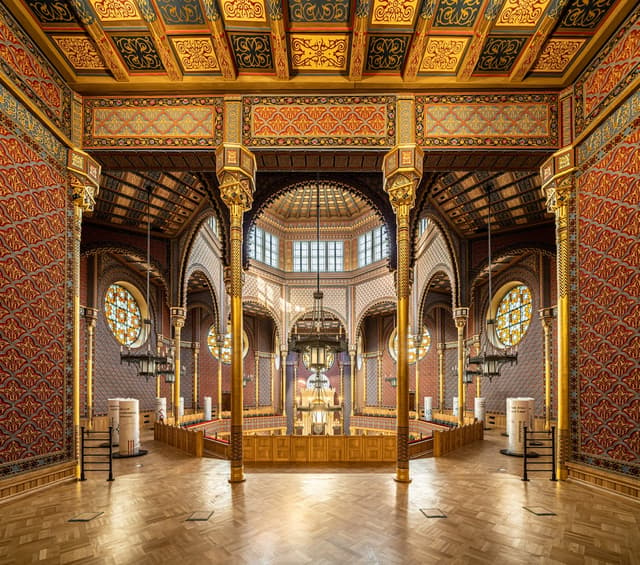
Rumbach Street Synagogue
@pedralexpereira
Constructed in 1872, the synagogue was designed by the Viennese architect Otto Wagner for the Status Quo Ante congregation, a more conservative faction of the Jewish community during the Schism in Hungarian Jewry of 1869. The synagogue was specifically built to cater to the Neológ community, which was part of the more liberal segment of Hungarian Jewry at the time.
The synagogue is a stunning example of Moorish Revival architecture, known for its intricate Islamic-inspired patterns and décor. It features an octagonal layout with a domed roof, a design intended as an homage to the Dome of the Rock in Jerusalem. The building is richly ornamented, with its walls and ceilings adorned with vibrant, geometric Islamic-style patterns, adding to its visual allure.
The synagogue underwent a significant restoration completed in 2021, funded with an $11.2 million grant from the Hungarian state. This renovation preserved the synagogue’s historic charm while modernizing it for contemporary use. Since reopening, the Rumbach Street Synagogue has become a vibrant cultural venue, regularly hosting plays, concerts, photo exhibits, and other cultural events. The synagogue’s transformation into a cultural hub has allowed it to maintain its spiritual significance while contributing to Budapest’s rich artistic and cultural scene.
Today, the synagogue stands not only as a place of worship for the Neológ Jewish community but also as an important historical and cultural landmark in Budapest. Its Moorish Revival architecture, combined with its new role as a concert hall and museum, makes it a unique and essential stop for visitors exploring the city's Jewish heritage and vibrant cultural life.

Details
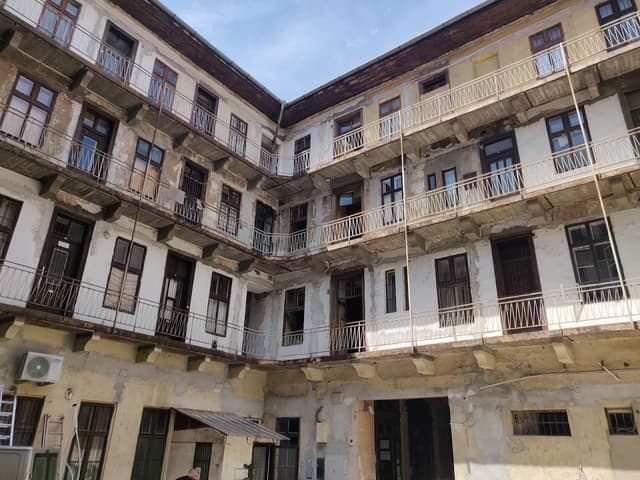
Jewish Ghetto Wall Fragment
@pedralexpereira
In 1944, Budapest’s Jewish population was forcibly confined to a small 20-block area in the 7th district, effectively creating a ghetto. This area, which was sealed off by the Nazi regime, housed tens of thousands of Jewish people under inhumane conditions. Today, visitors to Budapest can learn about this tragic period through landmarks such as the Dohány Street Synagogue, the Holocaust Memorial, and the Hungarian Jewish Museum. These institutions provide in-depth insights into the hardships endured by Hungary’s Jewish citizens during the Holocaust.
However, there are also more subtle remnants of this history hidden throughout the city, offering a quieter, more intimate reminder of the suffering. One such site is the memorial wall located at 15 Király Utca. The original wall was erected in November 1944 to enclose the Jewish ghetto, but it was torn down in 2006. In 2010, a 30-meter sectionof the wall was reconstructed in its original location (though minus the barbed wire) to preserve the memory of those who were forced to live within the ghetto's confines.
This memorial wall stands in the courtyard of a private apartment building, which is not immediately visible from the street. To access it, visitors must enter through the building's courtyard, pass through a narrow tunnel, and reach a second courtyard where the wall and a small plaque are located. The plaque features a map of the original ghetto, and nearby, visitors can see stones and votive lamps placed in tribute to the victims who were held there.
The memorial wall is accompanied by a small plaque with inscriptions in Hungarian, English, and Hebrew, providing historical context and explaining the significance of the site. This humble but poignant memorial offers a powerful reminder of Budapest’s dark history during the Holocaust and the resilience of its Jewish community.

Details
Józsefváros
Józsefváros is a historically rich and diverse district located on the Pest side of Budapest, often referred to as the 8th District. Named after Emperor Joseph II, this area has long been a working-class neighborhood, known for its industrial past, rapid urbanization in the 19th century, and close proximity to the city's core. Józsefváros has undergone significant changes in recent years, transforming into a dynamic district that balances its historical roots with modern development. The district is home to a mix of residential neighborhoods, commercial areas, and cultural institutions, giving it a distinct local character.
One of the key landmarks in Józsefváros is the Museum of Applied Arts, an architectural gem showcasing a stunning mix of Art Nouveau and Secessionist design. Another important feature of the district is the Kálvin Square, a major transportation hub that connects the area with other parts of Budapest. Józsefváros is also known for its vibrant Corvin Promenade, a once-neglected area that has been revitalized into a trendy, tree-lined street lined with shops, cafes, and modern residential complexes. Despite its urban transformation, Józsefváros retains a mix of old and new, with the Luna Cinema offering a glimpse of Budapest's cultural past and the Józsefváros Market Hall serving as a bustling spot for fresh produce and local goods. The district has a growing reputation for its eclectic blend of arts, music, and nightlife, and continues to attract both locals and visitors who seek an authentic and evolving part of Budapest.
See&Do
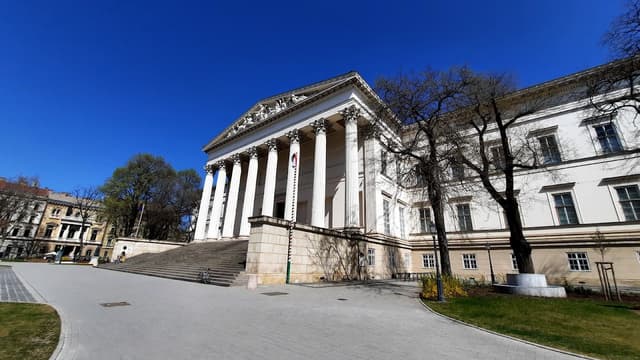
Hungarian National Museum
@pedralexpereira
The origins of the museum trace back to Count Ferenc Széchényi, who established the National Széchényi Library in 1802, laying the foundation for the museum. In 1807, Széchényi's wife donated a mineral collection, expanding the institution's scope beyond just a library. The Hungarian National Parliament became involved in supporting the museum's development in 1832–1834, allocating funds for the construction of a dedicated building.
The museum moved to its current location on Múzeum körút in 1846, and played a key role in the Hungarian Revolution of 1848. The famous poem "Nemzeti dal" by Sándor Petőfi was read on the steps of the museum, sparking the revolutionary movement. In commemoration, statues of János Arany and a memorial plaque for Sándor Petőfi were added to the building. During this period, the upper house of the parliament also held its sessions at the museum until the construction of a new parliament building. The museum remains a site of national significance, with events marking National Commemorations Day held annually in front of the building.
In 1949, the ethnographic and natural history sections of the museum were separated to form the Hungarian Natural History Museum and Ethnographic Museum, with the National Széchényi Library becoming its own institution. Over time, more affiliated museums, including the Castle Museum in Esztergom, joined the museum network.
The museum hosts seven permanent exhibitions, providing a detailed history of Hungary:
Prehistory and Ancient Hungary – covering archaeological artifacts from the Avar period and earlier.
Medieval and Early Modern Hungary – including the Coronation Mantle and medieval relics.
Modern History – focusing on key events such as the Rákóczi War of Independence and Hungary's communist period.
Stone Inscriptions and Carvings – showcasing medieval and early modern stonework.
Roman Lapidary – featuring ancient Roman inscriptions and carvings discovered in Hungary.
Additionally, the museum celebrates the contributions of Hungarian scholars in the 20th century with dedicated exhibits.
The museum's neoclassical building, designed by Mihály Pollack, is a monumental example of 19th-century architecture. The portico is adorned with statues by Raffael Monti, including a famous figure of Hungary, flanked by Science and Art. The museum’s staircase features murals by Károly Lotz and Mór Than, which have been in place since 1875.
A garden at the museum hosts cultural events, including concerts, and has been the setting for performances by Ferenc Liszt. The museum garden also serves as the venue for the annual Museum Festival.

Details
Museum Garden
@pedralexpereira
The Museum Garden is a peaceful and scenic space that provides a contrast to the surrounding urban environment. The garden is well-maintained, featuring beautiful pathways, manicured lawns, and a variety of trees and plants. It is designed to complement the nearby museums, offering visitors an opportunity to enjoy nature while exploring Budapest’s rich cultural and historical heritage.
One of the prominent aspects of the Museum Garden is its historical significance. The garden is part of the larger Museum Quarter in Budapest, a cultural district that is home to several important museums and institutions. It is often used as a venue for open-air events, such as concerts, festivals, and public gatherings, making it a dynamic space that blends nature with culture.

Details

Festetics Palace
@pedralexpereira
The Festetics Palace was originally constructed in the late 18th century by the Festetics family, which rose to prominence during the reign of Empress Maria Theresa. The family’s wealth was largely derived from their vast landholdings, and they became one of the most influential aristocratic families in Hungary. The palace was built to reflect their status and to serve as a residence for the family.
Over the years, the Festetics family commissioned a number of modifications to the palace, with several generations of architects and designers contributing to its development. It is believed that the palace was designed in the Baroque and Classical styles, with influences from the Empire and Renaissance periods, offering a mix of grandeur and elegance.
The Festetics Palace features a classic baroque façade with elements of neoclassical and empire styles. Its imposing entrance is framed by large columns, while the upper floors are adorned with intricate detailing and large windows. The building’s overall design combines symmetry with elegance, highlighting the influence of European aristocratic architecture of the period.
The interior of the Festetics Palace is equally impressive, with high ceilings, elegant rooms, and ornate furnishings. Many of the rooms were designed for lavish receptions, with large salons and dining areas that could accommodate high-society gatherings. Today, some of the palace’s rooms are open to the public and are part of a guided tour, showcasing the opulence of the Festetics family and their influence on Hungarian culture.
While the Festetics Palace was once a private residence, today it serves a public function. The palace now houses several important institutions, including government offices and cultural organizations. It is a significant cultural venue, hosting events such as exhibitions, concerts, and educational activities.
The building is also a popular tourist attraction due to its historical significance and its prime location near other important landmarks in Budapest. Visitors can explore parts of the palace and learn about the history of the Festetics family and their impact on Hungarian society.

Details
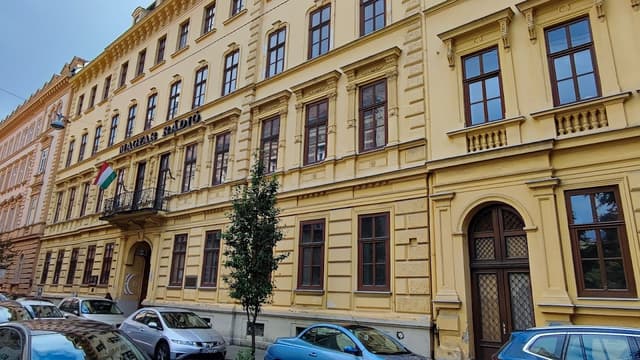
Magyar Radio Building
@pedralexpereira
The Magyar Rádió Building, located on Sándor Bródy Street in Budapest, is a significant site of Hungary's tumultuous history, particularly the Hungarian Revolution of 1956. Though situated in a quieter area, away from the city's more crowded streets, the building is forever tied to one of the most pivotal moments in Hungarian history.
On October 23, 1956, a series of anti-Soviet protests erupted in Budapest, initiated by university students demanding Hungarian autonomy and an end to Soviet control. The peaceful demonstration soon escalated when students and their supporters gathered outside the Magyar Rádió Station, determined to broadcast their revolutionary message. As tensions rose, the Hungarian secret police, stationed at the building in anticipation of conflict, opened fire on the crowd. Tragically, three students were killed and two others were wounded as they attempted to flee.
In the aftermath of the shooting, the Hungarian Army intervened, but many soldiers refused to follow orders to fire on the unarmed protesters. Instead, they turned their weapons on the secret police, leading to widespread violence. This act of defiance sparked further unrest, with other demonstrators across the city and country taking up arms in solidarity. The protests and subsequent armed uprisings spread to other cities, eventually involving intense street fighting that lasted for 12 days.
Despite the violence and destruction that followed, including the deaths of around 2,500 Hungarians and the injury of another 20,000, the Magyar Rádió Building itself survived the conflict. Though the building’s façade has since been repaired and shows no visible scars from the conflict, two small, inconspicuous plaques on the exterior quietly commemorate the tragic events that transpired there.
Today, the Magyar Rádió Building stands as a quiet testament to the bravery of the protesters and the violent suppression of the revolution, symbolizing both the resilience and the sacrifices of those who fought for Hungary's freedom during the 1956 Uprising.

Details
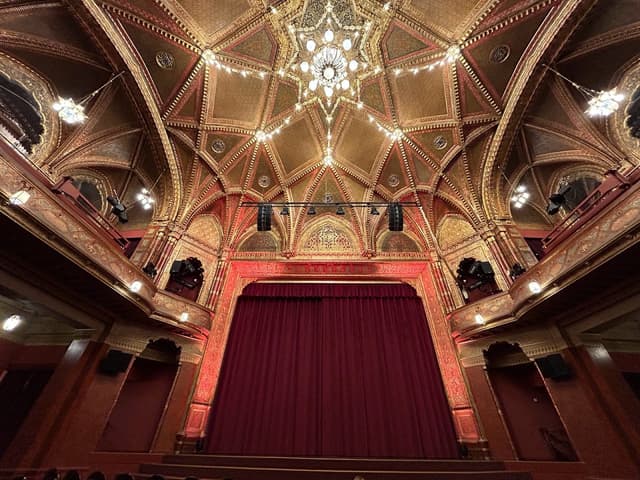
Urania National Film Theater
@pedralexpereira
ompleted in the mid-1890s, this architectural gem originally served as an orpheum before evolving into one of the city's most renowned cinematic venues.
Initially named Caprice, and later Alhambra, the theater's transition to a film venue came in 1899 when it was equipped with projection technology and renamed the Uránia Science Theater. It was here, on the rooftop terrace in 1901, that Hungary's first motion picture, A táncz (The Dance), was filmed, marking a significant moment in Hungarian cinema history, although no copies of the film are known to have survived.
By 1916, Uránia shifted its focus entirely to film screenings, eventually phasing out its earlier science lectures. During the Soviet era, the theater operated under Sovexport but was returned to Hungarian control after World War II. Today, Uránia remains a prominent cinema in Budapest, offering several screens in addition to its grand main hall, which can accommodate 460 people. The main hall is no less magnificent than a classical opera house, featuring beautifully restored boxes and a balcony.
The theater's legacy is honored through its connection to iconic cinematic works, with sections named after legendary films such as Casablanca (1942), Merry-Go-Round (1955), and Hyppolit, the Butler (1931), alongside its historical ties to The Dance (1901). The Uránia National Film Theater remains a cultural landmark, seamlessly blending Budapest’s rich architectural heritage with its vibrant cinematic history.

Details
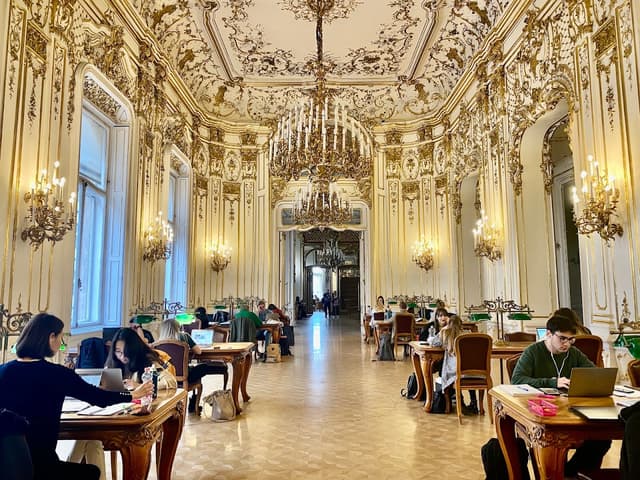
Metropolitan Ervin Szabó Library
@pedralexpereira
The Fővárosi Szabó Ervin Könyvtár (Metropolitan Ervin Szabó Library) is the largest library network in Budapest, Hungary, renowned for its vast collection and historical setting. Its main branch is housed in the Wenckheim Palace, a magnificent 19th-century neo-baroque building. As the library’s collection expanded, the need for more space grew, prompting the addition of other buildings to its network. The palace itself was meticulously restored and declared a national monument, preserving its architectural significance while adapting it for modern use.
Today, the library spans 13,000 m² and holds Budapest's largest public collection, with a capacity for 1.1 million volumes. In 2003, its central building earned international recognition when it was awarded the Prix d’Excellence by the International Real Estate Federation, a testament to its architectural and cultural importance.
The Metropolitan Ervin Szabó Library continues to serve as a central hub of knowledge, culture, and community, preserving its historical legacy while providing a modern and expansive space for literature and learning.

Details
Corvin Cinema
@pedralexpereira
Located in the Corvin Quarter, the Corvin Cinema stands out with its vibrant yellow exterior and rich history. Opened in 1922, it has undergone several transformations over the decades. In 1957, it was upgraded to a wide-screen cinema, and later in 1996, it was rebuilt as a multiplex with multiple screening halls, making it a modern cinematic hub in Budapest.
The cinema’s main hall, designed in a blend of Art Nouveau and Bauhaus styles, retains the grandeur of a theatre auditorium and can accommodate around 500 people. Despite its historic roots, Corvin Cinema is equipped with state-of-the-art audiovisual technologies, ensuring a top-tier viewing experience. It has become a popular venue for film festivals and Hungarian premiere nights, making it not just a cinema but also a key meeting spot for locals and film enthusiasts.

Details
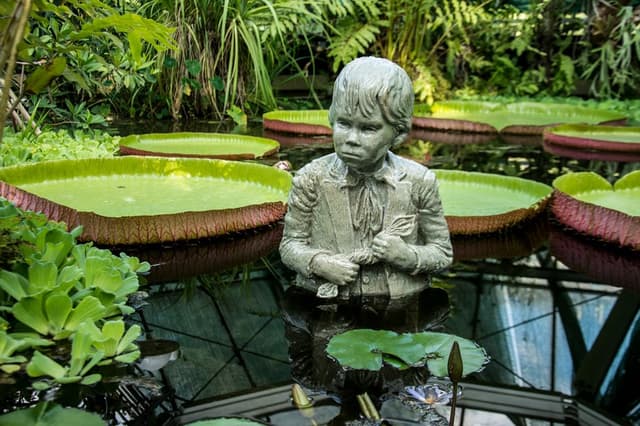
ELTE Füvészkert
@pedralexpereira
ELTE Füvészkert, also known as the ELTE Botanical Garden, is a historic and expansive garden located in the heart of Budapest. Established in 1771, it is one of the oldest botanical gardens in Hungary and serves as an educational and scientific resource. The garden is part of Eötvös Loránd University (ELTE), one of Hungary's leading universities, and is used for research, teaching, and as a public green space.
Covering approximately 3.5 hectares, ELTE Füvészkert features over 8,000 plant species from around the world. The garden is laid out in a series of thematic sections, showcasing plants from various climates and ecosystems, including Mediterranean, temperate, and tropical plants. There is also a collection of cacti and succulents, as well as a Japanese garden and a pond with water plants.
The garden's glasshouses house tropical and subtropical plants, offering visitors the chance to explore diverse plant life from different climates. The peaceful environment, along with its historical significance, makes ELTE Füvészkert a popular spot for both locals and tourists seeking respite from the city's bustle. It is also a center for botanical research and frequently hosts educational events and exhibitions related to flora and sustainability.

Details

Turay Ida Theater
@pedralexpereira
The theater was founded in 1994 and is known for its intimate, community-focused productions. Turay Ida Theater offers a wide variety of performances, including musicals, comedy, drama, and family-friendly shows. Over the years, it has developed a reputation for providing high-quality entertainment with a personal touch, often focusing on Hungarian classics as well as contemporary works.
The venue itself is relatively small compared to major Budapest theaters, creating a cozy atmosphere where the audience can have an up-close experience with the actors. Its stage is used for both traditional theatrical performances and more experimental shows. The theater is accessible and often hosts local talent, helping to cultivate Hungary's growing theater scene.
The Turay Ida Theater also engages in community outreach, providing a platform for new talent and offering educational workshops and activities for young aspiring actors. As a result, the theater holds a special place in the local cultural life of Budapest.

Details

Kálvária Square
@pedralexpereira
Kálvária tér is a significant square in the 9th district of Budapest, Ferencváros, located to the south of the city center. The area is named after the Calvary (Kálvária), referencing the Christian tradition of the Passion of Christ, where the site of the crucifixion is symbolically depicted. The square is known for its historical significance, urban development, and proximity to several cultural landmarks.
Historically, Kálvária tér was part of the broader urban expansion of Budapest in the 19th and 20th centuries. The area took on a more central role in the development of the Ferencváros district as a working-class neighborhood, hosting both residential and industrial buildings. Over time, Kálvária tér evolved into a lively public space with green areas and notable buildings.
One of the most recognizable features of Kálvária tér is the Kálvária Church (or Kálvária templom), a Baroque-style church that was built in the 18th century. This church, dedicated to the Stations of the Cross, stands as an important religious and architectural landmark in the area. The church’s historical significance and its role in the religious life of the district make it a key attraction for visitors to the square.
The square is also known for its green spaces, offering a spot of tranquility amidst the urban landscape. Nearby streets are lined with a variety of shops, cafes, and residential buildings that reflect the lively atmosphere of the area. Over the years, Kálvária tér has undergone changes to become a more pedestrian-friendly and revitalized space, serving as a popular hub for both locals and visitors.
The square has undergone significant urban development and regeneration efforts over recent years, and while it retains its historical charm, it has also adapted to modern city life. New residential complexes, businesses, and public facilities have been integrated into the area, making Kálvária tér a diverse and dynamic part of Ferencváros.

Details
John Paul II Square
@pedralexpereira
II. János Pál pápa tér (Pope John Paul II Square) is a prominent public space in Budapest, located in the 9th district (Ferencváros), near the Danube River. The square is named after Pope John Paul II, who visited Hungary multiple times during his papacy, leaving a significant mark on the country’s religious and cultural history. The square serves as both a commemoration of his visits and as a place of reflection and community activity.
The square was officially named after Pope John Paul II in recognition of his influence and the deep connection he established with Hungary during his visits in 1991, 1996, and 2001. Pope John Paul II's relationship with Hungary was marked by his efforts to promote peace, human rights, and religious tolerance. His visits were seen as a moment of spiritual renewal and solidarity for the country, particularly after the end of Soviet influence.

Details
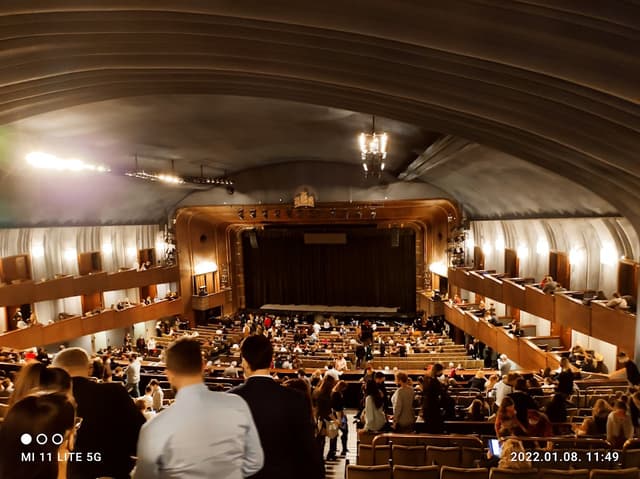
Erkel Színház
@pedralexpereira
The theatre was originally conceived as Népopera (The People's Opera) with the aim of bringing opera and cultural performances to the working class of Budapest. The Budapest city council played a significant role in its creation, providing the plot for free, but regulating its operation to ensure it was accessible to the masses. The theatre was built in just 9 months, designed by Dezső Jakab, Marcell Komor, and Géza Márkus, and opened in 1911.
The venue was designed to be a large, accessible space for the working class. It featured modern machinery and equipment, including an organ, with a stage measuring 14 meters wide and 8.5 meters tall, making it one of the largest in the city. The auditorium was also large, with a seating capacity that initially accommodated up to 2,400 people. A mural by Bertalan Pór added an artistic touch to the otherwise simple architectural style.
Despite its early successes, including a notable season with the complete works of Richard Wagner, the concept of a "People's Opera" proved difficult to sustain, especially during the disruption of World War I. The theatre closed in 1915 due to the war, but was reopened in 1917 under a new name, Városi Színház (City Theatre). The building continued to host various theatre companies and a wide range of performances, from dramatic plays to concerts.
Between 1940 and 1945, the theatre was managed directly by the city council, focusing on diverse performances, including collaborations with the Opera House and the National Theatre. From 1946 to 1948, it temporarily operated as a cinema before returning to its role as a performance venue.In 1951, the Erkel Theatre became part of the Hungarian State Opera House, which marked a new chapter in its history. In 1953, the theatre was renamed to Erkel Theatre, in honor of Ferenc Erkel, a renowned Hungarian composer, and it became a secondary venue for the Opera House.
Major renovations took place between 1959 and 1961, updating the building to modern standards while maintaining its grandeur. Over the decades, it became a hub for opera, ballet, and other major performances, often supplementing the larger Hungarian State Opera House.The theatre closed for extensive renovations between June 2007 and March 2013. The renovations modernized the facilities while preserving the building’s historical charm, including the restoration of the stage and audience areas.
Upon reopening in 2013, the Erkel Theatre resumed its role as a secondary stage for the Hungarian State Opera, offering a venue for large-scale productions that complement the main Opera House. The theatre continues to host performances, including operas, ballet, and concerts, serving as a key cultural institution in Budapest.

Details
Ferencváros
Ferencváros, also known as the 9th District, is a vibrant and historically significant neighborhood located on the Pest side of Budapest, situated just south of the city center. The district was named after Francis I of Austria (Ferenc in Hungarian), and like many parts of Budapest, it has seen significant transformation over the years. Ferencváros has traditionally been a working-class area, with its development closely tied to industrialization in the 19th century. Over the past few decades, however, the district has undergone a remarkable revitalization, becoming a dynamic blend of historical charm and modern urban development.
Ferencváros is home to several important cultural and architectural landmarks. The National Theatre and the Palace of Arts (Müpa) are major cultural institutions located on the banks of the Danube River, offering a rich program of performances, concerts, and exhibitions. The district is also known for the Könyves Kálmán Körút, a major street that cuts through the area, lined with shops, restaurants, and residential buildings. Historically, Ferencváros has had a strong association with the working class, and remnants of this past are still visible in the architecture and industrial sites scattered throughout the district. Among the more notable locations is Rákóczi Bridge, a key river crossing that links Ferencváros with other districts, and Nagyvásártelep, a market area that has served as a hub for commerce and local trade.
A key feature of Ferencváros’s transformation is its growing role as a center for creativity and contemporary culture. The neighborhood’s industrial past is reflected in areas like the Factory District, which has been converted into creative spaces, art galleries, and hip bars. The proximity of Corvinus University also adds a youthful energy to the district, making it a popular spot for students and young professionals. While Ferencváros continues to modernize, it retains much of its unique, historic character, offering visitors a glimpse of Budapest's evolution from an industrial center to a thriving cultural hotspot.
See&Do
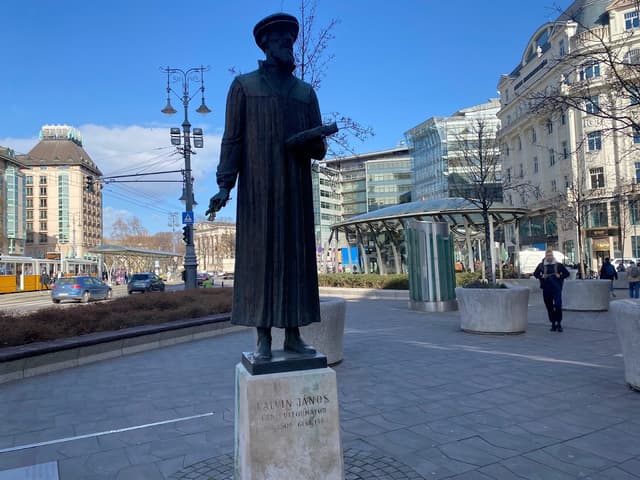
Kálvin Square
@pedralexpereira
Kálvin tér is a prominent square and intersection in the heart of Budapest, Hungary. Named after the Protestant Reformer John Calvin, the square is notable for its central location and the large Reformed Church situated there. It is situated in the Pest side of Budapest, at the intersection of three central districts: Belváros-Lipótváros, Józsefváros, and Ferencváros. The square is at the confluence of several key roads and boulevards, including Kiskörút, which connects major areas like Múzeum körút to the north and Vámház körút to the south, Üllői út, which leads south towards the city’s outskirts, and Baross utca and Kecskeméti utca both converge here as well.
As one of Budapest's busiest locations, Kálvin tér serves as a major transportation hub. It is well-connected by multiple public transit routes, including Kálvin tér station on the M3 and M4 lines of the Budapest Metro, which provide fast and efficient subway connections. Several tram, bus, and trolleybus routes also pass through or stop at the square, making it a crucial junction for both locals and visitors. The square’s strategic position, coupled with its historical significance, makes it one of Budapest’s key urban landmarks.

Details
Kálvin Square Reformed Church
@pedralexpereira
The Reformed Church at Kálvin Square in Budapest is a prime example of neo-classical architecture, standing as one of the most beautiful churches of its style in the city. Located near the National Museum, this church was constructed between 1816 and 1830 based on the designs of architect Vince Hild. The building features a grand, four-columned foyer at the main entrance, with two-storey side galleries that were added by his son, József Hild.
The church underwent a significant update in 1859, when a tower helmet was added, giving it the iconic appearance it retains today. Inside, one of the most striking features is the organ, which was completed in 1831. This organ remains one of the church's most treasured elements, adding to the building's rich history and aesthetic appeal. The church’s serene beauty and historic significance make it an important landmark in Budapest, both architecturally and culturally.

Details

Central Market Hall
@pedralexpereira
Located at Fővám Square on the Pest side of the Liberty Bridge, it sits at the end of the popular Váci utca pedestrian street. The idea of constructing such a large market hall was first proposed by Károly Kamermayer, the first mayor of Budapest, who saw it as a major investment. He participated in its opening ceremony on February 15, 1897.
The concept for a market hall to improve food supply conditions in Budapest began in the 1860s, and by 1879, plans for such a facility were drawn up. It took several years for the plans to materialize, and by the early 1890s, the need for a market hall became urgent due to the rapid population growth and disorganized food supply. After the Prime Minister Kálmán Tisza gave approval, the site at Fővám Square was secured.
Designed by Samu Pecz and completed in 1897, the market hall spans 10,000 square meters over three floors. Its architecture combines neogothic touches, with a distinctive roof covered in colorful Zsolnay tiling from Pécs. The market is housed within a steel structure and was significantly damaged during World War II. However, after a thorough renovation in the 1990s, the market reopened in 1997 and earned the FIABCI Prix d’Excellence in 1999.
The market is a popular attraction, especially among tourists. The ground floor features a wide variety of fresh produce, meats, pastries, spices, and spirits, including Hungarian specialties such as paprika, Tokaji wine, and kolbász sausage. The second floor is home to eateries and souvenir stalls, while the basement contains fishmongers, pickled vegetables, and specialized butcher shops. The market is open Monday through Saturday, with varying hours depending on the day.

Details
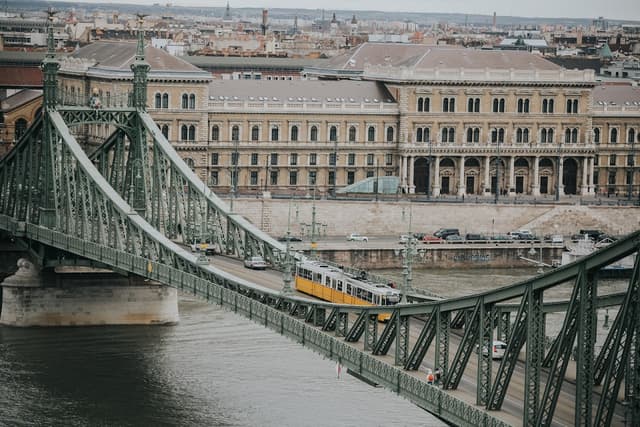
Corvinus University of Budapest
@pedralexpereira
Corvinus University of Budapest, located on the banks of the Danube River in the heart of the city, is one of Hungary's most prestigious universities. Its main building, an imposing structure with neoclassical and modernist elements, is situated at the intersection of Fővám Square and the university’s campus.
The building that houses the university's main offices and faculty was originally constructed in the early 20th century, between 1901 and 1903, as a part of the city's expansion during the Austro-Hungarian Empire. The design of the building blends classical architectural forms with influences from the Art Nouveau movement, reflecting the era's desire to combine historical grandeur with modern design. Originally known as the "Közgazdasági Egyetem" (Economic University), it was later renamed to Corvinus University in honor of King Matthias Corvinus of Hungary.
The most notable feature of the building is its grand façade, which is adorned with classical columns and ornate decorations. The building faces the Danube, offering picturesque views of the river and the city skyline. Inside, the university combines traditional and contemporary elements, with spacious lecture halls, modern seminar rooms, and cutting-edge facilities for students and faculty.

Details
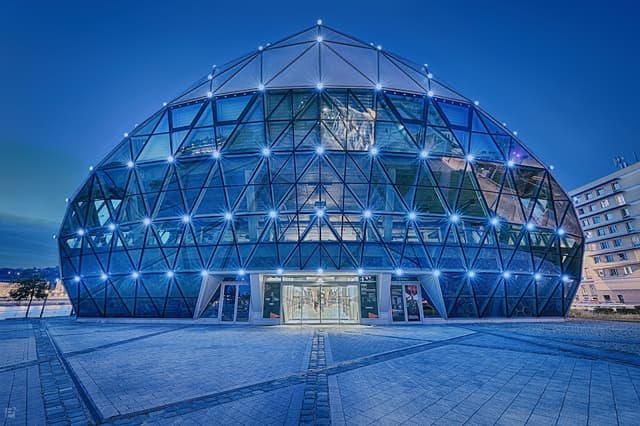
Bálna
@pedralexpereira
Bálna (Hungarian for "Whale") is a distinctive building located on the Pest side of Budapest, along the Danube River. It is an iconic example of modern architectural design and is named after its unique, whale-like shape. The building was designed by the renowned Hungarian architect, Kas Oosterhuis, and was constructed between 2009 and 2013. Its most striking feature is its curvaceous form, which resembles the silhouette of a whale, making it stand out against the backdrop of the city’s more traditional architecture.
Bálna was initially conceived as a cultural and commercial center, offering a variety of spaces for exhibitions, events, offices, and shops. The building's layout spans several floors, with open areas, galleries, and wide corridors that invite exploration. The top floor features a large terrace, which provides stunning views of the Danube and the surrounding cityscape, including the famous Gellért Hill and Liberty Bridge. It is a popular spot for both locals and tourists, offering cafes and outdoor seating.
The Bálna building combines glass and steel with elements of natural materials, contributing to its sleek and futuristic appearance. It has become a hub for contemporary culture, with regular exhibitions, art shows, and performance events. The Bálna is also known for its innovative approach to sustainability, including energy-efficient technologies and green spaces.

Details
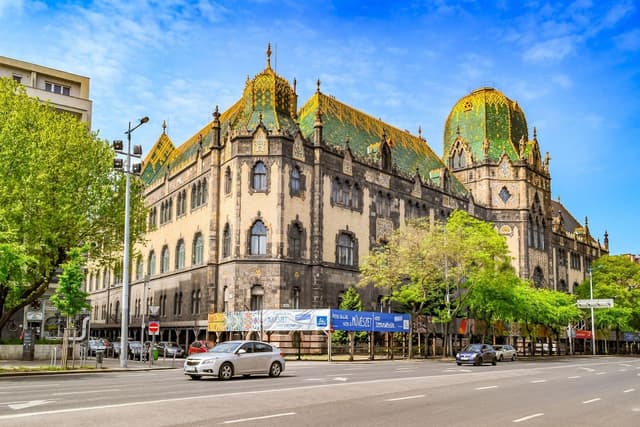
Museum of Applied Arts
@pedralexpereira
The Museum of Applied Arts (Iparművészeti Múzeum) in Budapest, Hungary, is one of the oldest and most significant institutions dedicated to applied arts in the world. Established between 1893 and 1896, the museum was designed by Ödön Lechner, a renowned Hungarian architect, and is a prime example of the Hungarian Secession style. The building itself is a striking work of art, featuring a distinctive green-tiled roof and elaborate detailing that incorporates Hindu, Mogul, and Islamic artistic influences, creating a unique blend of Eastern and Western styles.
Though the museum is currently undergoing renovations to restore and modernize its facilities, it continues to house an impressive collection of applied arts, including metalwork, furniture, textiles, and glass. The museum is known for its extensive collection of objects, showcasing the craftsmanship and design of various historical periods and cultures. It also boasts a library dedicated to art and design.
In addition to the main building, the museum oversees two other locations: the Hopp Ferenc Museum of Eastern Asiatic Arts and the Nagytétény Palace, which further enrich the museum’s offerings. Located near the southern end of the Grand Boulevard in the Ferencváros district, the museum is easily accessible via metro line 3, making it a popular destination for both locals and tourists interested in the history of applied arts and design.

Details
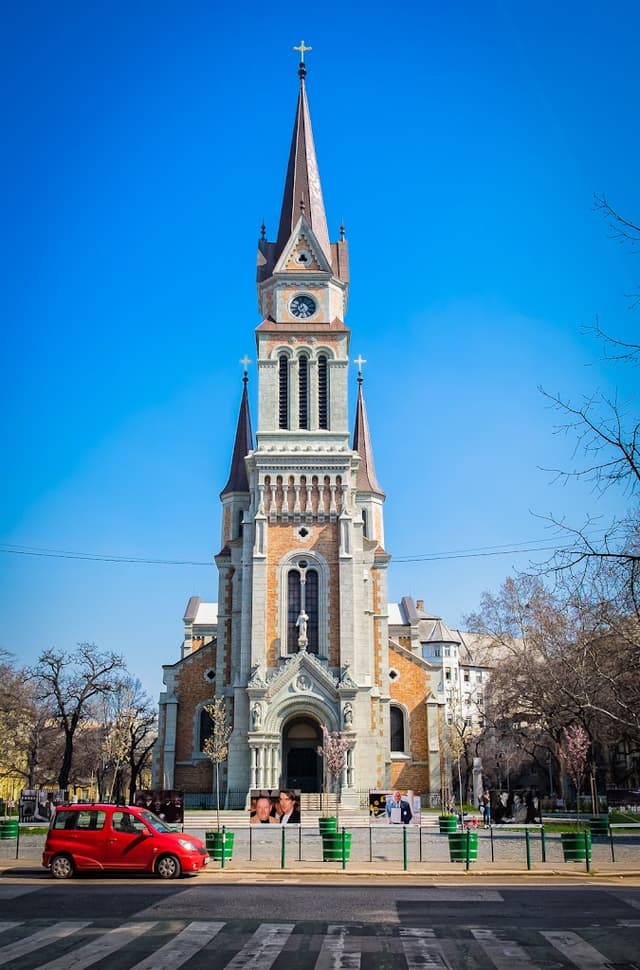
St. Francis of Assisi Parish Church
@pedralexpereira
The Museum of Applied Arts (Iparművészeti Múzeum) in Budapest, Hungary, is one of the oldest and most significant institutions dedicated to applied arts in the world. Established between 1893 and 1896, the museum was designed by Ödön Lechner, a renowned Hungarian architect, and is a prime example of the Hungarian Secession style. The building itself is a striking work of art, featuring a distinctive green-tiled roof and elaborate detailing that incorporates Hindu, Mogul, and Islamic artistic influences, creating a unique blend of Eastern and Western styles.
Though the museum is currently undergoing renovations to restore and modernize its facilities, it continues to house an impressive collection of applied arts, including metalwork, furniture, textiles, and glass. The museum is known for its extensive collection of objects, showcasing the craftsmanship and design of various historical periods and cultures. It also boasts a library dedicated to art and design.
In addition to the main building, the museum oversees two other locations: the Hopp Ferenc Museum of Eastern Asiatic Arts and the Nagytétény Palace, which further enrich the museum’s offerings. Located near the southern end of the Grand Boulevard in the Ferencváros district, the museum is easily accessible via metro line 3, making it a popular destination for both locals and tourists interested in the history of applied arts and design.

Details
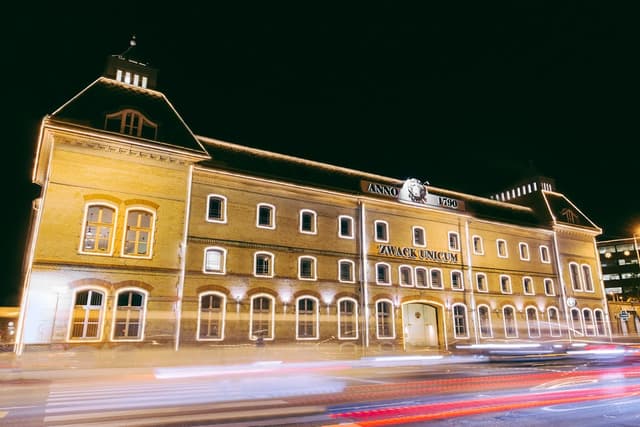
Zwack Unicum Museum
@pedralexpereira
The Zwack Unicum Museum, located on the grounds of the Zwack distillery, is a captivating destination that delves into the rich history of Hungary's iconic herbal liqueur. Shrouded in secrecy, the formula behind Unicum, invented over 200 years ago by royal physician Doctor Zwack, remains a closely guarded family secret. The recipe, said to consist of more than 40 carefully selected ingredients, has been passed down through generations of the Zwack family, ensuring the beverage's continued success and popularity in Hungary.
The museum offers visitors an in-depth look at the distillery's operations, with a guided tour that reveals the entire production process. The experience culminates in the basement tasting room, where guests can sample Unicum straight from the aging barrels, offering a rare opportunity to taste the liqueur in its most authentic form. The tour also begins with a video that provides a detailed account of the Zwack family's history and the evolution of their beloved beverage.
In addition to its historical insights, the museum houses Europe's largest collection of mini liquor bottles, making it a fascinating stop for both history enthusiasts and collectors alike. The Zwack Unicum Museum offers a unique blend of tradition, craftsmanship, and family legacy, making it a must-visit for anyone interested in Hungarian culture and spirits.

Details
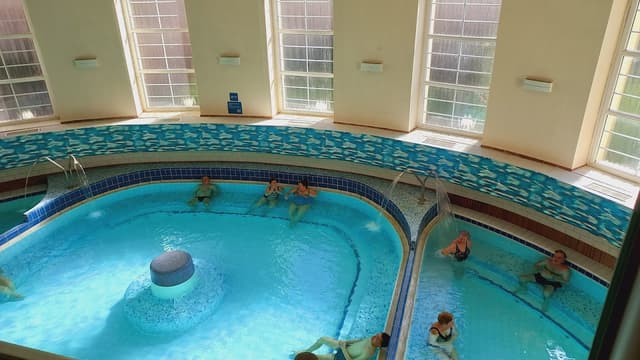
Dandár Thermal Bath
@pedralexpereira
Dandár Bath offers a refreshing alternative to the more crowded and expensive thermal baths in Budapest. Located in the 9th district, just a short distance from the city center, Dandár is tucked away in a quieter, less touristy part of Budapest, giving it a peaceful and local vibe. The bath's history dates back to 1930, and its exterior features brick architecture with art deco elements that continue into the interior. Unlike larger, more famous baths like Széchenyi or Gellért, Dandár is a smaller, cozier option, making it a great choice for those who prefer a more intimate and affordable thermal bath experience.
The true charm of Dandár lies in its serene atmosphere. The bath features five pools, including two indoor thermal pools, two outdoor wellness pools, and a dive pool. The bath's outdoor pools are set in a closed inner courtyard, creating a private, almost backyard-like atmosphere where visitors can relax and unwind. If you visit during the colder months, the steam rising from the pools adds a magical touch to the experience, especially if you’re lucky enough to visit on a snowy day.
Dandár is primarily frequented by locals, which helps maintain lower prices compared to the more tourist-heavy baths. The cost for a full access adult ticket is just 2,800 HUF on weekdays and 2,900 HUF on weekends (around 8 euros), offering access to all pools, saunas, and steam cabins, as well as a locker. It’s an ideal choice for anyone on a budget who still wants to experience the city's thermal bath culture without the crowds.

Details
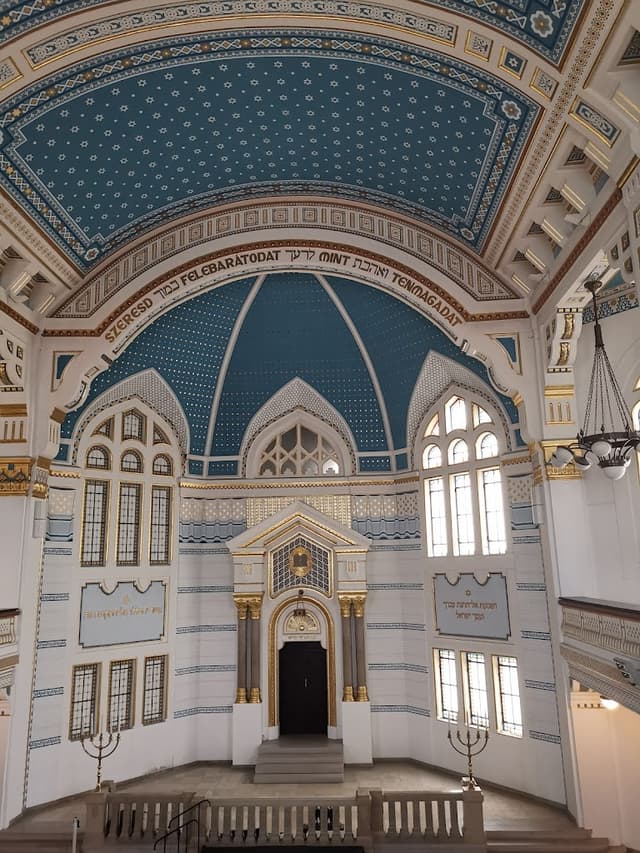
Holocaust Memorial Center
@pedralexpereira
The Holocaust Memorial Center in Budapest, located at 39 Páva Utca, is dedicated to preserving the history of the Holocaust, with a particular focus on Hungarian Jews who were persecuted and murdered during this tragic period. The museum is situated on the grounds of the former Páva Street Synagogue, which was completed in the 1920s. In addition to its focus on Jewish victims, the museum also acknowledges the discrimination and killings of Romani people, homosexuals, and the disabled during the Holocaust.
Opened in 2004, the Holocaust Memorial Center was the first state-funded Holocaust memorial in Central Europe, established by the Hungarian government in 1999. The museum was designed by architects István Mányi and Attila Gáti. The building features asymmetrical architecture, with a set of stairs leading visitors into the exhibitions, symbolizing the disordered and twisted nature of the time during the Holocaust. The center hosts both permanent and temporary exhibits, as well as a research center, which allows individuals to search for family members and contribute to the museum's database of victims.
In the courtyard of the Holocaust Memorial Center, a wall is inscribed with the names of 60,000 of Hungary’s approximately 600,000 Holocaust victims, serving as a powerful reminder of the scale of the tragedy.
However, the center has been at the center of controversy, particularly following the appointment of András Levente Gal as the head of the center in 2010. Gal, appointed after the victory of Viktor Orbán's Fidesz Party, was accused of downplaying Hungary’s role in the Holocaust, instead placing blame solely on Nazi Germany. His efforts to minimize the involvement of Hungarian leaders like Miklós Horthy, who aligned Hungary with Nazi Germany, sparked significant criticism from Hungarian Jews, as well as international organizations such as Yad Vashem and the United States Holocaust Memorial Museum. This controversy led to Gal’s eventual dismissal.

Details
Hope you enjoy your trip!
* * *



